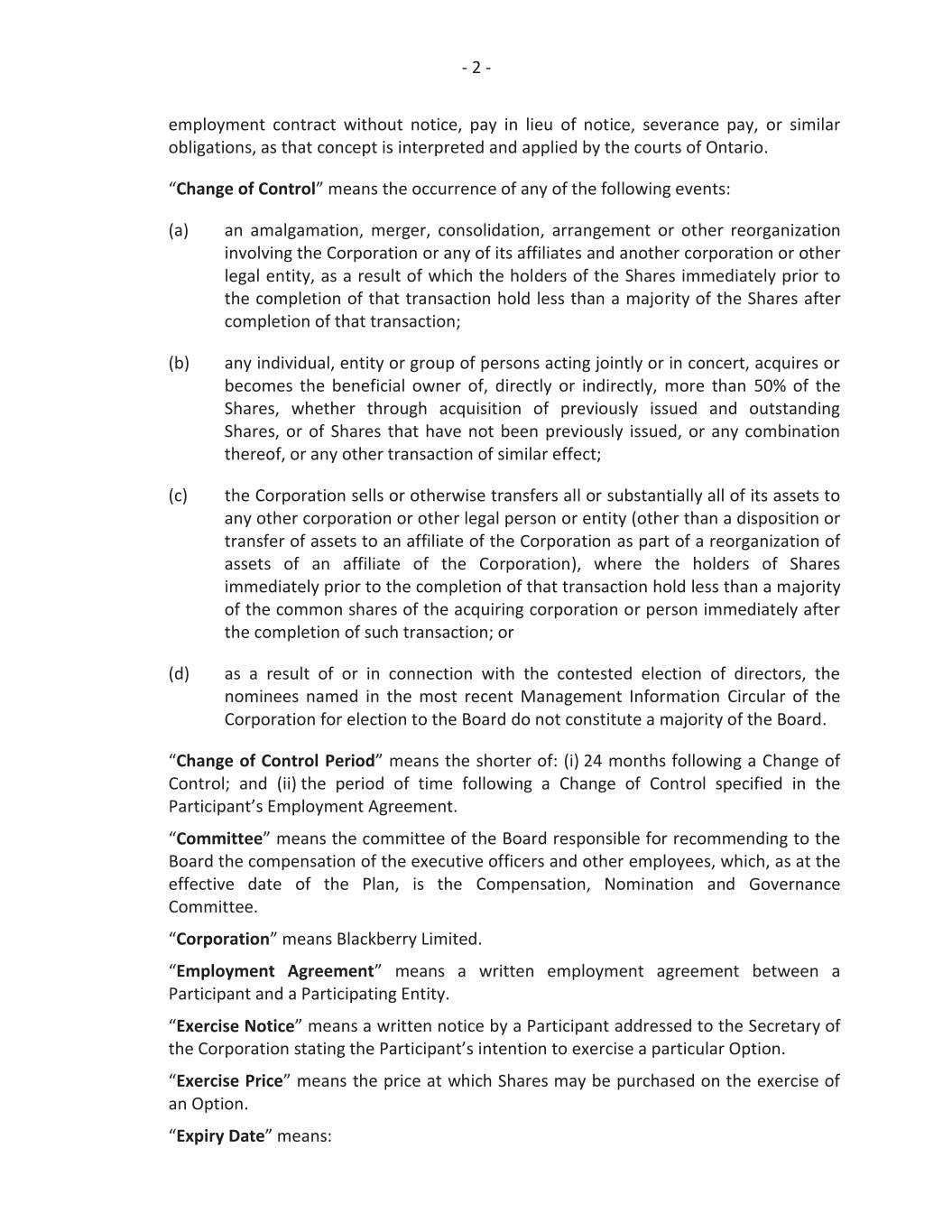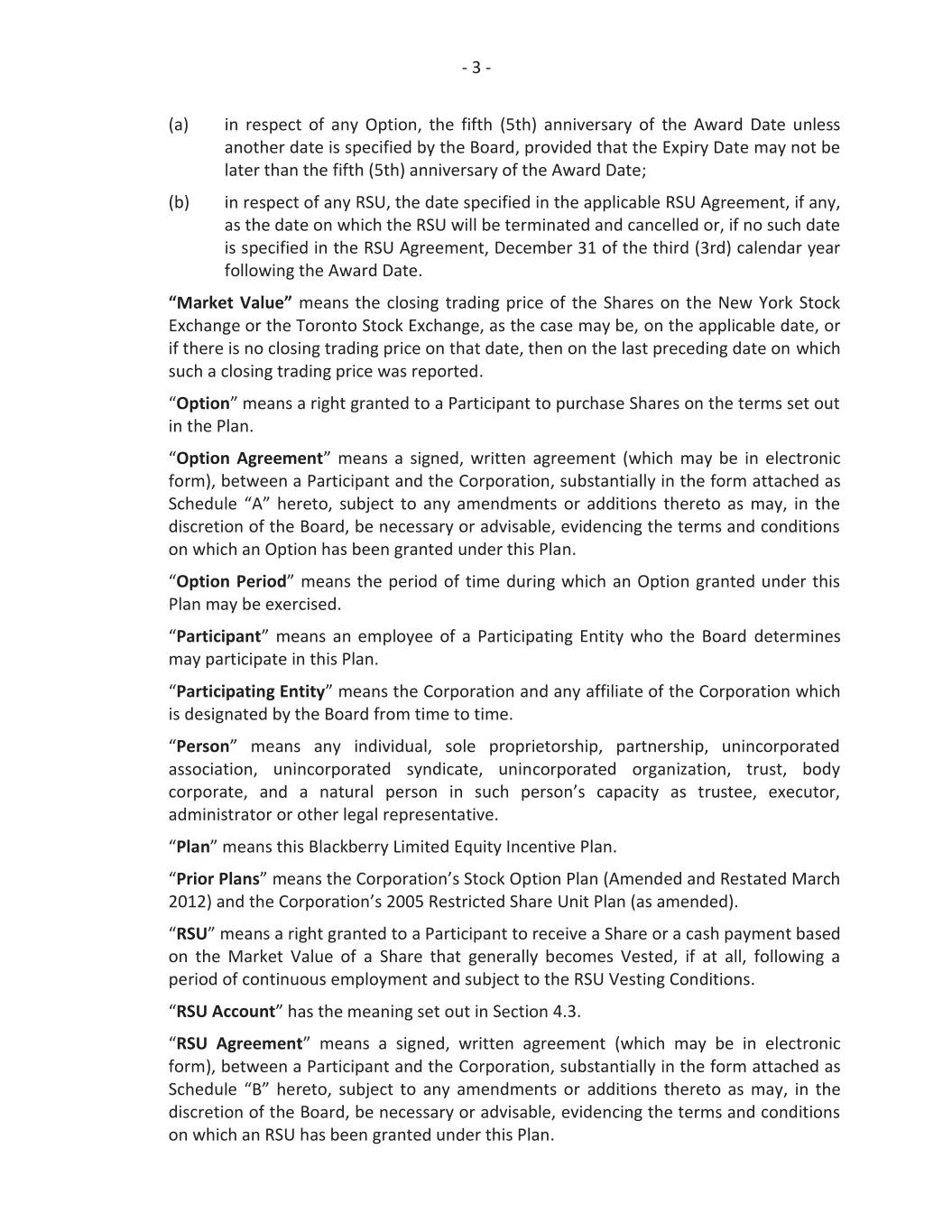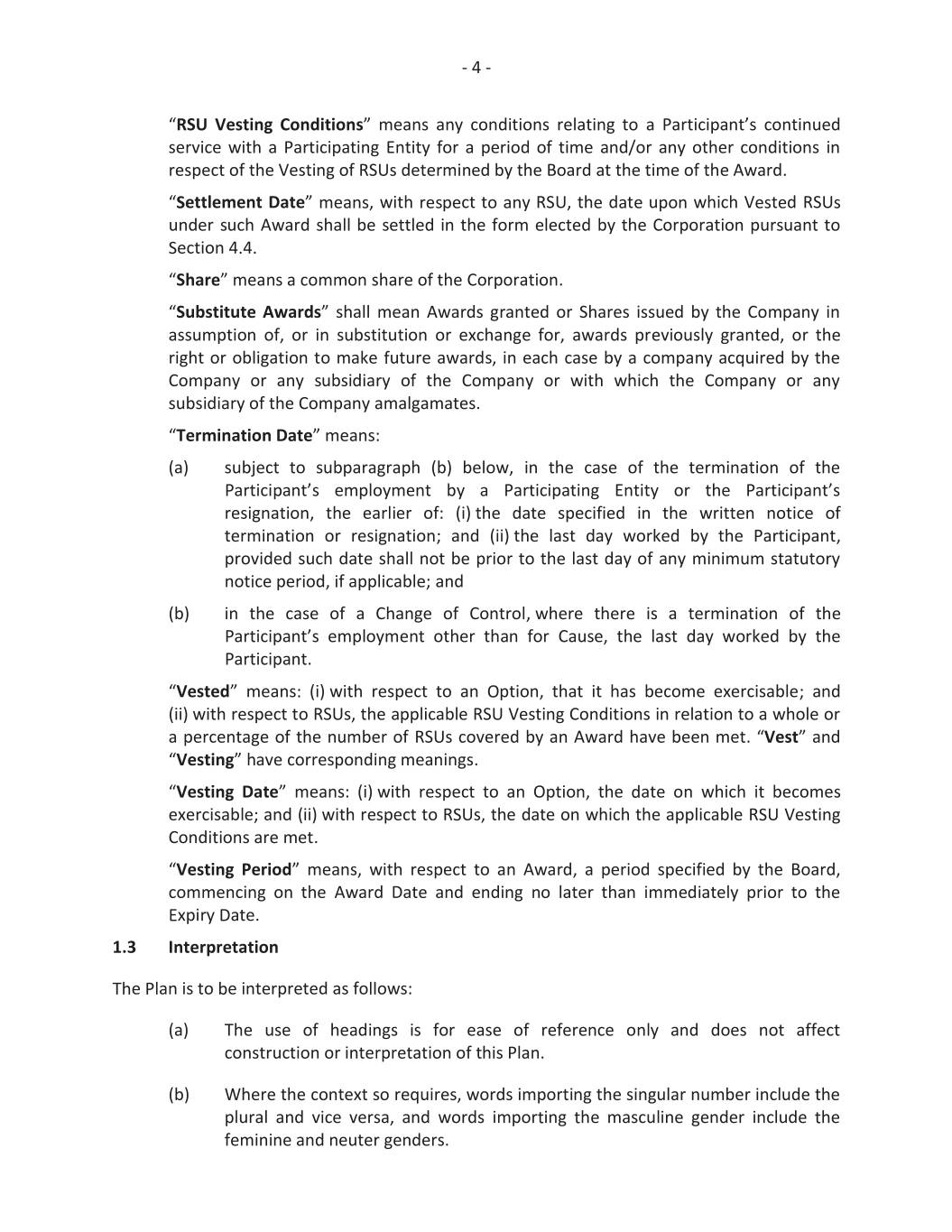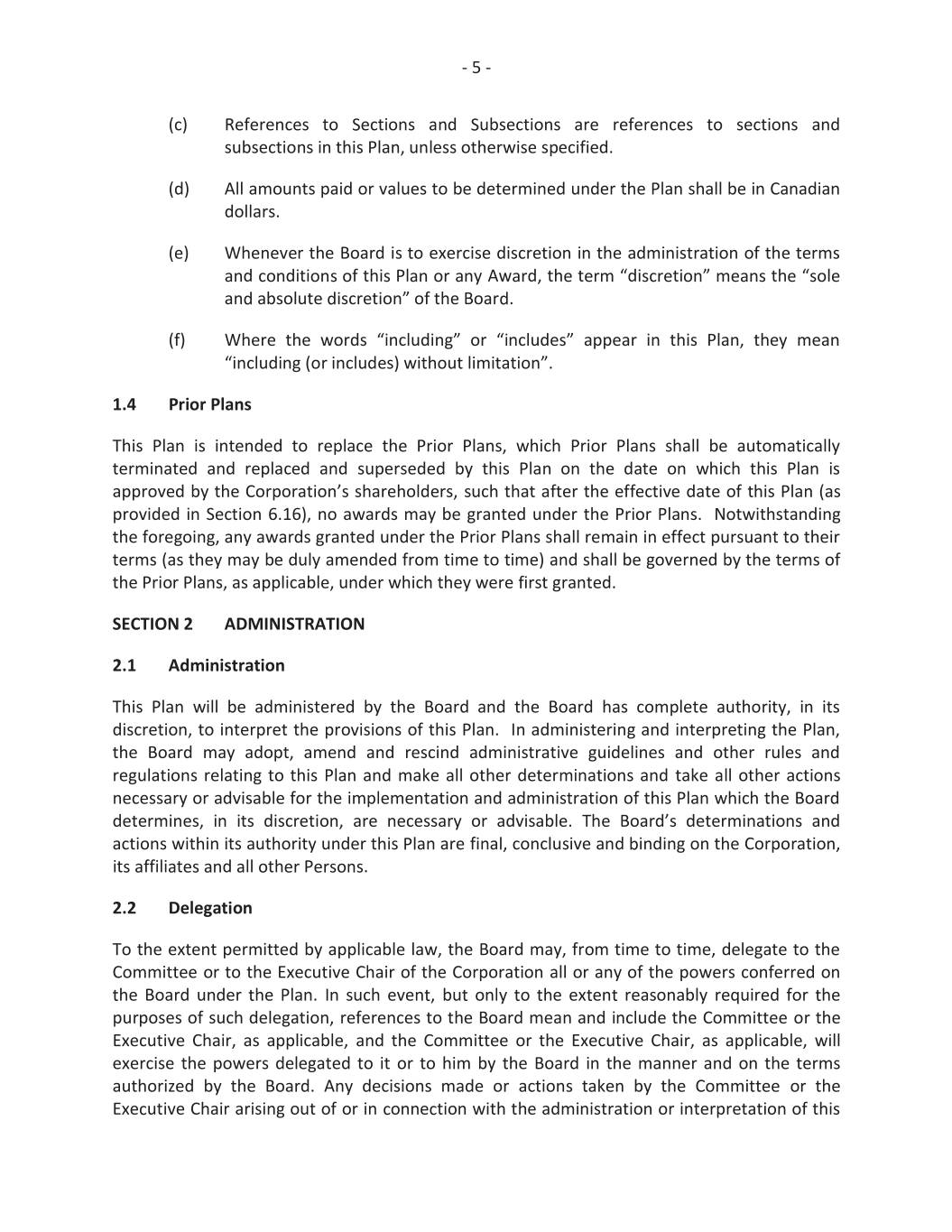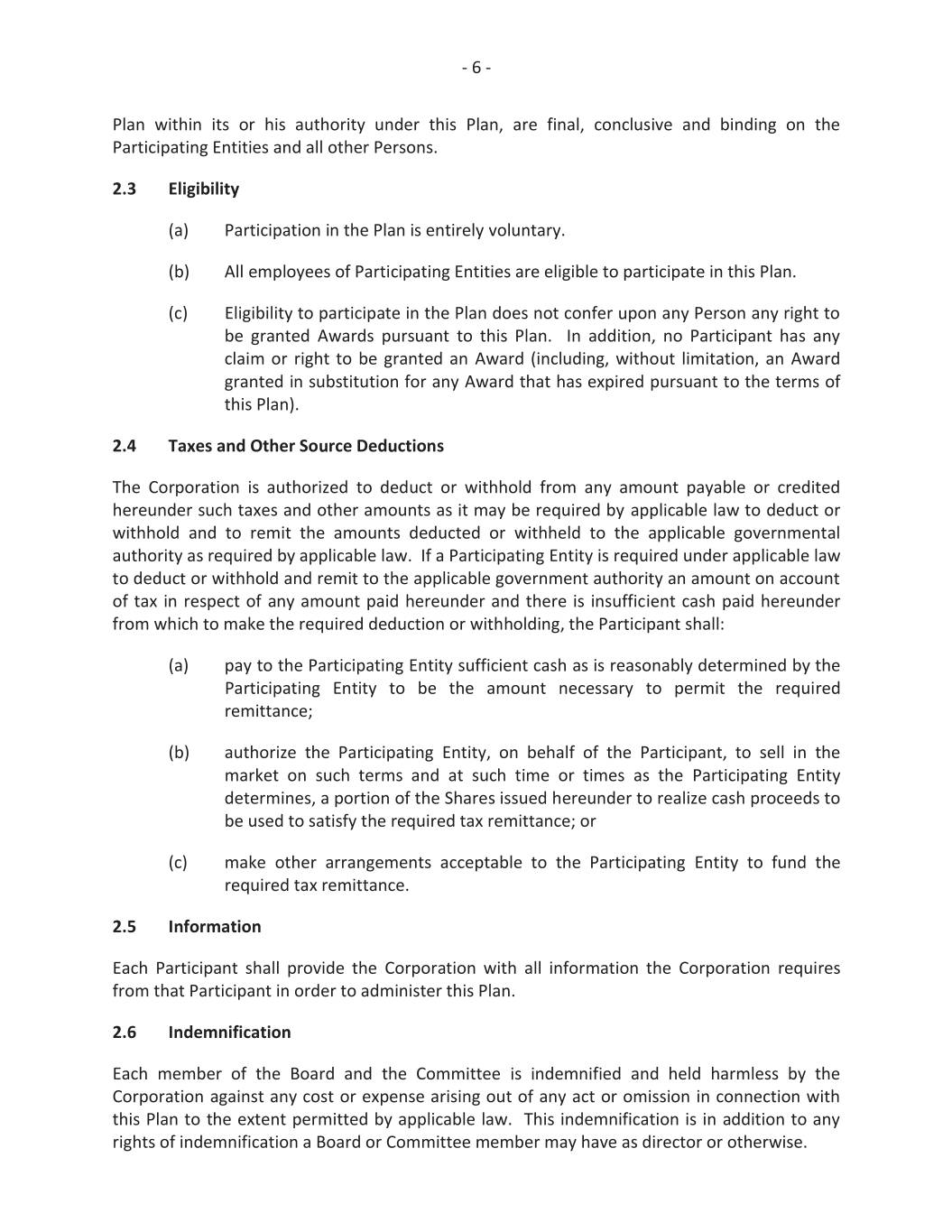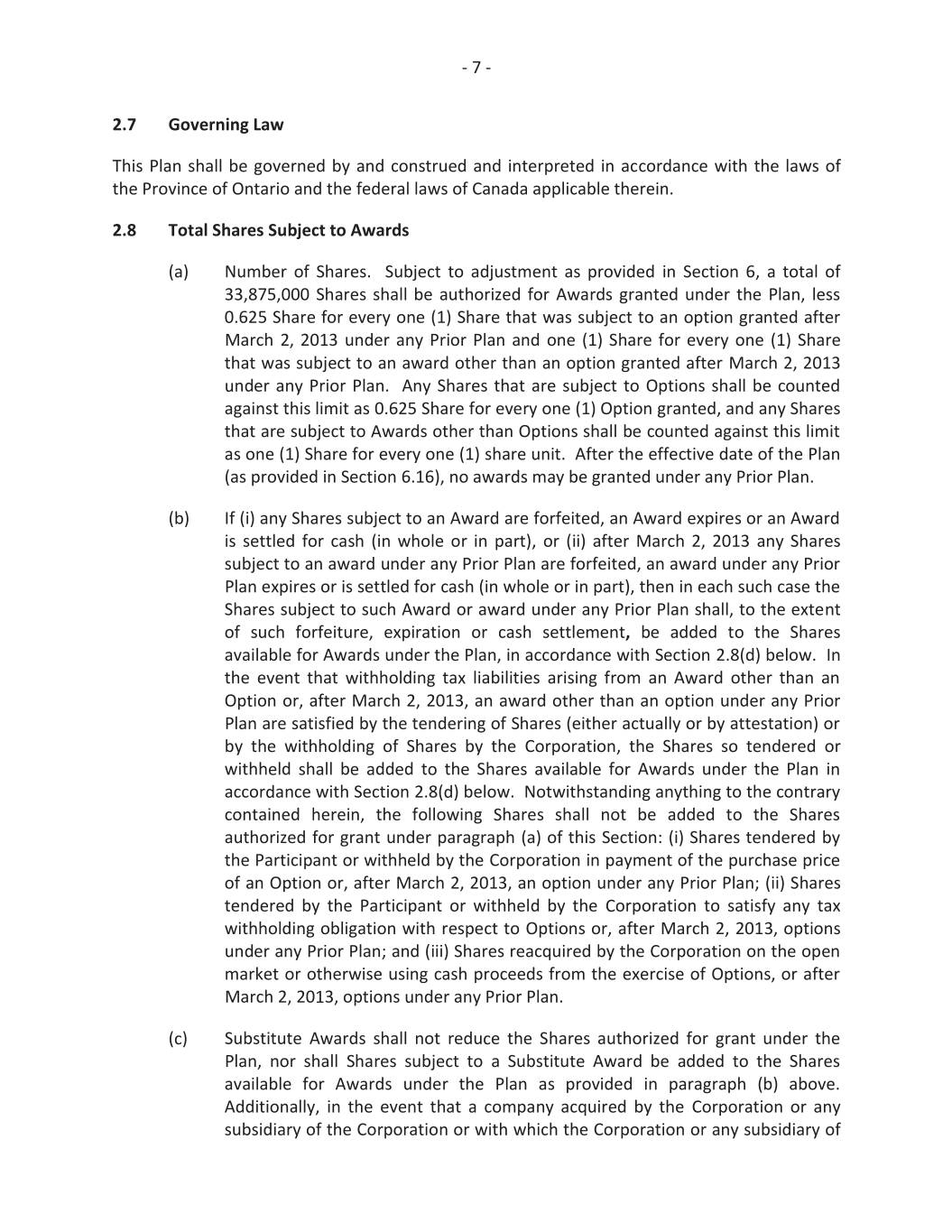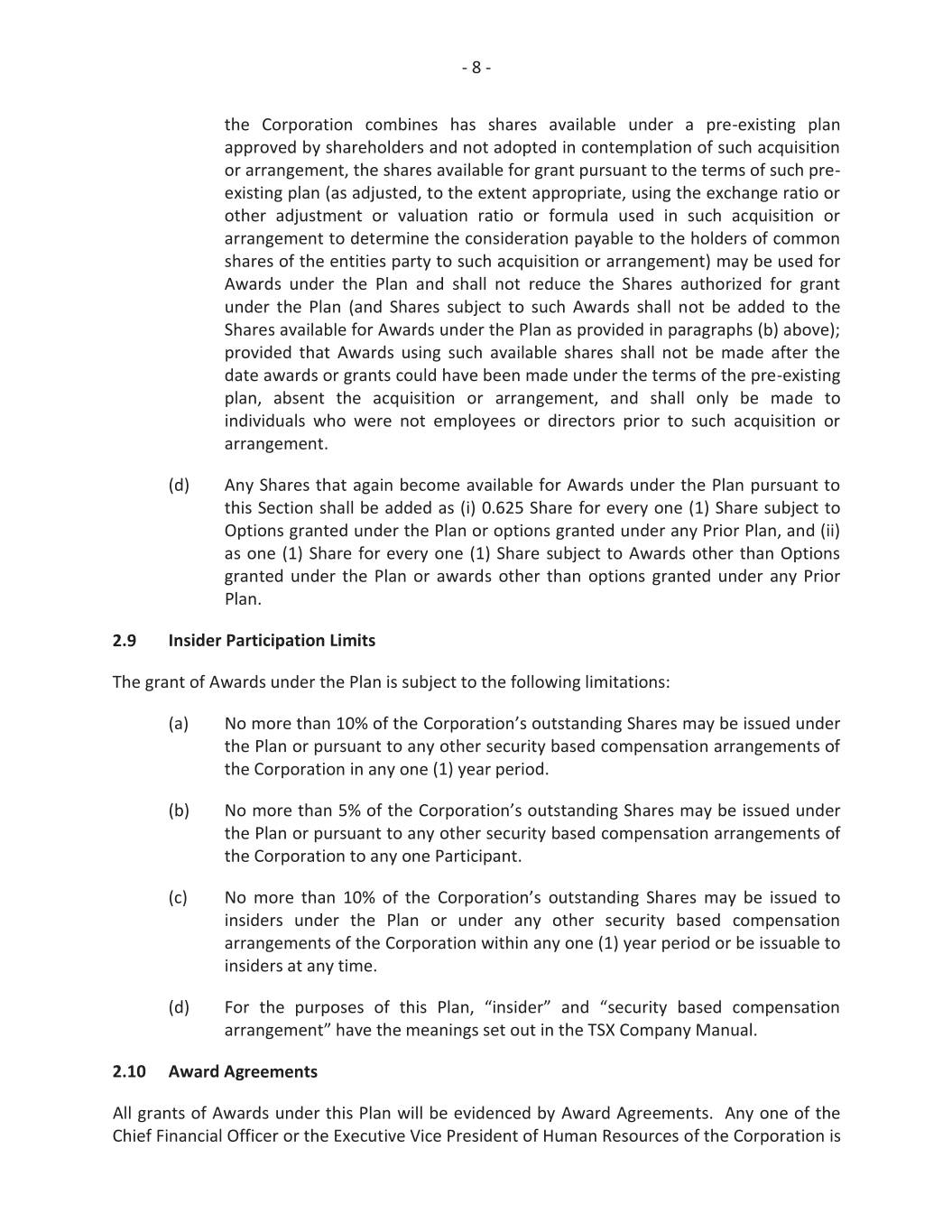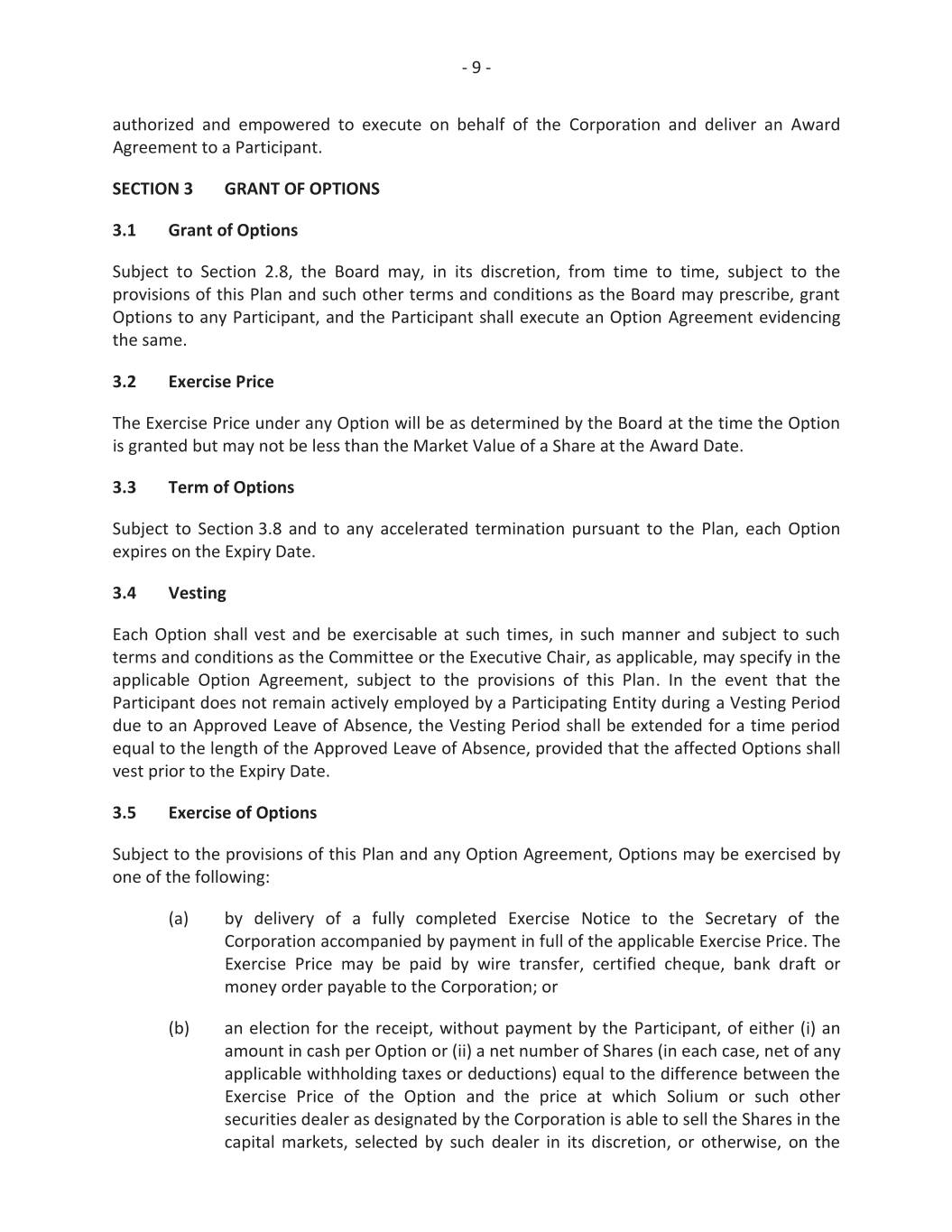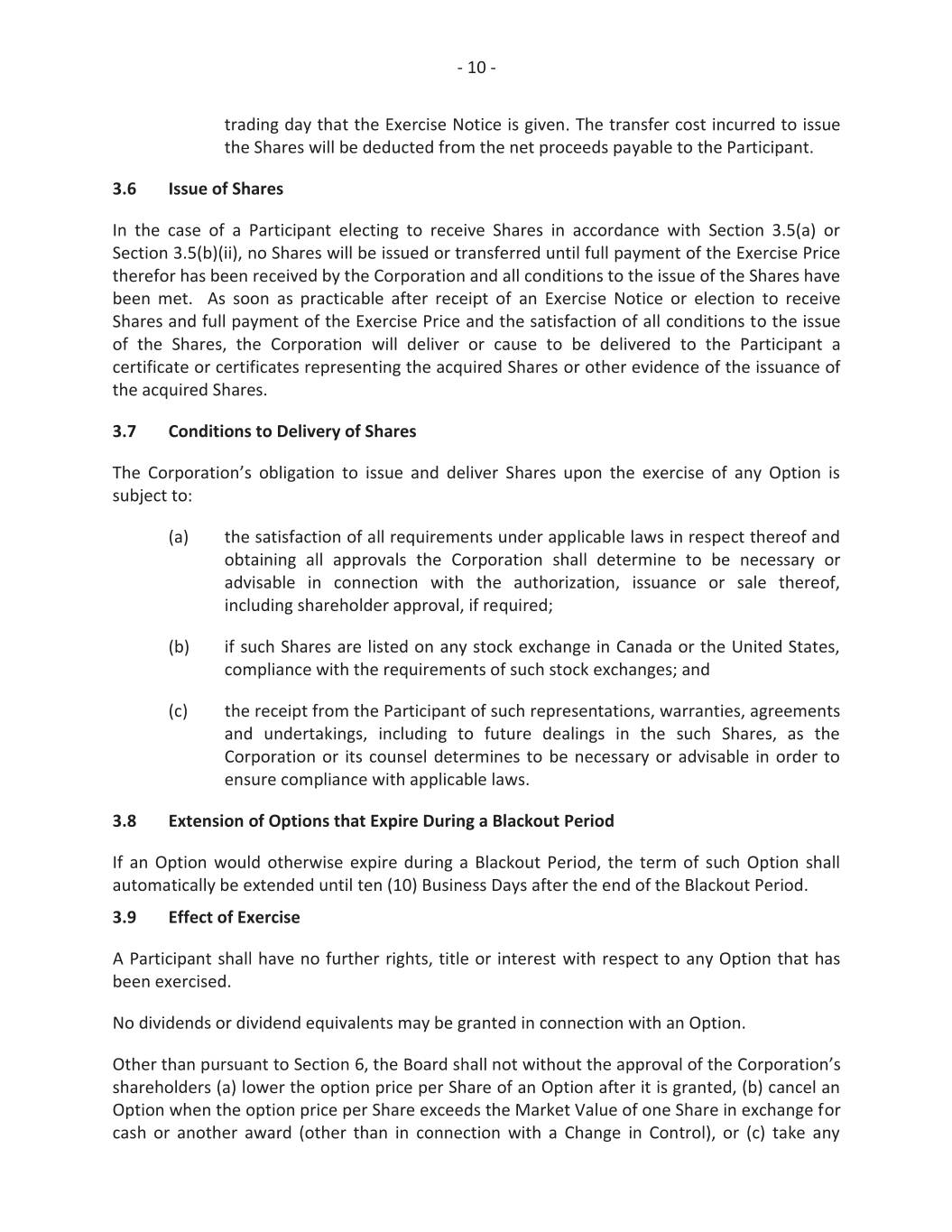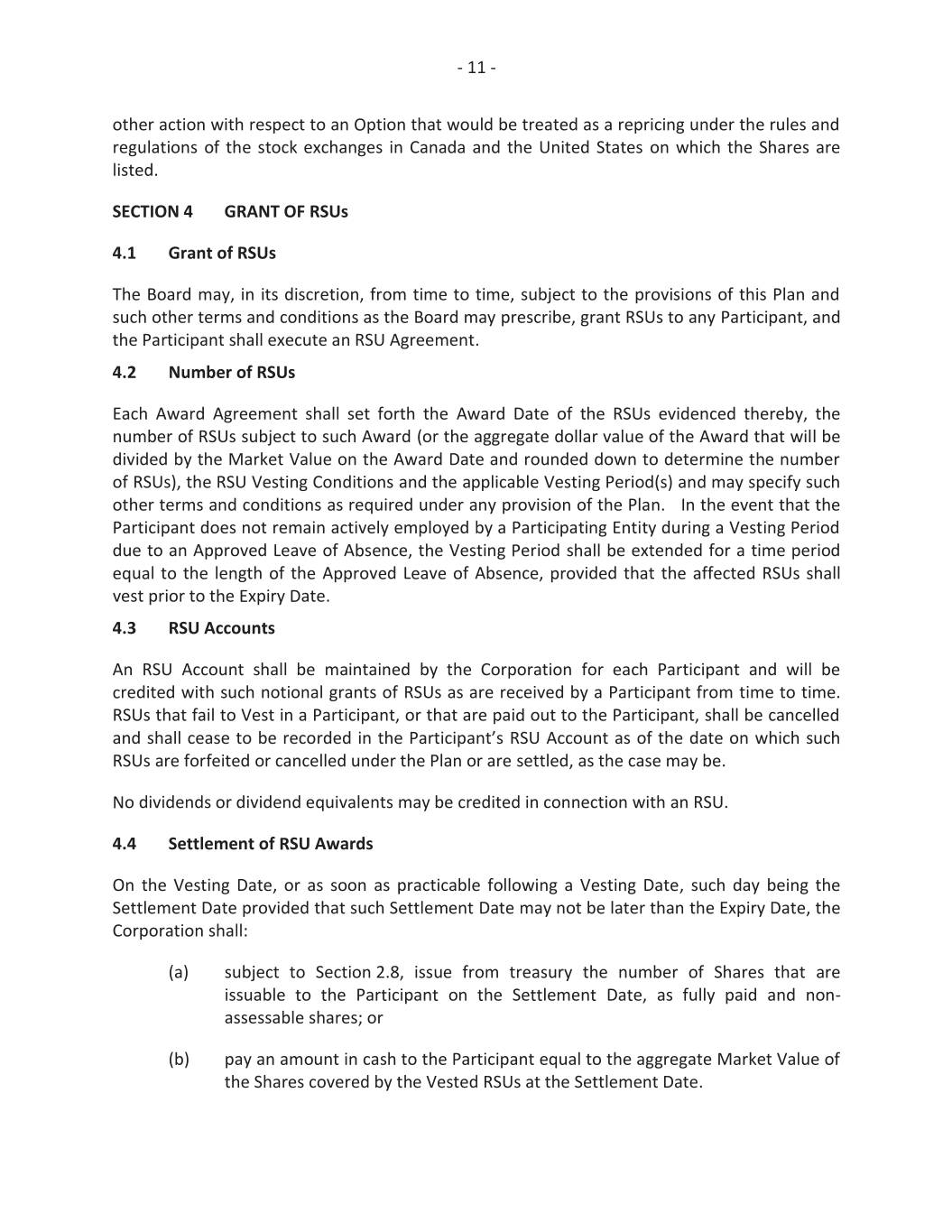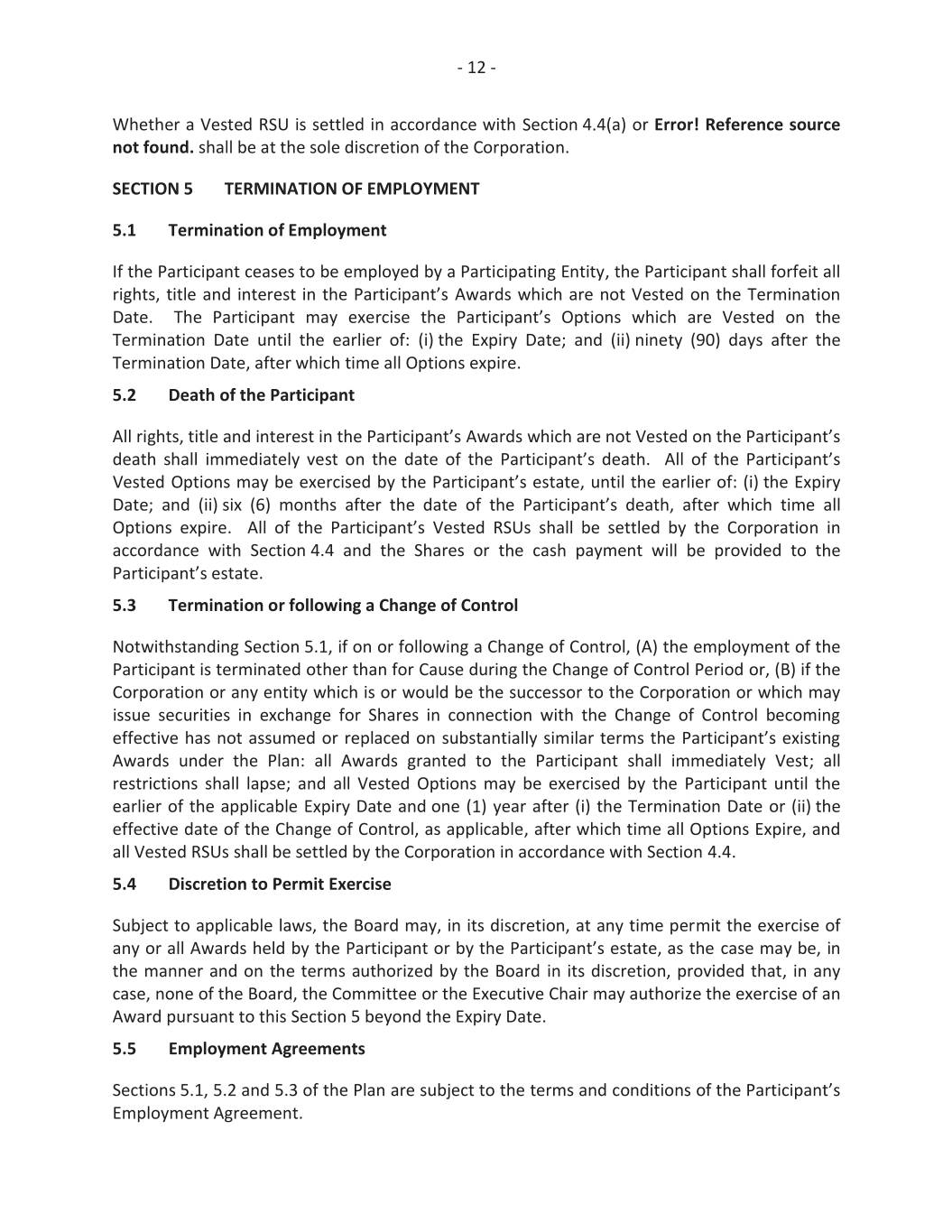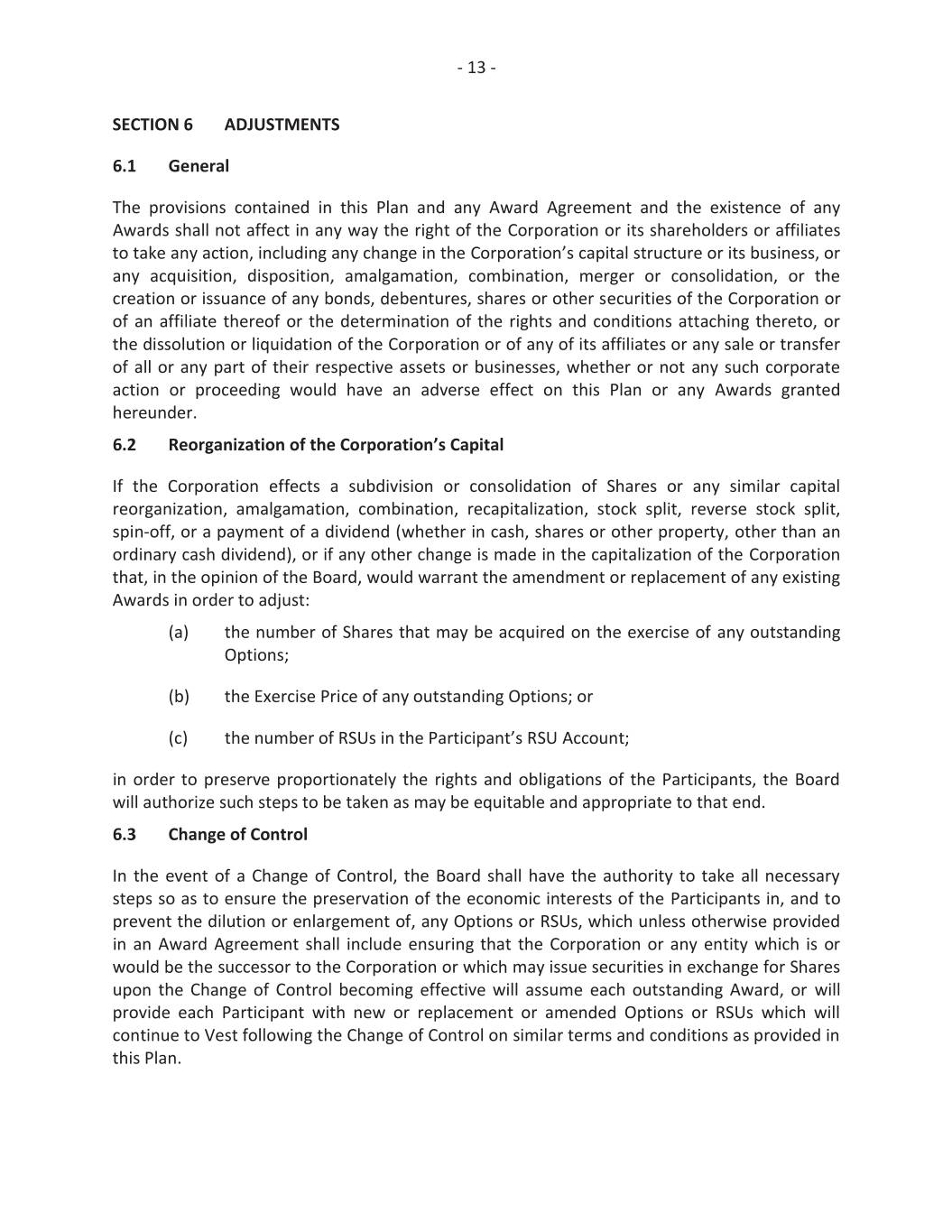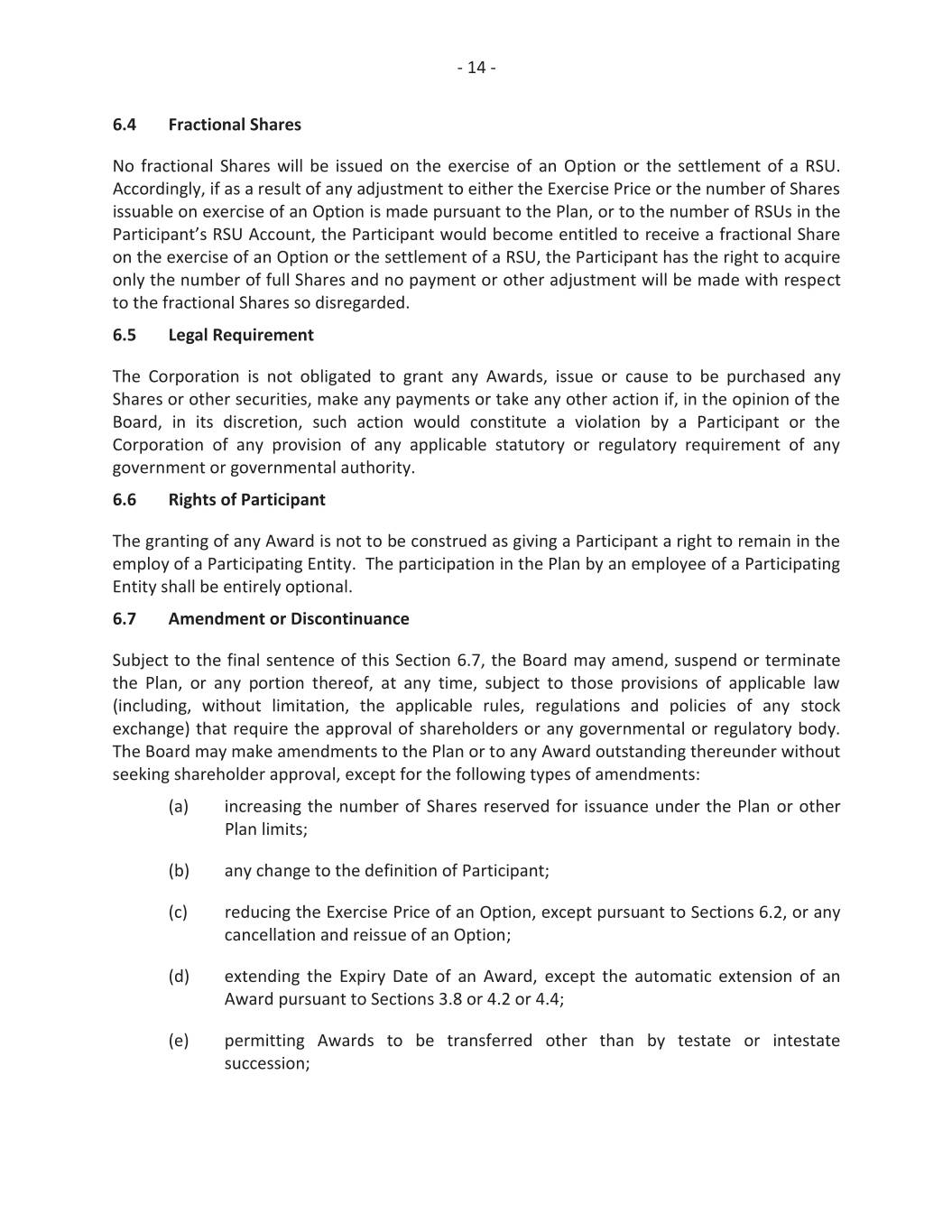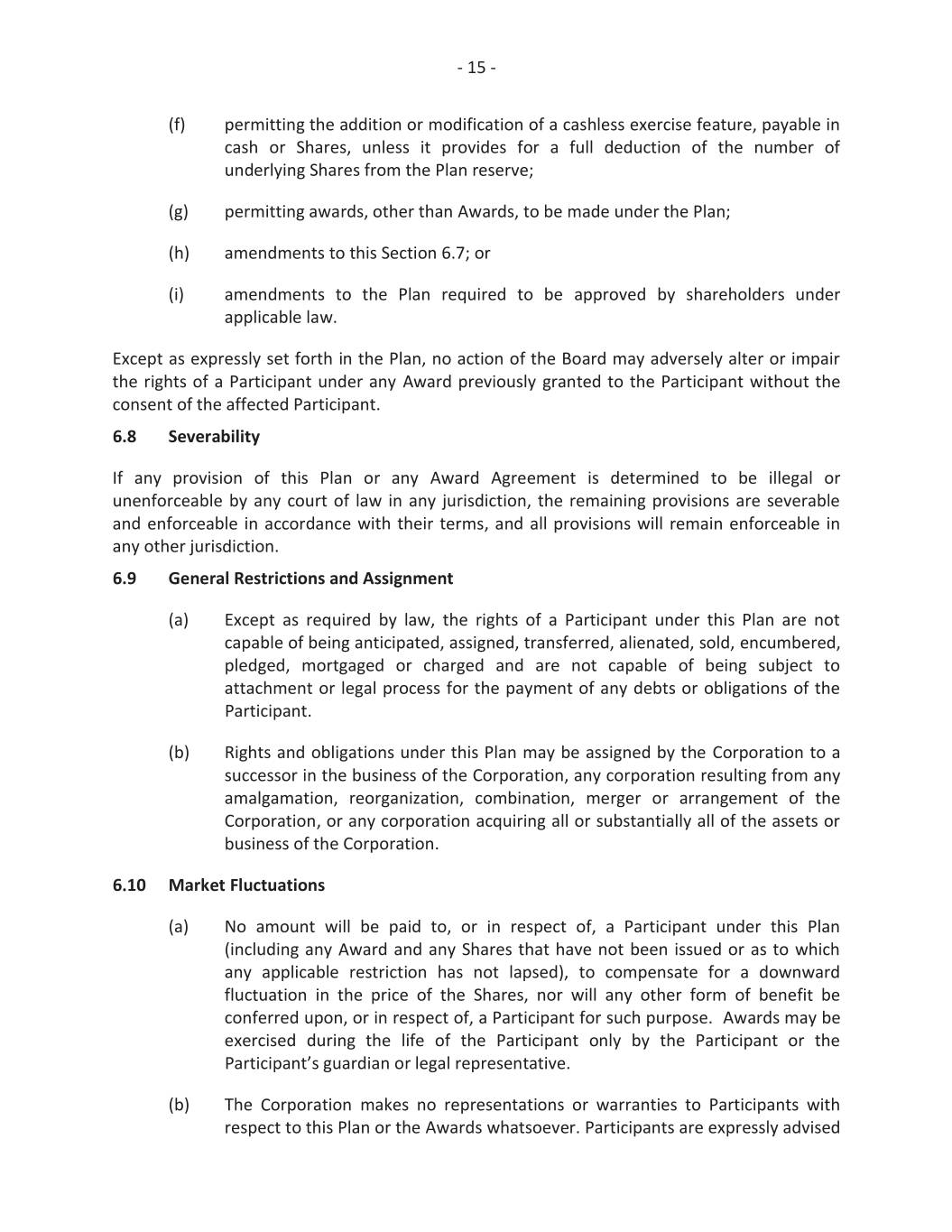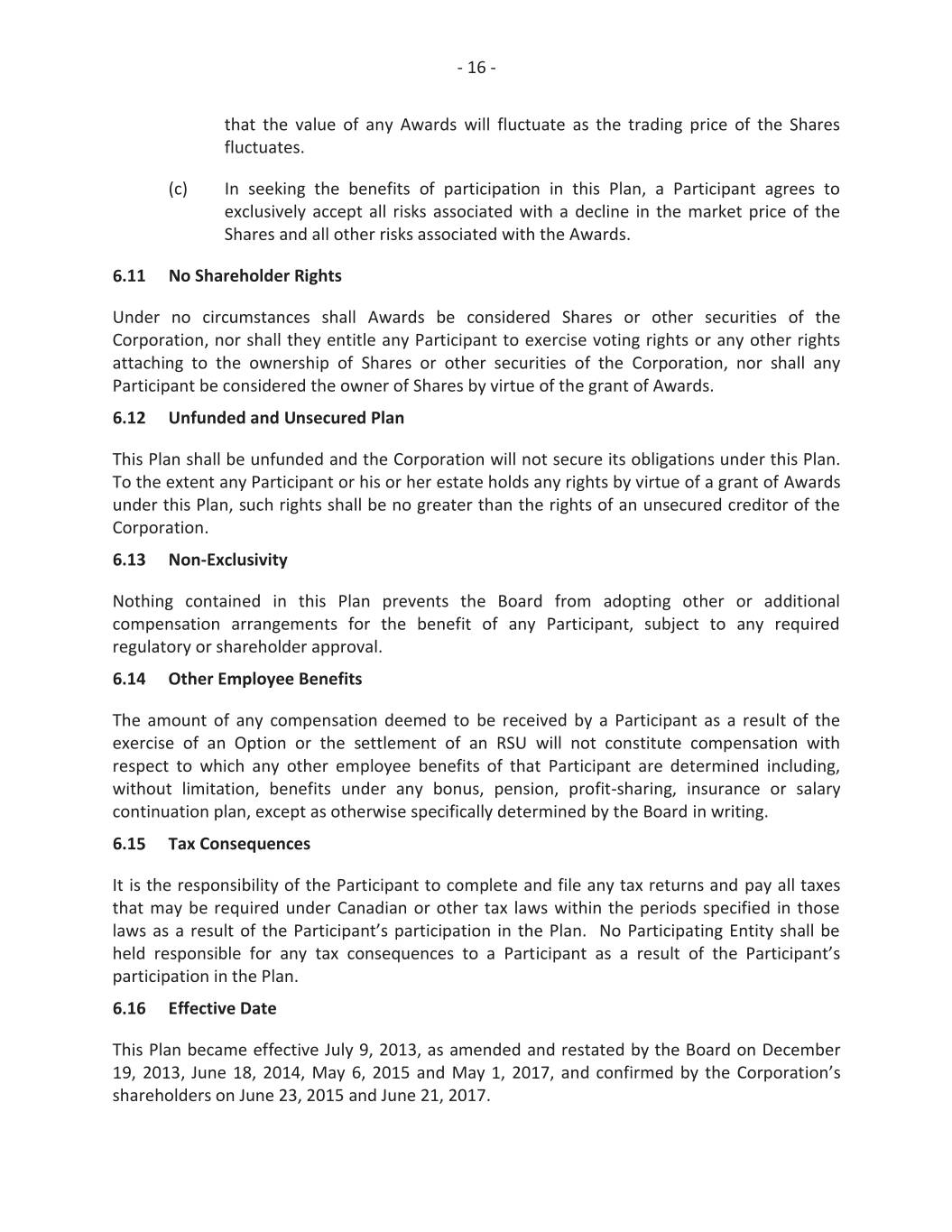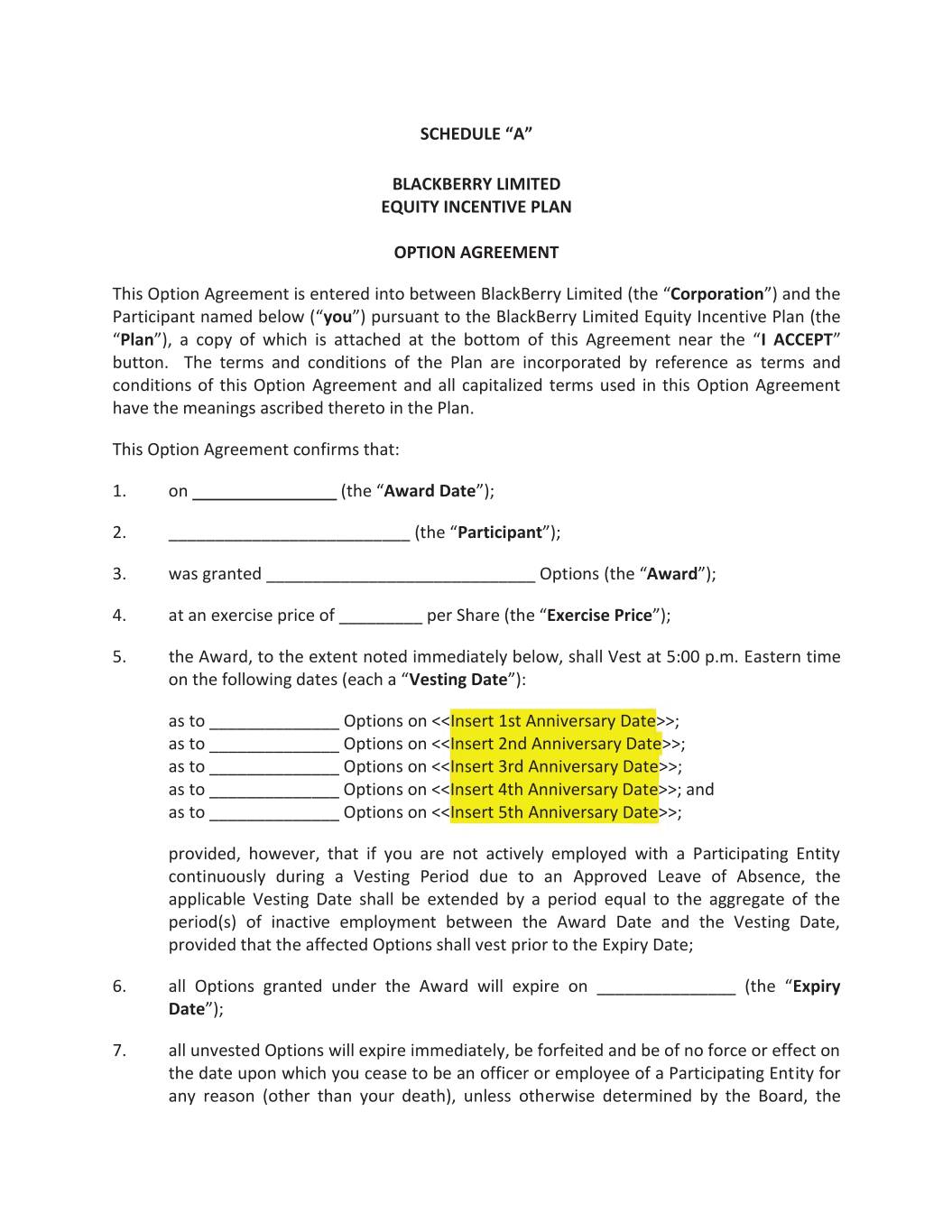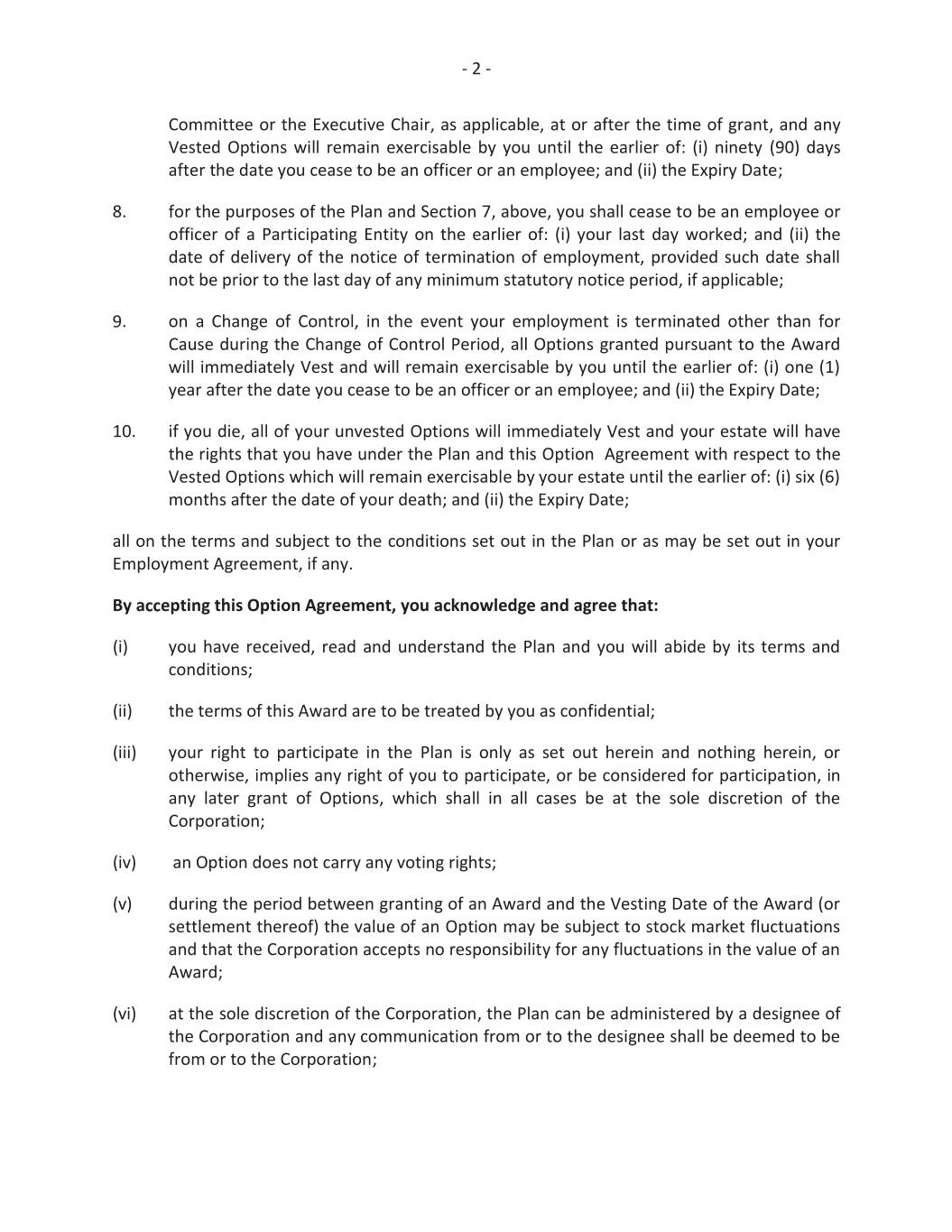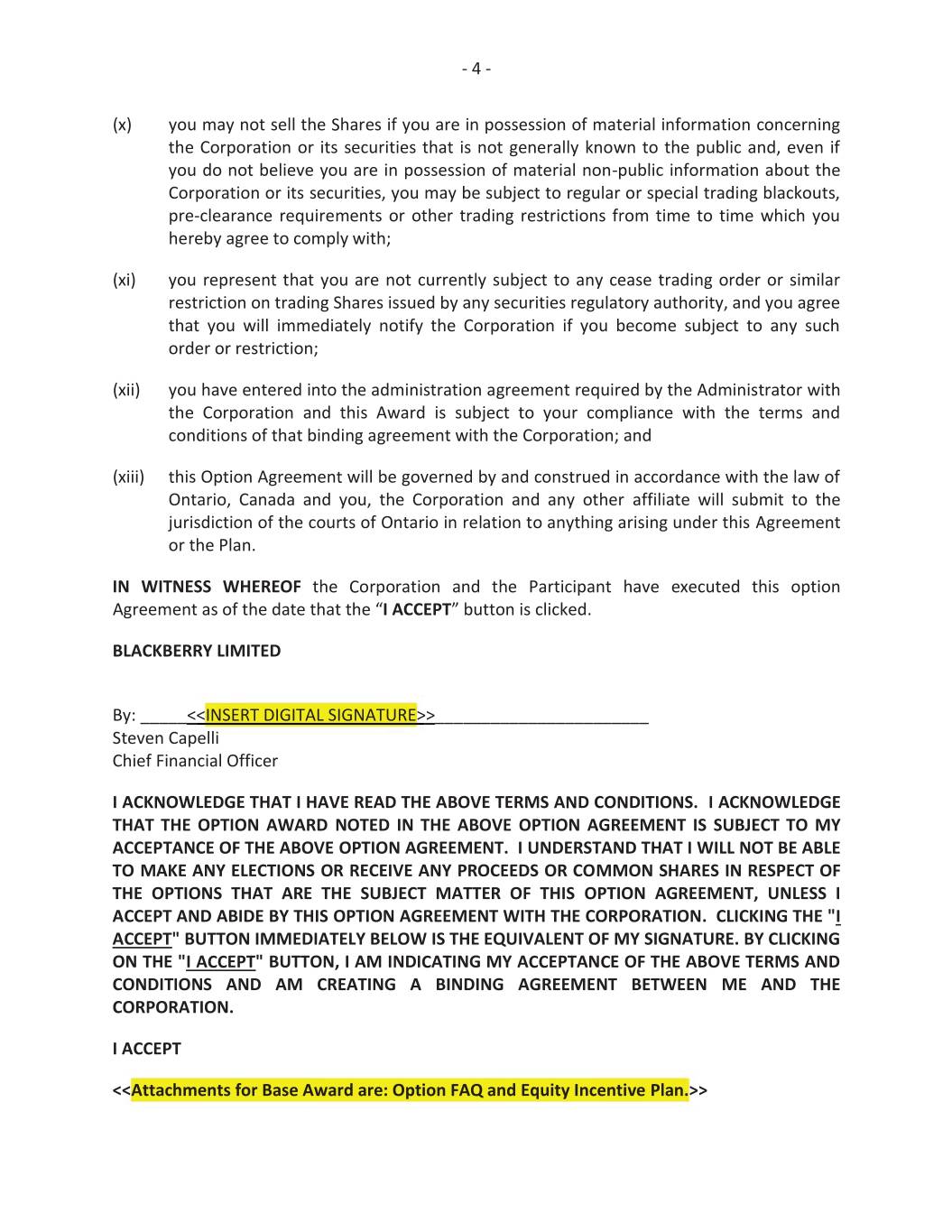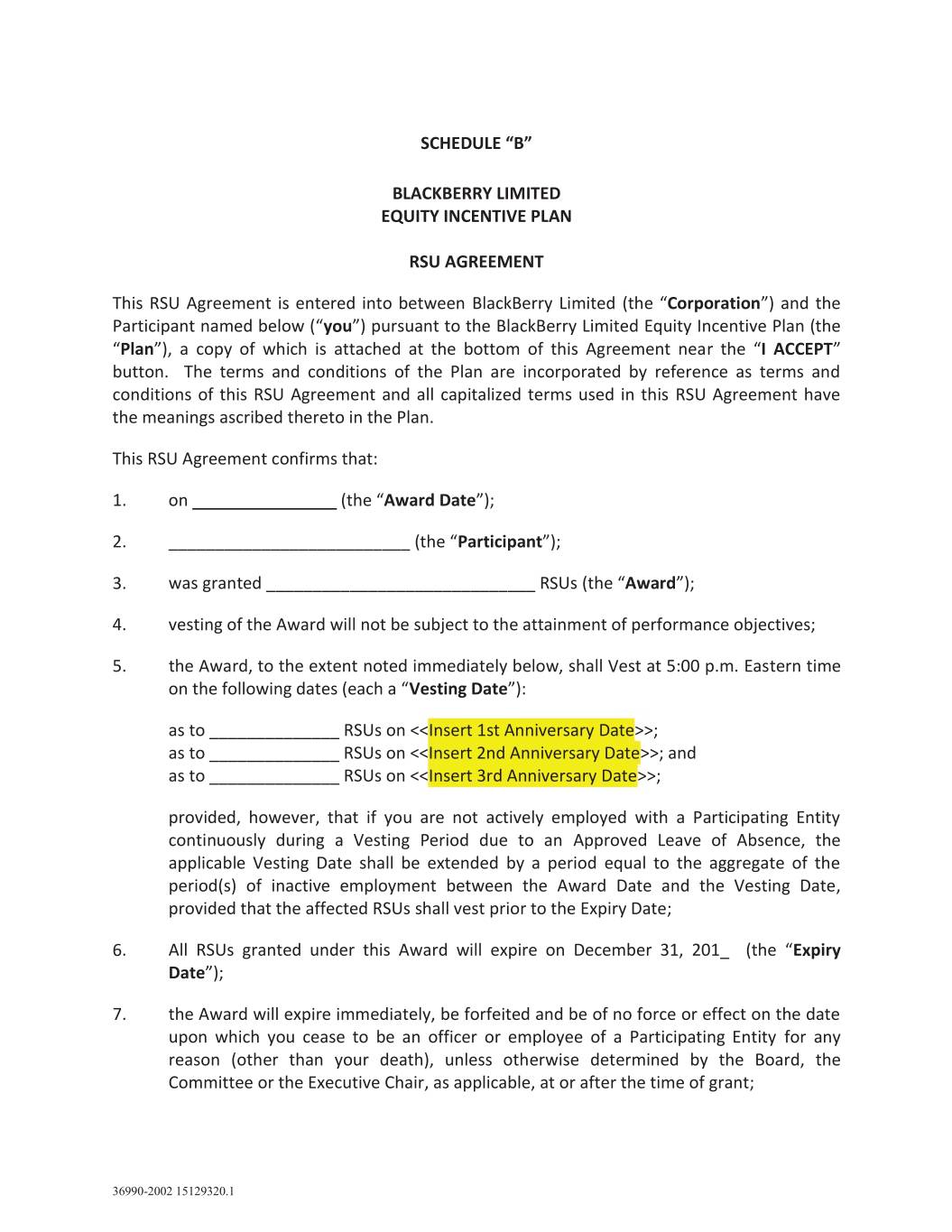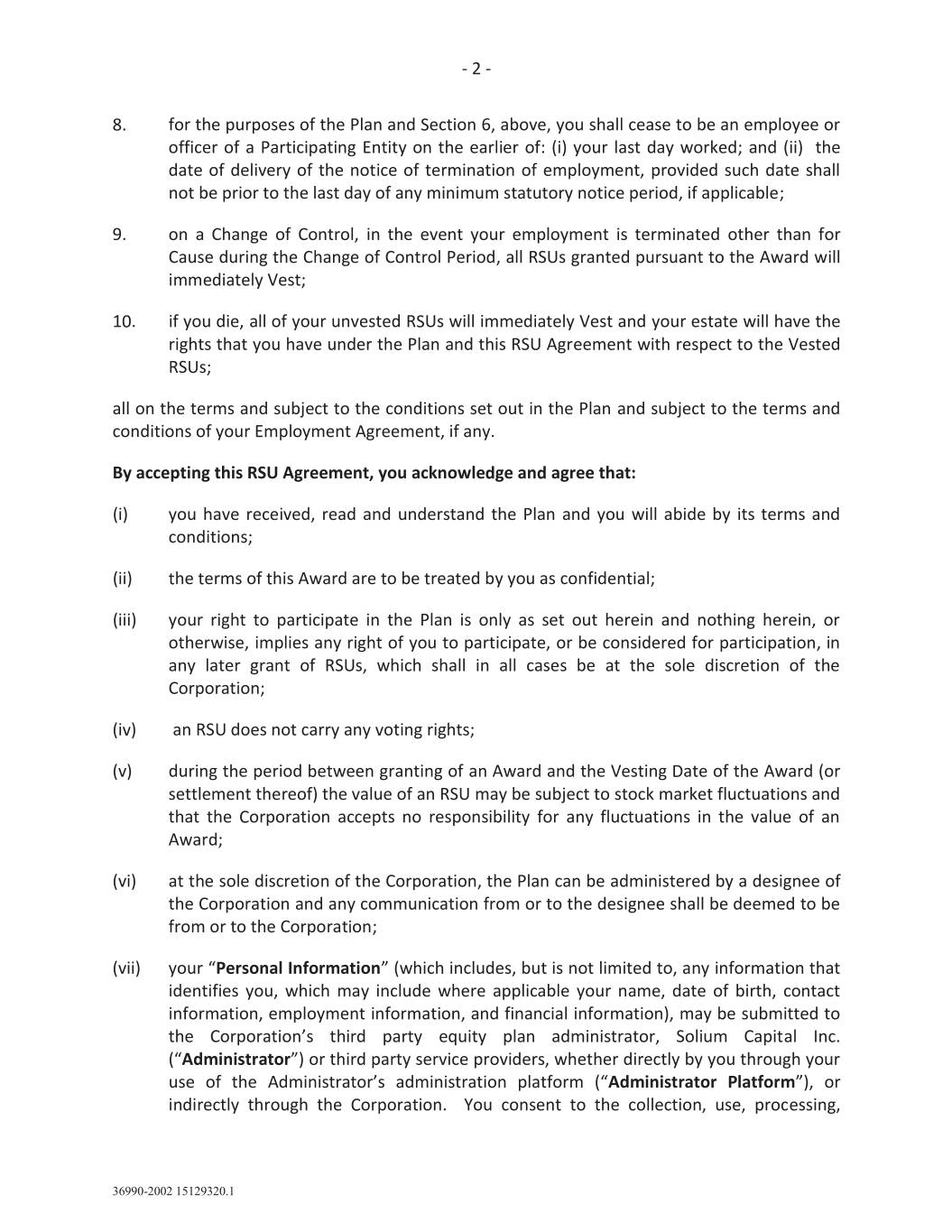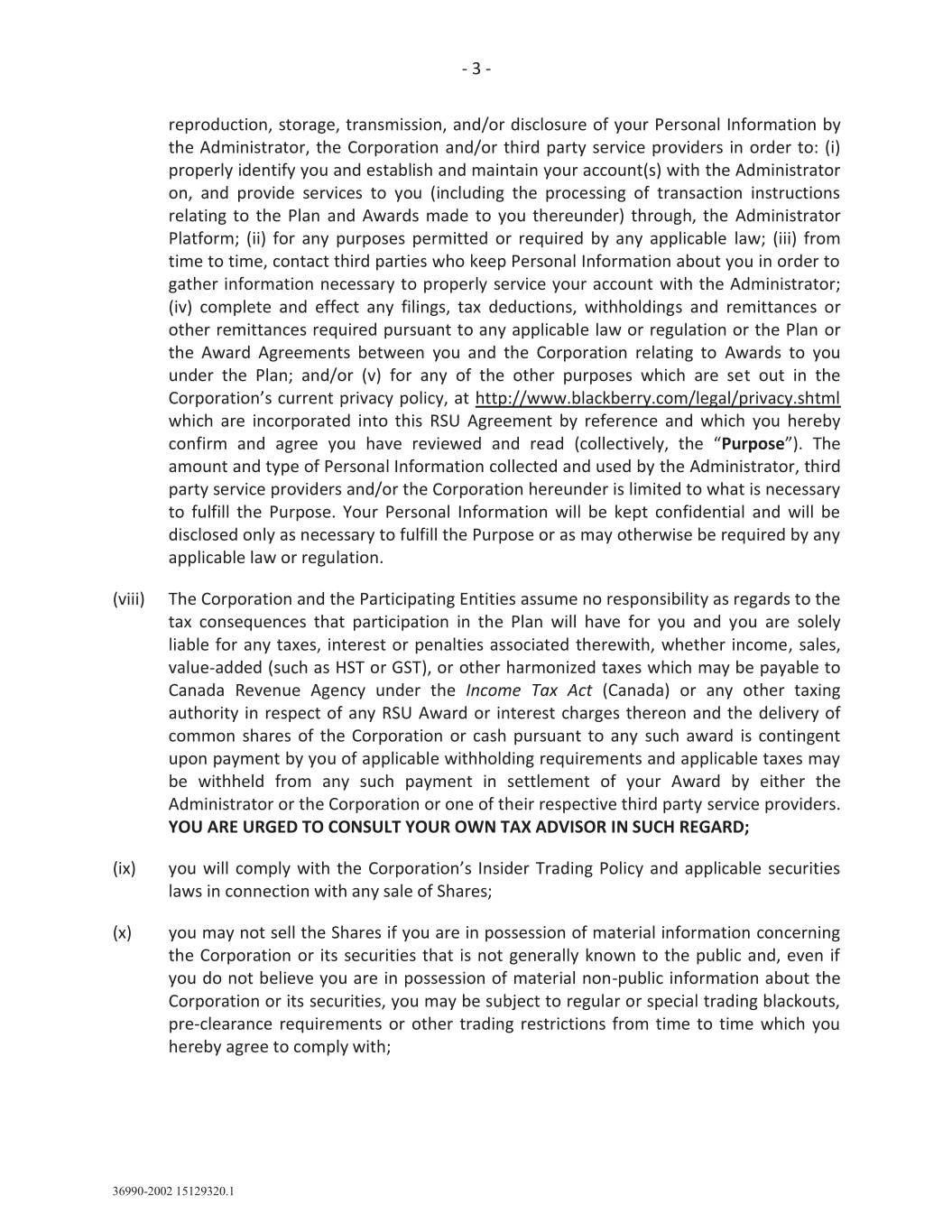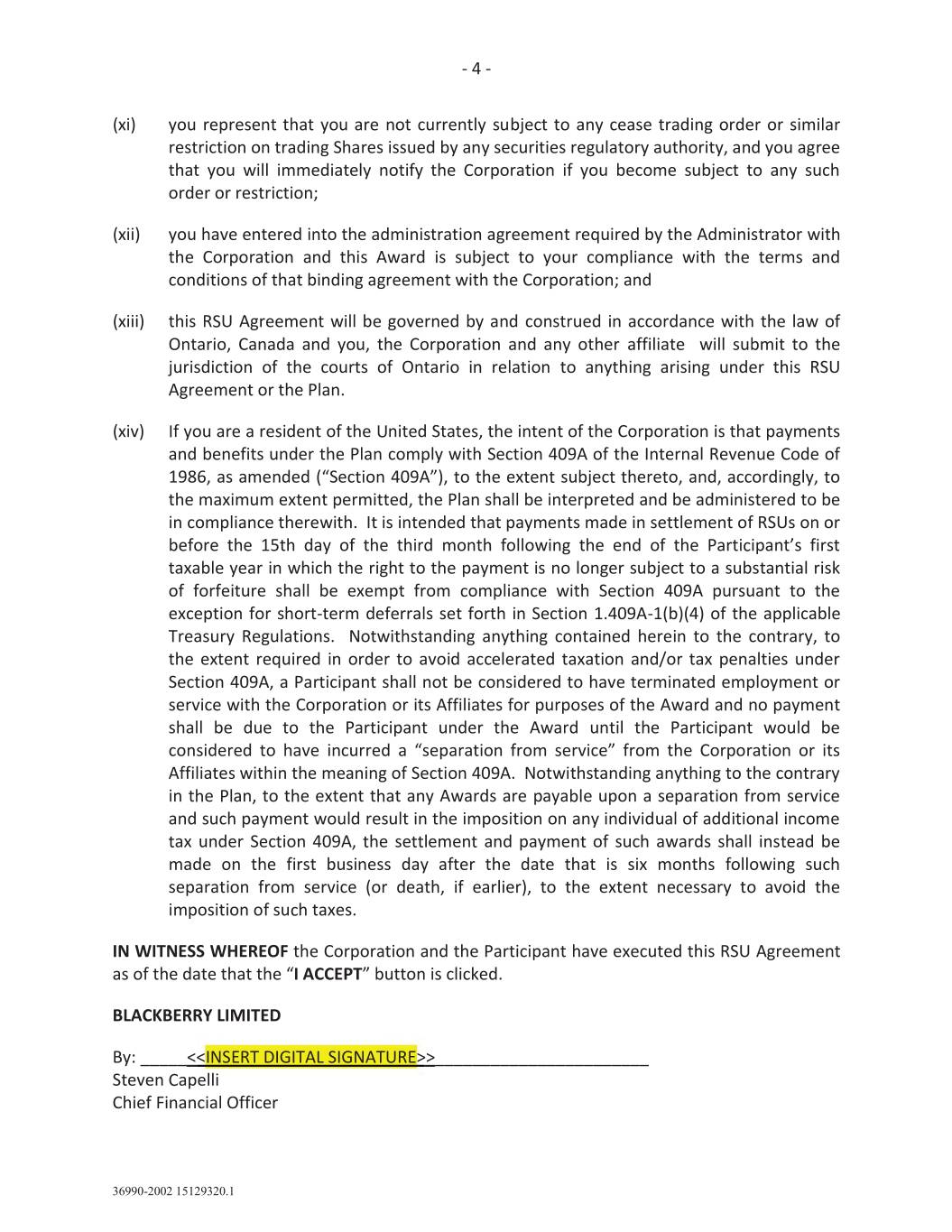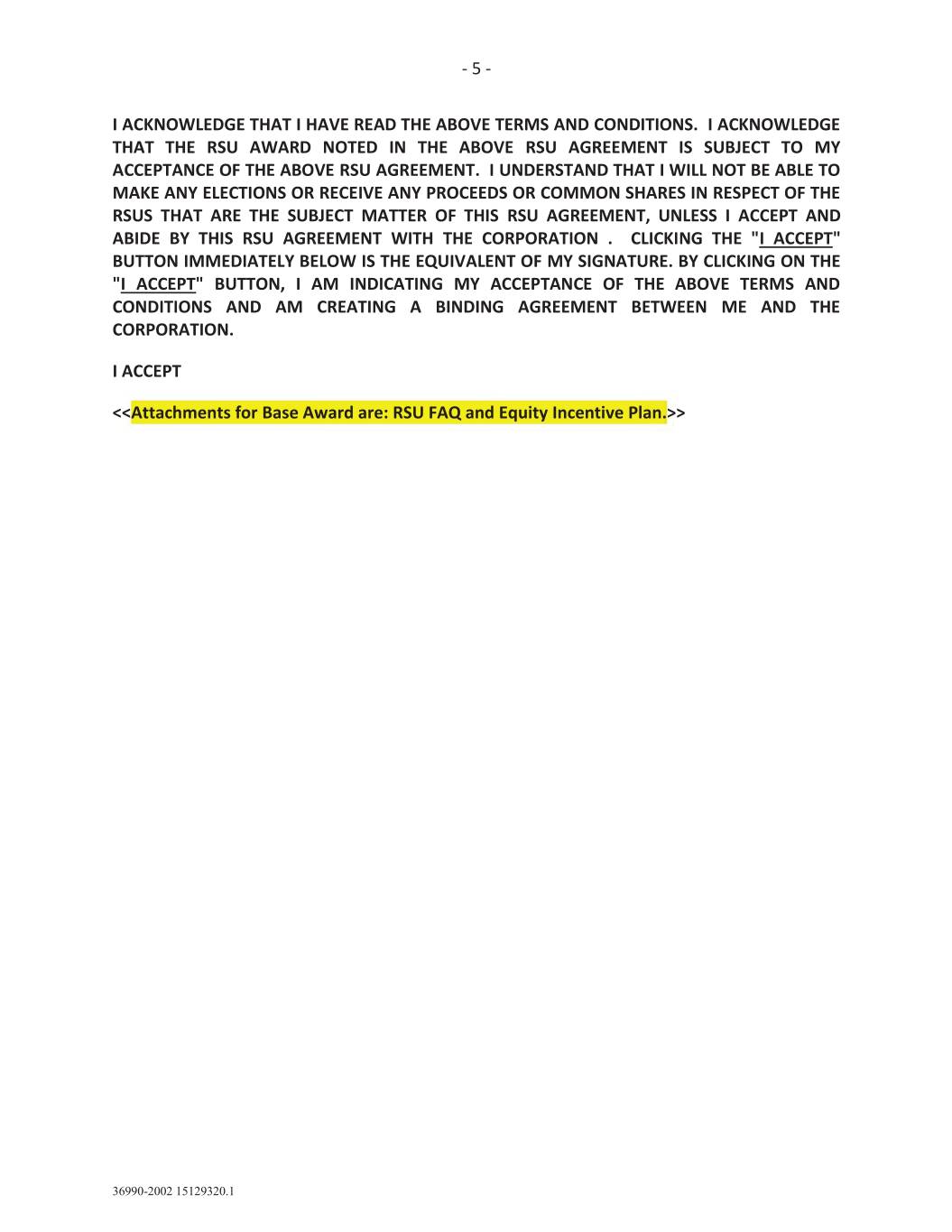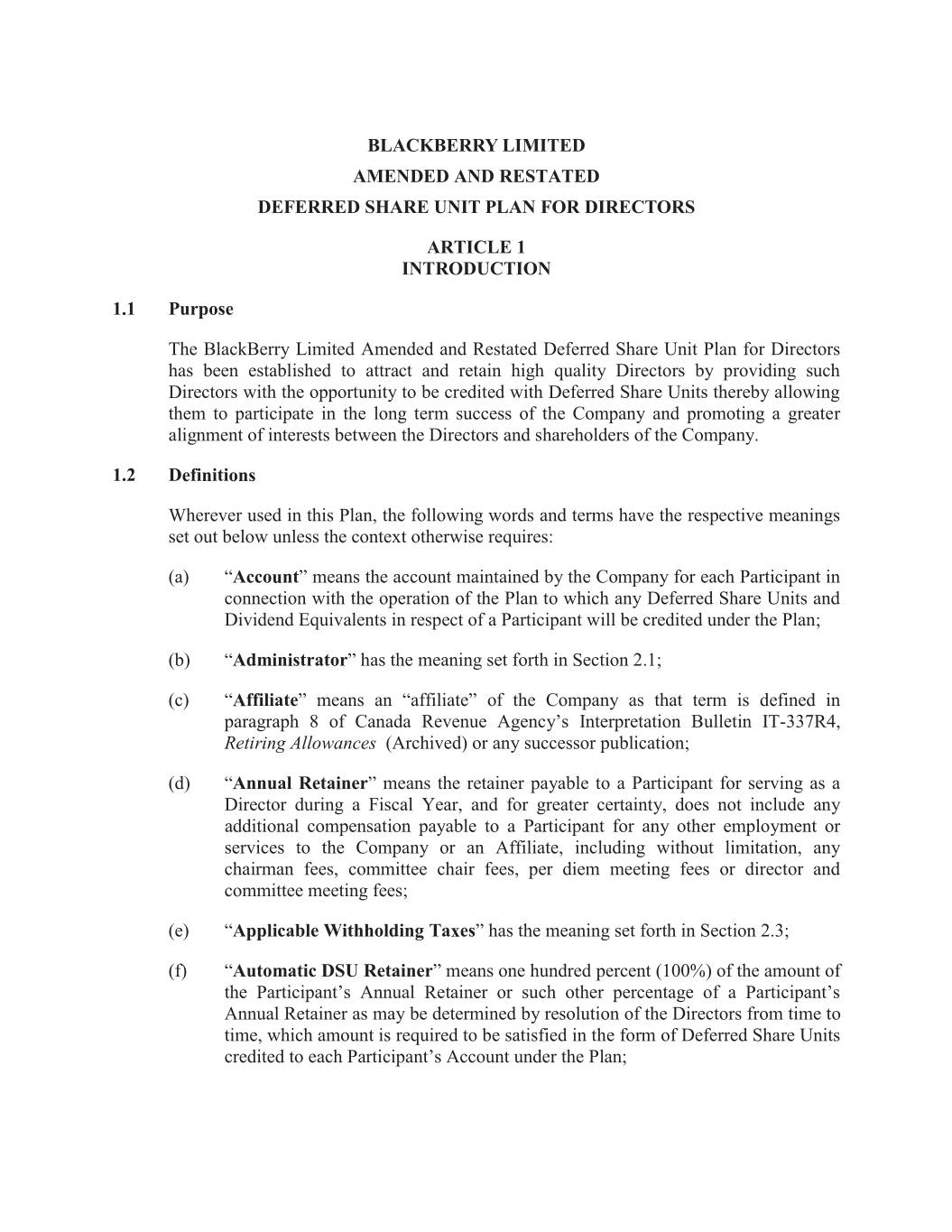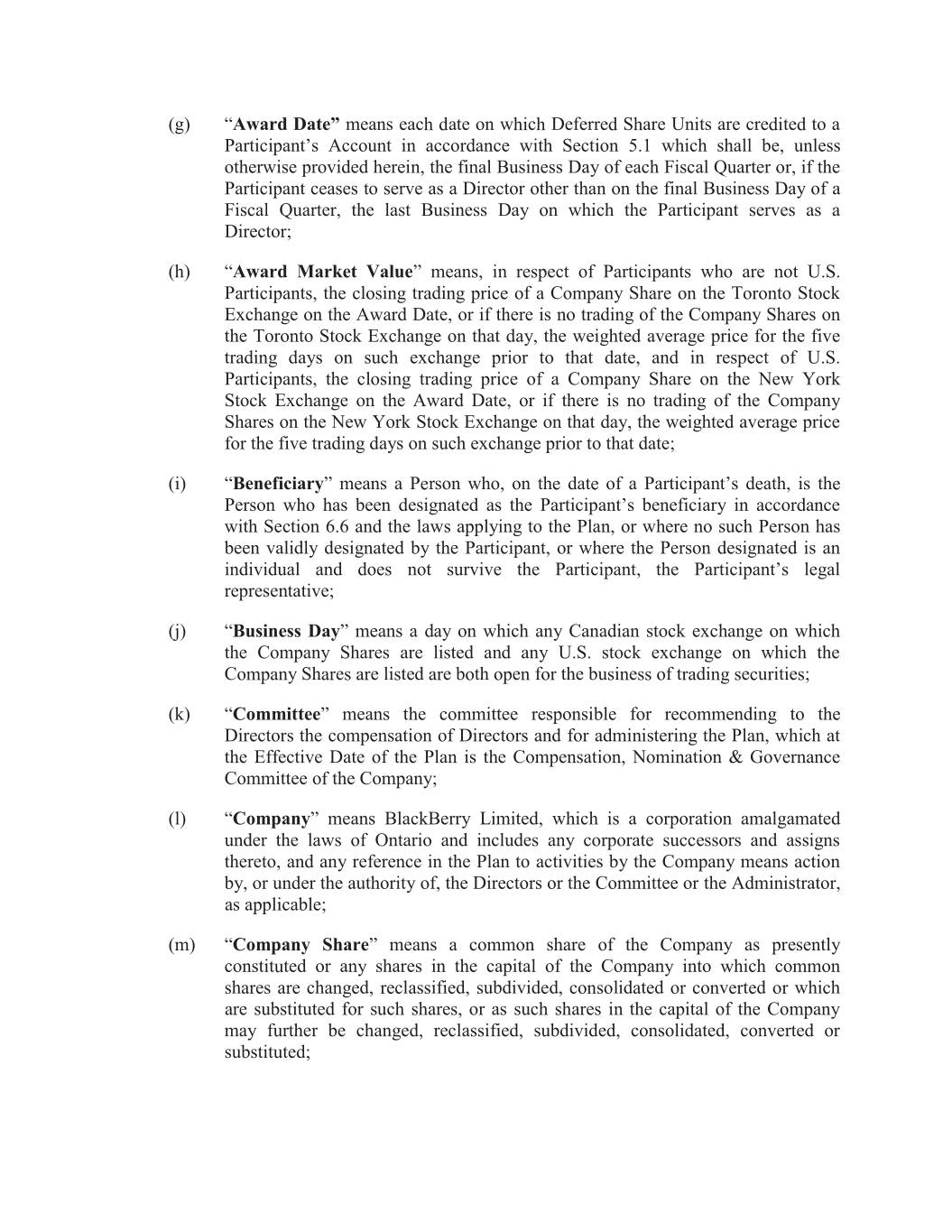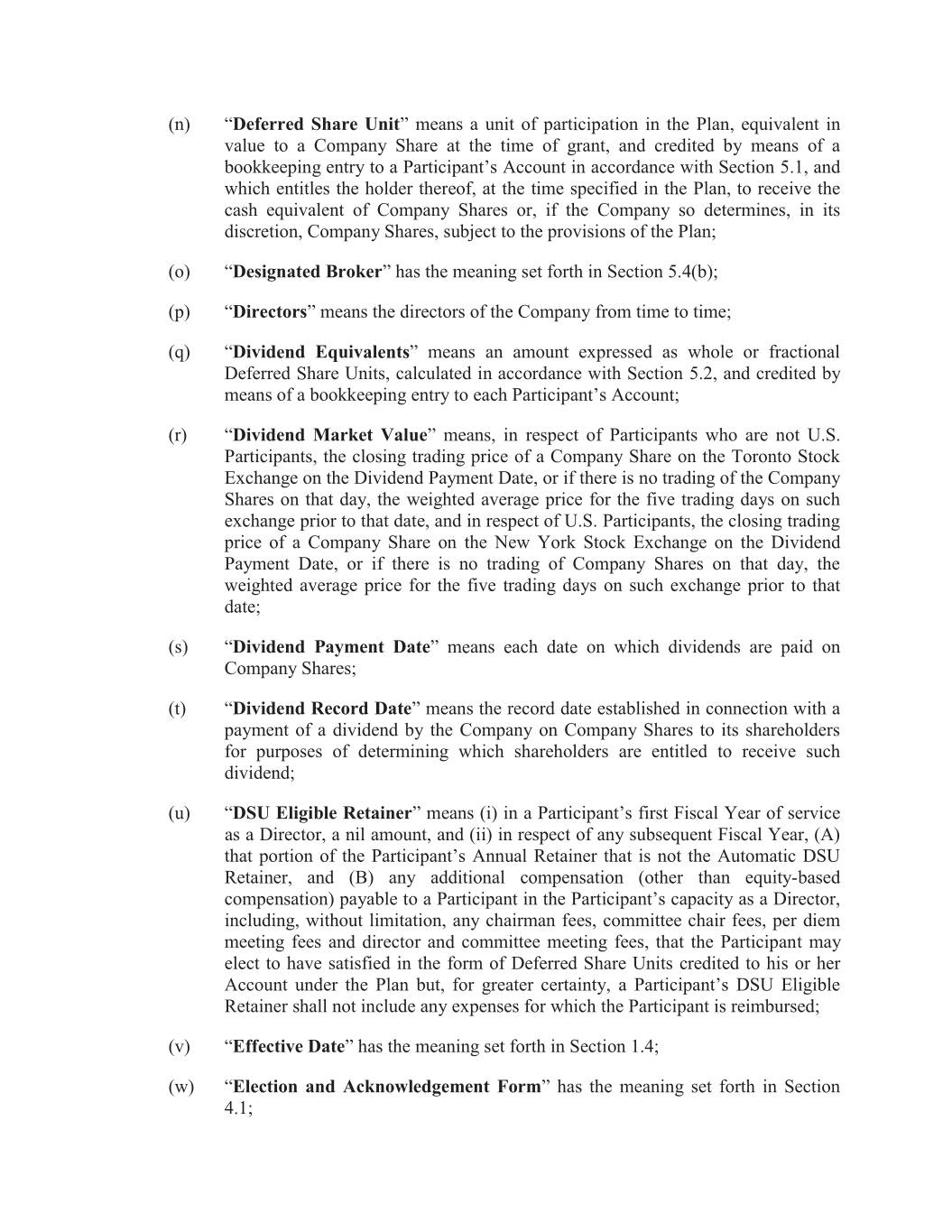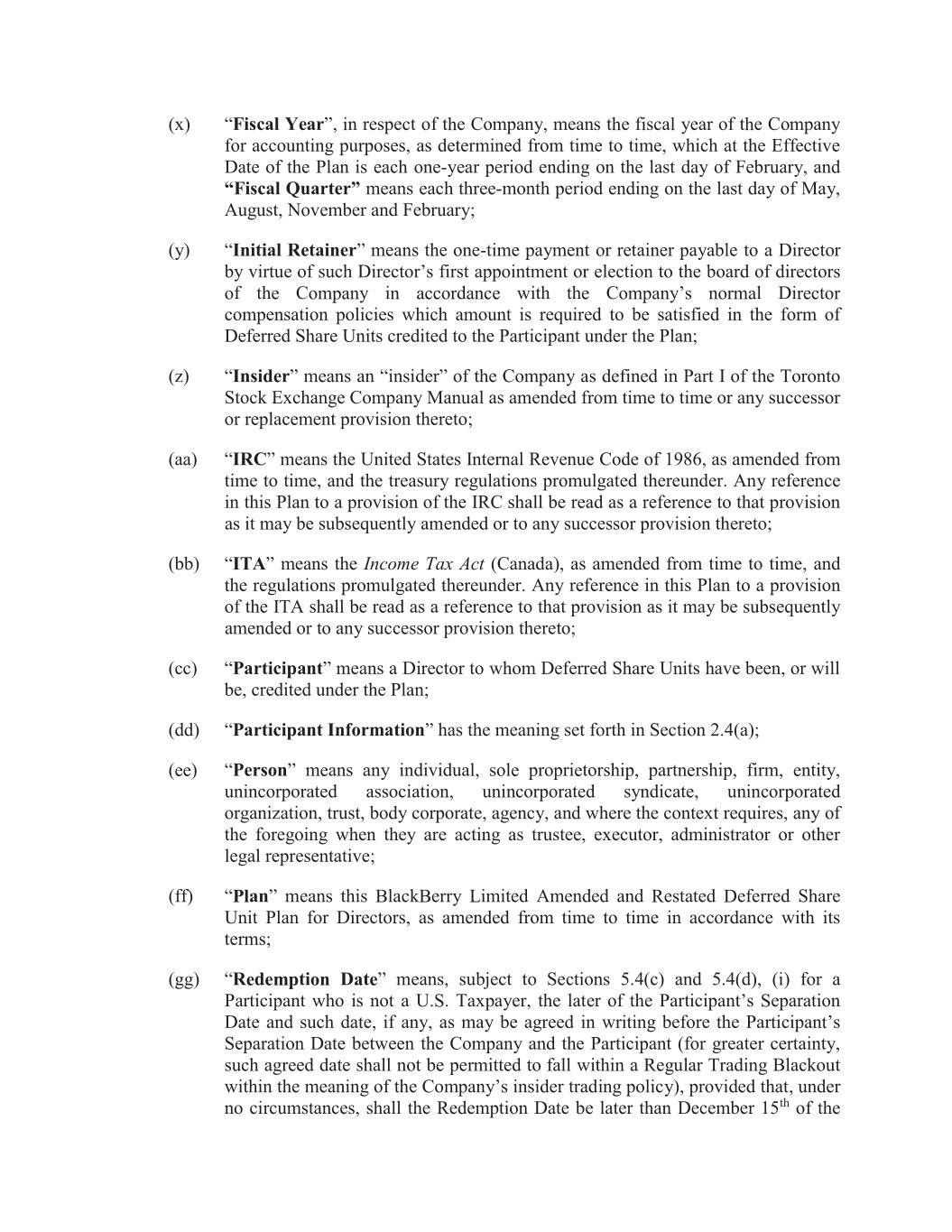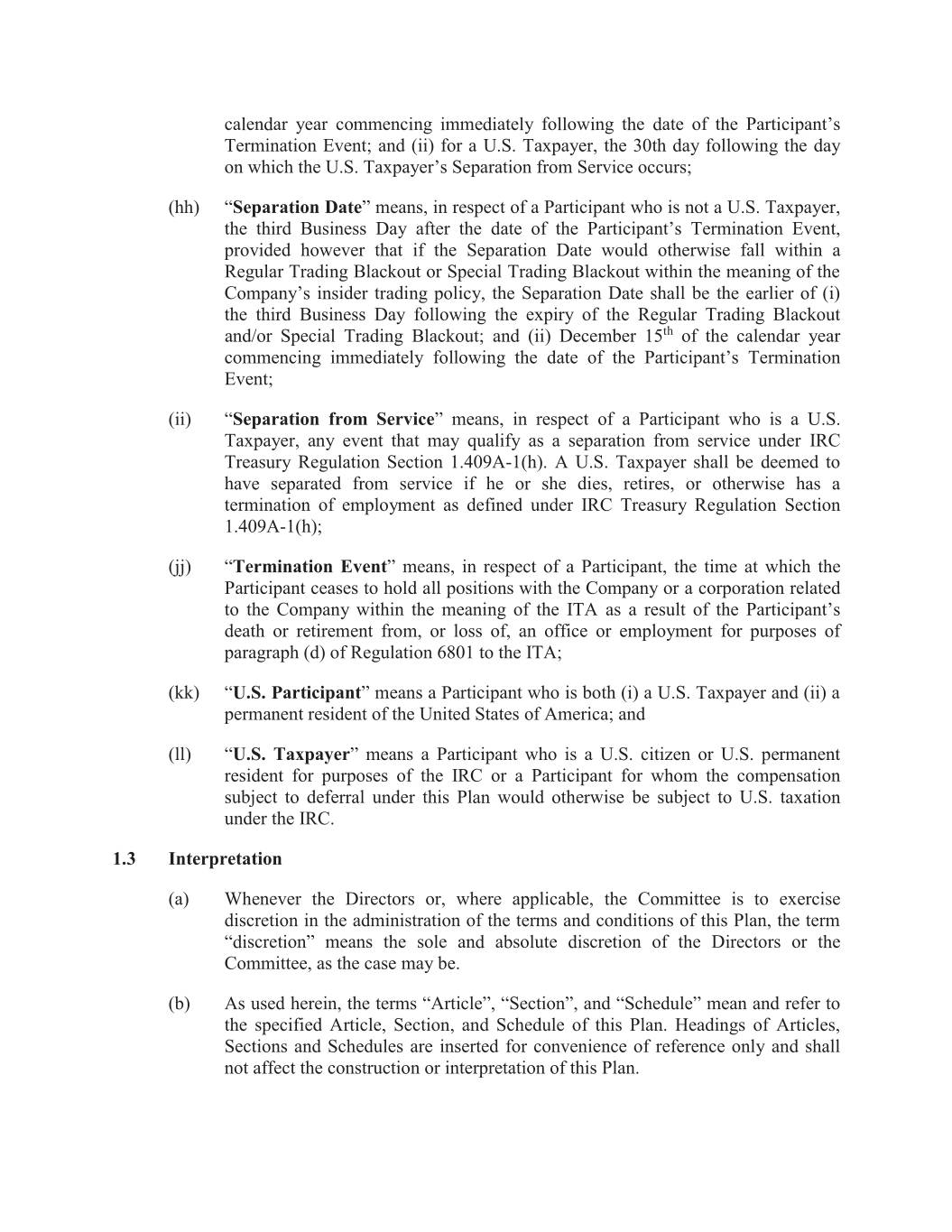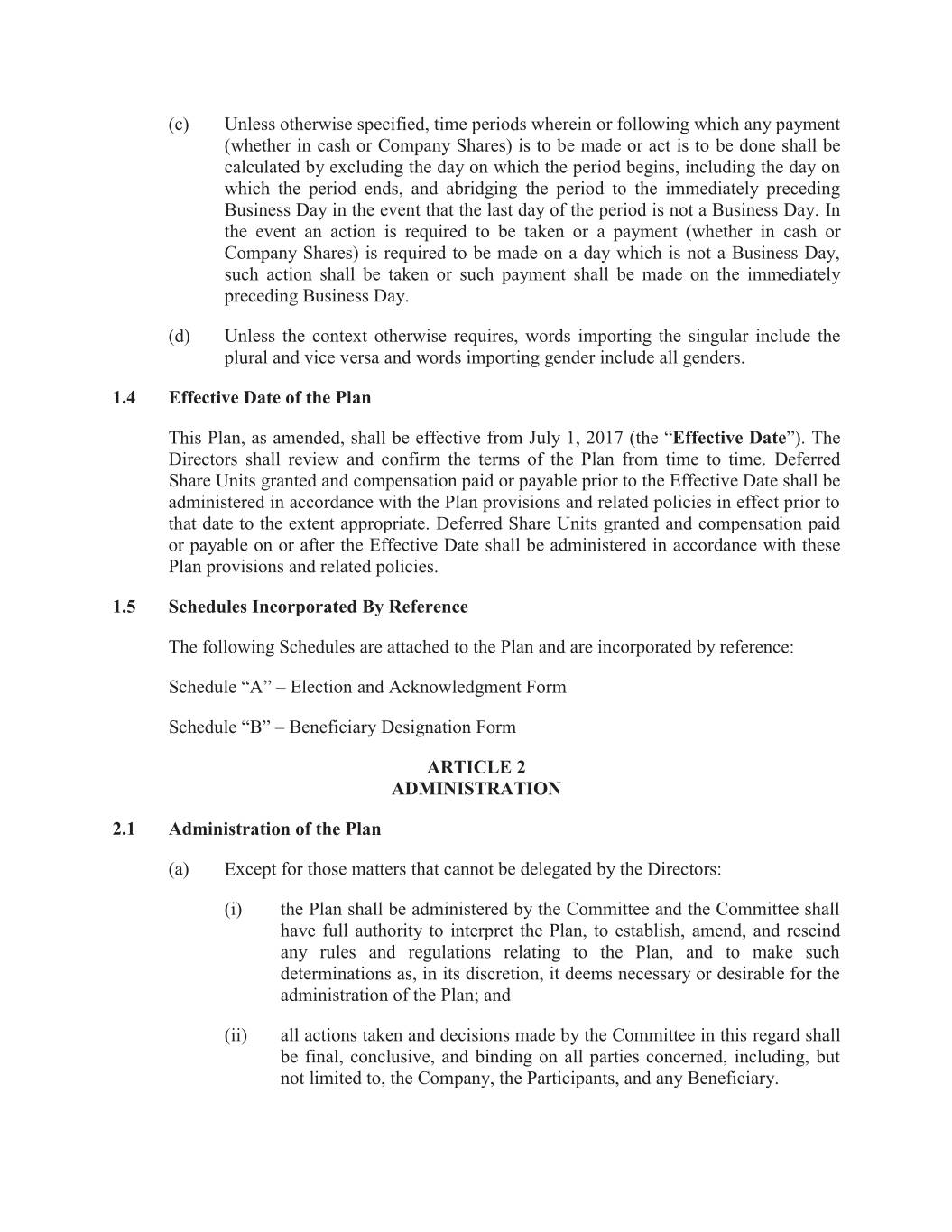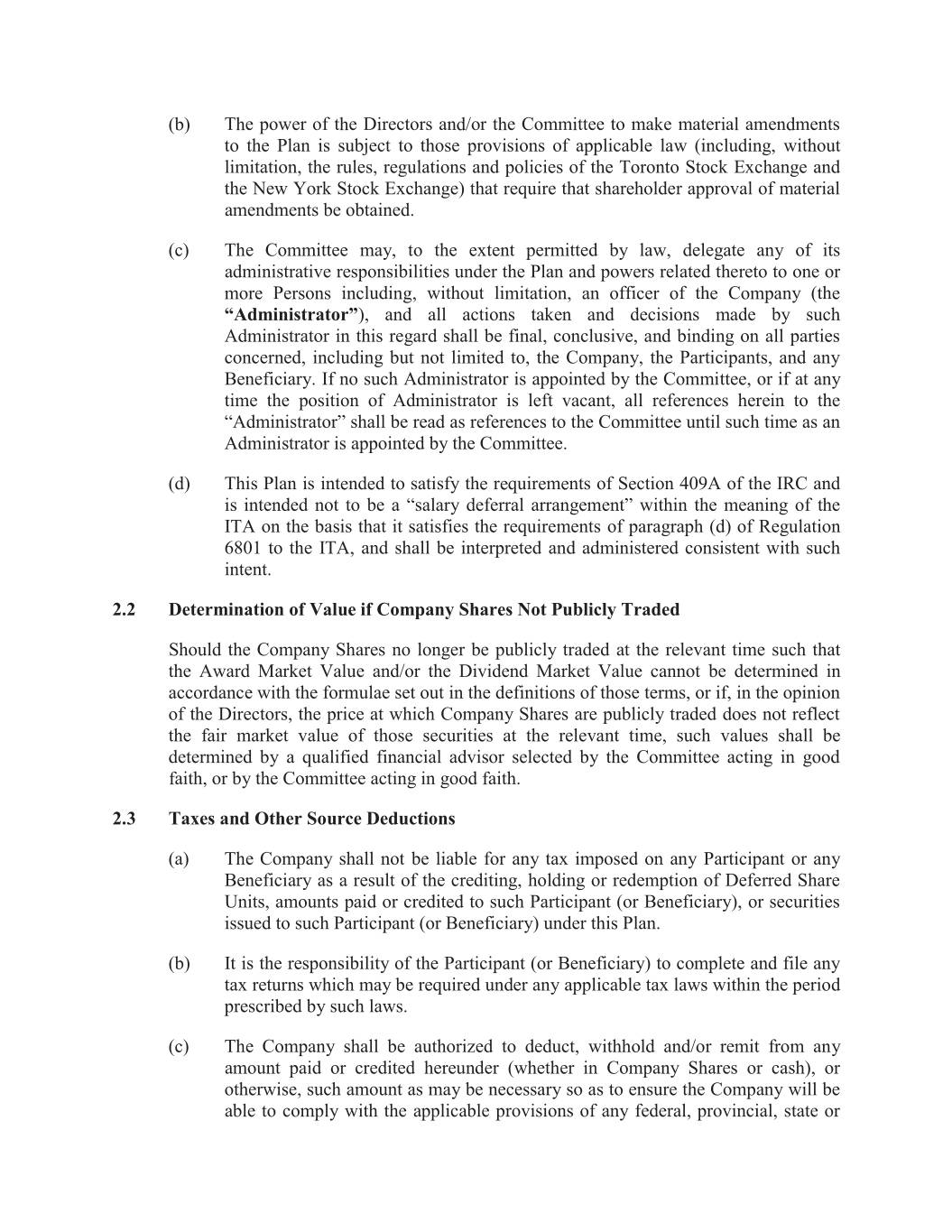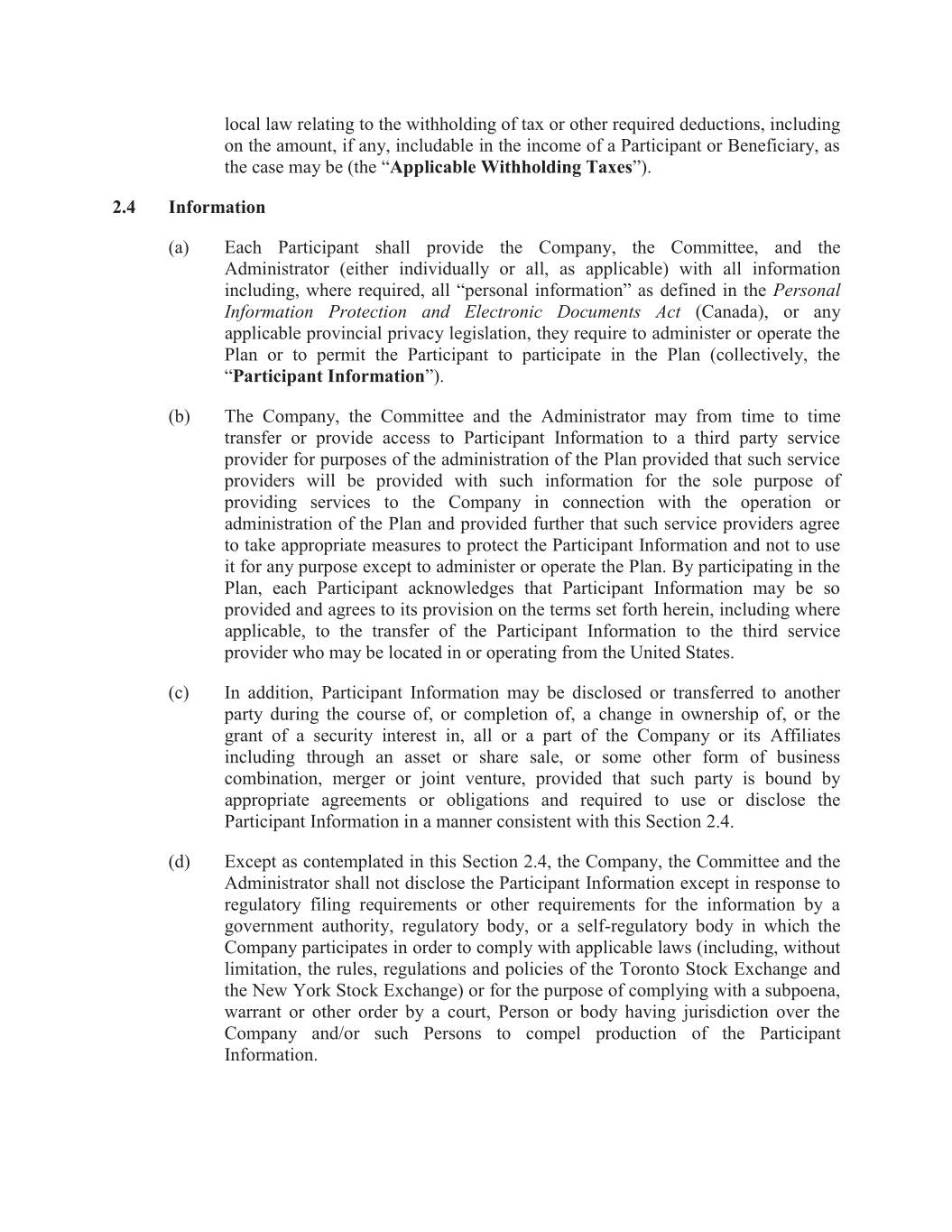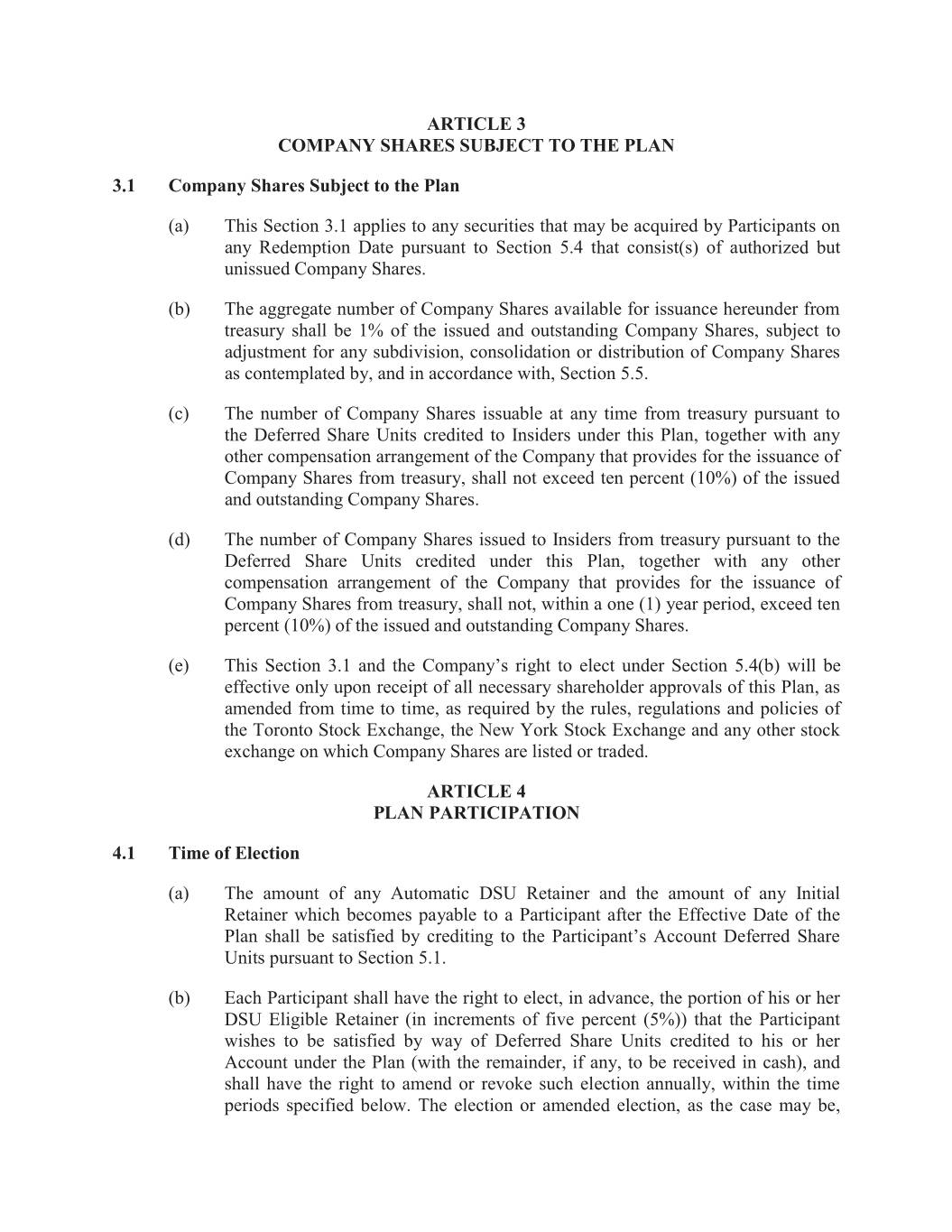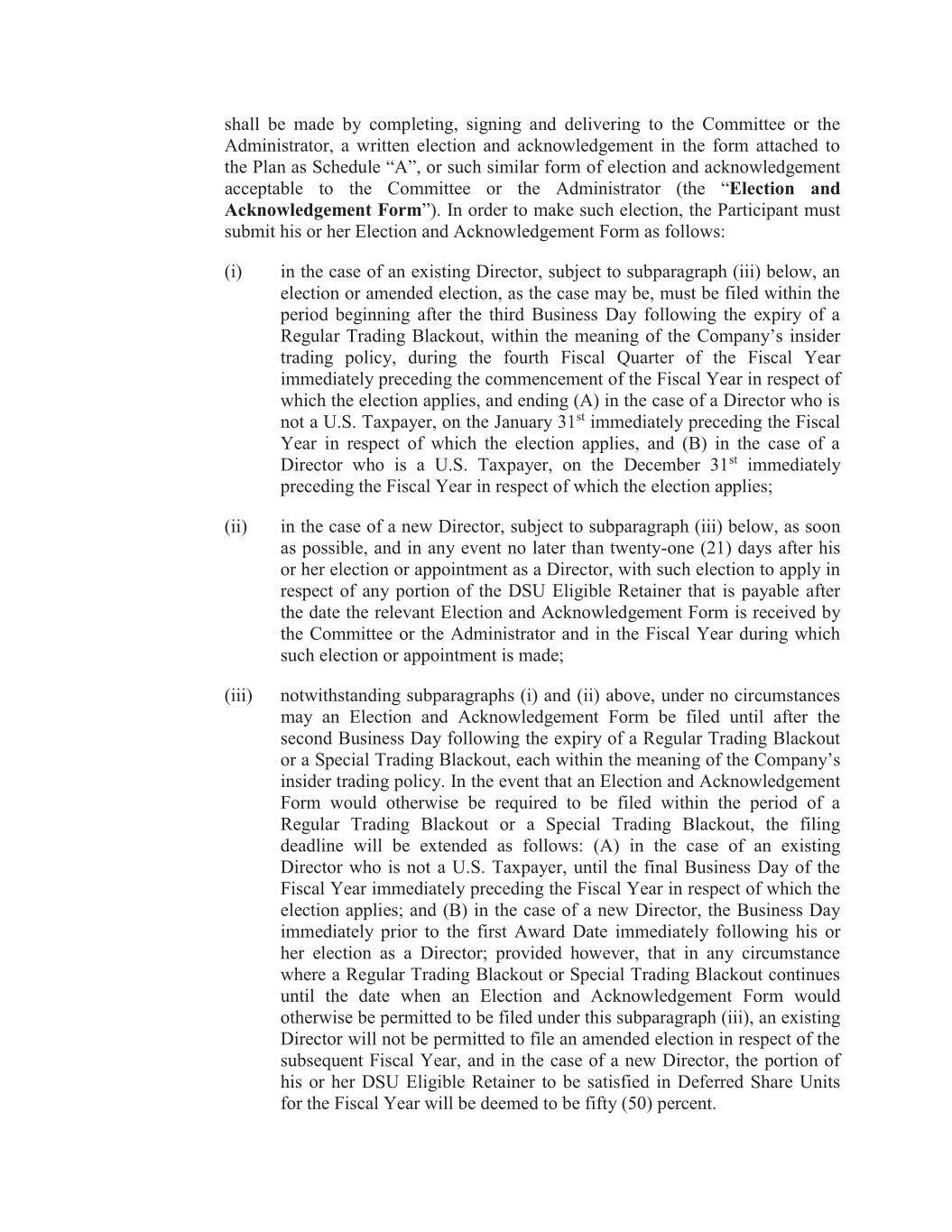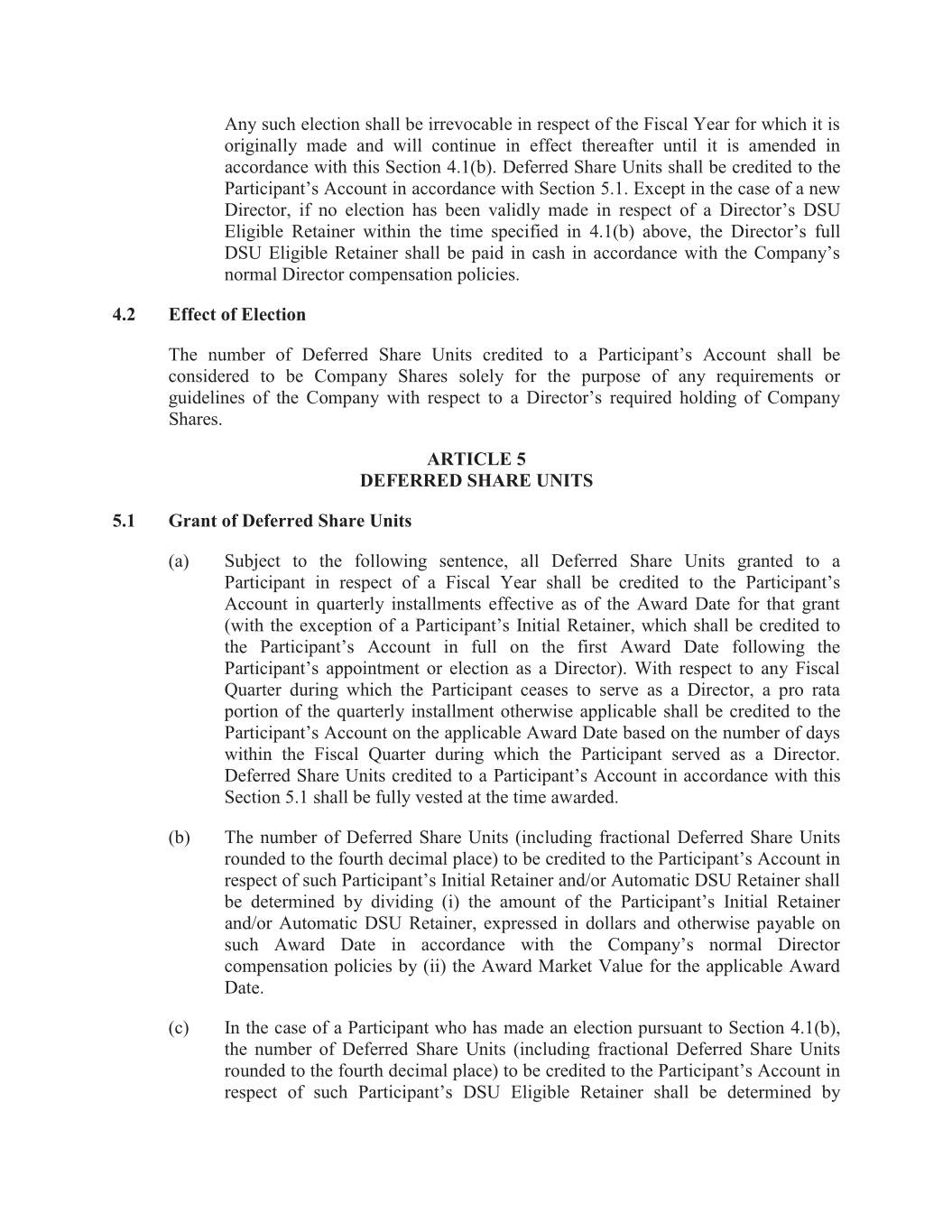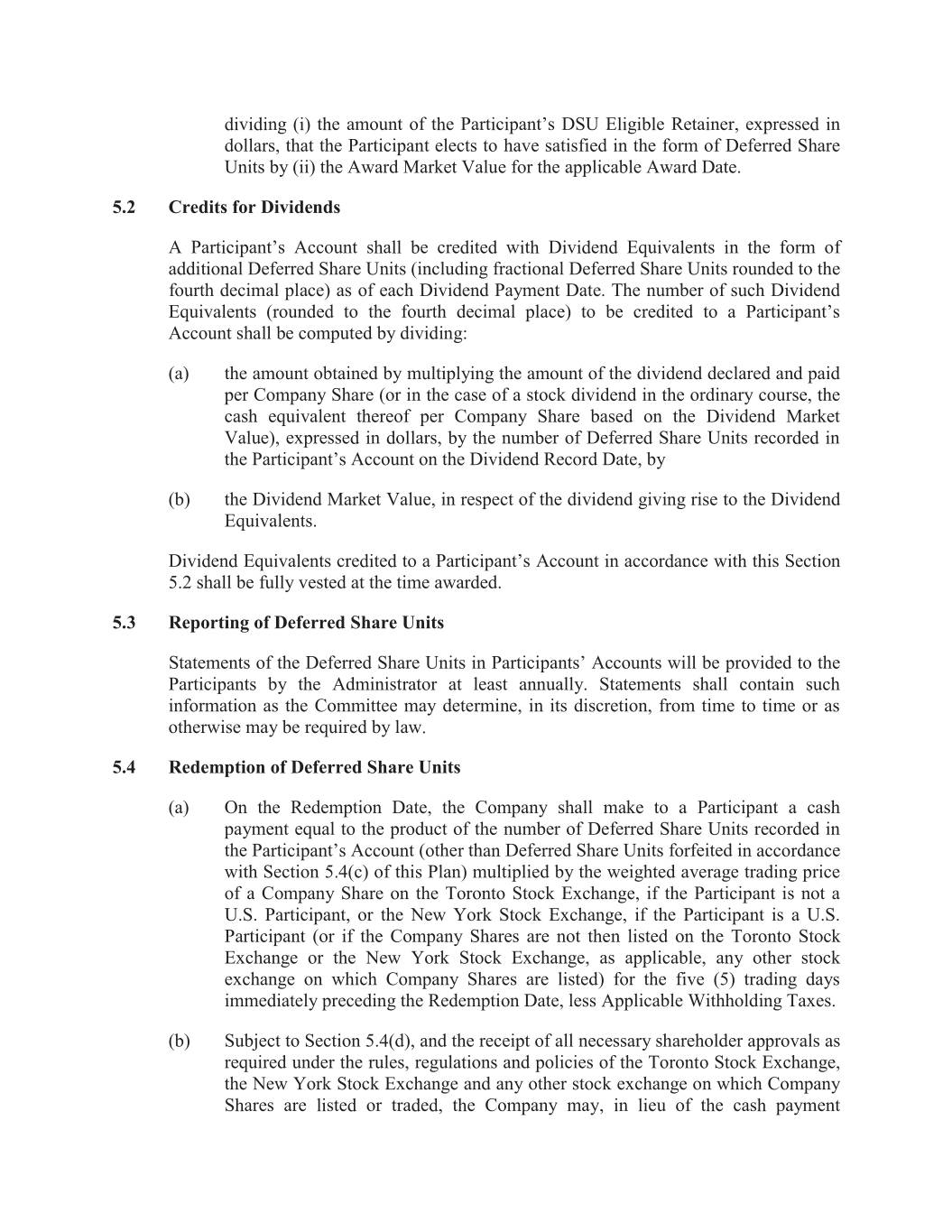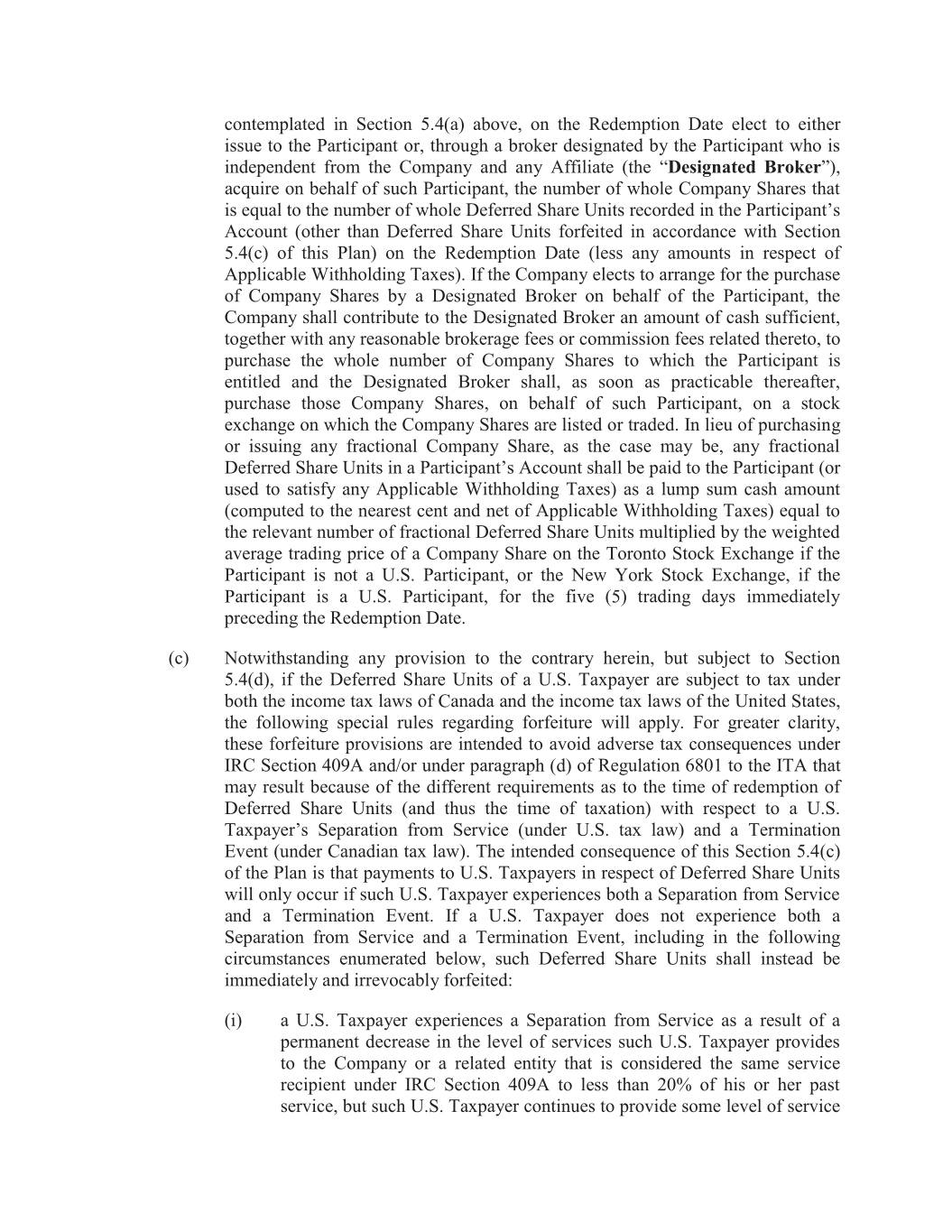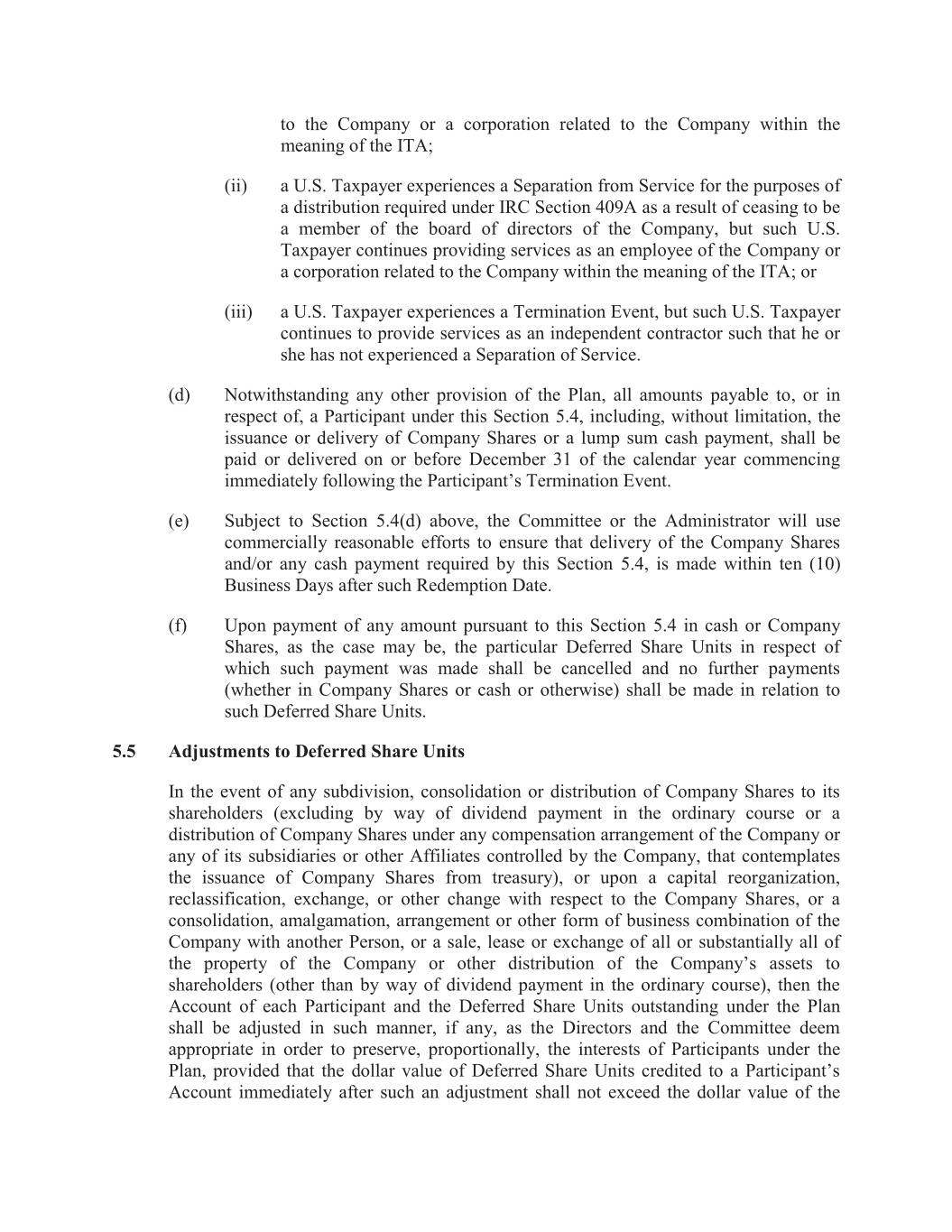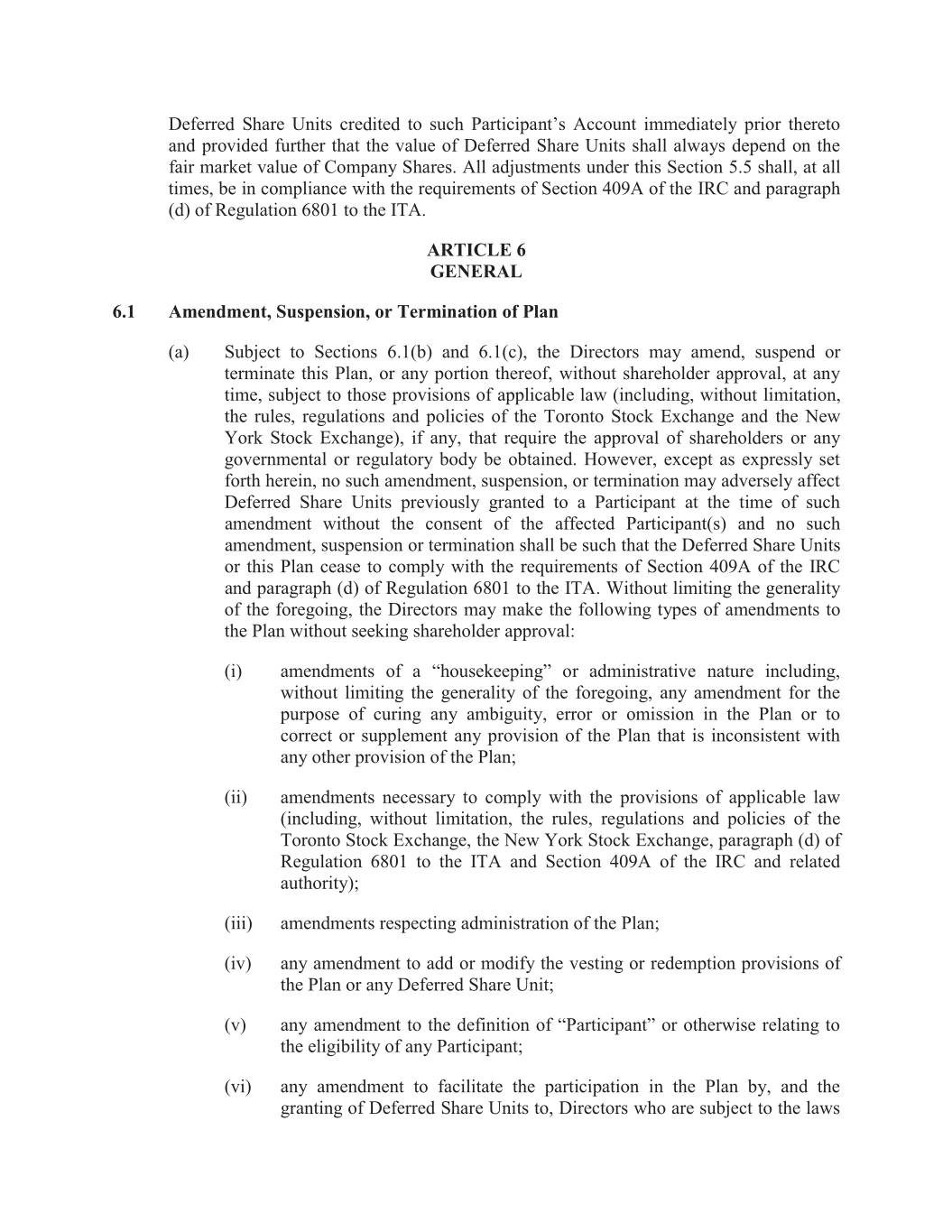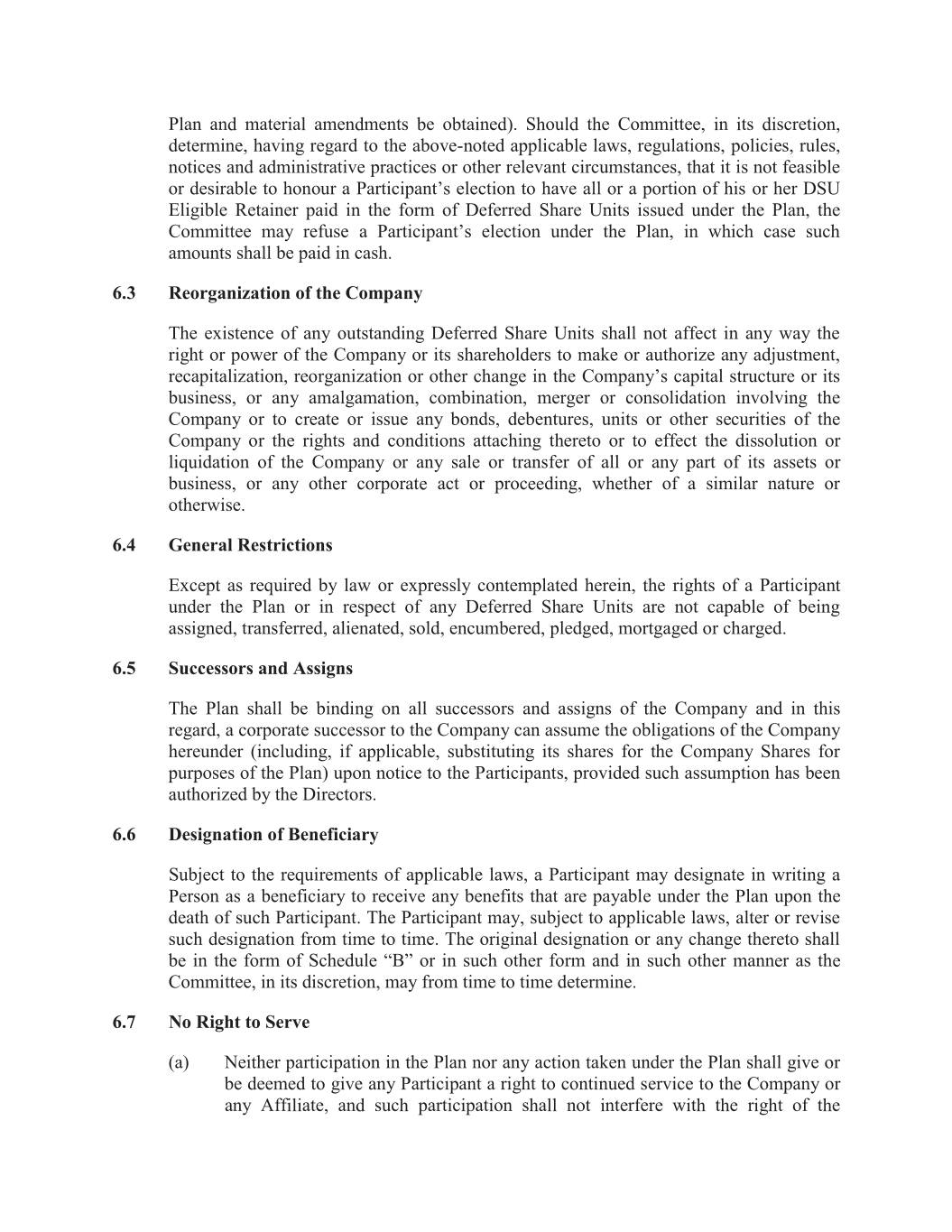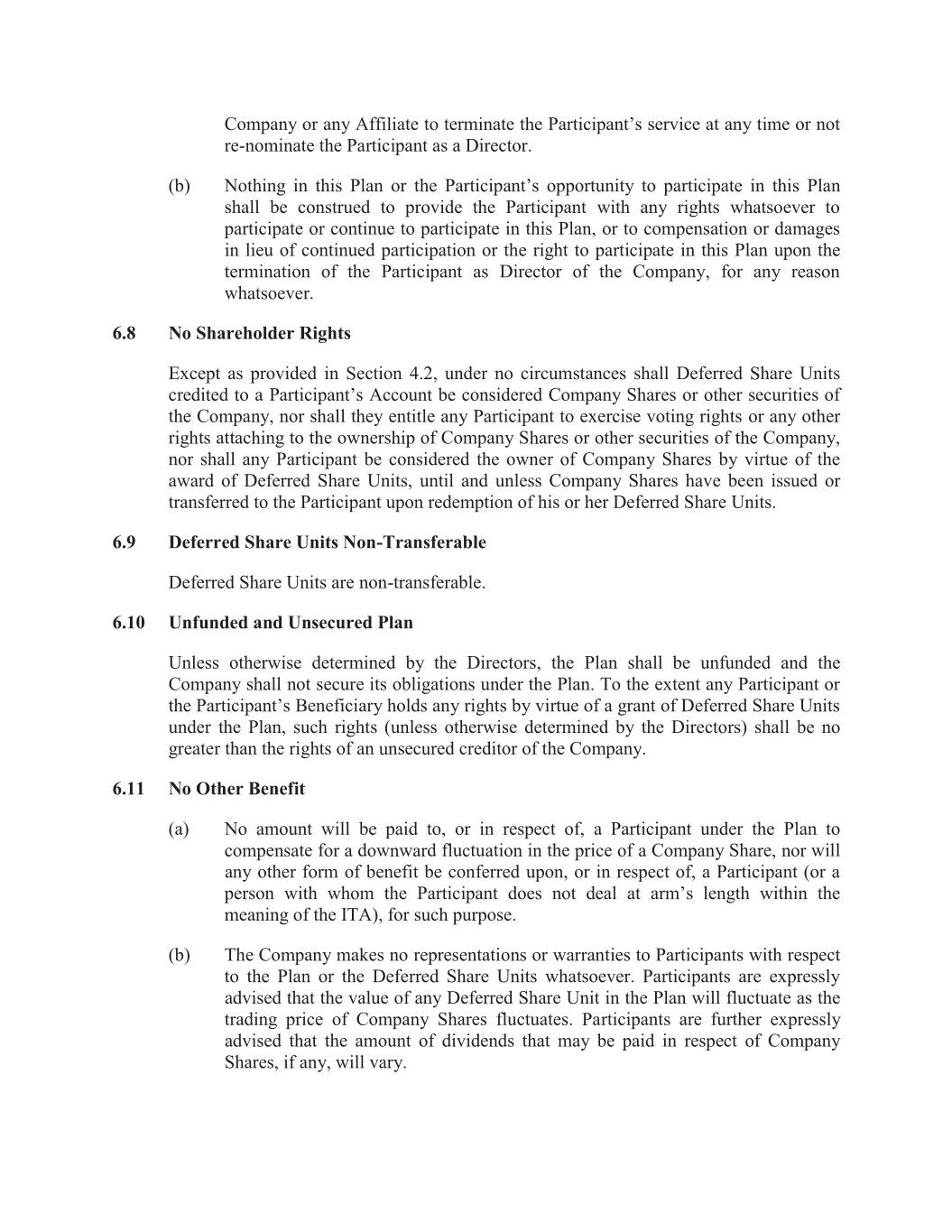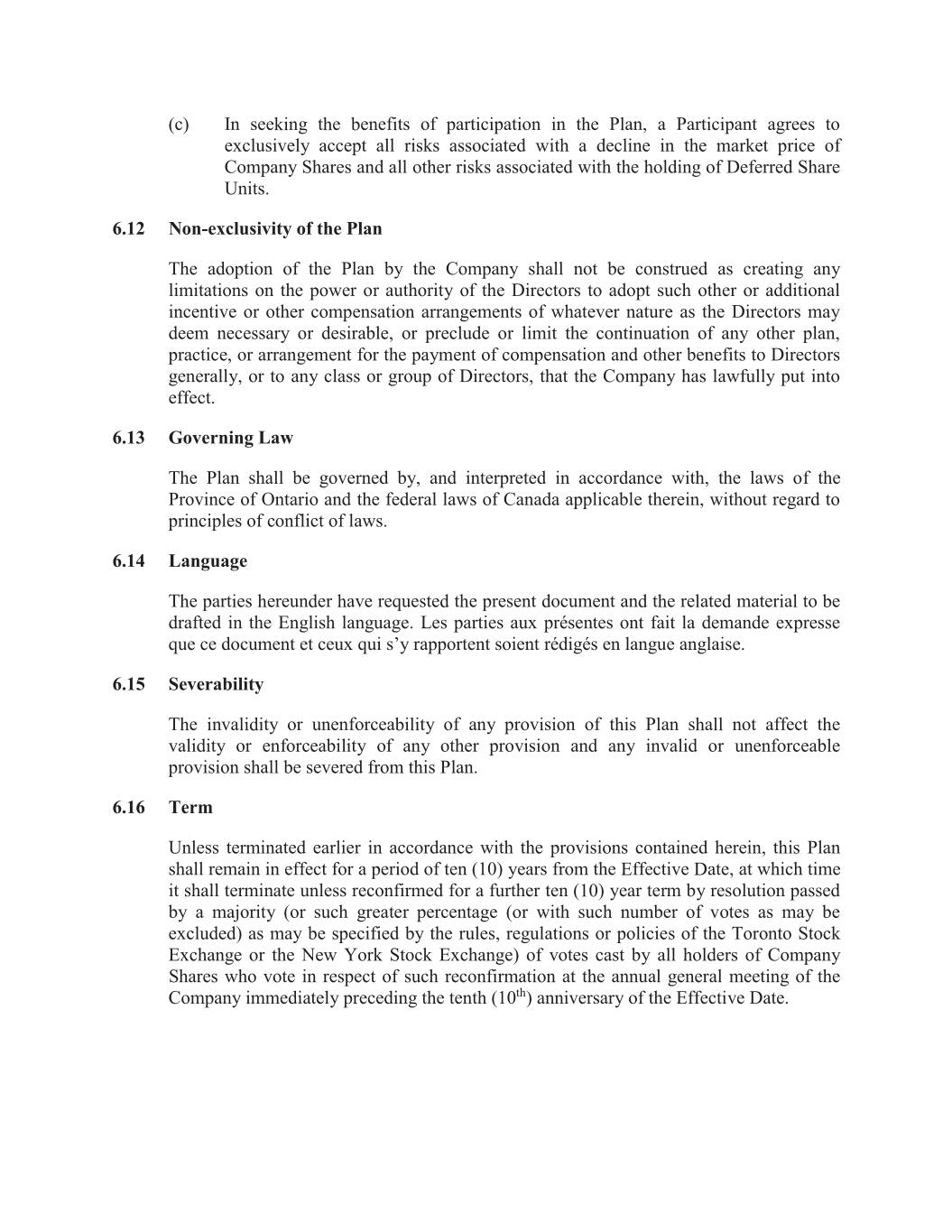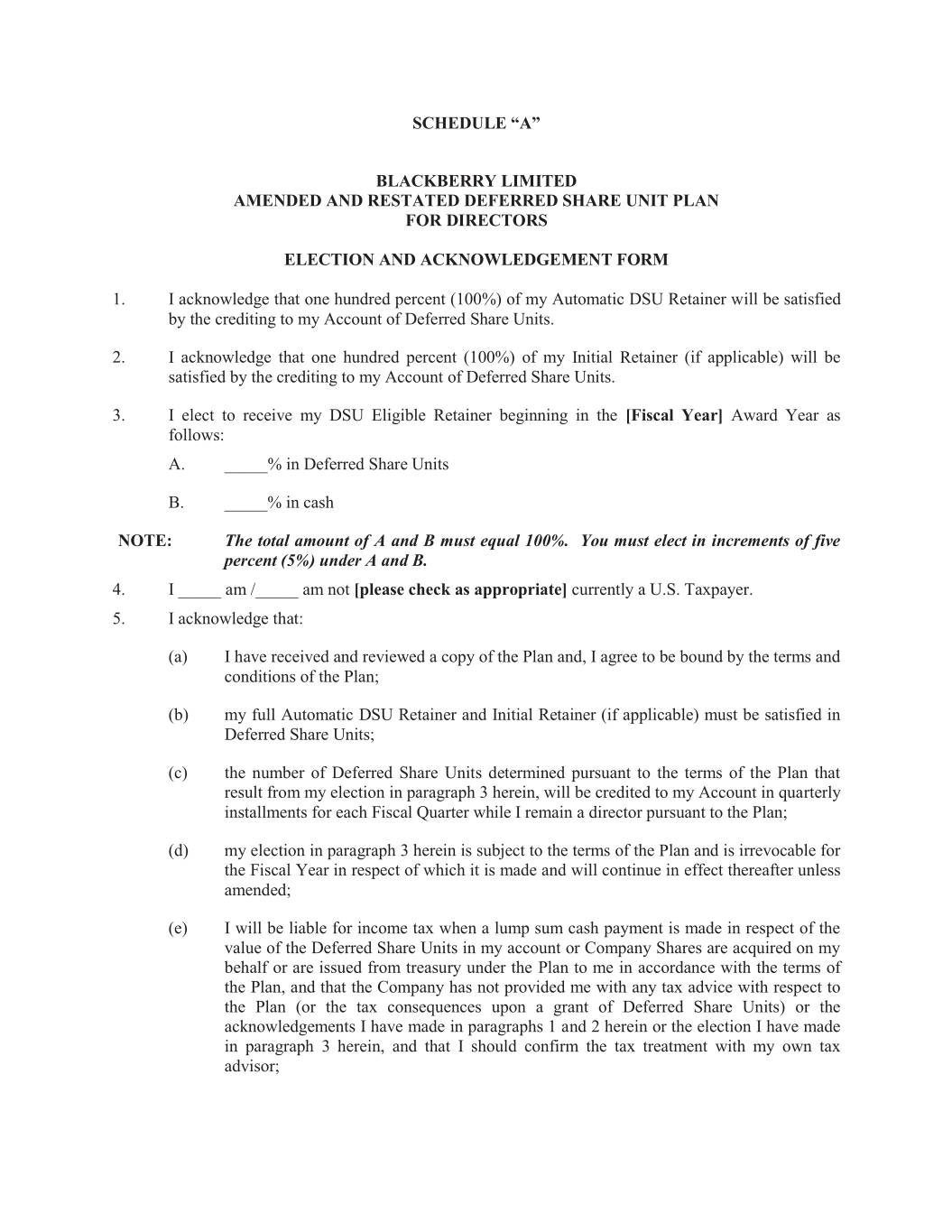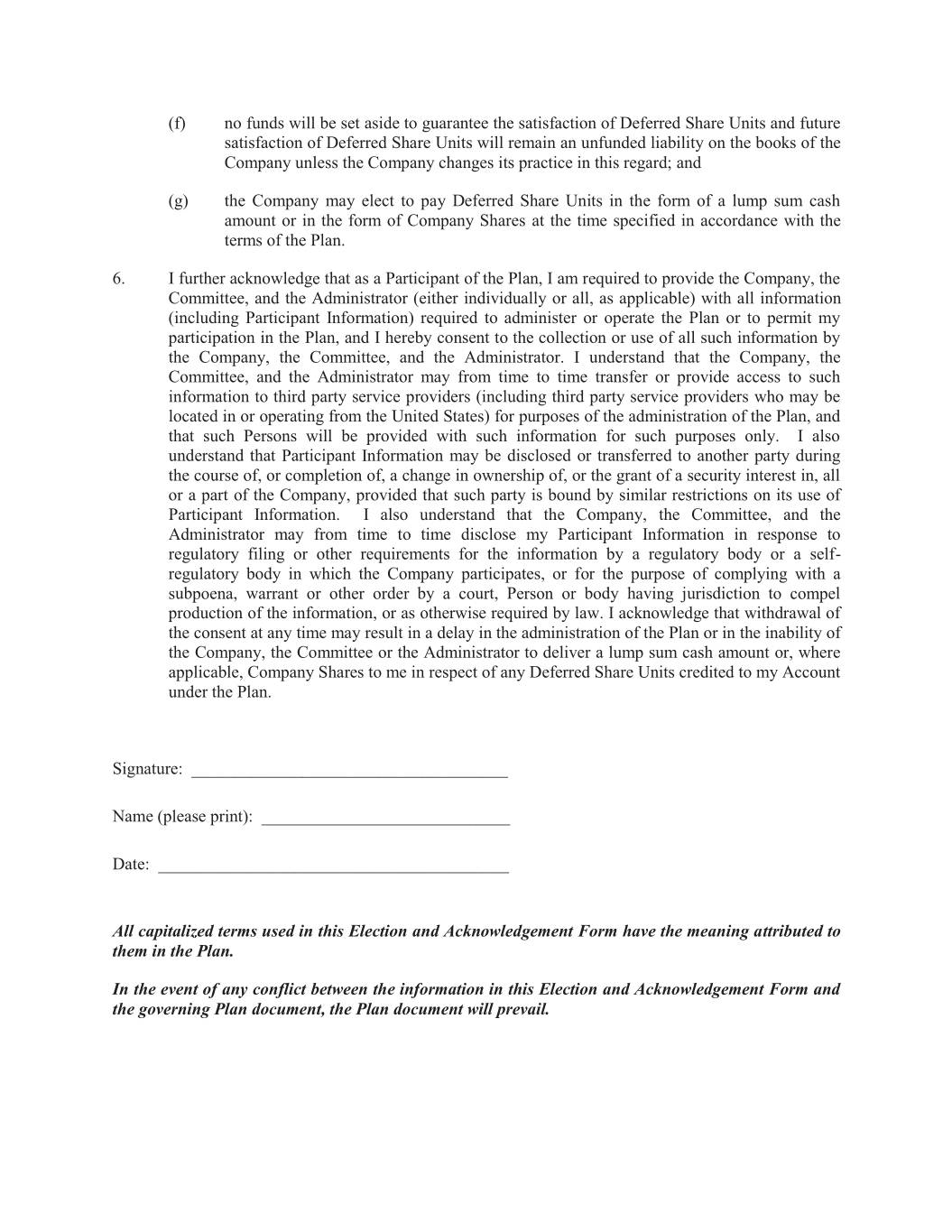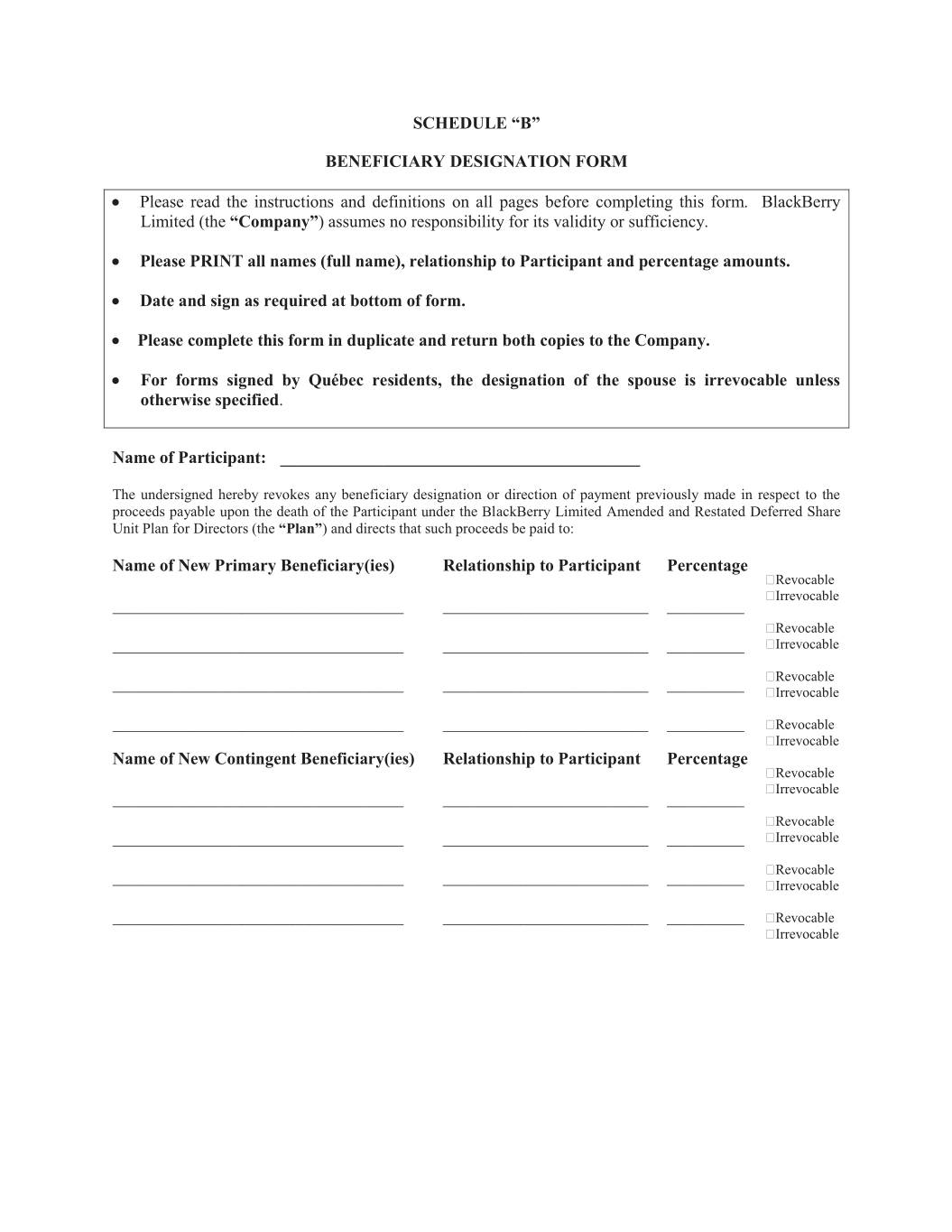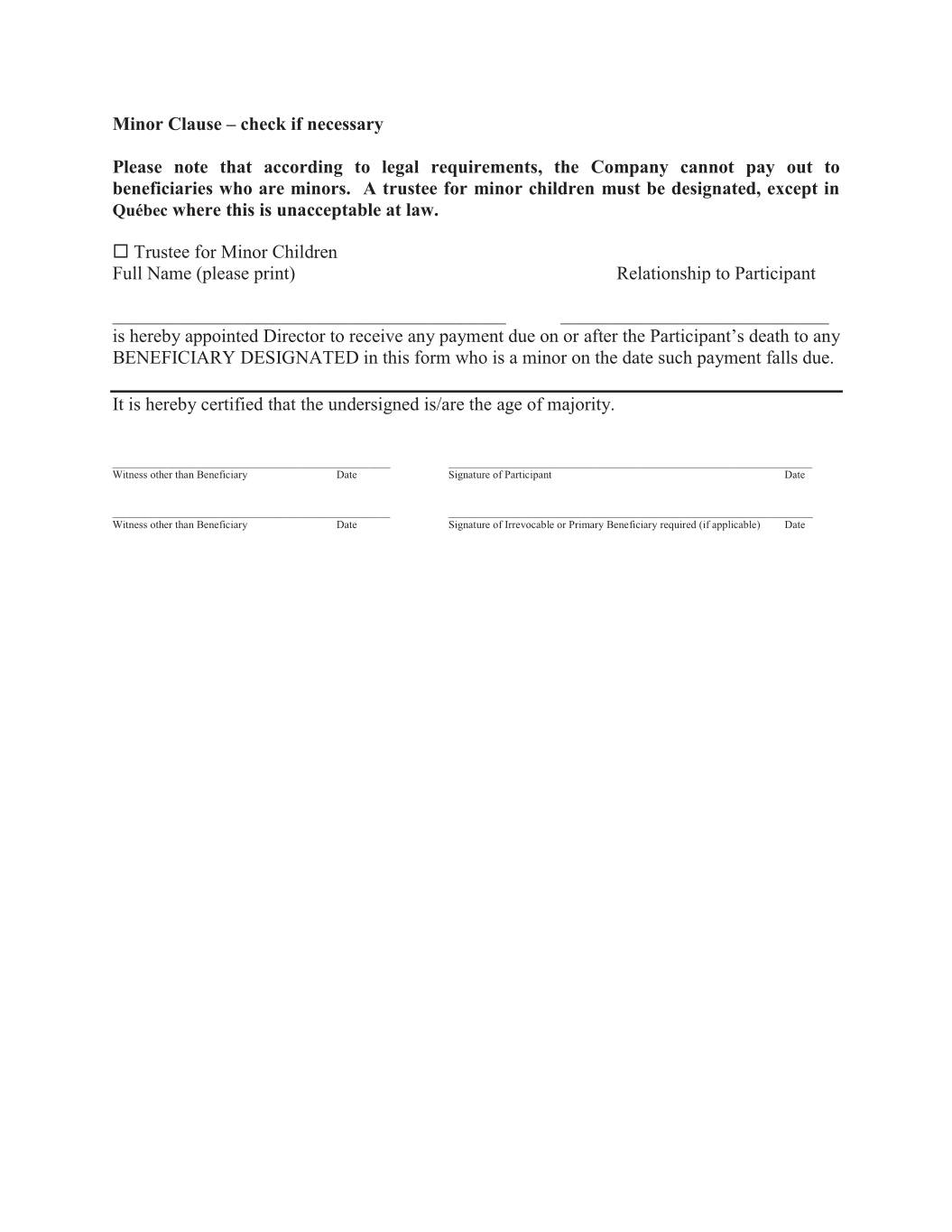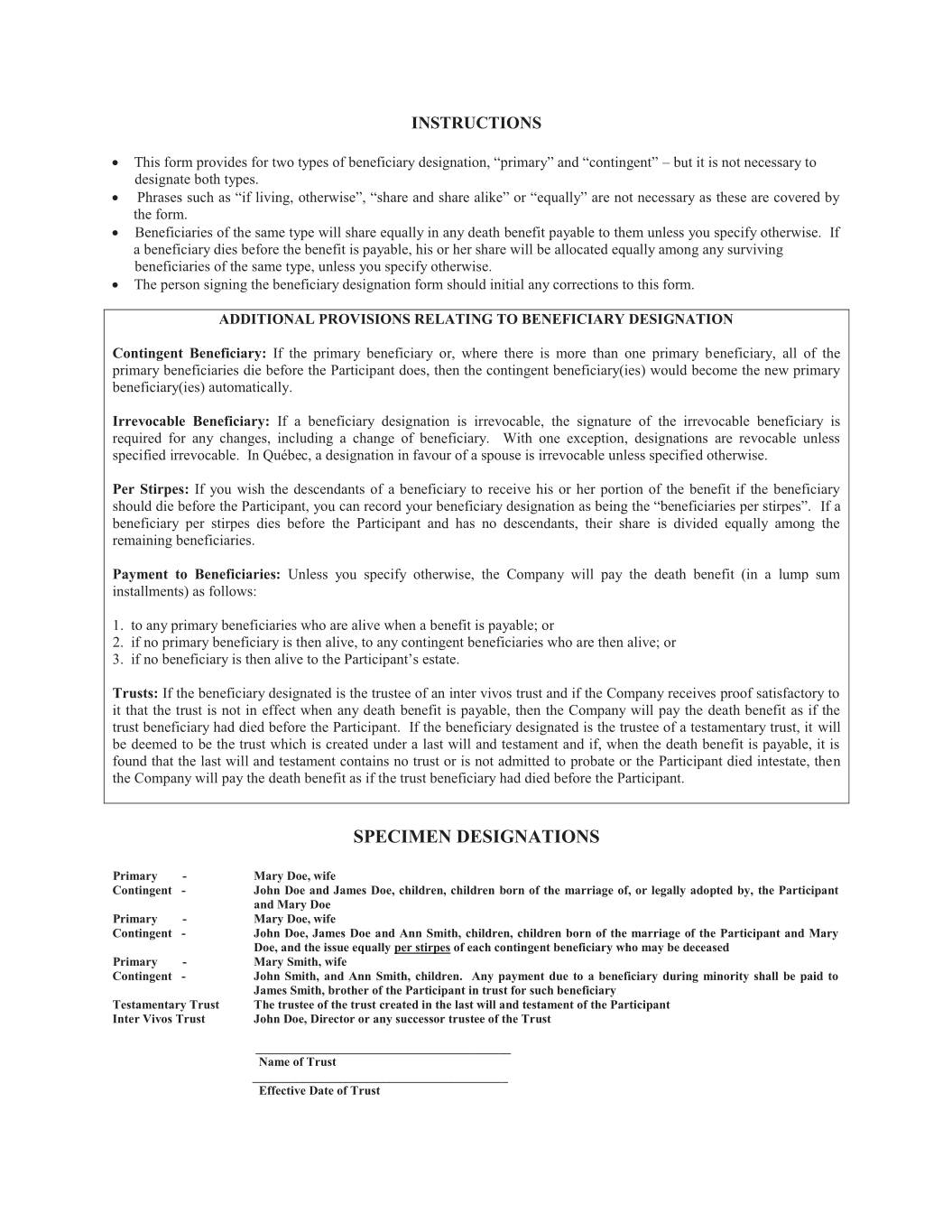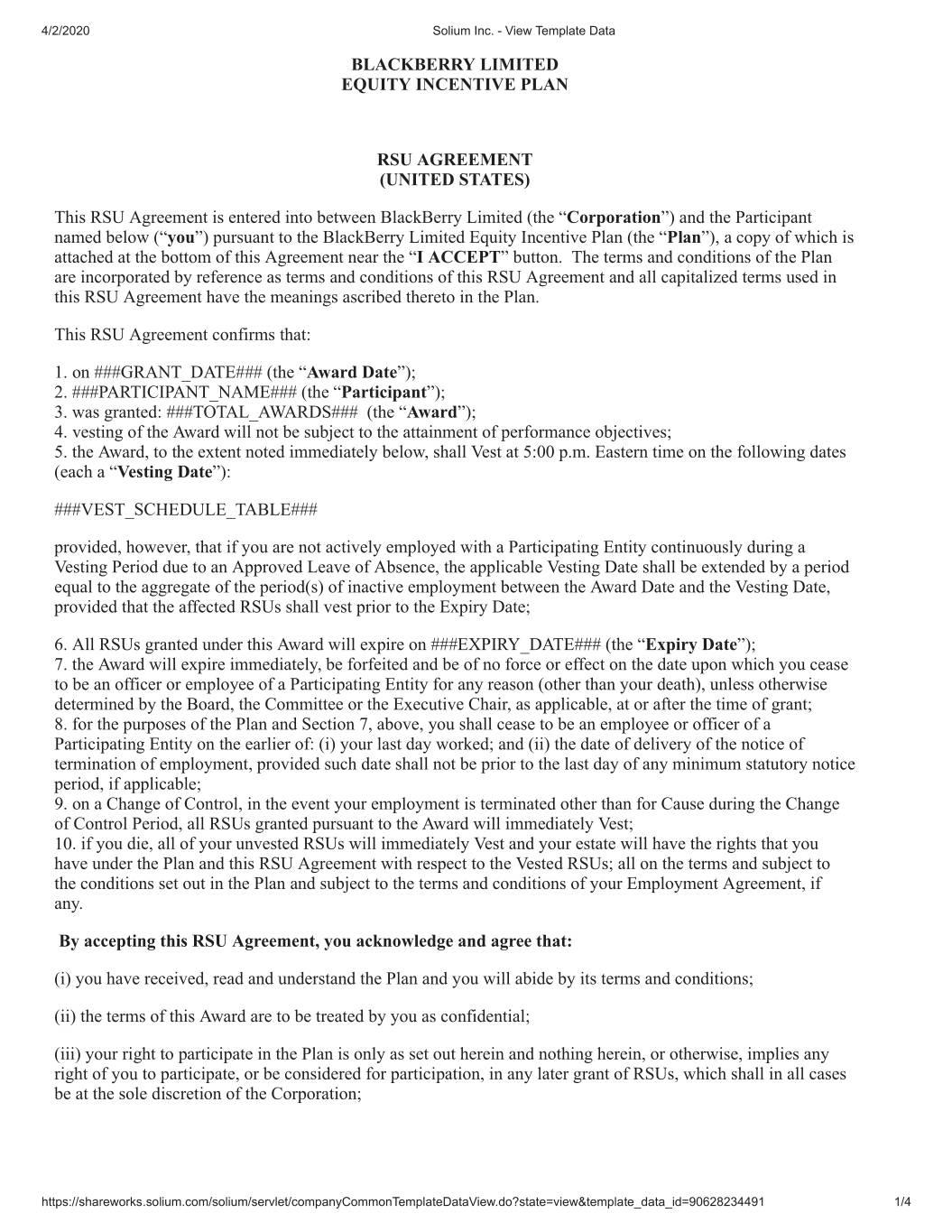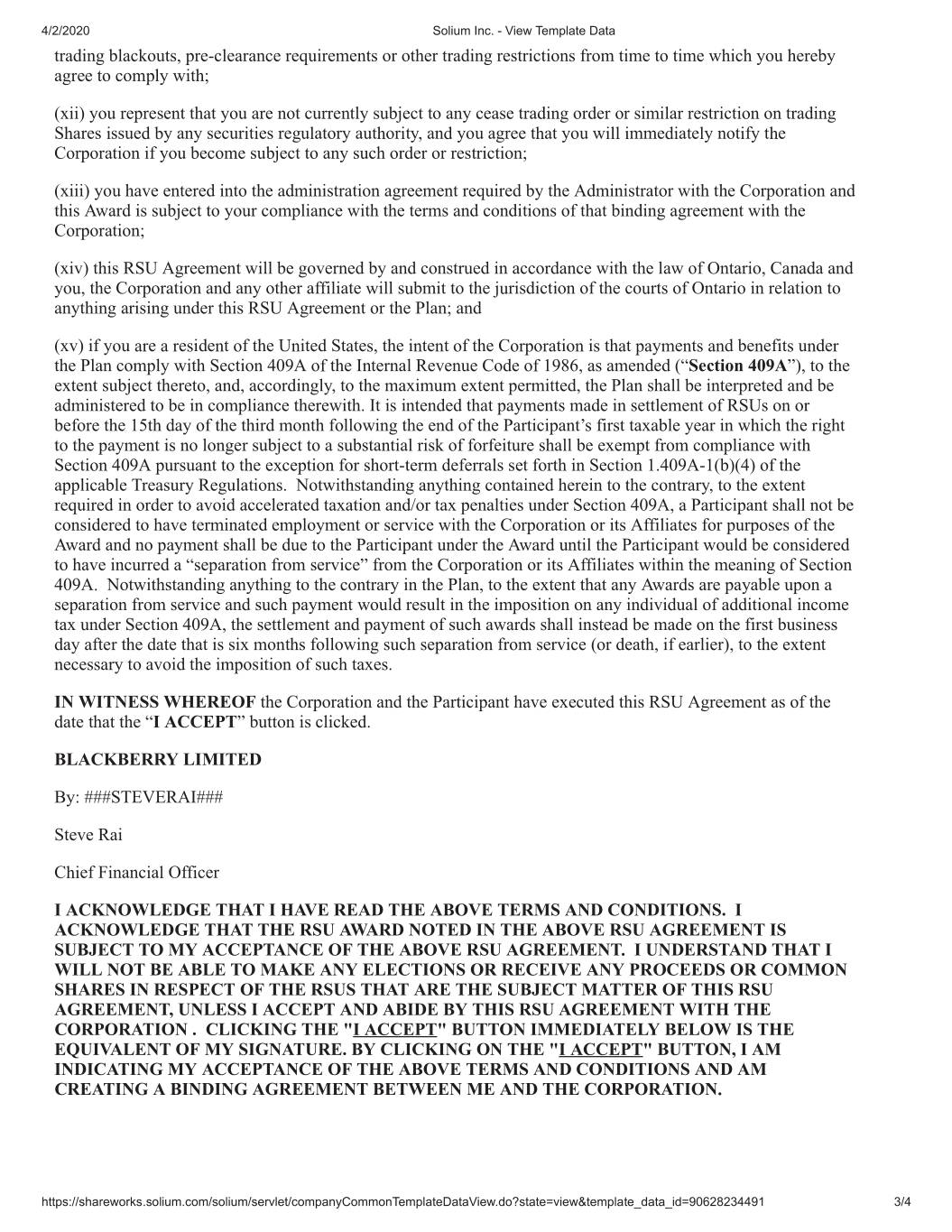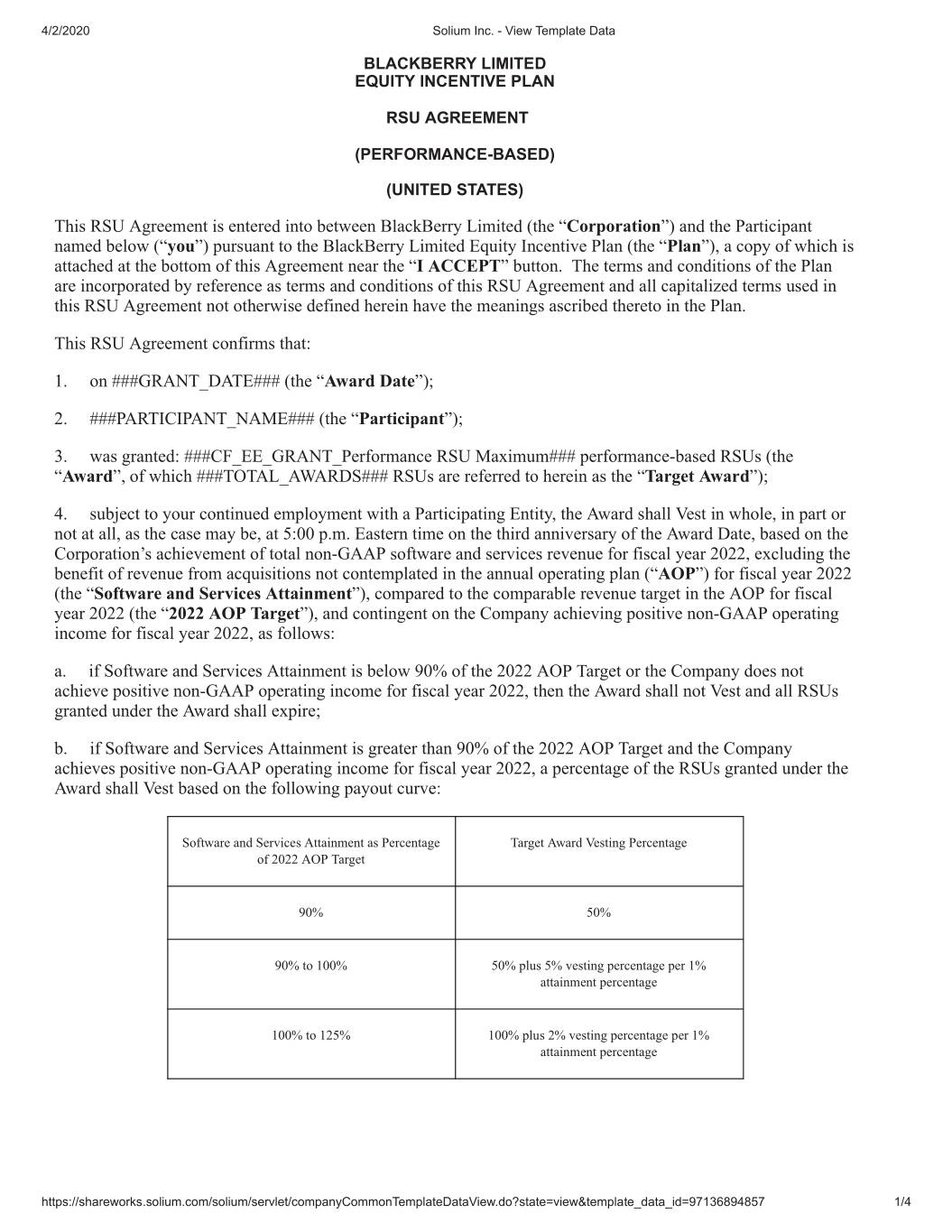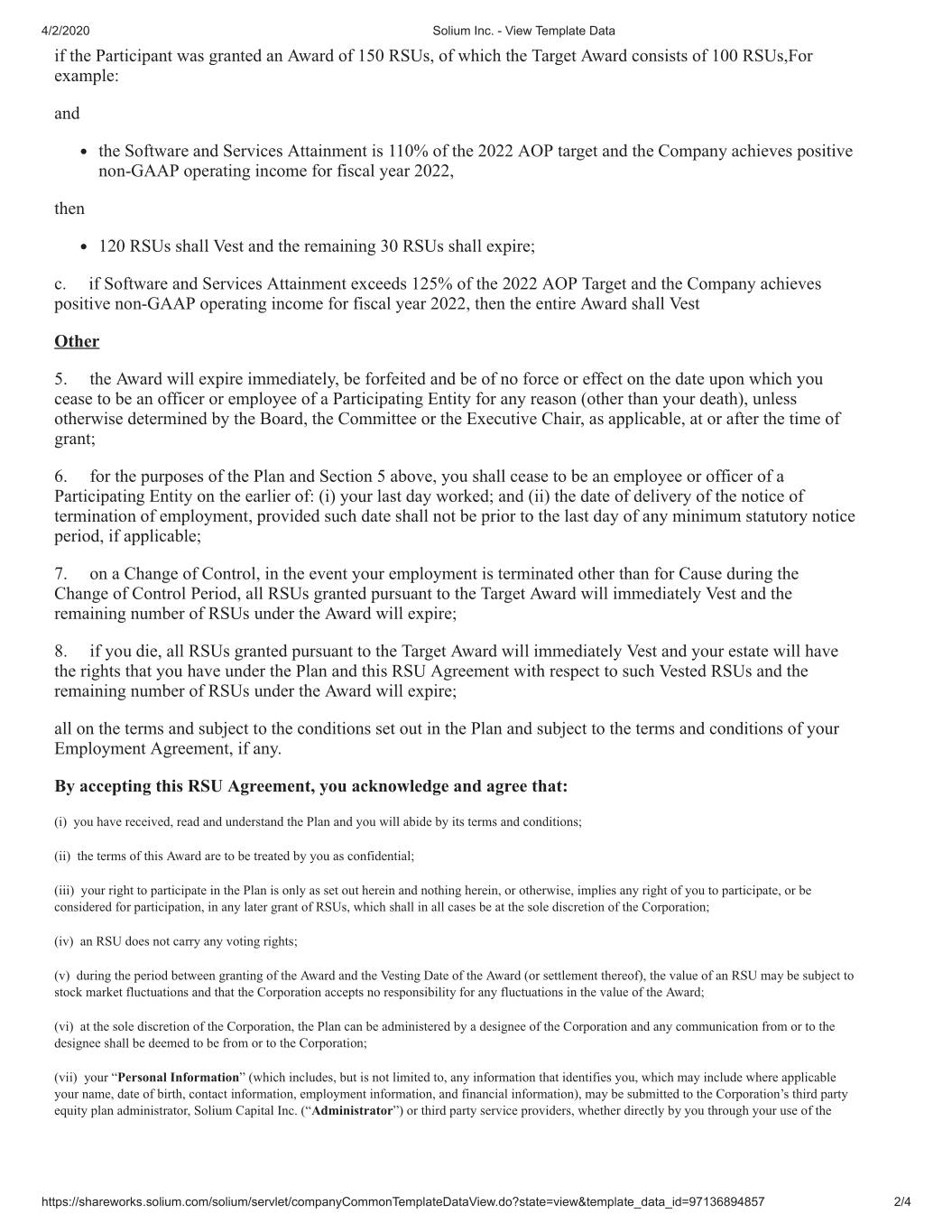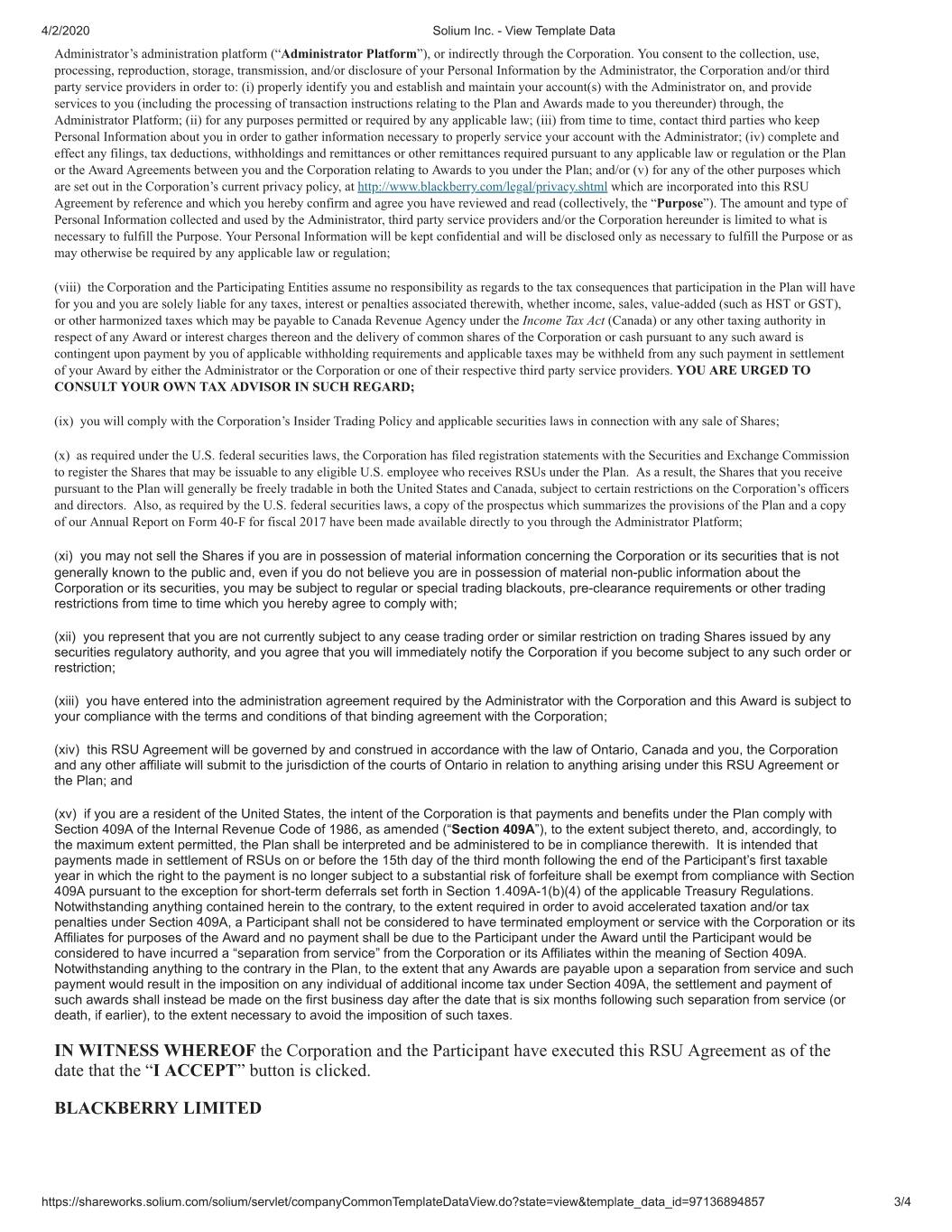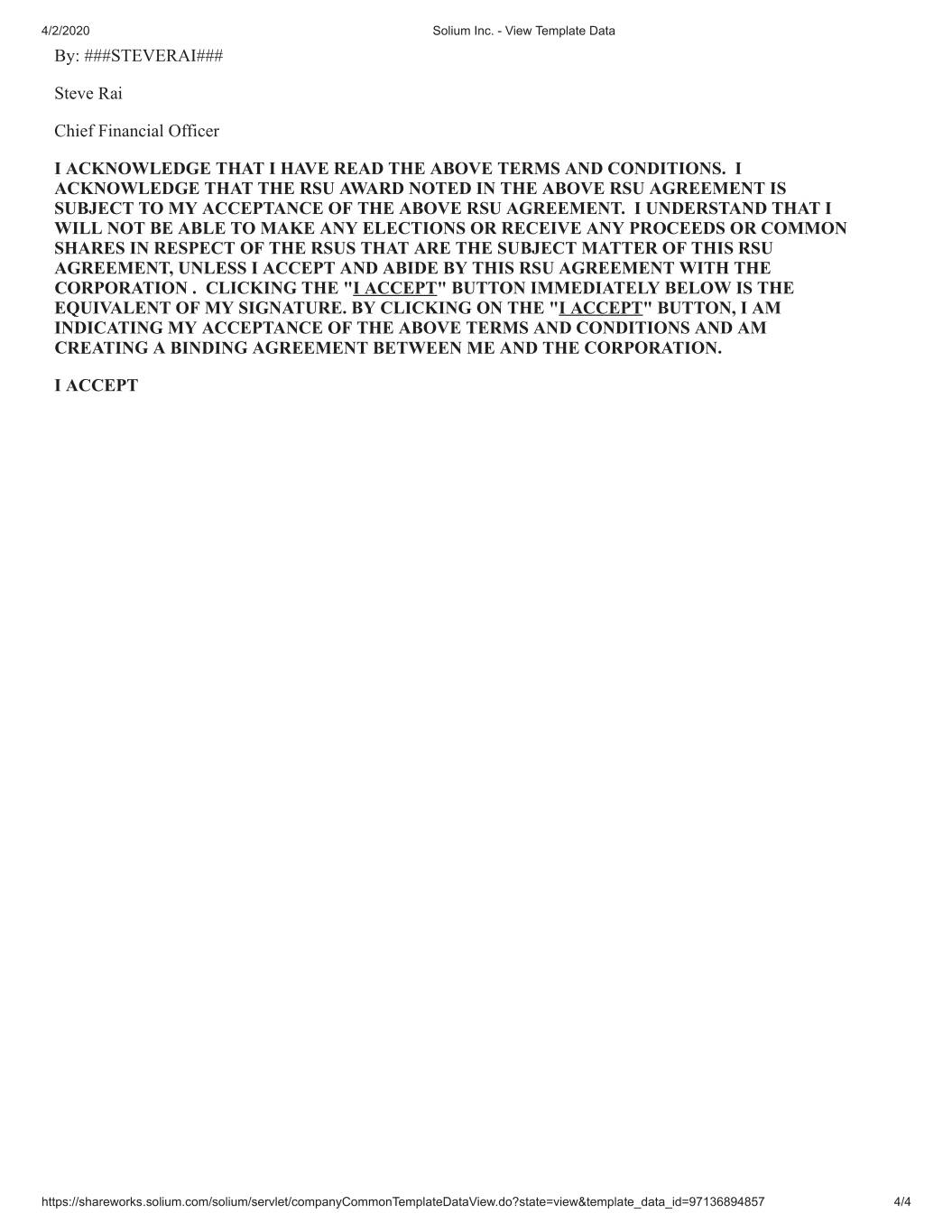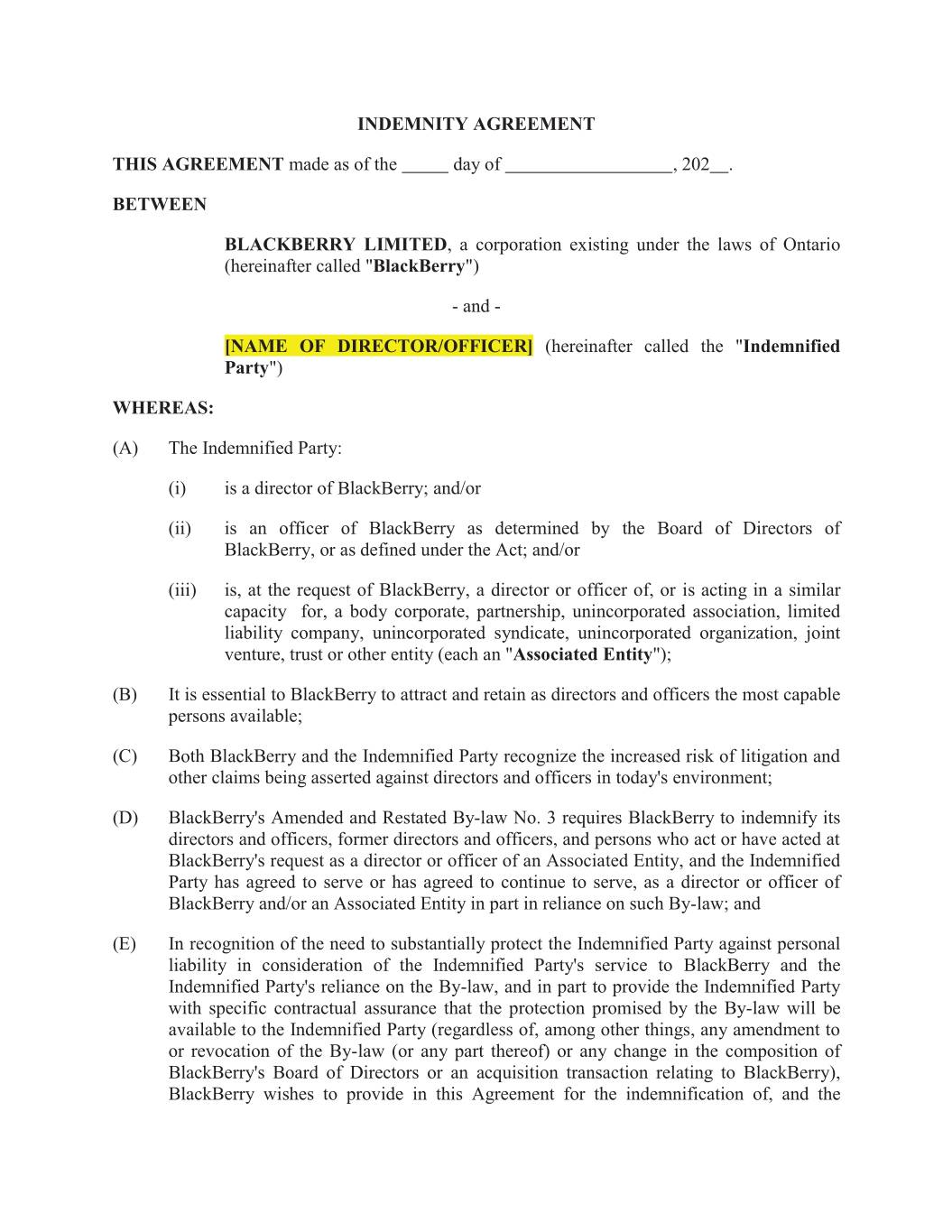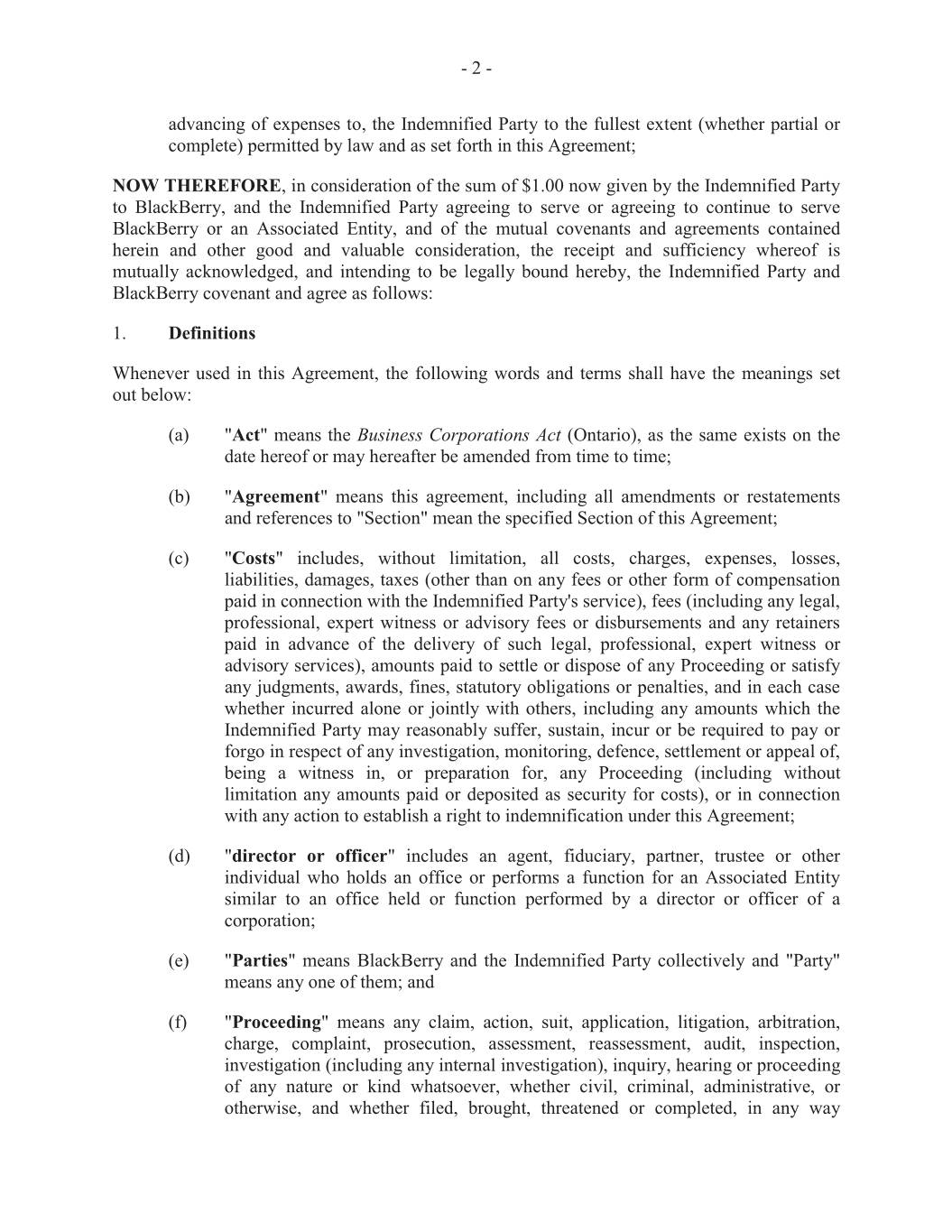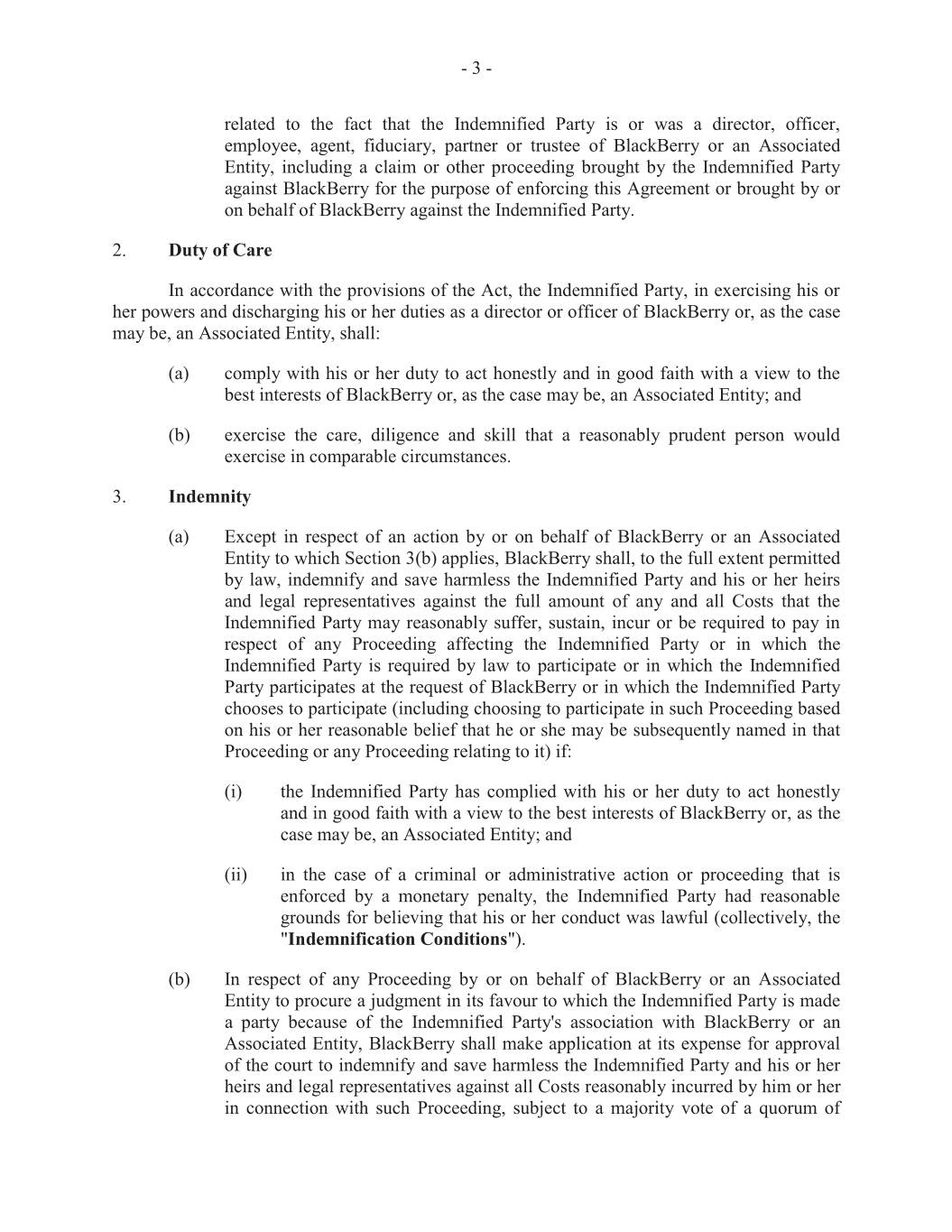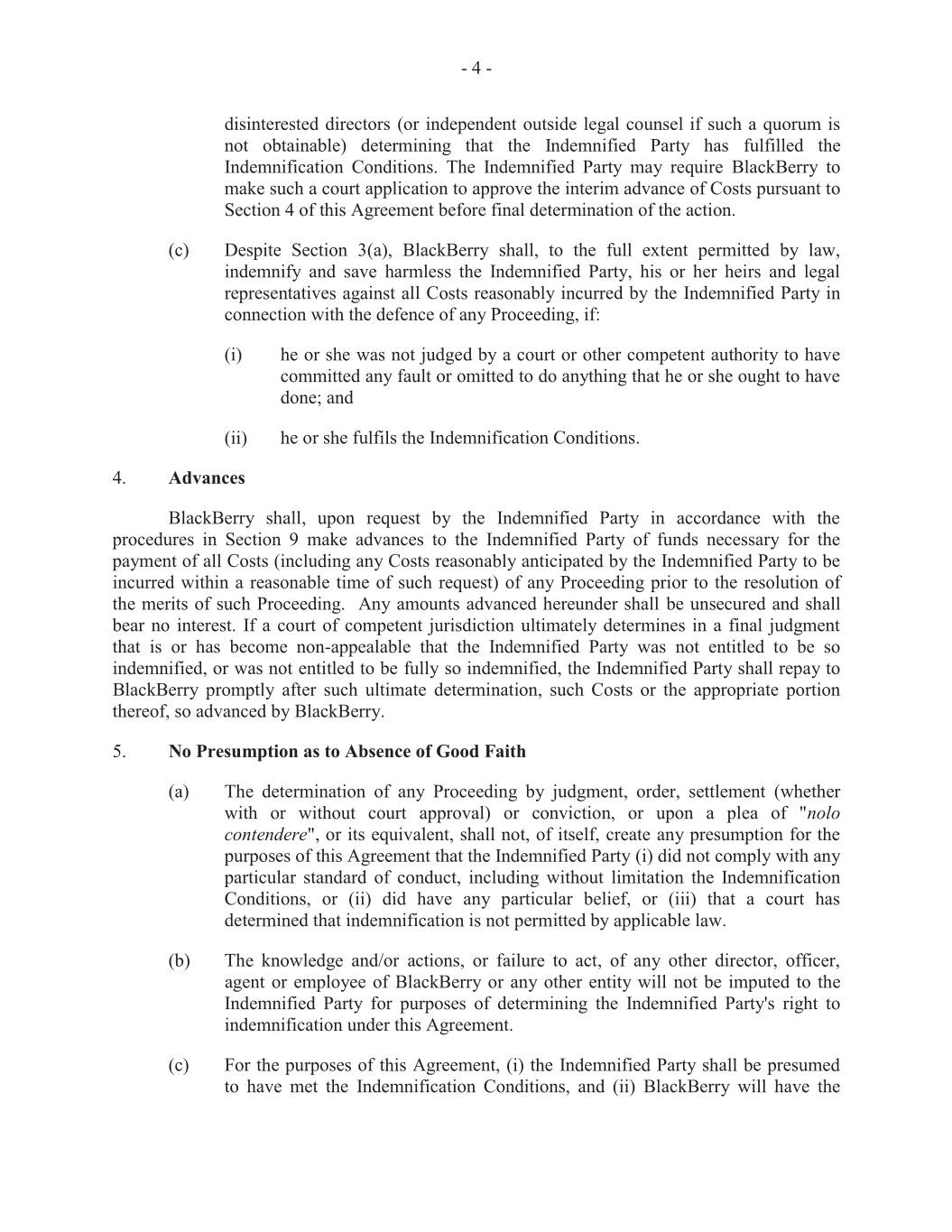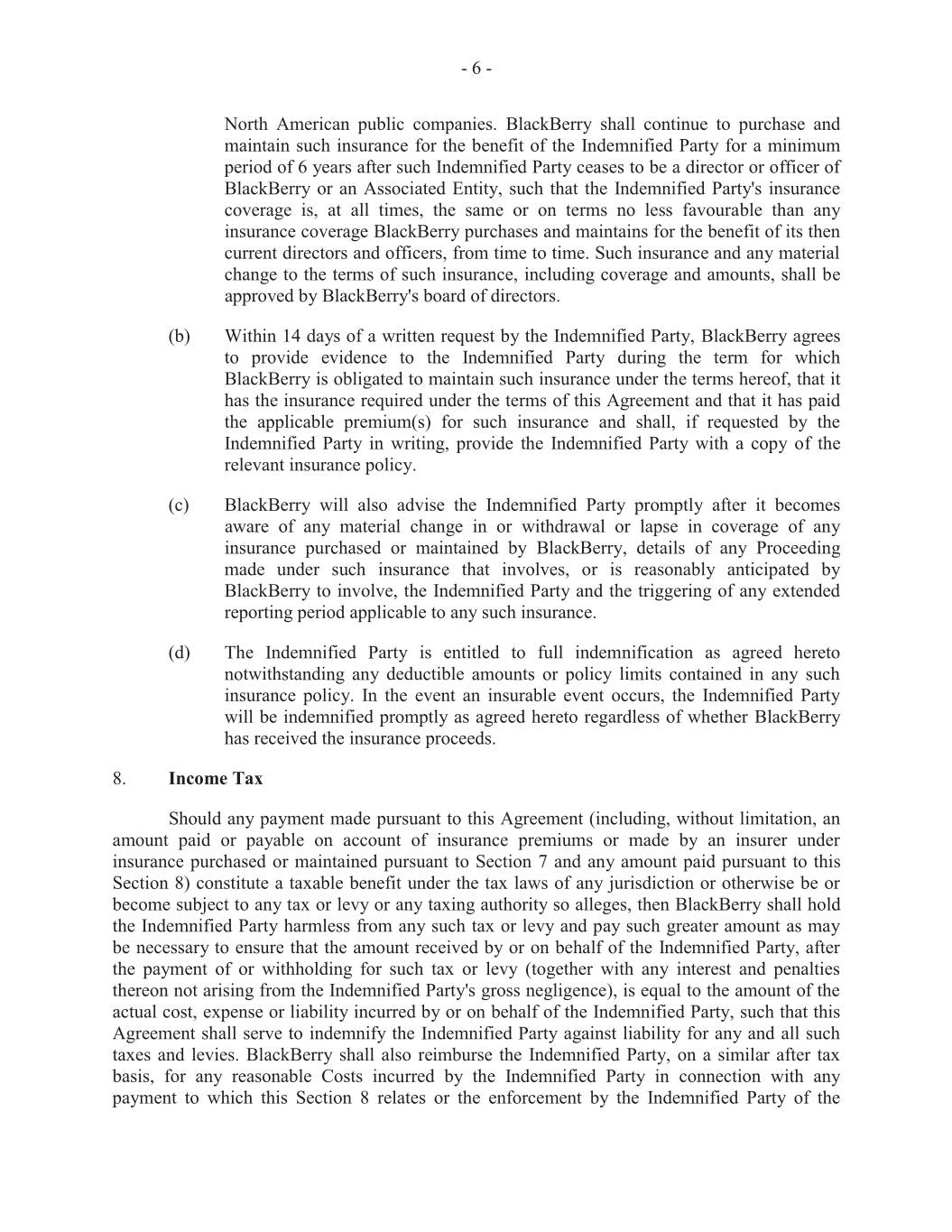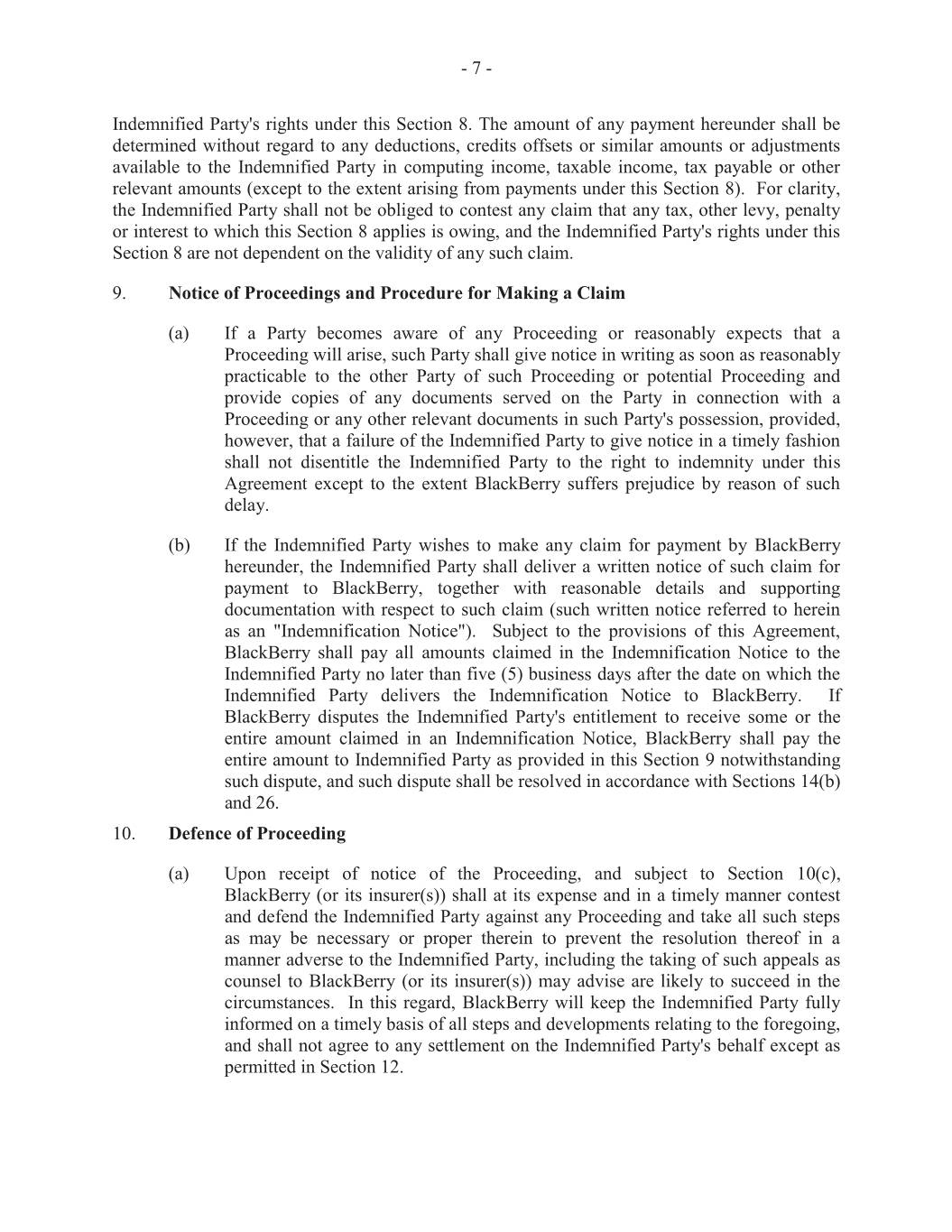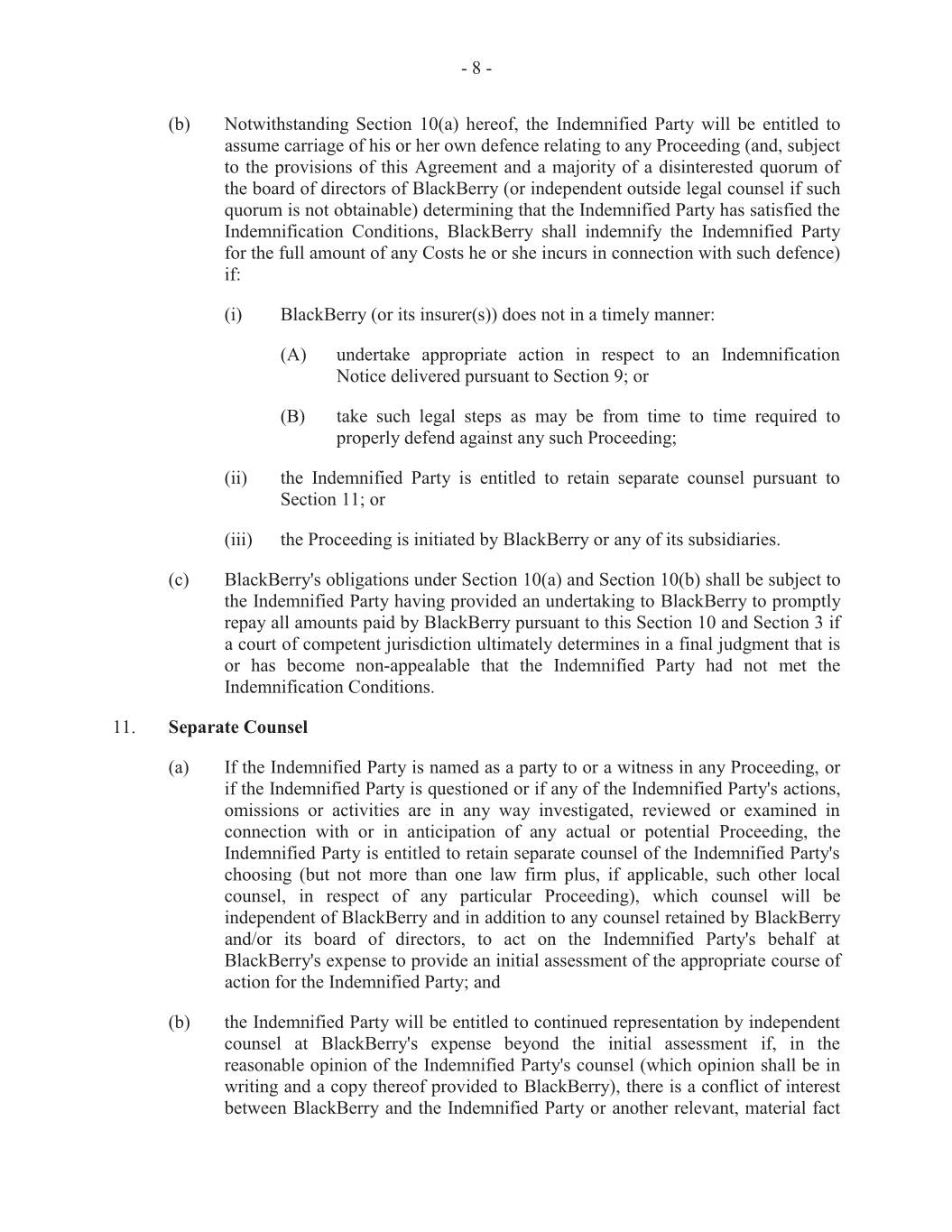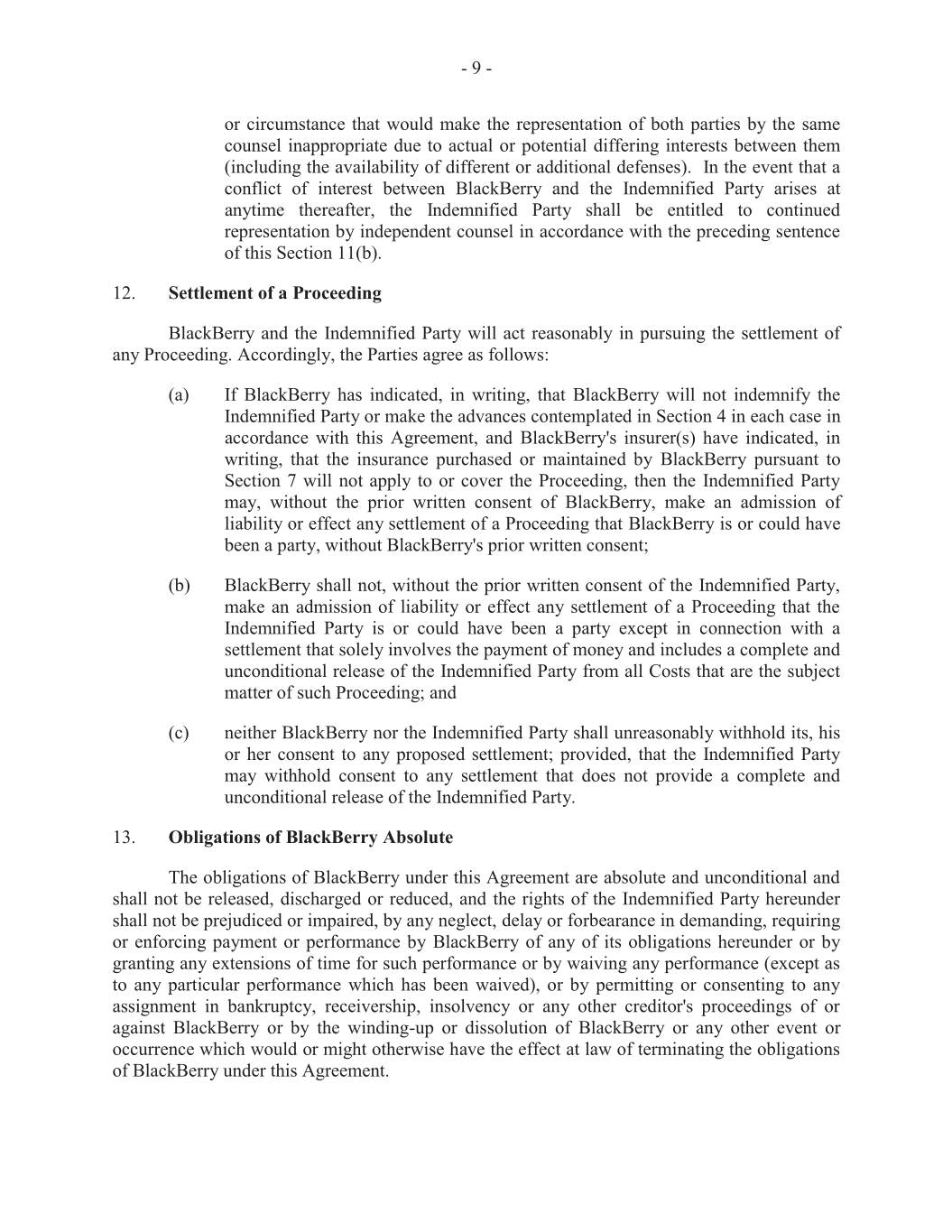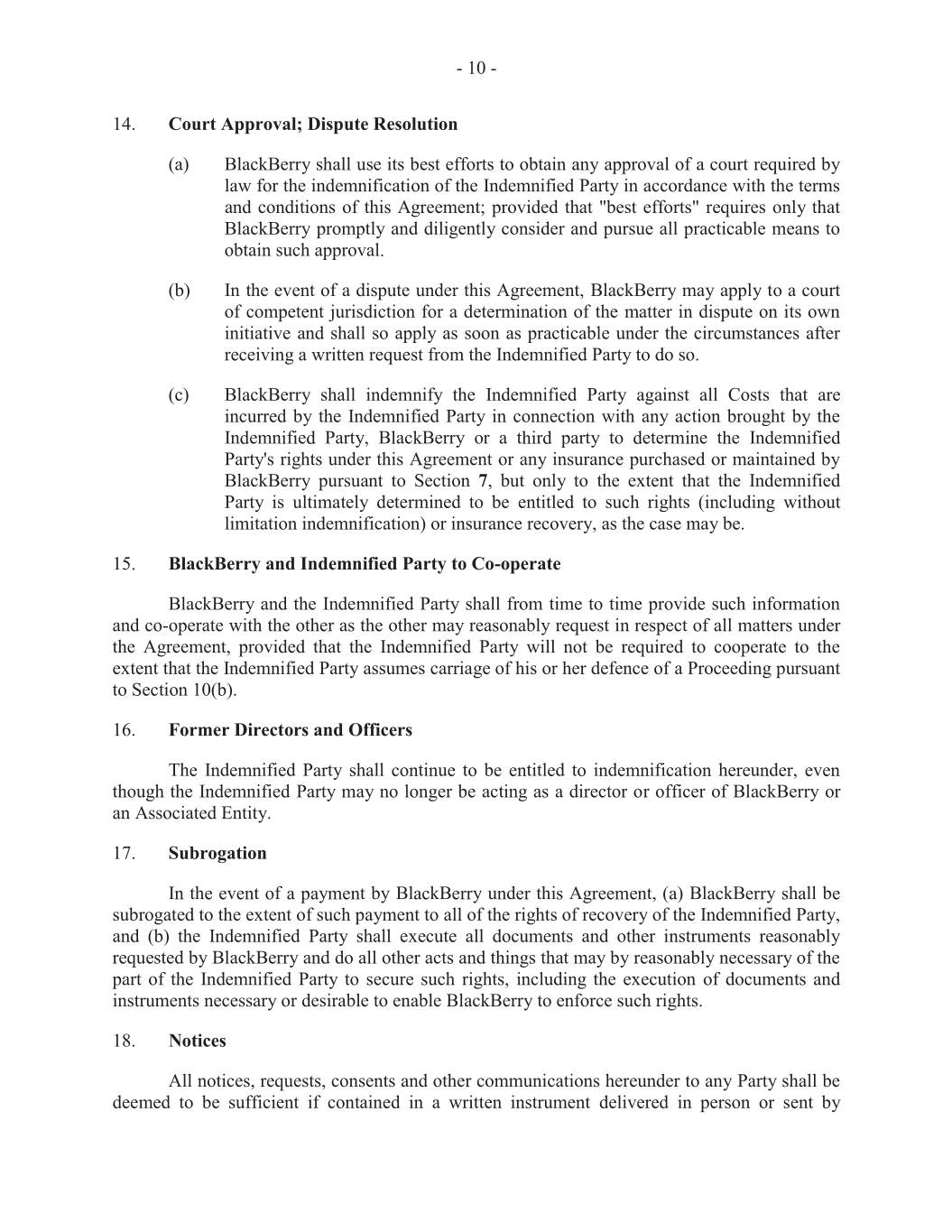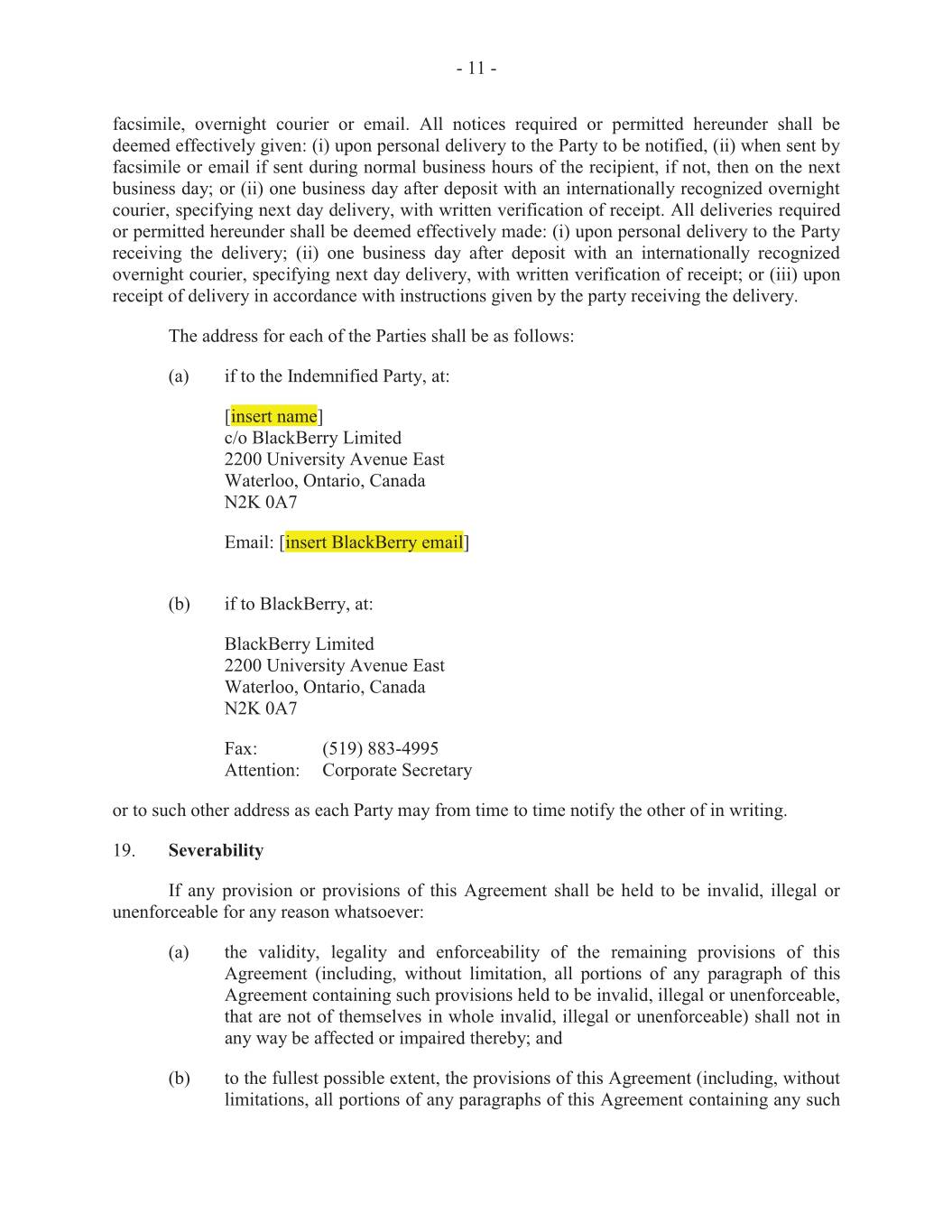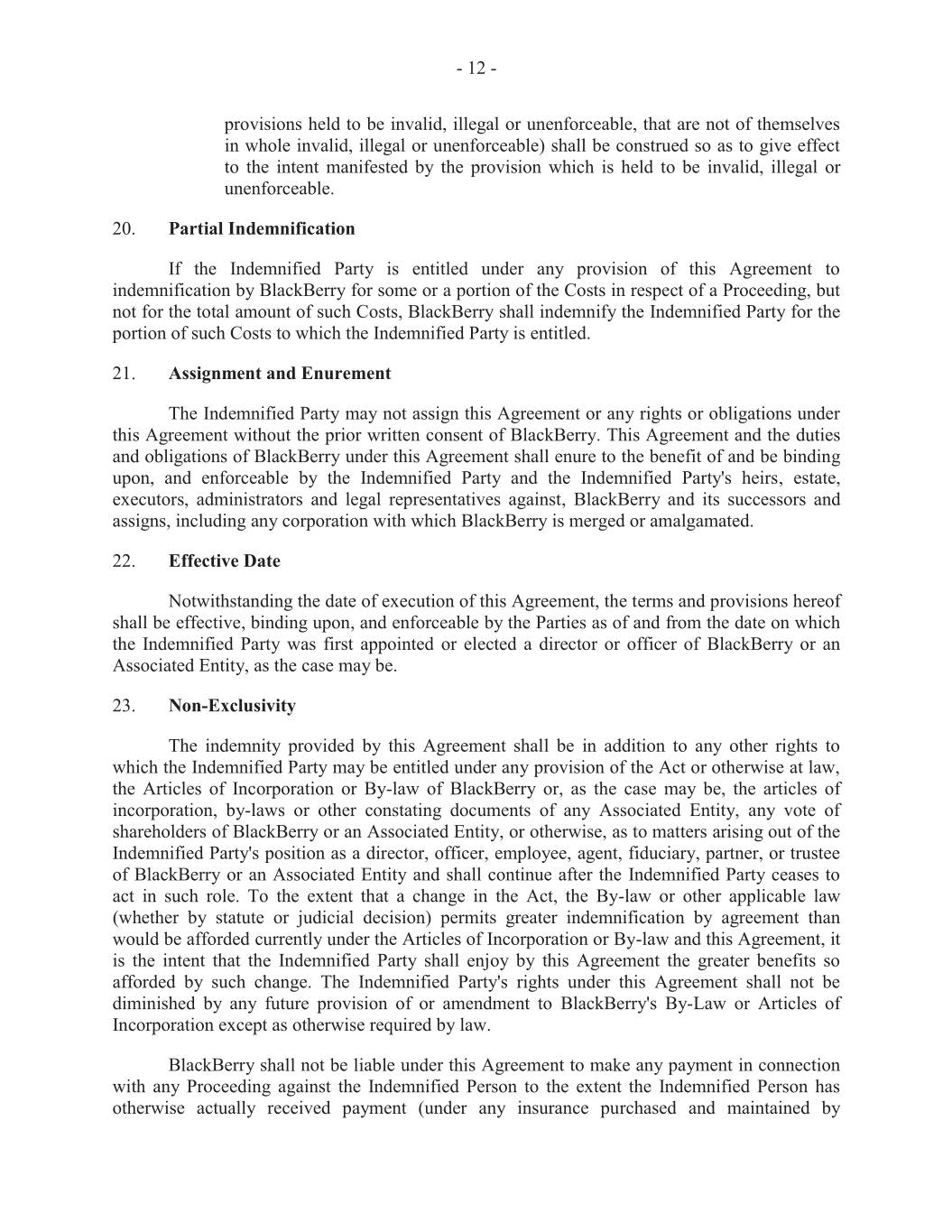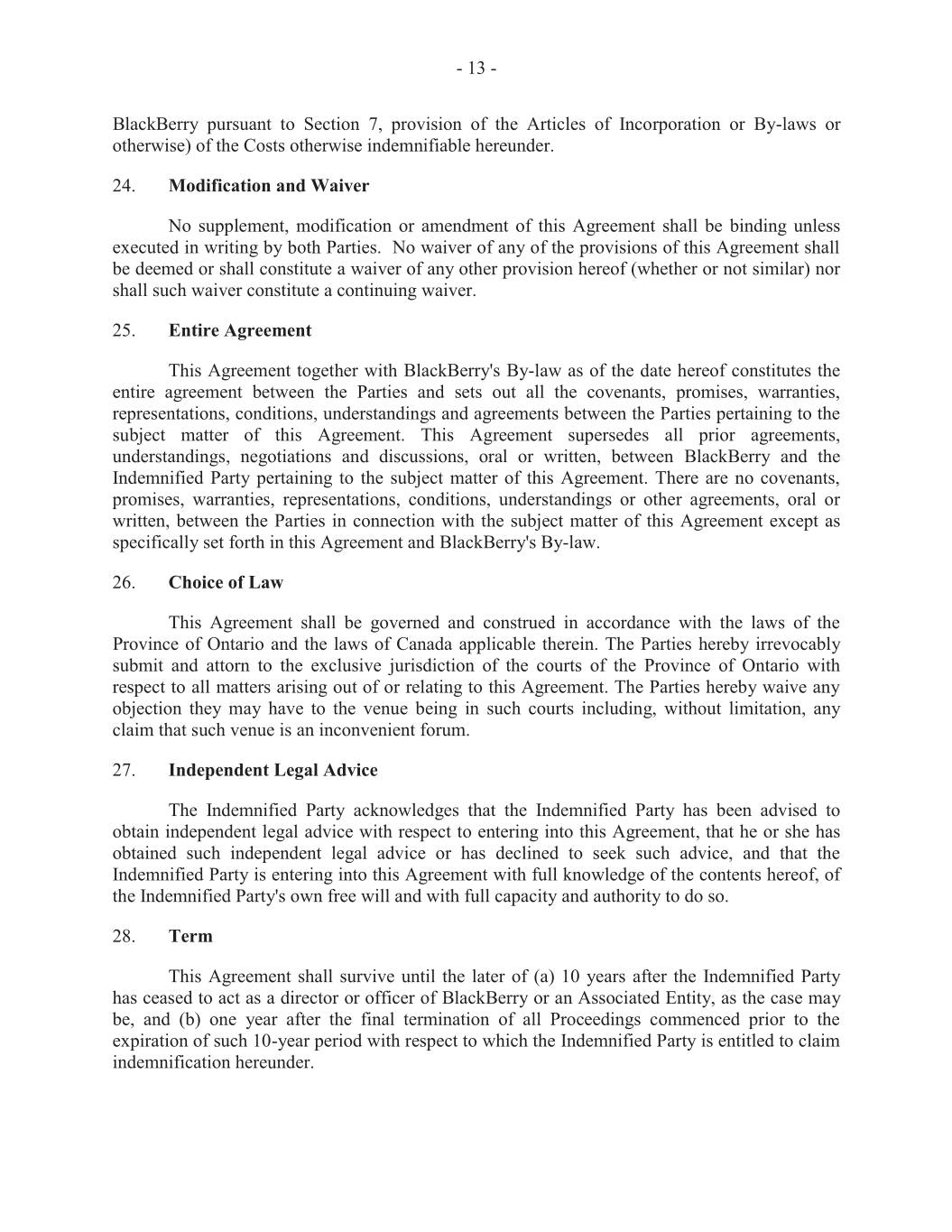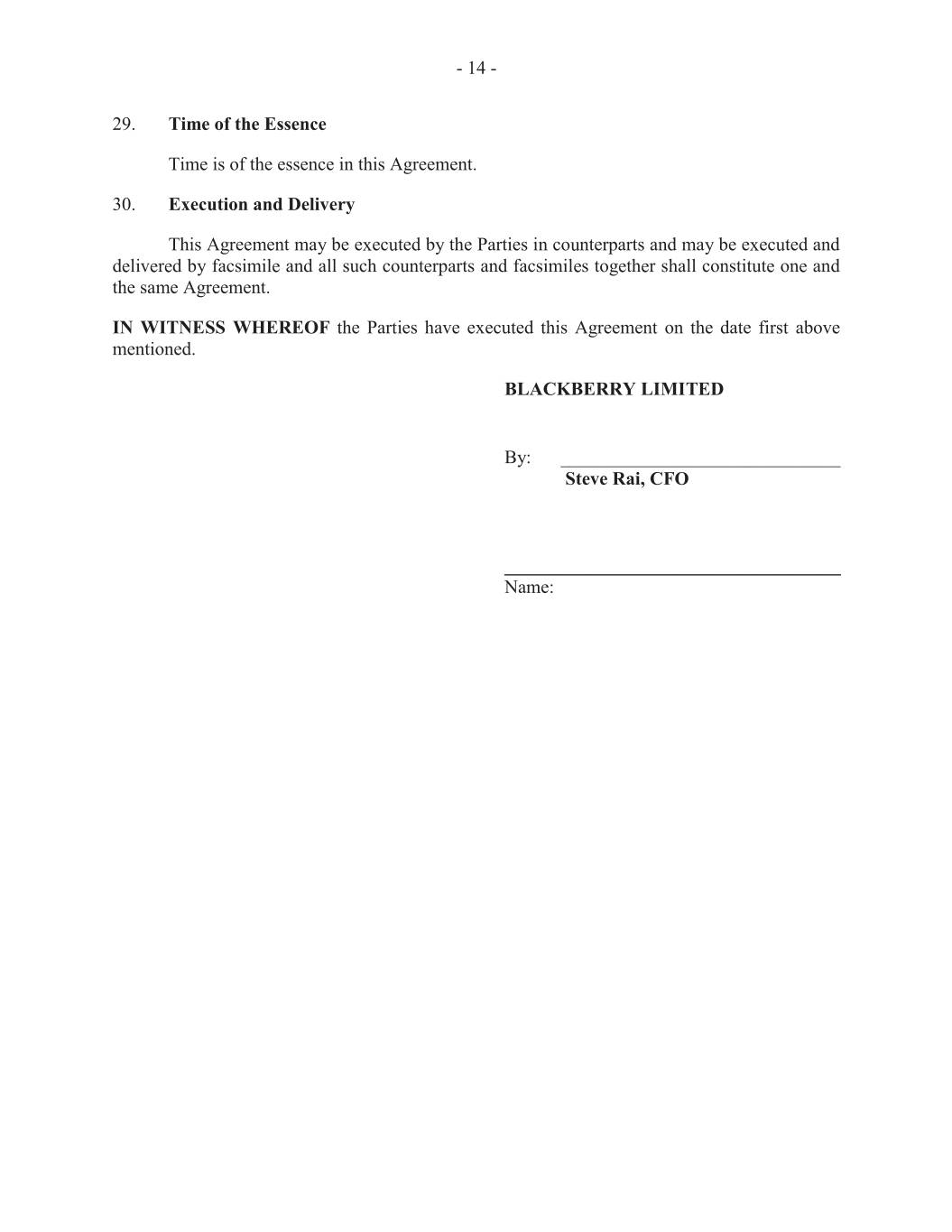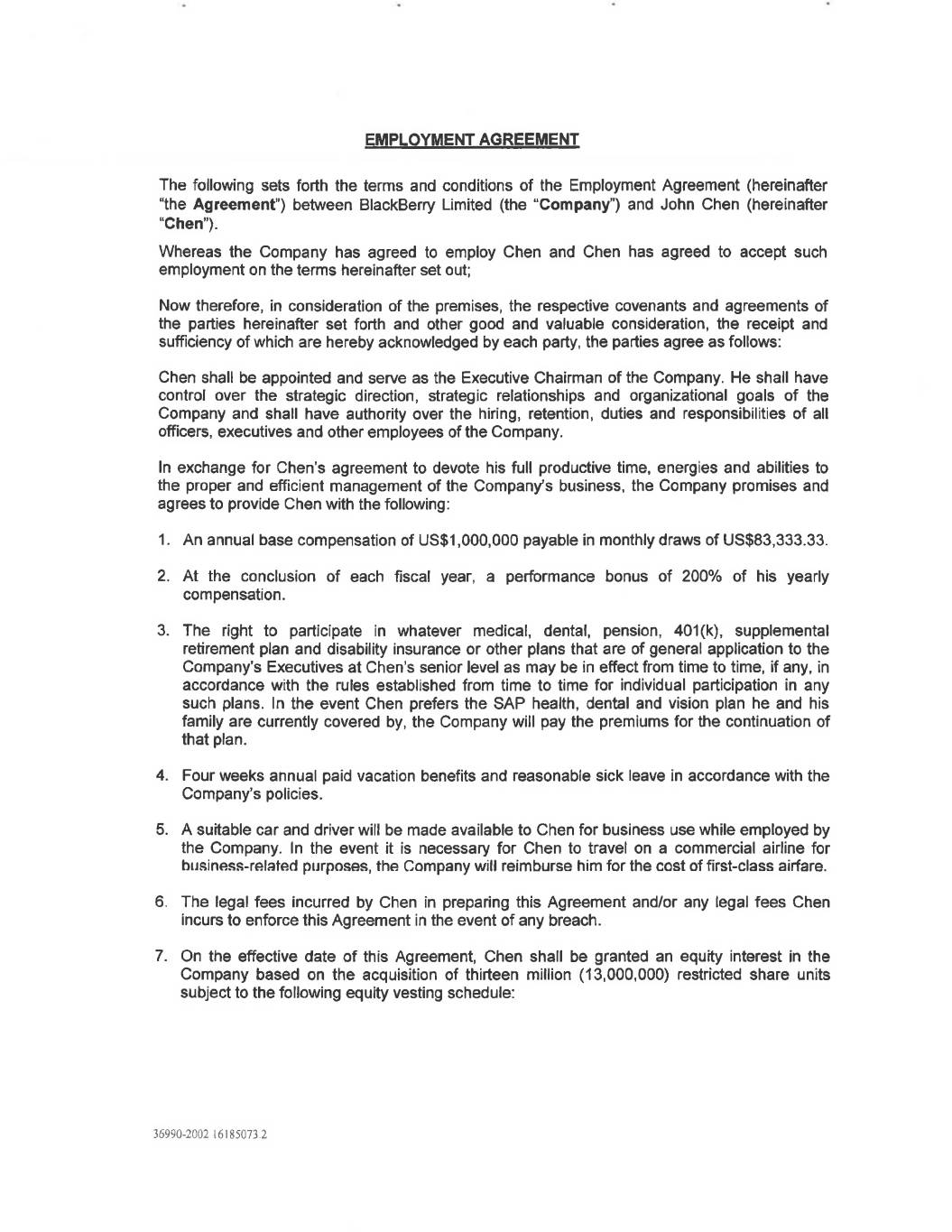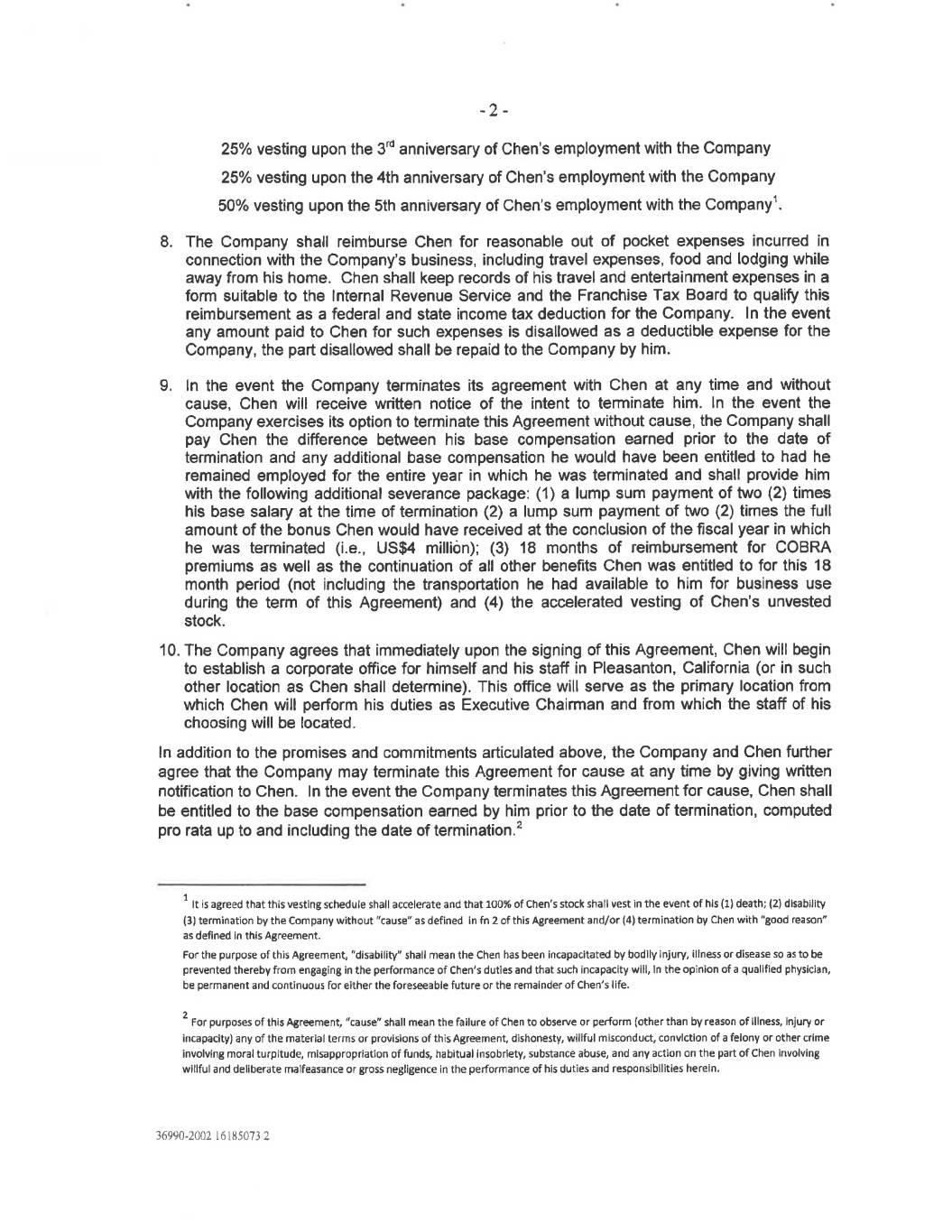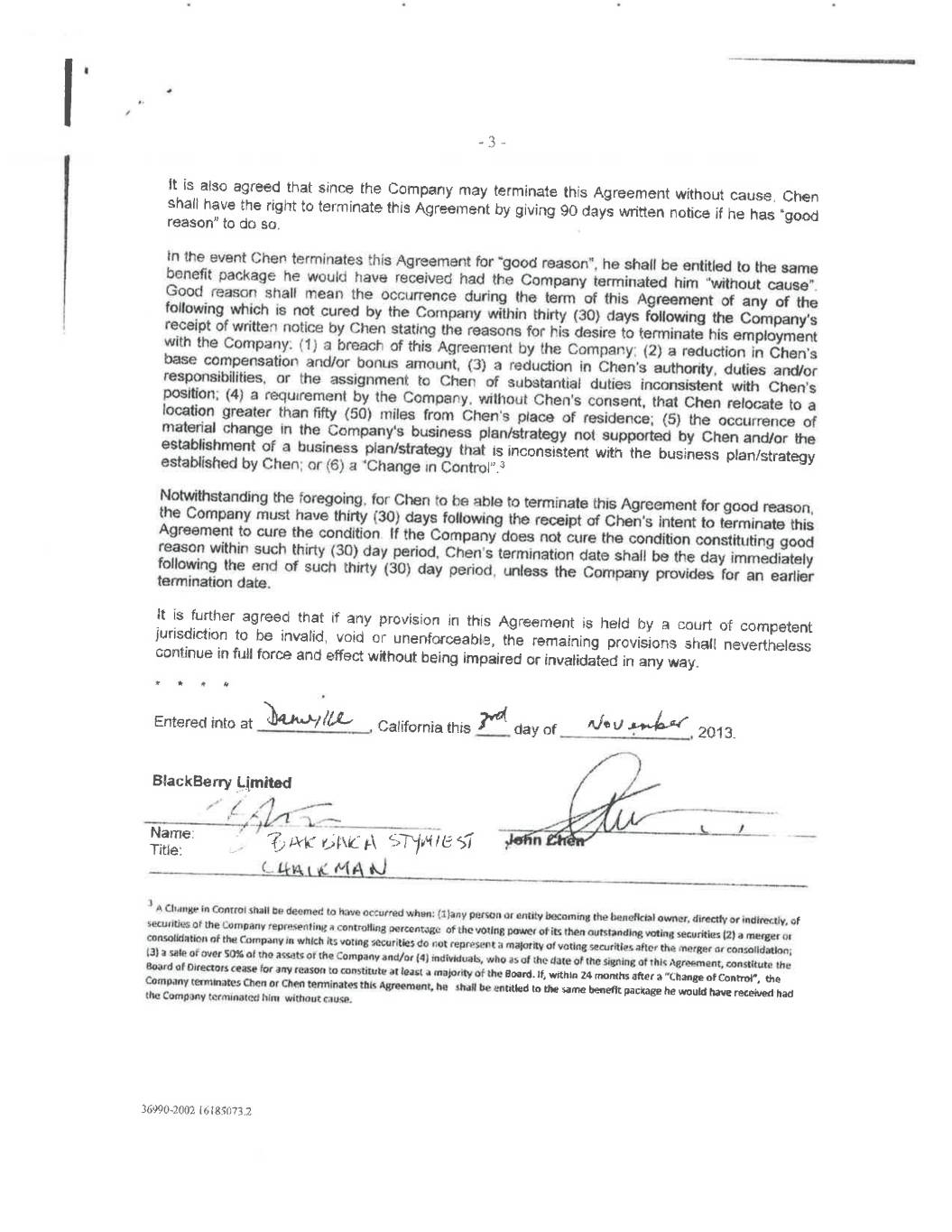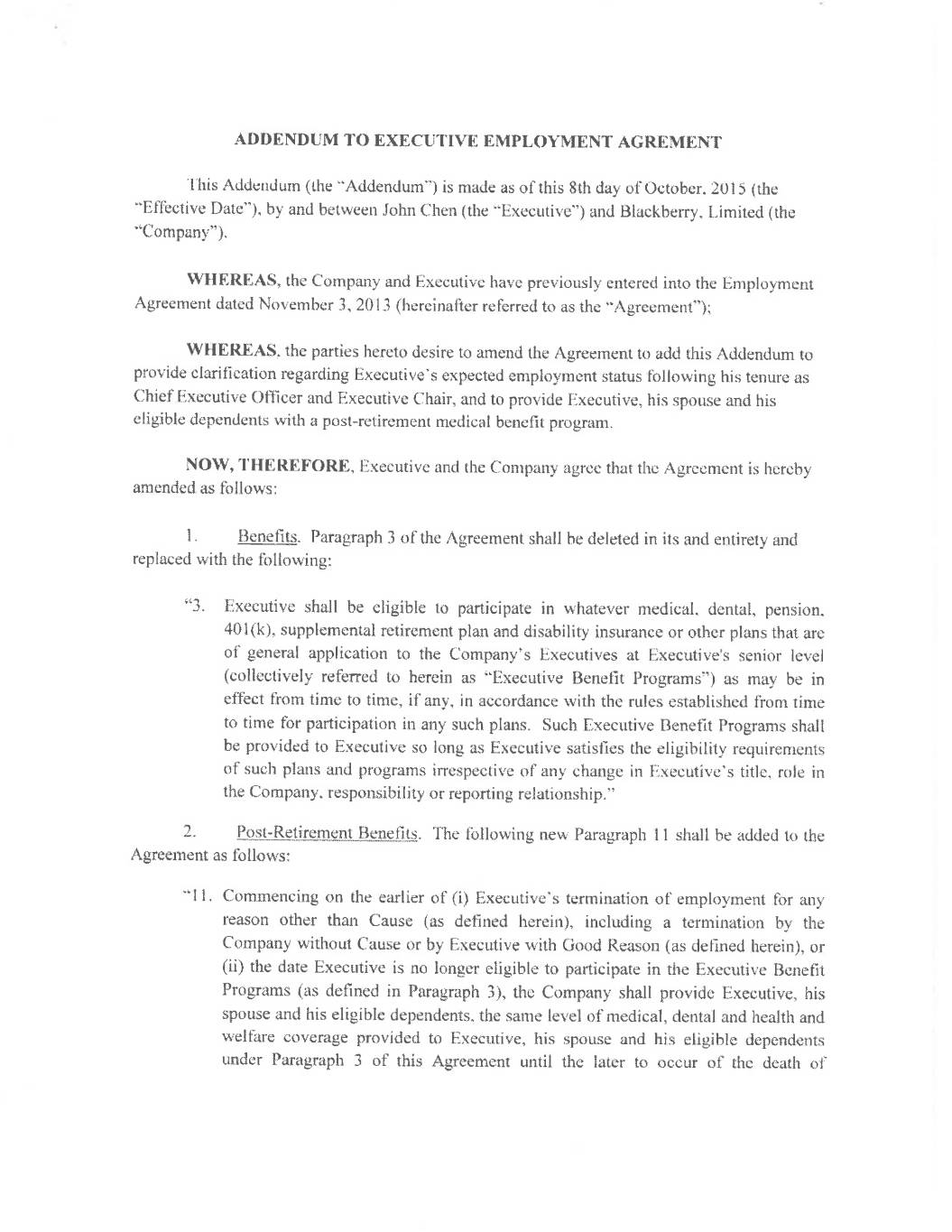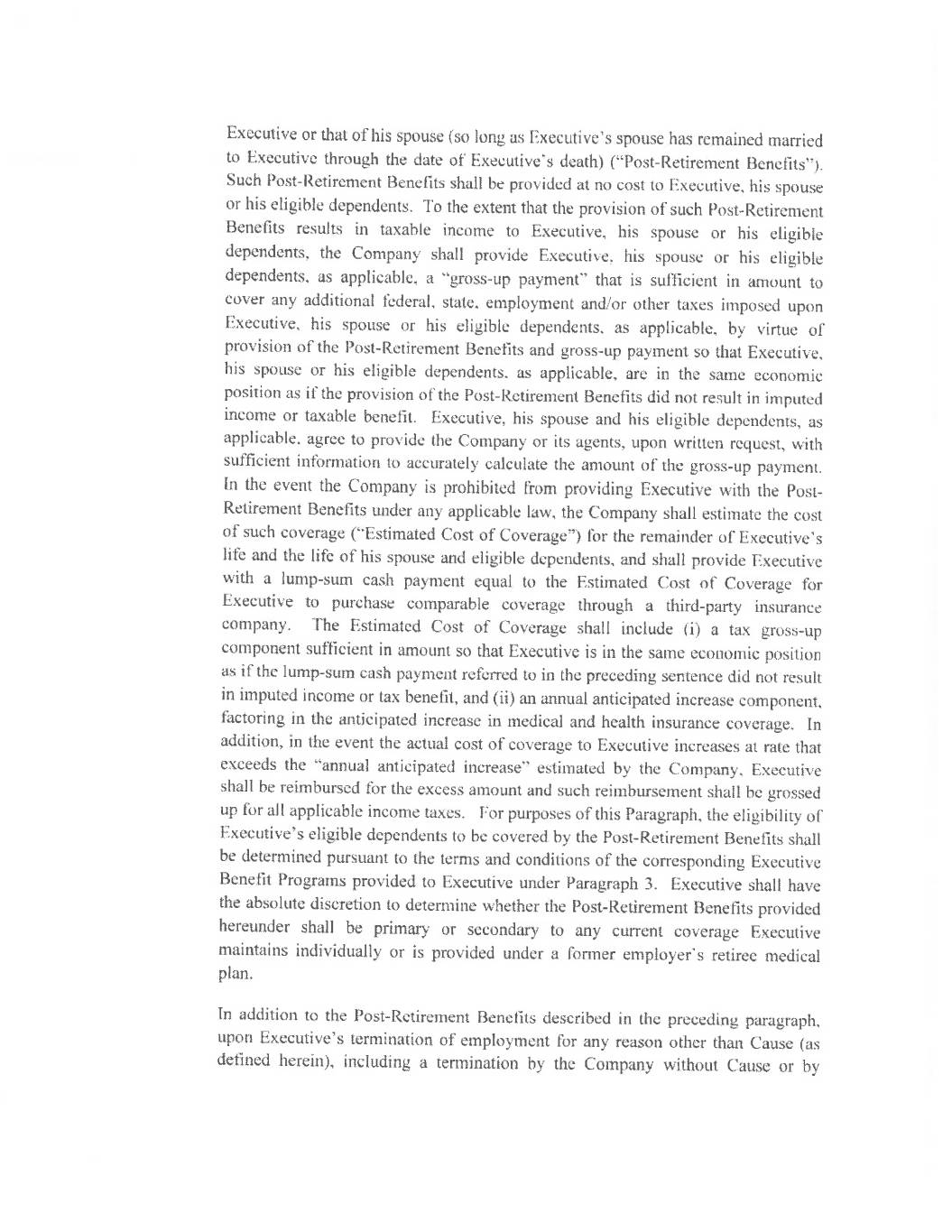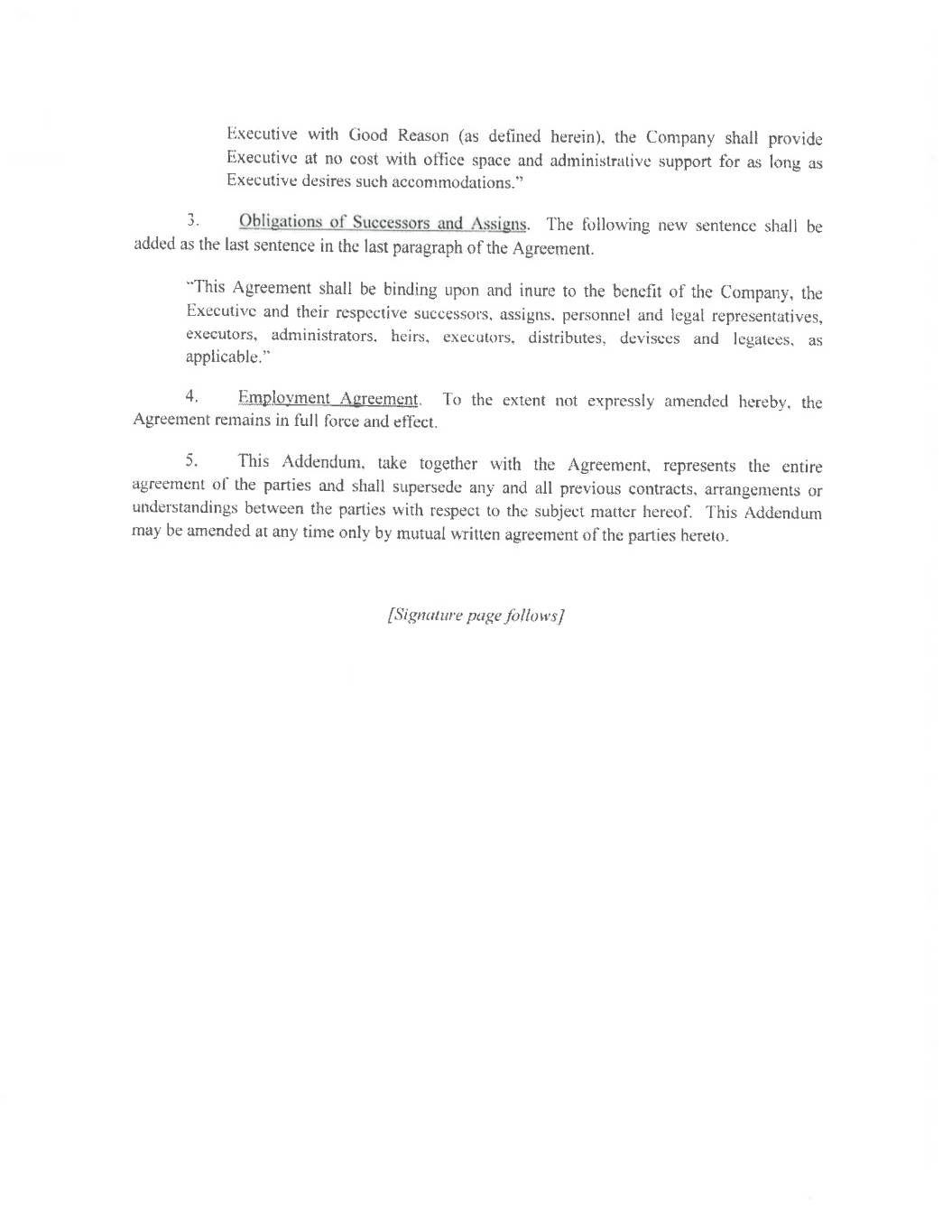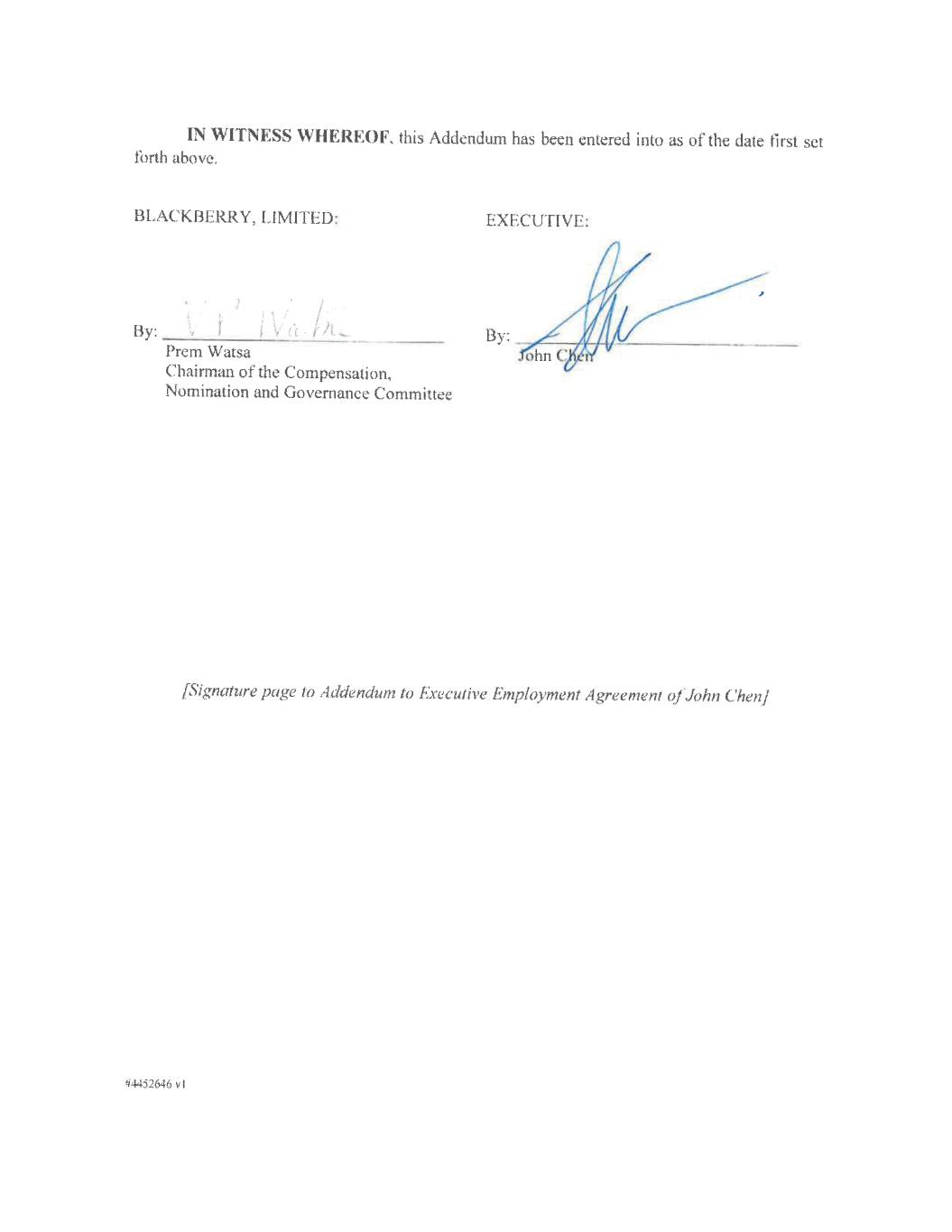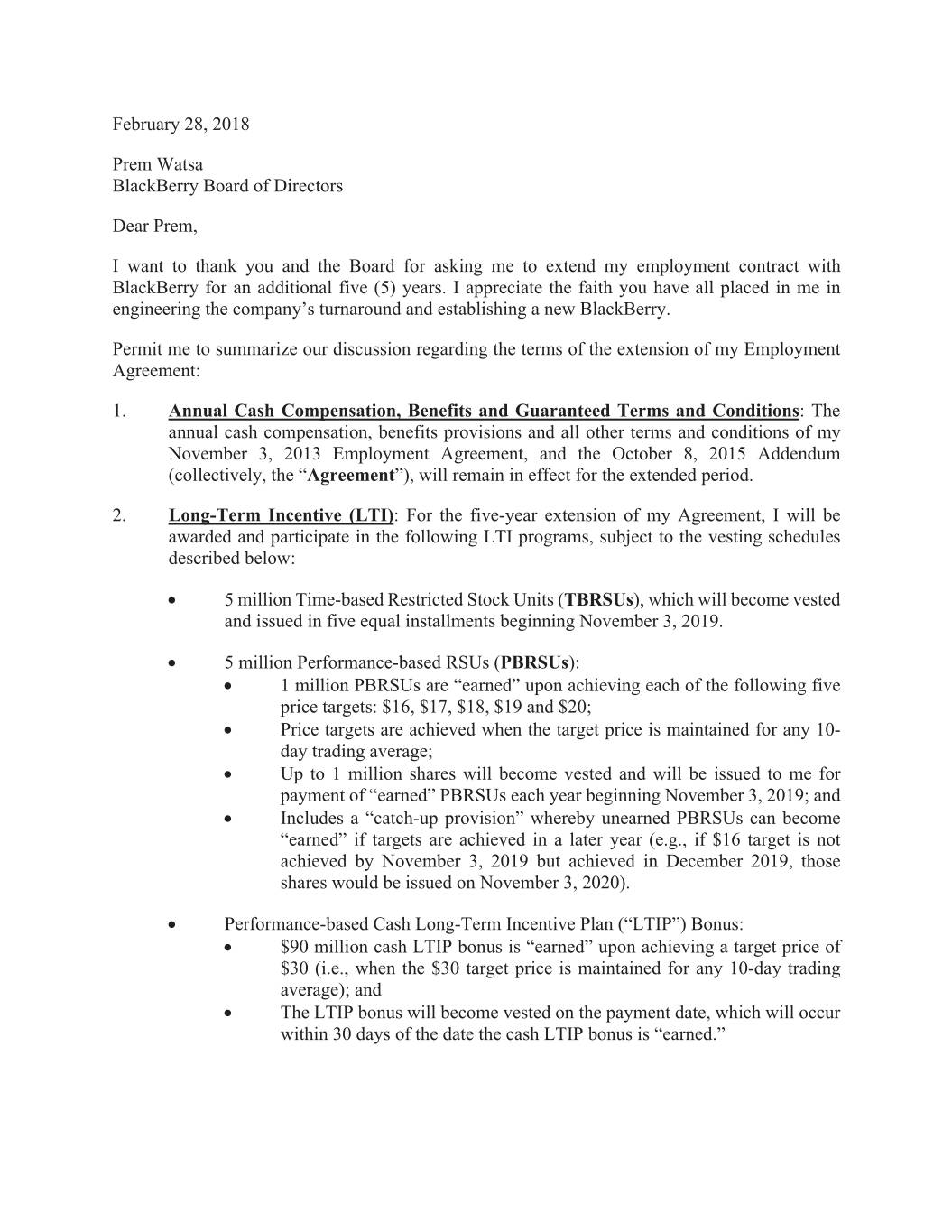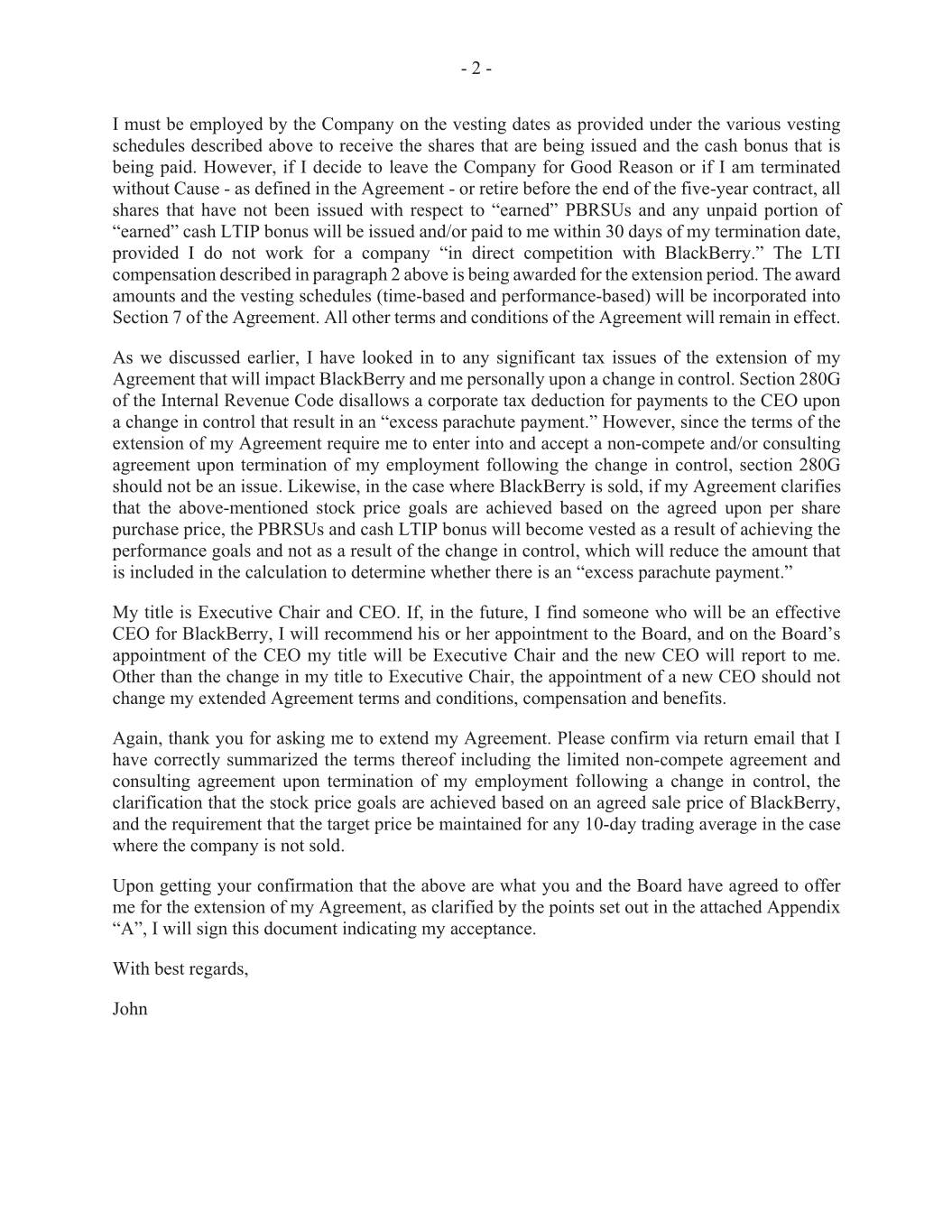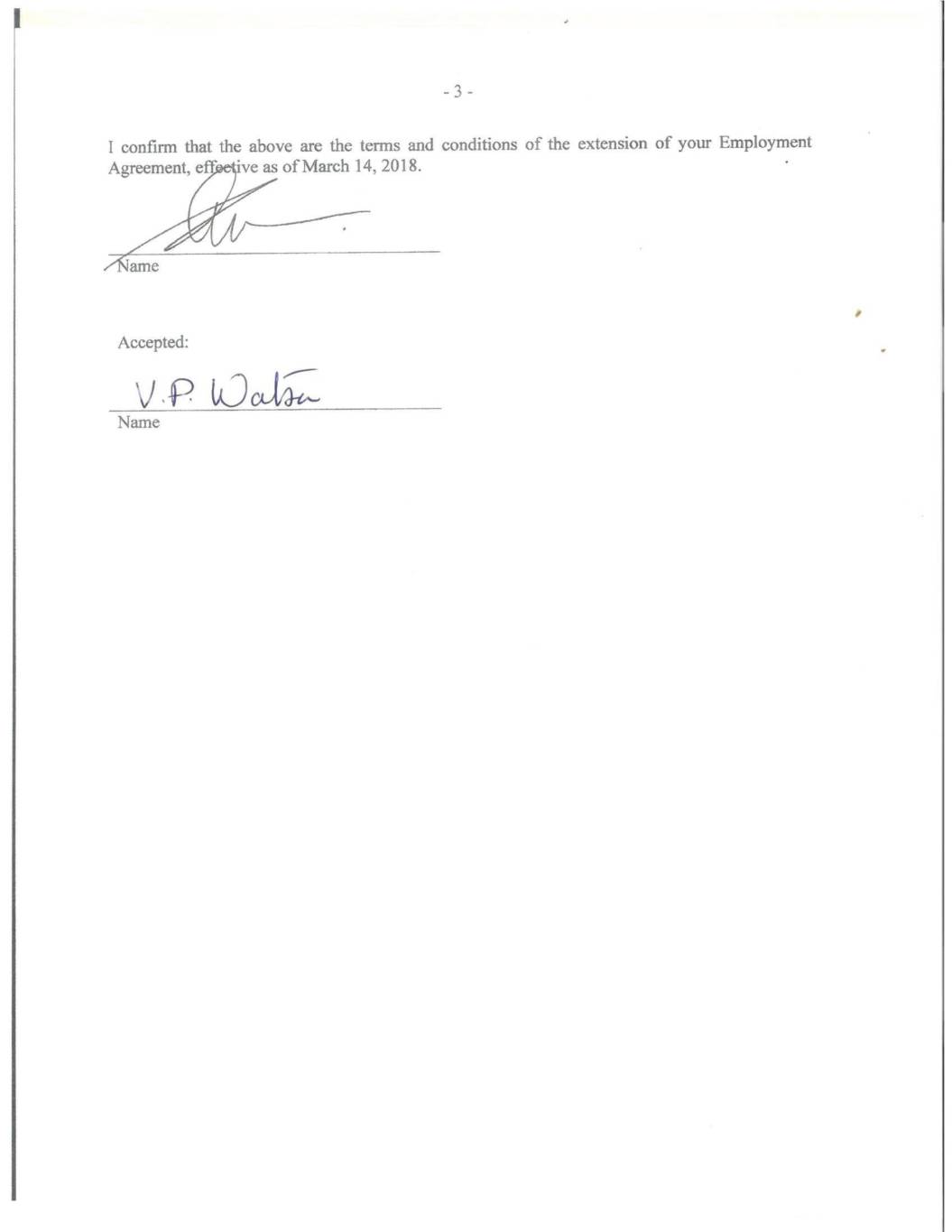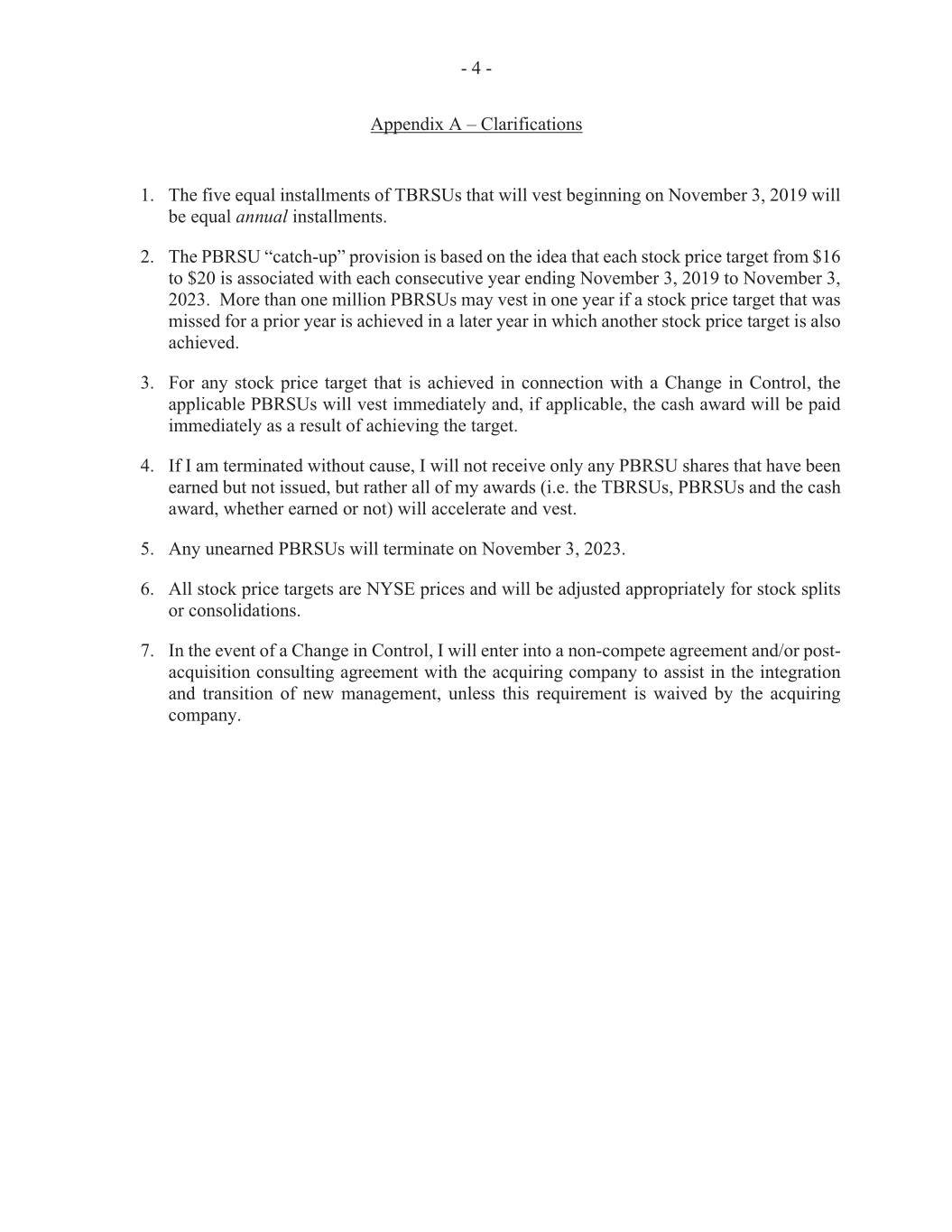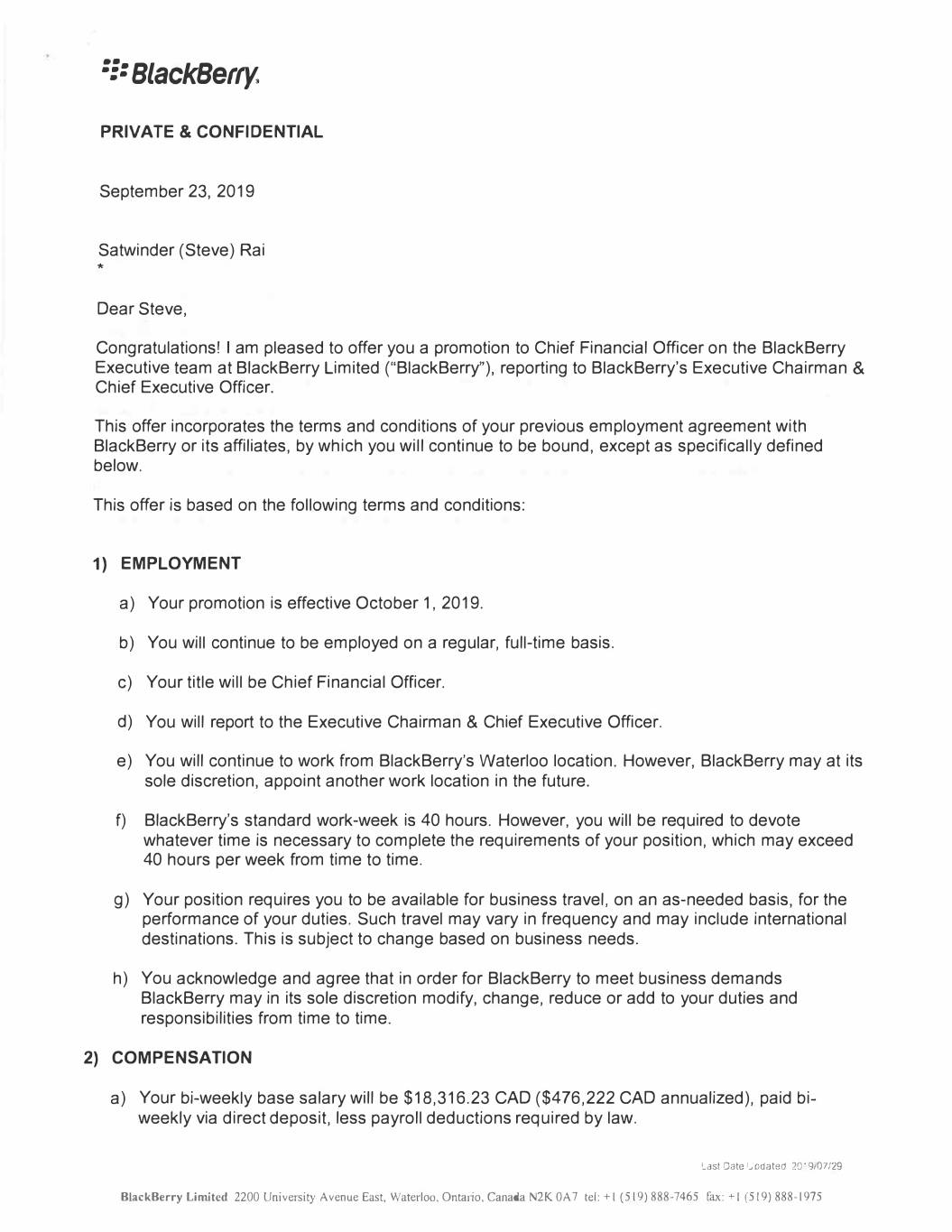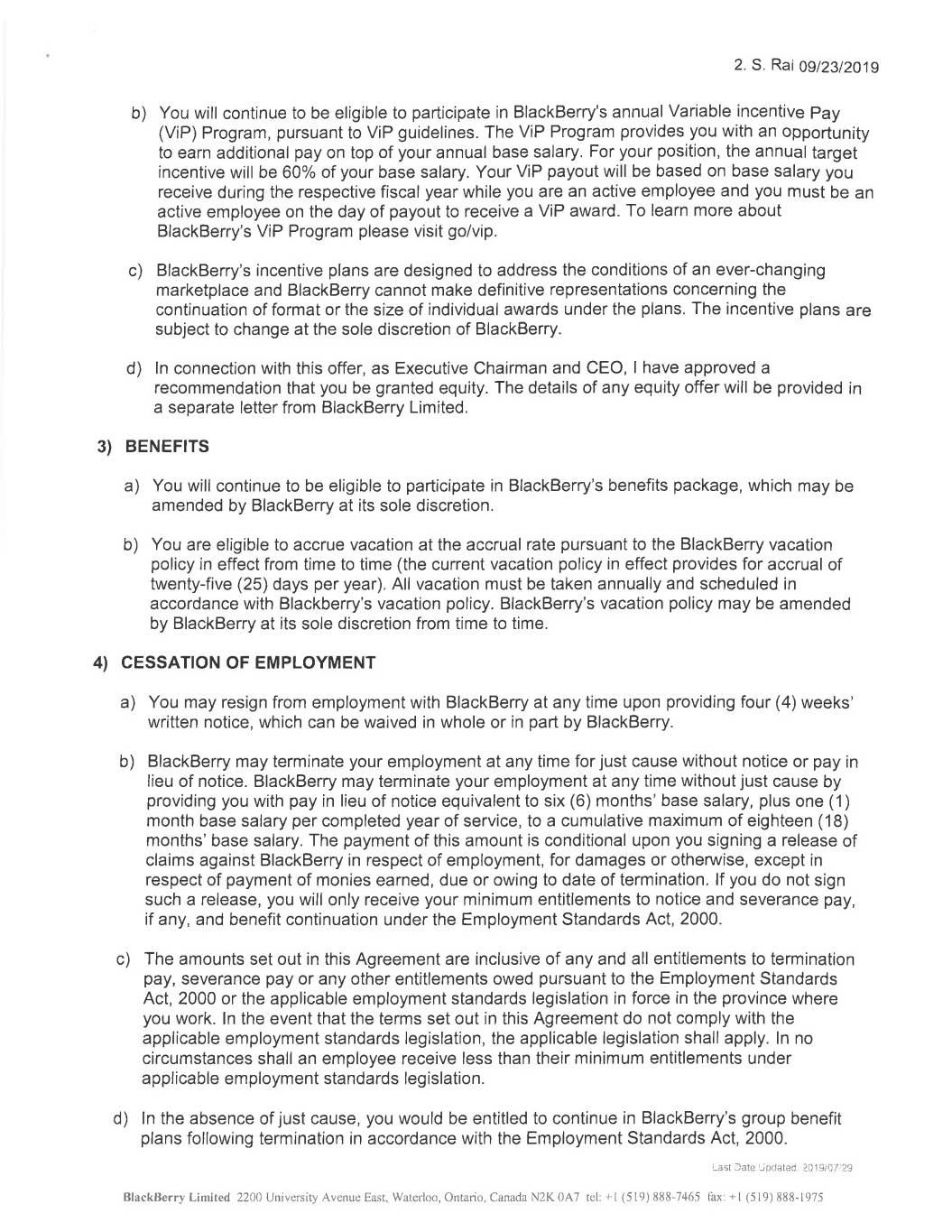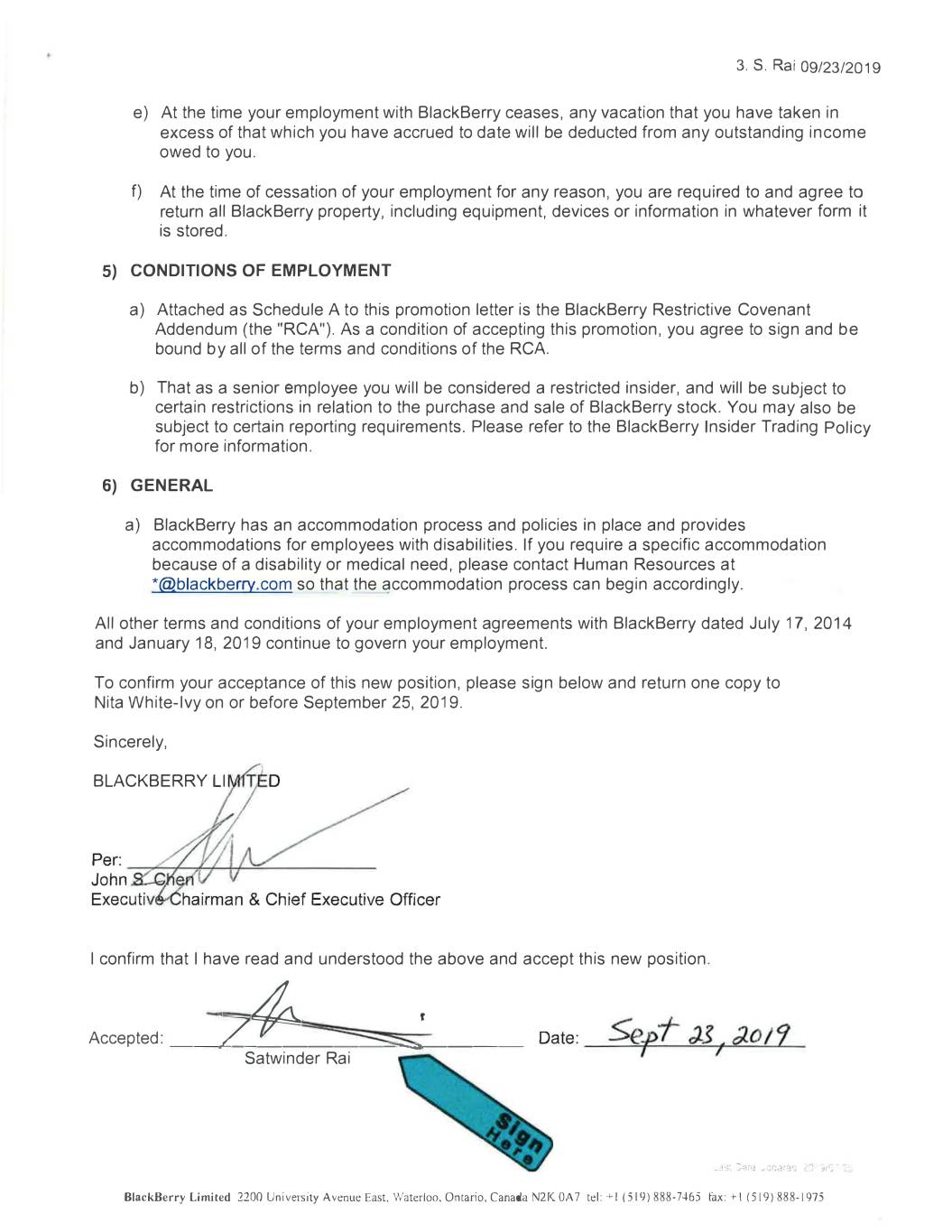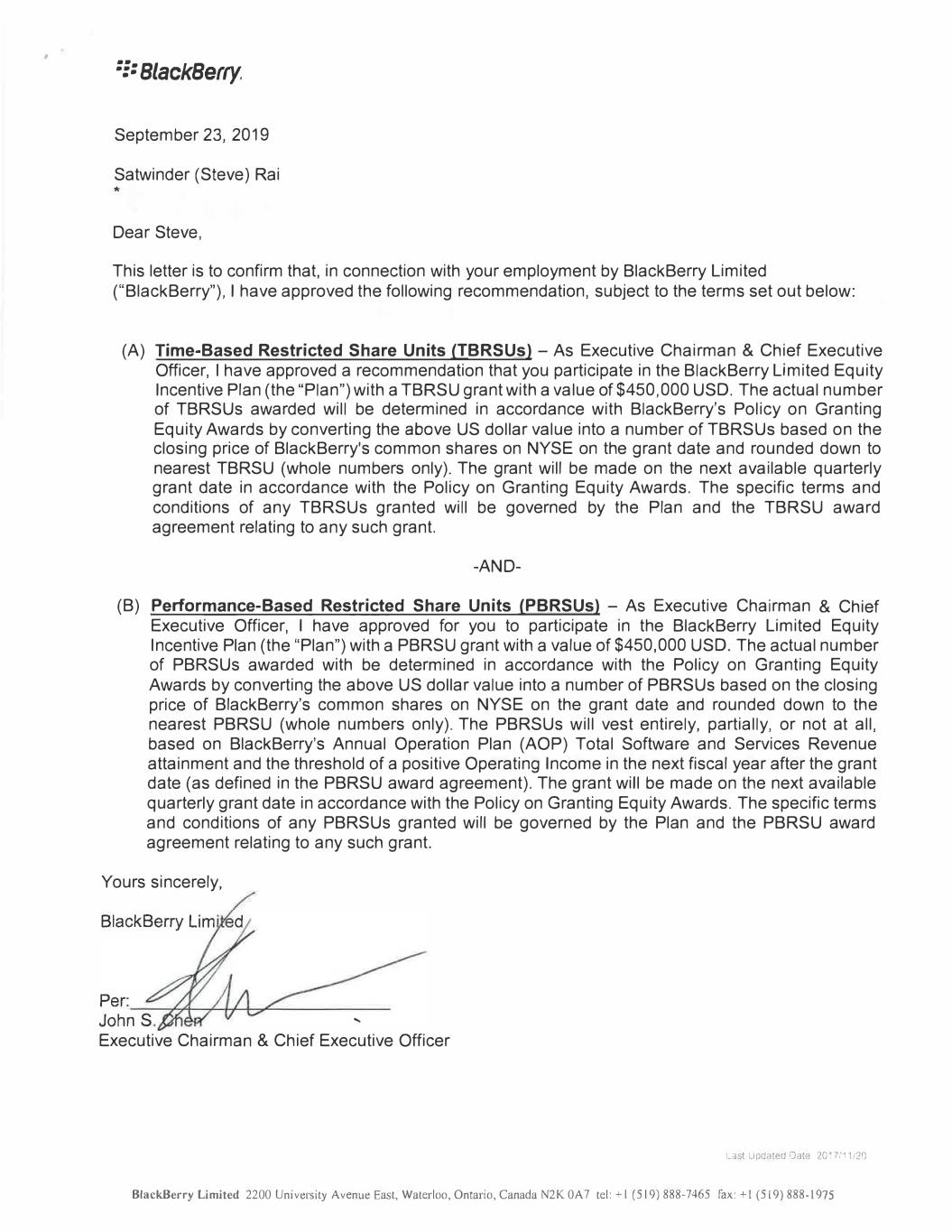UNITED STATES
SECURITIES AND EXCHANGE COMMISSION
Washington, D.C. 20549
________________________
FORM 10-K
ANNUAL REPORT PURSUANT TO SECTION 13 OR 15(d) OF THE SECURITIES EXCHANGE ACT OF 1934 | |||||
For the fiscal year ended February 29, 2020
OR
TRANSITION REPORT PURSUANT TO SECTION 13 OR 15(d) OF THE SECURITIES EXCHANGE ACT OF 1934 | |||||
For the transition period from to
Commission file number 001-38232
______________________________________________________
(Exact name of registrant as specified in its charter)
(State or other jurisdiction of incorporation or organization) | (I.R.S. Employer Identification No.) | |||||||||||||
(Address of Principal Executive Offices) | (Zip Code) | |||||||||||||
Registrant's telephone number, including area code
Securities registered pursuant to Section 12(b) of the Act:
| Title of each class | Trading Symbol(s) | Name of each exchange on which registered | ||||||
| Common Shares | BB | Toronto Stock Exchange | ||||||
Securities registered pursuant to section 12(g) of the Act: None
Indicate by check mark if the registrant is a well-known seasoned issuer, as defined in Rule 405 of the Securities Act.
Indicate by check mark if the registrant is not required to file reports pursuant to Section 13 or Section 15(d) of the Act.
Yes o No x
Indicate by check mark whether the registrant: (1) has filed all reports required to be filed by Section 13 or 15(d) of the Securities Exchange Act of 1934 during the preceding 12 months (or for such shorter period that the registrant was required to file such reports); and (2) has been subject to such filing requirements for the past 90 days. Yes x No o
1
Indicate by check mark whether the registrant has submitted electronically every Interactive Data File required to be submitted pursuant to Rule 405 of Regulation S-T (§232.405 of this chapter) during the preceding 12 months (or for such shorter period that the registrant was required to submit such files).
Indicate by check mark whether the registrant is a large accelerated filer, an accelerated filer, a non-accelerated filer, a smaller reporting company, or an emerging growth company. See the definitions of “large accelerated filer,” “accelerated filer”, “smaller reporting company” and “emerging growth company” in Rule 12b-2 of the Exchange Act. (Check one):
x | Accelerated filer | ☐ | |||||||||
Non-accelerated filer | o | Smaller reporting company | |||||||||
Emerging growth company | |||||||||||
If an emerging growth company, indicate by check mark if the registrant has elected not to use the extended transition period for complying with any new or revised financial accounting standards provided pursuant to Section 13(a) of the Exchange Act.
o
Indicate by check mark whether the registrant is a shell company (as defined in Rule 12b-2 of the Act). Yes ☐ No x
The aggregate market value of voting stock held by non-affiliates of the registrant on August 31, 2019, the last business date of the registrant’s most recently completed second fiscal quarter, based on the closing price of the common shares as reported by the New York Stock Exchange, was approximately $3.8 554,226,702 shares of common shares issued and outstanding as of March 26, 2020.
DOCUMENTS INCORPORATED BY REFERENCE
2
| BLACKBERRY LIMITED | |||||||||||
| TABLE OF CONTENTS | |||||||||||
| Page No. | |||||||||||
| PART I | |||||||||||
| Item 1 | Business | ||||||||||
| Item 1A | Risk Factors | ||||||||||
| Item 1B | Unresolved Staff Comments | ||||||||||
| Item 2 | Properties | ||||||||||
| Item 3 | Legal Proceedings | ||||||||||
| Item 4 | Mine Safety Disclosures | ||||||||||
| PART II | |||||||||||
| Item 5 | Market for Registrant's Common Equity, Related Stockholder Matters and Issuer Purchases of Equity Securities | ||||||||||
| Item 6 | Selected Financial Data | ||||||||||
| Item 7 | Management's Discussion and Analysis of Financial Condition and Results of Operation | ||||||||||
| Item 7A | Quantitative and Qualitative Disclosures about Market Risk | ||||||||||
| Item 8 | Financial Statements and Supplementary Data | ||||||||||
| Item 9 | Changes in and Disagreements With Accountants on Accounting and Financial Disclosure | ||||||||||
| Item 9A | Controls and Procedures | ||||||||||
| Part III | |||||||||||
| Item 10 | Directors, Executive Officers and Corporate Governance | ||||||||||
| Item 11 | Executive Compensation | ||||||||||
| Item 12 | Security Ownership of Certain Beneficial Owners and Management and Related Stockholder Matters | ||||||||||
| Item 13 | Certain Relationships and Related Transactions, and Director Independence | ||||||||||
| Item 14 | Principal Accounting Fees and Services | ||||||||||
| PART IV | |||||||||||
| Item 15 | Exhibits and Financial Statement Schedules | ||||||||||
| Item 16 | Form 10-K Summary | ||||||||||
| Signatures | |||||||||||
3
Unless the context otherwise requires, all references to the “Company” and “BlackBerry” include BlackBerry Limited and its subsidiaries.
PART I
ITEM 1. BUSINESS
The Company
The Company provides intelligent security software and services to enterprises and governments around the world. The company secures more than 500 million endpoints including 150 million cars. Based in Waterloo, Ontario, the company leverages artificial intelligence (“AI”) and machine learning to deliver innovative solutions in the areas of cybersecurity, safety and data privacy, and is a leader in the areas of endpoint security management, encryption, and embedded systems.
The Company was incorporated under the Business Corporations Act (Ontario) (“OBCA”) on March 7, 1984 and commenced operations at that time. The Company has amalgamated with several of its wholly-owned subsidiaries, the last amalgamation occurring through the filing of articles of amalgamation under the OBCA on November 4, 2013. The Company’s common shares trade under the ticker symbol “BB” on the New York Stock Exchange (“NYSE”) and the Toronto Stock Exchange (“TSX”).
Intercorporate Relationships
The Company has five material subsidiaries, all of which are wholly-owned, directly or indirectly, by the Company in each case as at February 29, 2020.
| Name of Subsidiary | Jurisdiction of Incorporation or Organization | |||||||
| BlackBerry Corporation | Delaware, U.S.A. | |||||||
| BlackBerry UK Limited | England and Wales | |||||||
| Cylance Inc. | Delaware, U.S.A. | |||||||
| Good Technology Corporation | Delaware, U.S.A. | |||||||
| QNX Software Systems Limited | Ontario, Canada | |||||||
Internet of Things Security Software Industry
As the digital transformation of enterprises continues to advance, workforces are becoming more distributed and mobile, and data and applications are increasingly migrating to the cloud. As part of this trend, the number of connected endpoints is growing rapidly, as is their complexity and the volume of sensitive data that they process and store. These endpoints, which include smartphones, laptops, desktops, servers, vehicles, industrial equipment and other connected devices in the Internet of Things (“IoT”), increasingly operate beyond the traditional network security perimeter and present an expanding attack surface to cyber adversaries.
At the same time, the threat environment for enterprises has become increasingly hostile as the number of adversaries grows and the sophistication of their attacks, increasingly focused on the endpoint, continues to develop. Today’s malicious actors are often well-trained and well-funded criminal organizations, state-sponsored agents and international hacking collectives with the capability of employing advanced techniques to penetrate endpoints and encrypt, destroy or exfiltrate data. These groups have been responsible for highly publicized breaches that have exposed personal information and intellectual property, disrupted operations and caused significant financial and reputational damage to organizations across a broad range of industries.
Against this backdrop, regulators are enacting new measures to ensure that enterprises are held accountable for their management of cybersecurity risk. In particular, changes to data privacy laws in the United States, Europe and other jurisdictions are compounding the challenges faced by organizations by increasing their responsibilities for securing their data as well as that of their customers.
This landscape has created opportunities for secure communications platforms, endpoint management and protection solutions, embedded systems, enterprise applications, analytic tools and related services that help enterprises to secure their connected endpoints, enhance data privacy and demonstrate compliance with applicable regulations.
4
Strategy
The Company is widely recognized for its intelligent security software and services, and believes that it delivers the broadest set of security capabilities and visibility in the market, covering users, devices, networks, apps and data. The Company leverages its extensive technology portfolio to offer best-in-class security, safety and reliability to enterprise customers in growing segments of the IoT, cybersecurity, connected transportation, healthcare, financial services and government markets.
The Company’s goal is to remain a leader in regulated industries and other core verticals by continuing to extend the functionality of its secure BlackBerry Spark® software platform through organic investments and strategic acquisitions and partnerships. The Company intends to drive revenue growth and to achieve margins that are consistent with those of other enterprise software companies.
The Company’s go-to-market strategy focuses principally on generating revenue from enterprise software, services and licensing. The Company continues to build its developer and channel partner programs to bolster its direct sales and marketing efforts and promote the growth of an IoT ecosystem.
Products and Services
The Company is organized and managed as one operating segment. The Company has multiple products and services from which it derives revenue, which are structured in three groups: BlackBerry Spark, BlackBerry IoT Solutions, and BlackBerry IP Licensing.
BlackBerry Spark
The Company’s core software and services offering is its secure BlackBerry Spark software platform that comprises continuous authentication, endpoint protection platform (“EPP”), endpoint detection and response (“EDR”), and mobile threat defense (“MTD”) capabilities. BlackBerry Spark includes a unified endpoint security (“UES”) layer which integrates with BlackBerry unified endpoint management (“UEM”) to enable secure endpoint communications in a zero trust environment. The platform is informed by the Company’s AI and machine learning capabilities, continuous innovations, professional cybersecurity services, industry partnerships and academic collaborations. The Company is currently executing on a robust schedule of product launches for BlackBerry Spark to deliver a comprehensive security approach operating on one agent across all endpoints, administered from one console, leveraging one crowd-sourced threat data repository and managed in one cloud environment.
The BlackBerry Spark platform includes a suite of security software products and services, including BlackBerry Cylance, BlackBerry® UEM, BlackBerry® Dynamics™ and BlackBerry® Workspaces. The Company also offers the BlackBerry® Spark SDK to promote the evolution of a platform ecosystem by enabling enterprise and independent software vendor (“ISV”) developers to integrate the security features of BlackBerry Spark into their own mobile and web applications.
BlackBerry Cylance
BlackBerry Cylance offers leading AI and machine learning-based cybersecurity solutions, including: CylancePROTECT®, an EPP solution that uses machine learning to prevent suspicious behavior and the execution of malicious code on an endpoint; CylanceOPTICS®, an EDR solution that provides both visibility into and prevention of malicious activity on an endpoint; and CylanceGUARD™, an MDR solution that provides continuous threat hunting and monitoring. The combined platform features industry-leading threat prevention modules to help organizations cope with the significant growth of cyberattacks. This enables organizations to employ a prevention-oriented strategy to ensure that threats do not run on a system. Unlike traditional signature-based cybersecurity products, the BlackBerry Cylance solution can predict whether code that has never been seen before, known in the cybersecurity industry as “zero-day” threats, is malicious and prevent it from running. BlackBerry Cylance also offers incident response, compromised assessment and containment services to assist clients with forensic analysis, state of existing systems and remediation of attacks.
BlackBerry UEM and BlackBerry Dynamics
BlackBerry UEM is a central software component of the Company’s secure communications platform, offering a “single pane of glass”, or unified console view, for managing and securing devices, applications, identity, content and endpoints across all leading operating systems. BlackBerry Dynamics offers a best-in-class development platform and secure container for mobile applications, including the Company’s own enterprise applications such as BlackBerry® Work and BlackBerry® Connect for secure collaboration.
BlackBerry Workspaces
BlackBerry Workspaces is an enterprise file synchronization and sharing solution that embeds digital rights management protection in shared files to address the challenges of document security, manageability, tracking and compliance among multiple users in the enterprise.
5
BlackBerry IoT Solutions
The BlackBerry IoT Solutions group includes BlackBerry® QNX®, BlackBerry® AtHoc®, SecuSUITE, BlackBerry Certicom®, BlackBerry Radar®, and other IoT applications.
BlackBerry QNX
BlackBerry QNX is a global provider of real-time operating systems, middleware, development tools, and professional services for connected embedded systems in the automotive, medical, industrial automation and other markets. A recognized leader in automotive software, BlackBerry QNX offers a growing portfolio of safety-certified, secure and reliable platform solutions and is focused on achieving design wins with automotive original equipment manufacturers (“OEMs”), Tier 1 vendors and automotive semiconductor suppliers. These solutions include the Neutrino® operating system and the BlackBerry QNX® CAR platform, the most advanced embedded software platform for the autonomous vehicle market, as well as other products designed to alleviate the challenges of compliance with ISO 26262, the automotive industry’s functional safety standard. Additionally, the Company’s secure automotive over-the-air software update management service allows OEMs to manage the life cycle of the software and security in their vehicles.
The Company is developing a concept system to integrate BlackBerry Spark capabilities, including AI and machine learning technologies, with BlackBerry QNX automotive solutions.
BlackBerry QNX is also a preferred supplier of embedded systems for companies building medical devices, train-control systems, industrial robots, hardware security modules, building automation systems, green energy solutions, and other mission-critical applications.
BlackBerry AtHoc
BlackBerry AtHoc is a secure, networked crisis communications software platform that enables people, devices and organizations to exchange critical information in real time during business continuity and life safety operations. The platform securely connects with a diverse set of endpoints to distribute emergency mass notifications, improve personnel accountability and facilitate the bidirectional collection and sharing of data within and between organizations. BlackBerry AtHoc earned FedRAMP authorization in fiscal 2018 and helps to protect more than 70% of U.S. government personnel.
SecuSUITE
SecuSUITE® for Government is a certified, multi-OS voice and text messaging solution with advanced encryption and anti-eavesdropping capabilities providing a maximum level of security on the individual device level for public authorities and businesses.
BlackBerry Certicom
BlackBerry Certicom leverages patented elliptic curve cryptography to provide device security, anti-counterfeiting and product authentication solutions. BlackBerry Certicom’s offerings include its managed public key infrastructure (“PKI”) platform, key management and provisioning technology that helps customers to protect the integrity of their silicon chips and devices from the point of manufacturing through the device life cycle. BlackBerry Certicom’s secure key provisioning, code signing and security credential management system services protect next-generation connected cars, critical infrastructure and IoT deployments from product counterfeiting, re-manufacturing and unauthorized network access.
BlackBerry Radar
The Company offers the BlackBerry Radar family of asset tracking and telematics solutions for the transportation and logistics industry. The BlackBerry Radar solution includes devices and secure cloud-based dashboards for tracking containers, trailers, chassis, flatbeds and heavy machinery, for reporting locations and sensor data, and for enabling custom alerts and fleet management analytics.
The Company’s IoT solutions also include BlackBerry Jarvis™, a cloud-based binary static application security testing platform that identifies vulnerabilities in deployed binary software used in automobiles and other embedded applications, and BBM® Enterprise, an enterprise-grade secure instant messaging solution for messaging, voice, and video.
The BlackBerry Spark and BlackBerry IoT Solutions groups are both complemented by the enterprise and cybersecurity consulting services offered by the Company’s BlackBerry® Professional Services business. BlackBerry Professional Services provides platform-agnostic strategies to address mobility-based challenges, providing expert deployment support, end-to-end delivery (from system design to user training), application consulting, and experienced project management. The Company’s cybersecurity consulting services and tools, combined with its other security solutions, help customers identify the latest cybersecurity threats, test for vulnerabilities, develop risk-appropriate mitigations, maintain IT security standards and techniques, and defend against the risk of future attacks.
6
BlackBerry IP Licensing
The BlackBerry IP Licensing group is responsible for the management and monetization of the Company’s global patent portfolio. The patent portfolio continues to provide a competitive advantage in the Company’s core product areas as well as providing leverage in the development of future technologies and licensing programs in both core and adjacent vertical markets. The Company owns rights to an array of patented and patent pending technologies which include, but are not limited to, operating systems, networking infrastructure, acoustics, messaging, enterprise software, automotive subsystems, cybersecurity, cryptography and wireless communications. As of February 29, 2020, the Company owned approximately 38,000 worldwide patents and applications.
In fiscal 2018, the Company entered into a strategic licensing agreement with Teletry under which Teletry may sublicense a broad range of the Company’s patents to a majority of global smartphone manufacturers. The Company also continues to operate its own licensing program outside of Teletry’s sublicensing rights and intends to increase recurring revenue from this program.
In addition, in recent years, the Company licensed its device security software and service suite and related brand assets to outsourcing partners who designed, manufactured, marketed and continue to provide customer support for BlackBerry-branded handsets featuring the Company’s secure Android™ software. The Company also entered into licensing arrangements with manufacturers of other devices with embedded BlackBerry cybersecurity technology.
Sales, Marketing, Distribution and Customers
The Company primarily generates revenue from the licensing of enterprise software and sales of associated services, including its endpoint management and cybersecurity solutions, BlackBerry QNX software for the embedded market, technology licensing and professional consulting services. The Company focuses on strategic industries with vertical-specific use cases, including regulated enterprise markets such as financial services, government, healthcare, professional services and transportation, and other markets where embedded software and critical infrastructure are important, such as utilities, mining and manufacturing. The Company's sales to Teletry represented approximately 13% of the Company's net sales in fiscal 2020.
The Company licenses the BlackBerry Spark platform, including its individual components and complementary third-party applications, through a geographically-dispersed direct sales force, value-added resellers, managed security service providers and alliance partners. The Company also licenses its enterprise software and services through global wireless communications carriers, which are able to bill separately for BlackBerry UEM services, and other distribution partners around the world.
The Company licenses BlackBerry QNX and BlackBerry Certicom technology and provides professional engineering services to OEM customers in the automotive, mobile and other embedded software markets via a direct sales force and indirectly through channel partnerships. The licenses are primarily monetized as royalties on units shipped and through project development seats, tools and maintenance fees.
The Company markets and sells its BlackBerry Radar secure asset tracking products and services to enterprise users through its internal sales force as well as through third party distribution channels.
Competitive Strengths
Key competitive factors important to the Company across its businesses include product features (including security features), relative price and performance, product quality and reliability, compatibility across ecosystems, service and support, and corporate reputation. The Company believes that it delivers the broadest set of security capabilities and visibility in the market, covering users, devices, networks, apps and data.
BlackBerry Spark
The BlackBerry Spark platform establishes the most complete security controls in any connected IoT environment, integrating the technologies of BlackBerry Cylance, BlackBerry UEM, BlackBerry Dynamics and BlackBerry Workspaces.
BlackBerry Cylance cybersecurity products and services employ an advanced implementation of machine learning engineered by a team of data scientists teamed with experts in cybersecurity. BlackBerry Cylance efficiently collects cyberattack data from public sources across its large user base and uses the data to train future models, continuously improving the effectiveness of its products. Deployment of the CylancePROTECT EPP solution drastically decreases the number of attacks to which an organization must detect and respond. For EDR, CylanceOPTICS feeds only highly relevant information regarding attacks for the organization to work with, materially reducing the number of resources required.
Other components of the comprehensive BlackBerry Spark platform include leading unified endpoint management, secure business productivity, application containerization, secure collaboration and digital rights management capabilities.
The BlackBerry Spark is differentiated through its use of a zero-trust architecture that uniquely combines intelligent security with a user experience that requires little to no support from end users or IT administrators, simplifying management and
7
reducing costs. The platform applies AI, machine learning and automation to understand and define risks, make contextual decisions and dynamically apply policy controls with no user interruption. The Company recently announcing its new UES layer which works with BlackBerry UEM to provide visibility and control across desktop, mobile, server and IoT endpoints at any time, from any location and over any network. The Company also intends to make UES compatible with third-party unified endpoint management solutions.
The inclusion of a sophisticated network operations center in the BlackBerry infrastructure is also a key differentiator. The Company pioneered the use of this architecture to route messages reliably and efficiently to and from mobile devices, and over time has expanded capabilities to enable end-to-end secure communications between endpoints and applications and enterprise networks.
BlackBerry IoT Solutions
BlackBerry QNX is recognized for attaining the highest levels of security certifications and approvals for many of its products and is the leader in safety-certified, secure and reliable software for the automotive industry. BlackBerry QNX provides critical foundational software and services for connected systems to automotive OEMs and Tier 1 vendors and to the general embedded market. BlackBerry QNX technology is embedded in over 150 million cars.
BlackBerry AtHoc is a leader in network-centric, interactive crisis communication and is the leading provider of such solutions to the U.S. Department of Defense, the U.S. Department of Homeland Security, and leading healthcare, industrial and commercial organizations. The BlackBerry AtHoc platform integrates with legacy systems, is mobile, supports on-premise and cloud-based deployments, and has received FedRAMP authorization for its security. An incident management and encrypted end-to-end instant messaging capability has been introduced on the platform, creating a suite of secure crisis communication services.
The Company’s SecuSUITE technology has been certified to be compliant with the Common Criteria protection profile for VoIP applications and SIP servers. It has also earned National Information Assurance Partnership (“NIAP”) certification and has been placed on the National Security Agency’s Commercial Solutions for Classified Program component list of products certified for use on classified systems.
Competition
The Company is engaged in markets that are highly competitive and rapidly evolving. Frequent new product introductions and changes to endpoints, operating systems, applications, security threats, industry standards and the overall technology landscape result in continuously evolving customer requirements for mobile solutions. The Company competes with a broad range of vendors in each of its businesses. See “Competitive Strengths” above for a discussion of how the Company believes it differentiates itself from competitors in its various business.
In the Company’s endpoint management, containerization and collaboration solutions, including BlackBerry UEM and BlackBerry Dynamics, the Company competes primarily with providers of enterprise software solutions. BlackBerry Cylance’s endpoint security technologies compete with various types of providers, including: incumbent antivirus vendors; vendors whose business focuses almost solely on EPP; EDR vendors, which primarily focus on continuous monitoring and human response to advanced security threats; companies that provide endpoint systems management; and large network security providers, which have entered the market primarily through acquisition. The Company’s BlackBerry QNX automotive business competes principally with providers of embedded software that employ customized Linux open-source operating systems for the transportation and logistics industry.
Product Design, Engineering and Research and Development
The Company’s research and development (“R&D”) strategy seeks to provide broad market applications for products derived from its technology base.
The Company dedicates a major portion of its R&D investments to the development of software products and services for the BlackBerry Spark platform and BlackBerry IoT solutions that meet the needs of both enterprise IT departments and end users. Solutions include leading security capabilities at each level of the platform in order to address the needs of customers for securing devices, applications, content and work data at rest and in transit.
The Company makes significant investments to support BlackBerry Cylance solutions and is committed to hiring and retaining top data scientists and engineers in the areas of artificial intelligence and machine learning. R&D investments at BlackBerry QNX are increasingly focused on software innovations for autonomous and connected vehicles. To support its BlackBerry Radar solution, the Company creates innovative and robust hardware designs combined with proprietary software and firmware features to address new applications and market demands.
8
The Company’s investment in longer term research is, in part, supported by taking advantage of specific government financial assistance programs where available. For example, the Company qualifies for investment tax credits on eligible expenditures on account of the Canadian Scientific Research and Experimental Development Program. For additional information, see Note 11 to the Consolidated Financial Statements.
Third Party Software Developers
The Company offers the BlackBerry Development Platform, an enterprise-grade toolset which enables application developers and ISVs to build secure, powerful and customized solutions for almost every use case and to commercialize them on the BlackBerry® Marketplace for Enterprise Software, which contains over 120 enterprise applications and solutions. The platform includes the BlackBerry Dynamics software development kit (“SDK”), which allows developers to integrate BlackBerry security into their enterprise applications, resulting in a managed application where corporate data is protected. The platform also includes SDKs for BlackBerry UEM, BlackBerry Workspaces, BlackBerry AtHoc and other products.
The core development platform for BlackBerry QNX-based systems is the QNX® Software Development Platform (SDP), which includes the QNX Neutrino Realtime Operating System and the QNX Momentics® Tool Suite. The QNX SDP is complemented by the QNX® Platform for ADAS (advanced driver-assistance systems), QNX® Acoustics Management Platform, QNX® CAR Platform for Infotainment, QNX® Platform for Digital Instrument Clusters and QNX® Platform for Digital Cockpits.
The BlackBerry Cylance Protect and Optics API development platform enables enterprise application developers and ISVs to develop robust extensible security integrations for CylancePROTECT and CylanceOPTICS, creating results-based offerings for targeted use cases. Completed integrations are shared with the user community and promoted to market partners and cloud marketplace providers.
The Company also offers BlackBerry® Spark Communications Services to application developers to integrate the secure messaging, voice and video capabilities of BBM Enterprise into their applications and services.
Intellectual Property
The protection of intellectual property is an important part of the Company’s operations. The policy of the Company is to apply for patents, acquire and/or seek other appropriate proprietary or statutory protection when it develops valuable new or improved technology. The Company believes that the rapid pace of technological change in the industries in which the Company operates makes patent and trade secret protection important, and that this protection must be supported by other means including the ability to attract and retain qualified personnel, new product introductions and frequent product enhancements.
The Company believes that its patent portfolio continues to provide a competitive advantage in its core product areas as well as provide leverage in the development of future technologies. The Company does not believe that it is dependent upon a single patent or even a few patents and instead primarily depends upon its extensive know-how, innovative culture, and technical leadership.
The Company protects its technology through a combination of patents, designs, copyrights, trade secrets, confidentiality procedures and contractual arrangements. The Company seeks to patent key concepts, components, protocols, processes and other inventions that it considers to have commercial value or that will likely give the Company a technological advantage. Although the Company applies for patent protection primarily in Canada, Europe and the United States, the Company has filed, and will continue to file, patent applications in other countries where there exists a strategic technological or business reason to do so. To broadly protect the Company’s inventions, the Company has a team of in-house patent attorneys and also consults with outside patent attorneys who interact with employees, review invention disclosures and prepare patent applications on a broad array of core technologies and competencies. As a result, the Company owns rights to an array of patented and patent pending technologies which include, but are not limited to, operating systems, networking infrastructure, acoustics, messaging, enterprise software, automotive subsystems, cybersecurity and wireless communications. As of February 29, 2020, the Company owned approximately 38,000 worldwide patents and applications.
It is the Company’s general practice to enter into confidentiality and non-disclosure agreements with its employees, consultants, contract manufacturers, customers, potential customers and others to attempt to limit access to, and distribution of, its proprietary information. In addition, the Company generally enters into agreements with employees that include an assignment to the Company of all intellectual property developed in the course of employment.
In fiscal 2018, the Company entered into a strategic licensing agreement with Teletry under which Teletry may sublicense a broad range of the Company’s patents to a majority of global smartphone manufacturers. The Company also continues to operate its own licensing program outside of Teletry’s sublicensing rights.
The Company does not rely primarily on patents or other intellectual property rights to protect or establish its market position; however, it is prepared to enforce its intellectual property rights in certain technologies when attempts to negotiate mutually
9
agreeable licenses are not successful. The Company also enters into inbound licensing agreements related to technology and intellectual property rights, including agreements to obtain rights that may be necessary to produce and sell products.
Social and Environmental Regulations
The Company’s operations are subject to established and evolving regulation under various provincial, state, federal and international laws relating to environmental protection, the proliferation of hazardous substances, and social issues such as privacy, conflict minerals, human trafficking and slavery. In parts of Europe, North America, Latin America and the Asia-Pacific region, the Company is obligated to comply with substance restrictions, packaging regulations, energy efficiency ratings and certain product take-back and recycling requirements, principally for the BlackBerry Radar business. In addition, a growing list of jurisdictions have enacted social responsibility regulations such as the U.K. Modern Slavery Act and the conflict minerals provisions of the U.S. Dodd-Frank Wall Street Reform and Consumer Protection Act which require the Company to comply with certain due diligence and disclosure obligations.
Additionally, the European Union’s General Data Protection Regulation (“GDPR”) took effect in May 2018 and applies to the Company’s products and services that are offered to European customers and customers with European operations who must comply with the GDPR. The GDPR includes operational compliance requirements for companies that receive or process personal information of data subjects of the European Union and can provide for significant penalties for non-compliance depending on the nature of the violation.
These and other similar laws may become more stringent over time, may come into force in more jurisdictions where the Company operates and may require the Company to incur additional compliance costs.
Corporate Responsibility
The Company observes the highest ethical standards in its operations and has adopted policies and practices that require the same of its business partners. The Company’s business is based on trust, and the Company maintains its position as a global leader in data security and privacy by developing new technologies, complying with established and evolving regulatory frameworks, and adhering to industry best practices. See also “Ethical Business Conduct and Code of Business Standards and Principles” in this Annual Report on Form 10-K.
The Company is committed to operating in a sustainable way that respects the environment, the Company’s employees and business partners, and the communities in which the Company operates around the world. To honor this commitment, the Company maintains a variety of programs to identify, execute and maintain sustainable initiatives and to reduce the environmental impact of its products throughout the product lifecycle. In its procurement activities, the Company engages with its suppliers to conduct due diligence into the source of the so-called “conflict minerals” (which currently include the minerals from which gold, tantalum, tin, and tungsten are derived) that are necessary to the functionality or production of the Company’s hardware products, principally for the BlackBerry Radar business. The Company also seeks to make a positive impact in the communities in which it operates by investing in strategic charitable partnerships, supporting charitable endeavours by employees, and building community relationships through local offices.
The Company has formalized a number of policies to reflect its commitment to responsible business practices, including a Privacy Policy, Supplier Code of Conduct, Human Rights Policy and Supplier Diversity Policy, and periodically issues a corporate responsibility report. Through the report, the Company provides visibility on its corporate responsibility performance such as its corporate carbon footprint and approaches to reducing greenhouse gas emissions, as reflected in its annual submission to CDP (formerly known as the Carbon Disclosure Project). These documents and policies relating to the Company’s corporate responsibility initiatives can be viewed on the Company’s website at https://www.blackberry.com/us/en/company/corporate-responsibility and are not incorporated by reference in this Annual Report on Form 10-K.
Information about our Executive Officers
The Company made two executive officer appointments during fiscal 2020, naming Steve Rai as Chief Financial Officer and Steven Capelli as Chief Revenue Officer.
The following table sets forth the name, province or state, and country of residence of each executive officer of the Company and their respective positions and offices held with the Company and their principal occupations during the last five years.
| Name and Residence | Current Position with Company | Principal Occupation During the Last Five Years (other than Current Position with Company) | ||||||||||||
| John S. Chen California, USA | Chief Executive Officer; Executive Chair/Director (since 2013) | |||||||||||||
10
| Steven Capelli California, USA | Chief Revenue Officer | Chief Financial Officer and Chief Operating Officer, BlackBerry Limited (2017 to 2019); Corporate Director (2013 to 2016) | ||||||||||||
| Randall Cook California, USA | Chief Legal Officer and Corporate Secretary | General Counsel, Calypso Technology (2017 to 2018); Senior Vice President, General Counsel & Corporate Secretary, Advent Software (2002 to 2015) | ||||||||||||
| Sai Yuen (Billy) Ho California, USA | Executive Vice President, Product Engineering, BlackBerry Spark | |||||||||||||
| Steve Rai Ontario, Canada | Chief Financial Officer | Deputy Chief Financial Officer (2019), Vice President and Corporate Controller (2014-2019) | ||||||||||||
| Nita White-Ivy California, USA | Executive Vice President, Human Resources | |||||||||||||
| Mark Wilson California, USA | Chief Marketing Officer | Senior Vice President, Marketing, BlackBerry Limited (2014 to 2017) | ||||||||||||
Employees
As of February 29, 2020, the Company had 3,647 full-time and 21 part-time employees.
Available Information
Our internet address is www.blackberry.com. Our website is included in this Annual Report on Form 10-K as an inactive textual reference only. Information contained on our website is not incorporated by reference in this Annual Report on Form 10-K.
As of March 1, 2020, the Company is filing reports with the Securities and Exchange Commission (“SEC”) as a domestic issuer instead of a foreign private issuer. Prior to that date, the Company was a foreign private issuer and, in compliance with SEC regulations, filed its interim financial statements on Form 6-K and its Annual Report on Form F-40. The Company continues to be a reporting issuer subject to continuous disclosure obligations under applicable Canadian securities laws.
Access to our Annual Reports on Form 10-K and 40-F, Quarterly Reports on Form 10-Q and 6-K, Supplemental Financial Information, Earnings Press Release, Transcripts and amendments to these reports filed with or furnished to the SEC may be obtained free of charge through the Investors section of our website at www.blackberry.com/ca/en/company/investors as soon as is reasonably practical after we electronically file or furnish these reports. In addition, our filings with the SEC may be accessed through the SEC’s website at www.sec.gov and our filings with the Canadian Securities Administrators (“CSA”) may be accessed through the CSA’s System for Electronic Document Analysis and Retrieval (“SEDAR”) at www.sedar.com. Except for the documents specifically incorporated by reference into this Annual Report, information contained on the SEC or CSA websites is not incorporated by reference in the Annual Report on Form 10-K and should not be considered to be a part of the Annual Report. All statements made in any of our securities filings, including all forward-looking statements or information, are made as of the date of the document in which the statement is included, and we do not assume or undertake any obligation to update any of those statements or documents unless we are required to do so by applicable law.
ITEM 1A. RISK FACTORS
Investors in the Company’s securities should carefully consider the following risks, as well as the other information contained in MD&A (as defined below) and elsewhere in this Annual Report on Form 10-K Form for the fiscal year ended February 29, 2020. Any of the following risks, in whole or in part, could materially and adversely impact the Company’s business, financial condition and operating results. The risks and uncertainties described below are not the only ones the Company faces. Additional risks and uncertainties, including those of which the Company is unaware or the Company deems immaterial, may also have a material adverse effect on the Company’s business, financial condition and results of operations.
The Company may not be able to enhance, develop, introduce or monetize products and services for the enterprise market in a timely manner with competitive pricing, features and performance.
The industries in which the Company competes are characterized by increasingly rapid technological change, frequent new product introductions, frequent market price reductions, constant improvements in features and short product life cycles. The Company’s future success depends upon its ability to enhance and integrate its current products and services, including the BlackBerry Spark platform, to provide for their compatibility with evolving industry standards and operating systems, to
11
address competing technologies and products developed by other companies, and to continue to develop and introduce new products and services offering enhanced performance and functionality on a timely basis at competitive prices.
The process of developing new technology is complex and uncertain, and involves time, substantial costs and risks, which are further magnified when the development process involves multiple operating platforms. The development of next-generation technologies that utilize new and advanced features, including artificial intelligence and machine learning, involves making predictions regarding the willingness of the market to adopt such technologies over legacy solutions. The Company may be required to commit significant resources to developing new products, software and services before knowing whether such investment will result in products or services that the market will accept.
The Company’s inability, for technological or other reasons, some of which may be beyond the Company’s control, to enhance, develop, introduce and monetize products and services in a timely manner, or at all, in response to changing market conditions or customer requirements could have a material adverse effect on the Company’s business, results of operations and financial condition or could result in its products and services not achieving market acceptance or becoming obsolete. In addition, if the Company fails to deliver a compelling customer experience or accurately predict emerging technological trends and the changing needs of customers and end users, or if the features of its new products and services do not meet the demands of its customers or are not sufficiently differentiated from those of its competitors, the Company’s business, results of operations and financial condition could be materially harmed.
The Company may not be able to maintain or expand its customer base for its software and services offerings to grow revenue or achieve sustained profitability.
The Company has focused its strategy on software and services to grow revenue and generate sustainable profitability, including by commercializing the BlackBerry Spark platform as the leading end-to-end communications platform for securing and managing IoT endpoints.
For the Company to increase its software and services revenues, it must continually grow its customer base by attracting new customers or, in the case of existing customers, deploying software and services across more endpoints or attracting additional users in such existing customers’ businesses. The Company also needs to sell additional software and services over time to the same customers, or have customers upgrade their level of service. If the Company is unable to promote a compelling value proposition to customers and its efforts to sell or upsell software or services as described above are not successful, its results of operations could be materially impacted. Further, although recent attacks on prominent enterprises have increased market awareness of the importance of cybersecurity, if the general level of cyberattacks declines or customers perceive that it has declined, the Company’s ability to attract new customers and expand its sales to existing customers could be harmed.
Existing customers that purchase the Company’s software and services have no contractual obligation to renew their subscriptions or purchase additional solutions after the initial subscription or contract period. The Company’s customers’ expansion and renewal rates may decline or fluctuate as a result of a number of factors, including the perceived need for such additional software and services, the level of satisfaction with the Company’s software and services, features or functionality, the reliability of the Company’s software and services, the Company’s customer support, customer budgets and other competitive factors, such as pricing and competitors’ offerings. For smaller or simpler deployments, the switching costs and time are relatively minor compared to traditional enterprise software deployments and such a customer may more easily decide not to renew with the Company and switch to a competitor’s offerings. For larger deployments, particularly with enterprise customers in highly regulated industries such as financial services, government, healthcare and transportation, the Company is subject to risks related to increased customer bargaining power, longer sales cycles, regulatory changes, and enhanced customer support obligations.
The Company must invest significant time and resources in providing ongoing value to these customers and in enhancing its reputation as an enterprise software vendor. If these efforts fail, or if the Company’s customers do not renew for other reasons, or if they renew on terms less favourable to the Company, the Company’s revenue may decline and its results of operations could be materially impacted.
The Company’s ability to grow software and services revenue is also dependent on its ability to: (i) expand its distribution capabilities with partners, resellers and licensees, (ii) maintain a qualified direct sales force, which requires significant time and resources, including investment in systems and training, and (iii) increase the integration of sales efforts across business units to leverage leads and synergistic products and services in the Company’s portfolio. There can be no assurance that the Company will be successful in implementing its sales and distribution strategy. See also the Risk Factor entitled “The Company’s success depends on its relationships with resellers and distributors”.
The Company faces intense competition.
The Company is engaged in markets that are highly competitive and rapidly evolving, and has experienced, and expects to continue to experience, intense competition from a number of companies. No technology has been exclusively or commercially adopted as the industry standard for many of the products and services offered by the Company. Accordingly, both the nature
12
of the competition and the scope of the business opportunities afforded by the markets in which the Company competes are uncertain.
The Company’s competitors, including new market entrants, may implement new technologies before the Company does, deliver new products and services earlier, or provide products and services that are disruptive or that are attractively priced or enhanced or better quality compared to those of the Company, making it more difficult for the Company to win or preserve market share.
Some of the Company’s competitors have greater name recognition, larger customer bases and significantly greater financial, technical, marketing, public relations, sales, distribution and other resources than the Company does. In particular, some of the Company’s competitors have increased their focus on marketing and product development in the enterprise market. In the automotive sector, some of the Company’s OEM and Tier 1 customers have accelerated internal development of embedded solutions. In addition, competition may intensify as the Company’s competitors enter into business combinations or alliances and established companies in other market segments expand to become competitive with the Company’s business.
The impact of the competition described above could result in fewer customer orders, loss of market share, pressure to reduce prices, commoditization of product and service categories in which the Company participates, reduced revenue and reduced margins. If the Company is unable to compete successfully, there could be a material adverse effect on the Company’s business, results of operations and financial condition.
The Company must obtain and maintain certain product approvals and certifications from governmental authorities, regulated enterprise customers and network carrier partners in order to remain competitive, meet contractual requirements and enable its customers to meet their certification needs. Failure to maintain such approvals or certifications for the Company’s current products or to obtain such approvals or certifications for any new products on a timely basis could have a material adverse effect on the Company’s business, results of operations and financial condition. In addition, independent industry analysts often issue reports regarding endpoint security solutions and the perception of the Company’s solutions in the marketplace, especially as compared to those of the Company’s competitors, may be significantly influenced by these reports. If these reports are negative, less frequent or less positive than reports on the Company’s competitors’ products, the Company’s competitive position may be harmed.
The occurrence or perception of a breach of the Company’s network cybersecurity measures or an inappropriate disclosure of confidential or personal information could significantly harm its business.
The Company is continuously exposed to cyber threats through the actions of outside parties, such as hacking, viruses, and other malicious software, denial of service attacks, industrial espionage and other methods designed to breach the Company’s network or data security. The Company is also exposed to risk as a result of process, coding or human errors and through attempts by third parties to fraudulently induce employees to provide access to confidential or personal information. Although malicious attempts to gain unauthorized access to such information affect many companies across various industries, the Company is at a relatively greater risk of being specifically targeted because of its reputation for security and the nature of its network operations, and because the Company has been involved in the identification of organized cyber adversaries.
The Company devotes significant resources to network security, encryption and authentication technologies and other measures, including security policies and procedures, vulnerability testing and awareness training, to mitigate cyber risk to its systems, endpoints and data. In addition, the Company engineers novel security and reliability features, deploys software updates to address vulnerabilities, and maintains a security infrastructure that protects the integrity of the Company’s network, products and services. The Company also mitigates risk by actively monitoring external threats, reviewing best practices and implementing appropriate internal controls, including incident response plans. However, the techniques used to obtain unauthorized access or to disable or degrade service are constantly evolving and becoming more sophisticated in nature, and frequently are not recognized or identified until after they have been deployed against a target. The Company may not be able to anticipate these techniques, to implement adequate preventative measures or to identify and respond to them in a timely manner, and the Company’s efforts to do so may have a material adverse impact on the Company’s operating margins, the user experience or compatibility with third party products and services.
Although the Company has not experienced any material financial or other losses relating to technology failure, cyberattacks or security breaches, there is no assurance that the Company will not experience loss or damage in the future. If the network and product security measures implemented by the Company or its partners, including third-party data center operators, cloud service providers and product manufacturers are breached, or perceived to be breached, or if the confidentiality, integrity or availability of the Company’s data, including intellectual property and legally protected personal data, is compromised, the Company could be exposed to significant litigation, service disruptions, investigation and remediation costs, regulatory sanctions, fines and contractual penalties. In addition, any such event could materially damage the Company’s reputation, which is built in large measure on the security and reliability of BlackBerry products and services, and could result in the loss of investor confidence, channel partners, competitive advantages, revenues and customers, including the Company’s most significant government and regulated enterprise customers. While the Company maintains cybersecurity insurance, the
13
Company’s coverage may be insufficient to cover all losses or types of claims that may arise from cyber incidents, and any incidents may result in the loss of, or increased costs of, the Company’s insurance.
A failure or perceived failure of the Company’s solutions to detect or prevent security vulnerabilities could materially adversely affect the Company’s reputation, financial condition and results of operations.
The techniques used by cyber adversaries to breach network and endpoint security measures are sophisticated and change frequently, and the Company’s products and services may not protect users against all cyberattacks. At the same time, the Company’s products and services are highly complex and may contain design defects, bugs or security vulnerabilities that are difficult to detect and correct. Such internal defects and a variety of external factors, including misconfigurations, errors introduced through collaborations with the Company’s engineering partners or the failure of customers to address risks identified by our platform, could impair the effectiveness of the Company’s solutions and cause them to fail to secure endpoints and prevent attacks or function as intended. In addition, the Company’s solutions may falsely indicate a cyber threat that does not actually exist, which may negatively impact customers’ trust in the Company’s solutions.
Real or perceived defects, errors or vulnerabilities in the Company’s software and services, or the failure of the Company’s platform solutions to detect or prevent cyber incidents, could result in the delay or denial of their market acceptance and may harm the Company’s reputation, financial condition and results of operations. If errors are discovered, correcting them could require significant expenditures by the Company and the Company may not be able to successfully correct them in a timely manner or at all.
The Company’s products and services frequently involve the transmission, processing and storage of data, including proprietary, confidential and personally-identifiable information, and a security compromise, misconfiguration or malfunction involving the Company’s software could result in such information being accessible to attackers or other third parties. Real or perceived security breaches against a customer using the Company’s solutions could cause damage or disruption to the customer and subject the Company to liability, and may result in the customer and the public believing that the Company’s solutions are ineffective, even if they were not implicated in failing to block the attack. Further, a breach of an artificial intelligence and machine learning-based solution offered by another endpoint security provider could cause the market to lose confidence in next-generation security software generally, including the Company’s solutions.
The outbreak of the COVID-19 coronavirus could have a material adverse effect on the Company’s business, results of operations and financial condition.
In recent weeks, the COVID-19 coronavirus pandemic has caused significant volatility in financial markets, including the market price of the Company’s securities, and has raised the prospect of an extended global recession. Public health problems resulting from COVID-19 and precautionary measures instituted by governments and businesses to mitigate its spread, including travel restrictions and quarantines, could contribute to a general slowdown in the global economy, adversely impact the businesses of the Company’s customers, suppliers and distribution partners, and disrupt the Company’s operations. Changes in the Company’s operations in response to COVID-19 or employee illnesses resulting from the pandemic may result in inefficiencies or delays, including in sales and product development efforts and additional costs related to business continuity initiatives, that cannot be fully mitigated through succession planning, employees working remotely or teleconferencing technologies. In addition, a prolonged economic downturn could result in reduced demand for the Company’s products and services, and the existing uncertainty has already negatively impacted revenue from the BlackBerry QNX automotive software business. While the full extent and impact of the pandemic cannot be reasonably estimated at this time, it could have a material adverse impact on the Company’s consolidated business, results of operations and financial condition in fiscal 2021.
The Company’s success depends on its continuing ability to attract new personnel, retain existing key personnel and manage its staffing effectively.
The Company’s success is largely dependent on its continuing ability to identify, attract, develop, motivate and retain skilled employees, including members of its executive team, top research developers and experienced salespeople with specialized knowledge. Competition for such people is intense, continuous, and increasing in the industries in which the Company participates, and the Company has experienced solicitations of its employees by its competitors.
To attract and retain critical personnel, the Company may experience increased compensation costs that are not offset by increased productivity or higher prices for our products and services. Also, the Company’s financial results and share price performance (particularly for those employees for whom equity-based compensation is a key element of their total compensation), among other factors, may impact the Company’s ability to attract new, and retain existing, employees. Any failure by the Company to attract and retain key employees could have a material adverse effect on the Company’s business, results of operations and financial condition.
In addition, during periods of internal reorganization, the Company may experience losses of business continuity and accumulated knowledge, internal compliance gaps or other inefficiencies, including litigation claims by terminated employees.
14
If the Company does not maintain appropriate staffing, develop effective business continuity and succession programs, mitigate turnover and effectively utilize employees with the right mix of skills and experience across the functions necessary to meet the current and future needs of its business, the financial and operational performance of the Company could suffer.
The Company’s success depends on its relationships with resellers and channel partners.
The Company’s ability to maintain and expand its market reach is increasingly dependent on establishing, developing and maintaining relationships with third party resellers and channel partners. The Company makes training available to its partners and develops sales programs to incentivize them to promote and deliver the Company’s current and future products and services and to grow its user base.
If the Company is not able to effectively identify and establish new relationships with successful resellers and channel partners, or in maintaining or enhancing existing such relationships without giving rise to conflicts between channels, or if the Company’s partners do not act in a manner that will promote the success of the Company’s products and services, the Company’s business, results of operations and financial condition could be materially adversely affected.
Many resellers and channel partners sell products and services of the Company’s competitors and may terminate their relationships with the Company with limited or no notice and limited or no penalty. If the Company’s competitors offer their products and services to the resellers and channel partners on more favorable contractual or business terms, have more products and services available, or those products and services are, or are perceived to be, in higher demand by end users, or are more lucrative for the resellers and channel partners, there may be continued pressure on the Company to reduce the price of its products and services, or those resellers and channel partners may stop offering the Company’s products or de-emphasize the sale of its products and services in favor of the Company’s competitors, which could have a material adverse effect on the Company’s business, results of operations and financial condition.
The Company may not be able to obtain rights to use third-party software and is subject to risks related to the use of open source software.
Many of the Company’s products include intellectual property which must be licensed from third parties. The termination of any of these licenses, or the failure of such third parties to adequately maintain, protect or update their software or intellectual property rights, could delay the Company’s ability to offer its products while the Company seeks to implement alternative technology offered by other sources (which may not be available on commercially reasonable terms) or develop such technology internally (which would require significant unplanned investment on the Company’s part).
In addition, certain software that the Company uses may be subject to open source licenses. Use and distribution of open source software may entail greater risks than use of third-party commercial software, as open source licensors generally do not provide warranties or other contractual protections regarding infringement claims or the quality of the code. Some open source licenses contain requirements that the Company make available source code for modifications or derivative works created by the Company based upon the type of open source software used. If the Company combines its proprietary solutions with open source software in a certain manner, the Company could, under certain of the open source licenses, face claims from third parties claiming ownership of or demanding the public release of the source code of the Company’s proprietary solutions, or demanding that the Company offer its solutions to users at no cost. This could allow the Company’s competitors to create similar solutions with lower development effort and time and ultimately could result in a loss of revenue to the Company. The Company could also be subject to litigation by parties claiming that what the Company believes to be licensed open source software infringes their intellectual property rights.
The terms of many open source licenses have not been interpreted by U.S. courts, and there is a risk that such licenses could be construed in a manner that could impose unanticipated conditions or restrictions on the Company’s ability to commercialize its products and services. In such an event, the Company could be exposed to litigation or reputational damage, and could be required to obtain licenses from third parties in order to continue offering its products and services or to re-engineer its products or services, or discontinue their sale in the event re-engineering cannot be accomplished on a timely basis, any of which could materially and adversely affect the Company’s business and operating results.
Failure to protect the Company’s intellectual property could harm its ability to compete effectively and the Company may not earn the revenues it expects from intellectual property rights.
The Company’s commercial success is highly dependent upon its ability to protect its proprietary technology. The Company relies on a combination of patents, copyrights, trademarks, trade secrets, confidentiality procedures and contractual provisions to protect its proprietary rights, all of which offer only limited protection. Despite the Company’s efforts, the steps taken to protect its proprietary rights may not be adequate to preclude misappropriation of its proprietary information or infringement of its intellectual property rights, and the Company’s ability to police such misappropriation or infringement is uncertain. The laws of certain countries in which the Company’s products and services are sold or licensed do not protect intellectual property rights to the same extent as the laws of Canada or the United States.
15
With respect to patent rights, the Company cannot be certain whether any of its pending patent applications will result in the issuance of patents or whether the examination process will require the Company to narrow its claims. Furthermore, any patents issued could be challenged, invalidated or circumvented and may not provide proprietary protection or a competitive advantage. In addition, a number of the Company’s competitors and other third parties have been issued patents, and may have filed patent applications or may obtain additional patents and proprietary rights, for technologies similar to those that the Company has made or may make in the future. Public awareness of new technologies often lags behind actual discoveries, making it difficult or impossible to know all relevant patent applications at any particular time. Consequently, the Company cannot be certain that it was the first to develop the technology covered by its pending patent applications or that it was the first to file patent applications for the technology. In addition, the disclosure in the Company’s patent applications may not be sufficient to meet the statutory requirements for patentability in all cases. As a result, there can be no assurance that the Company’s patent applications will result in patents being issued.
While the Company enters into confidentiality and non-disclosure agreements with its employees, consultants, contract manufacturers, customers, potential customers and others to attempt to limit access to, and distribution of, proprietary and confidential information, it is possible that:
•some or all of its confidentiality agreements will not be honored;
•third parties will independently develop equivalent technology or misappropriate the Company’s technology or designs;
•disputes will arise with the Company’s strategic partners, customers or others concerning the ownership of intellectual property;
•unauthorized disclosure or use of the Company’s intellectual property, including source code, know-how or trade secrets will occur; or
•contractual provisions may not be enforceable.
In addition, the Company expends significant resources to patent and manage the intellectual property it creates with the expectation that it will generate revenues by incorporating that intellectual property in its products or services. The Company is also monetizing its patent portfolio through outbound patent licensing, and derives a significant portion of its patent licensing revenue from its agreement with Teletry. Although the Company operates its own direct licensing program, it may not be possible for the Company to offset any reduction in revenue from Teletry in the short term, or at all. In addition, changes in the law may weaken the Company’s ability to collect royalty revenue for licensing its patents. Similarly, licensees of the Company’s patents may fail to satisfy their obligations to pay royalties, or may contest the scope and extent of their obligations. Finally, the royalties the Company can obtain to monetize its intellectual property may decline because of the evolution of technology, changes in the selling price of products using licensed patents, or the difficulty of discovering infringements.
Detecting and protecting against the unauthorized use of the Company’s products, technology proprietary rights, and intellectual property rights is expensive, difficult and, in some cases, impossible. Litigation may be necessary in the future to enforce or defend the Company’s intellectual property rights and could result in substantial costs and diversion of management resources, either of which could harm the Company’s business, financial condition and results of operations, and there is no assurance that the Company will be successful.
Litigation against the Company may result in adverse outcomes.
In the course of its business, the Company receives general commercial claims related to the conduct of its business and the performance of its products and services, including product liability and warranty claims, employment claims and other litigation claims, which may potentially include claims relating to improper use of, or access to, personal data. Liability claims related to product defects, bugs or vulnerabilities could give rise to class action litigation or to the withdrawal of certifications, and the Company may be subject to such claims either directly or indirectly through indemnities that it provides to certain of its customers. The Company’s exposure to product liability risk may increase as the Company continues to commercialize its software innovations for autonomous and connected vehicles.
In addition, the Company is subject to potential litigation claims arising from its disclosure practices. The Company is committed to providing a high level of disclosure and transparency and provides commentary that highlights the trends and uncertainties that the Company anticipates. Given the highly competitive and rapidly evolving industry in which the Company operates and the recent transition in the Company’s business strategy, the Company’s financial results may not follow any past trends, making it difficult to predict the Company’s financial results. Consequently, actual results may differ materially from those expressed or implied by the Company’s forward-looking statements and may not meet the expectations of analysts or investors, which can contribute to the volatility of the market price of the Company’s common shares. Despite the Company’s cautions in each earnings release, earnings conference call and securities filings that contain forward-looking statements, the Company may nevertheless be subject to potential securities litigation or enforcement actions.
16
Litigation resulting from these claims could be costly and time-consuming and could divert the attention of management and key personnel from the Company’s business operations. The complexity of the technology involved and the inherent uncertainty of commercial, class action, securities, employment and other litigation increases these risks. In recognition of these considerations, the Company may enter into settlements resulting in material expenditures, the payment of which could have a material adverse effect on the Company’s business, results of operation and financial condition. If the Company is unsuccessful in its defense of material litigation claims or is unable to settle the claims, the Company may be faced with significant monetary damages or injunctive relief against it that could have a material adverse effect on the Company’s business, BlackBerry brand, results of operations and financial condition. Administrative or regulatory actions against the Company or its employees could also have a material adverse effect on the Company’s business, BlackBerry brand, results of operations and financial condition. See also “Legal Proceedings” in this Annual Report on Form 10-K.
The Company faces substantial asset risk, including the potential for charges related to its long-lived assets and goodwill.
The Company’s long-lived assets include items such as the Company’s network infrastructure, operating lease right-of-use assets and certain intellectual property. As at February 29, 2020, the Company’s long-lived assets had a carrying value of approximately $1.11 billion. Under United States generally accepted accounting principles (“U.S. GAAP”), the Company reviews its long-lived assets for impairment when events or changes in circumstances indicate the carrying value may not be recoverable. The Company’s ability to generate sufficient cash flows to fully recover the current carrying value of these assets depends on the successful execution of its strategies. If it is determined that sufficient future cash flows do not exist to support the current carrying value, the Company will be required to record an impairment charge for long-lived assets in order to adjust the value of these assets to the newly established estimated value.
Goodwill represents the excess of the acquisition price over the fair value of identifiable net assets acquired. As at February 29, 2020, the Company’s goodwill had a carrying value of approximately $1.44 billion. Under U.S. GAAP, the Company tests goodwill for impairment annually, during the fourth quarter, or more frequently if events or changes in circumstances indicate that the asset may be impaired. These events and circumstances may include a significant change in legal factors or in the business climate, a significant decline in the Company’s share price, an adverse action or assessment by a regulator, unanticipated competition, a loss of key personnel, significant disposal activity and the testing of recoverability for a significant asset group. If any such events or circumstances arise, the Company may be required to record an impairment charge in the value of its goodwill.
The Company has incurred indebtedness, which could adversely affect its operating flexibility and financial condition.
The Company has, and may from time to time in the future have, third-party debt service obligations pursuant to its outstanding indebtedness, which currently includes $605 million aggregate principal amount of the Debentures. The degree to which the Company is leveraged could have important consequences, including that:
•the Company’s ability to obtain additional debt financing may be limited;
•a portion of the Company’s cash flow from operations or other capital resources will be dedicated to the payment of the principal of, and/or interest on, indebtedness, thereby reducing funds available for working capital, capital expenditures, strategic initiatives or other business purposes; and
•the Company’s earnings under U.S. GAAP may be negatively affected to the extent that any indebtedness, such as the Debentures, are accounted for by the Company at fair value and include embedded derivatives which fluctuate in value from period to period.
If the Company’s cash flow from operations declines significantly, including any such decline related to the impact of the COVID-19 pandemic, it could result in its inability to pay amounts due under its outstanding indebtedness or to fund other liquidity needs and it may be required to refinance all or part of its then existing indebtedness (including the Debentures), sell assets, reduce or delay capital expenditures or seek to raise additional capital, any of which could have a material adverse effect on the Company’s business, results of operations and financial condition.
The Debentures are subject to restrictive and other covenants that may limit the discretion of the Company and its subsidiaries with respect to certain business matters. These covenants place restrictions upon, among other things, the Company’s ability to incur additional indebtedness or provide guarantees in respect of obligations, create liens or other encumbrances, pay dividends, merge or consolidate with another entity and enter into any speculative hedging transaction. A breach of any of these covenants could result in a default under the Company’s outstanding indebtedness, which would have a material adverse effect on the Company’s business, results of operations and financial condition. In addition, certain of the Company’s competitors may operate on a less leveraged basis, or without such restrictive covenants, and therefore could have greater generating and financing flexibility than the Company.
17
There can be no assurance that the Company will be able to repay, restructure or refinance its indebtedness, including the Debentures, as principal amounts become due, or that it will be able to do so on terms as favourable as those currently in place, particularly during the current period of financial market instability related to the COVID-19 pandemic. If the Company is unable to refinance its indebtedness or is only able to refinance indebtedness on less favourable terms, this may have a material adverse effect on the Company’s business, results of operations and financial condition.
Acquisitions, divestitures, investments and other business initiatives may negatively affect the Company’s results of operations.
The Company has acquired and continues to seek out opportunities to acquire or invest in, businesses, assets, products, services and technologies that expand, complement or are otherwise related to the Company’s business or provide opportunities for growth. In addition, the Company is increasingly collaborating and partnering with third parties to develop technologies, products and services, as well as seek new revenue through partnering arrangements.
These activities involve significant challenges and risks, including: that they may not advance the Company’s strategic objectives or generate satisfactory synergies or return on investment; that the Company may have difficulty integrating and managing new employees, business systems, development teams and product offerings; the potential loss of key employees of an acquired business; additional demands on the Company’s management, resources, systems, procedures and controls; disruption of the Company’s ongoing business; and diversion of management’s attention from other business concerns. Acquisitions, investments or other strategic collaborations or partnerships may involve significant commitments of financial and other resources of the Company. If these fail to perform as expected, or if the Company fails to enter into and execute the transactions or arrangements needed to succeed, the Company may not be able to bring its products, services or technologies to market successfully or in a timely manner, which would have a material adverse impact on results of operations.
Furthermore, an acquisition may have an adverse effect on the Company’s cash position if all or a portion of the purchase price is paid in cash, and common shares issuable in an acquisition would dilute the percentage ownership of the Company’s existing shareholders. Any such activity may not be successful in generating revenue, income or other returns to the Company, and the financial or other resources committed to such activities would not be available to the Company for other purposes. In addition, the acquisitions may involve unanticipated costs and liabilities, including possible litigation and new or increased regulatory exposure, which are not covered by the indemnity or escrow provisions, if any, of the relevant acquisition agreements.
As business circumstances dictate, the Company may also decide to divest itself of assets or businesses. The Company may not be successful in identifying or managing the risks involved in any divestiture, including its ability to obtain a reasonable purchase price for the assets, potential liabilities that may continue to apply to the Company following the divestiture, potential tax implications, employee issues or other matters. The Company’s inability to address these risks could adversely affect the Company’s business, results of operations and financial condition.
The Company’s products and services are dependent upon interoperability with rapidly changing systems provided by third parties.
The Company’s platform depends on interoperability with operating systems, such as those provided by Apple, Google and Microsoft, as well as automotive OEMs. Operating systems are upgraded frequently in response to consumer demand and, in order to maintain the interoperability of its platform, the Company may need to release new software updates at a much greater pace than a traditional enterprise software company that supports only a single platform. In addition, the Company typically receives limited advance notice of changes in features and functionality of operating systems and platforms, and therefore the Company may be forced to divert resources from its preexisting product roadmap to accommodate these changes.
If the Company fails to enable IT departments to support operating system upgrades upon release, the Company’s business and reputation could suffer. This could further disrupt the Company’s product roadmap and cause it to delay introduction of planned products and services, features and functionality, which could harm the Company’s business. Furthermore, some of the features and functionality in the Company’s products and services require interoperability with application programming interfaces (“APIs”) of other operating systems, and if operating system providers decide to restrict the Company’s access to their APIs, that functionality would be lost and the Company’s business could be impaired.
Operating system providers have included, and may continue to include, features and functionality in their operating systems that are comparable to elements of the Company’s products and services, thereby making the Company’s platform less valuable. The inclusion of, or the announcement of an intent to include, functionality perceived to be similar to that offered by the Company’s products and services in mobile operating systems may have an adverse effect on the Company’s ability to market and sell its products and services.
The Company could be found to have infringed on the intellectual property rights of others.
Companies in the software and technology industries, including some of the Company’s current and potential competitors, own large numbers of patents, copyrights, trademarks and trade secrets and frequently engage in litigation based on allegations of
18
infringement or other violations of intellectual property rights. Although the Company believes that third-party software included in the Company’s products is licensed from the entity holding the intellectual property rights and that its products do not infringe on the rights of third parties, third parties have and are expected to continue to assert infringement claims against the Company in the future. The Company may be subject to these types of claims either directly or indirectly through indemnities that it provides to certain of its customers, partners and suppliers against these claims. As the Company continues to develop software products and expand its portfolio using new technology and innovation, its exposure to threats of infringement may increase.
Many intellectual property infringement claims are brought by entities whose business model is to obtain patent-licensing revenues from operating companies such as the Company. Because such entities do not typically generate their own products or services, the Company cannot deter their claims based on counterclaims that they infringe patents in the Company’s portfolio or by entering into cross-licensing arrangements.
Regardless of whether patent or other intellectual property infringement claims against the Company have any merit, they could:
•adversely affect the Company’s relationships with its customers;
•be time-consuming and expensive to evaluate and defend, including in litigation or other proceedings;
•result in negative publicity for the Company;
•divert management’s attention and resources;
•cause product delays or stoppages;
•subject the Company to significant liabilities;
•require the Company to develop possible workaround solutions that may be costly and disruptive to implement; and
•require the Company to cease certain activities or to cease selling its products and services in certain markets.
In addition, any such claim may require the Company to enter into costly royalty agreements or obtain a license for the intellectual property rights of third parties. Such licenses may not be available or they may not be available on commercially reasonable terms.
Any of the foregoing infringement claims and related litigation could have a significant adverse impact on the Company’s business and operating results, as well as the Company’s ability to generate future revenues and profits. See also “Legal Proceedings” in this Annual Report on Form 10-K.
The use and management of user data and personal information could give rise to liabilities as a result of legal, customer and other third-party requirements.
User data and personal information is increasingly subject to new and amended legislation and regulations in numerous jurisdictions around the world, such the GDPR in Europe, that is intended to protect the privacy and security of personal information, as well as the collection, storage, transmission, use and disclosure of such information.
The interpretation of privacy and data protection laws and their application to the Internet and mobile communications in a number of jurisdictions is unclear and in a state of flux. There is a risk that these laws may be interpreted and applied in conflicting ways from country to country and in a manner that is not consistent with the Company’s current data protection practices. Complying with these varying international requirements could cause the Company to incur additional costs and change the Company’s business practices. In addition, because the Company’s services are accessible worldwide, certain foreign jurisdictions may claim that the Company is required to comply with their laws, even where the Company has no local entity, employees, or infrastructure. Non-compliance could result in penalties or significant legal liability and the Company’s business, results of operations and financial condition may be adversely affected.
The Company’s customers, partners and members of its ecosystem may also have differing expectations or impose particular requirements for the collection, storage, processing and transmittal of user data or personal information in connection with BlackBerry products and services. Such expectations or requirements could subject the Company to additional costs, liabilities or negative publicity, and limit its future growth. In addition, governmental authorities may require access to limited data stored by the Company through lawful access demands and capabilities, which could subject the Company to legal liability, unforeseen compliance cost and negative publicity. Even a perception that the Company’s products or practices do not adequately protect users’ privacy or data collected by the Company, made available to the Company or stored in or through the Company’s products, or that they are being used by third parties to access personal or consumer data, could impair the Company’s sales or its reputation and brand value.
19
Network disruptions or other business interruptions could have a material adverse effect on the Company’s business and harm its reputation.
The Company’s operations rely to a significant degree on the efficient and uninterrupted operation of complex technology systems and networks, which are in some cases integrated with those of carrier partners, cloud service providers, and third-party data centre operators. The Company’s network operations and technology systems are potentially vulnerable to damage or interruption from a variety of sources, including by fire, earthquake, power loss, telecommunications or computer systems failure, cyber attack, human error, terrorist acts, war, and the threatened or actual suspension of BlackBerry services at the request of a government for alleged noncompliance with local laws or other events. The increased number of third party applications on the Company’s network may also enhance the risk of network disruption or cyber attack for the Company. There may also be system or network interruptions if new or upgraded systems are defective or not installed properly, or if data centre operators fail to meet agreed service levels.
The Company has experienced network events in the past, and any future outage in a network or system or other unanticipated problem that leads to an interruption or disruption of BlackBerry services could have a material adverse effect on the Company’s business, results of operations and financial condition, and could adversely affect the Company’s longstanding reputation for reliability. As the Company moves to handle increased data traffic and support more applications or services, the risk of disruption and the expense of maintaining a resilient and secure network services capability may significantly increase.
Government regulations applicable to the Company’s products and services, including products containing encryption capabilities, could negatively impact the Company’s business.
Certain government regulations applicable to the Company’s products and services may provide opportunities for competitors or limit growth. The impact of potential incremental obligations may vary based on the jurisdiction, but regulatory changes could impact whether the Company enters, maintains or expands its presence in a particular market, and whether the Company must dedicate additional resources to comply with these obligations.
Various countries have enacted laws and regulations, adopted controls, license or permit requirements, and restrictions on the export, import, and use of products or services that contain encryption technology. In addition, from time to time, governmental agencies have proposed additional regulations relating to encryption technology, such as requiring certification, notifications, review of source code, or the escrow and governmental recovery of private encryption keys. Governmental regulation of encryption technology, including the regulation of imports or exports, could harm the Company’s sales in one or more jurisdictions and adversely affect the Company’s revenues. Complying with such regulations could also require the Company to devote additional research and development resources to change the Company’s software or services or alter the methods by which the Company makes them available, which could be costly. In addition, failure to comply with such regulations could result in penalties, costs and restrictions on import or export privileges or adversely affect sales to government agencies or government funded projects.
Some of the Company’s competitors do not have the same level of encryption in their technology and some competitors may be subject to less stringent controls on the export, import, and use of encryption technologies in certain markets. Also, several countries have adopted legislation authorizing the circumvention of encryption measures in limited circumstances. These legislative provisions could potentially be used by competitors to attempt to reverse engineer or find vulnerabilities in the Company’s products and services. As a result, these competitors may be able to compete more effectively than the Company can in those markets.
The Company’s business is subject to risks inherent in foreign operations, including fluctuations in foreign currencies.
Sales outside of North America account for a significant portion of the Company’s revenue. The Company maintains offices in a number of foreign jurisdictions and intends to continue to pursue growth in select international markets. The Company is subject to a number of risks associated with its foreign operations that may increase liability and costs, lengthen sales cycles and require significant management attention. These risks include:
•compliance with the laws of the United States, Canada and other countries that apply to the Company’s international operations, including import and export legislation, lawful access, and privacy, anti-corruption and consumer protection laws;
•unexpected changes in foreign regulatory requirements;
•reliance on third parties to establish and maintain foreign operations;
•instability in economic or political conditions;
•foreign exchange controls and cash repatriation restrictions;
•tariffs and other trade barriers;
20
•increased credit risk and difficulties in collecting accounts receivable;
•potential adverse tax consequences;
•uncertainties of laws and enforcement relating to the protection of intellectual property or secured technology;
•litigation in foreign court systems;
•cultural and language differences; and
•difficulty in managing a geographically dispersed workforce.
In addition, the Company is exposed to foreign exchange risk as a result of transactions in currencies other than its U.S. dollar functional currency. The majority of the Company’s revenue is denominated in U.S. dollars; however, some revenue, and a substantial portion of operating costs and capital expenditures are incurred in other currencies, primarily Canadian dollars, euros and British Pounds. For more details, please refer to the discussion of foreign exchange and income taxes in the Company’s MD&A for the fiscal year ended February 29, 2020.
All of the above factors may have a material adverse effect on the Company’s business, results of operations and financial condition and there can be no assurance that the policies and procedures implemented by the Company to address or mitigate these risks will be successful, that Company personnel will comply with them, or that the Company will not experience these factors in the future.
Failure of the Company’s suppliers, subcontractors, channel partners and representatives to use acceptable ethical business practices or to comply with applicable laws could negatively impact the Company’s business.
The Company expects its suppliers, subcontractors, licensees and other partners to operate in compliance with applicable laws, rules and regulations regarding working conditions, labour and employment practices, environmental compliance, anti-corruption, and patent and trademark licensing, as detailed in the Company’s Supplier Code of Conduct. However, the Company does not directly control their labour and other business practices. If one of the Company’s suppliers or subcontractors violates applicable labour, anti-corruption or other laws, or implements labour or other business practices that are regarded as unethical, or if a supplier or subcontractor fails to comply with procedures designed by the Company to adhere to existing or proposed regulations, the delivery of BlackBerry products could be interrupted, orders could be canceled, relationships could be terminated, the Company’s reputation could be damaged, and the Company may be subject to liability. Any of these events could have a negative impact on the Company’s business, results of operations and financial condition.
The Company may not be able to generate revenue and profitability through the licensing of security software and services or the BlackBerry brand to device manufacturers.
Although the Company is focused on enterprise software and services, the BlackBerry brand has historically been associated with devices and the Company has partnered with handset manufacturers for the development, distribution and marketing of BlackBerry-branded smartphones. The future success of the Company’s handheld devices business is primarily dependent on the successful commercialization of devices featuring licensed BlackBerry mobile security software and services. The Company’s results of operations could be adversely affected if such devices, including BlackBerry-branded devices, do not achieve broad market acceptance. In addition, any failure by a licensee to act consistently with the Company’s compliance, security or quality standards, including by introducing security vulnerabilities into BlackBerry-branded devices, may erode the value of the BlackBerry brand, impair the Company’s relationship with current and potential customers, and adversely affect the Company’s ability to sell software products and services.
The Company relies on third parties to manufacture and repair its hardware products.
Although the Company has focused its growth strategy on software and services, it continues to outsource the manufacturing and repair of hardware products to third parties. The resources devoted by these third parties to meet the Company’s manufacturing and repair requirements are not within the Company’s control and there can be no assurance that manufacturing or repair problems will not occur in the future.
The Company’s reliance on outsourcing its manufacturing and repair requirements, directly and indirectly, to third parties may also involve the following risks:
•failure to satisfy the Company’s requirements on a timely basis;
•reduced ability to ensure product quality and reliability, and to monitor and manage quality controls;
•reduced control over costs as third parties procure inventory to build or repair the Company’s products;
•reduced control over the Company’s intellectual property; and
•risk of bankruptcy or business interruption on the part of the manufacturer or repair partner.
21
If the Company’s partners fail to meet the Company’s manufacturing and repair requirements on a timely basis, it could have an adverse effect on the Company’s cost or quality of finished goods and its results of operations.
The Company may not be successful in fostering an ecosystem of third-party application developers.
The Company believes decisions by customers to purchase its products depend in part on the availability and compatibility of software applications and services that are developed and maintained by third-party developers. The Company may not be able to convince third parties to develop and maintain applications for its cybersecurity software and embedded solutions platforms. The loss of, or inability to maintain these developer relationships may materially and adversely affect the desirability of the Company’s products and, hence, the Company’s revenue from the sale of its products.
The Company is subject to risks related to regulations regarding health and safety, hazardous materials usage and conflict minerals, and to product certification risks.
The Company must comply with a variety of laws, standards and other requirements governing, among other things, health and safety, hazardous materials usage, packaging and environmental matters, and its products must obtain regulatory approvals and satisfy other regulatory concerns in the various jurisdictions in which they are sold. The Company is also subject to SEC disclosure requirements applicable to issuers that have contracted to manufacture products containing certain minerals that are mined from the Democratic Republic of Congo and adjoining countries. There can be no assurance that the direct or indirect costs of complying with such laws, standards and requirements will not adversely affect the Company’s business, results of operations or financial condition. Any failure to comply with such laws, standards and requirements may subject the Company to regulatory or civil liability, fines or other additional costs, and reputational harm.
Tax provision changes, the adoption of new tax legislation or exposure to additional tax liabilities could materially impact the Company’s financial condition.
The Company is subject to income, indirect (such as sales tax, sales and use tax and value-added tax) and other taxes in Canada and numerous foreign jurisdictions. Significant judgment is required in determining its worldwide liability for income, indirect and other taxes, as well as potential penalties and interest. In the ordinary course of the Company’s business, there are many transactions and calculations where the ultimate tax determination is uncertain. Although the Company believes that its tax estimates are reasonable, there can be no assurance that the final determination of any tax audits will not be materially different from that which is reflected in historical income, indirect and other tax provisions and accruals. Should additional taxes or penalties and interest be assessed as a result of an audit, litigation or changes in tax laws, there could be a material adverse effect on the Company’s current and future results and financial condition. In addition, there is a risk of recoverability of future deferred tax assets.
The Company’s future effective tax rate will depend on the relative profitability of the Company’s domestic and foreign operations, the statutory tax rates and taxation laws of the related tax jurisdictions, the tax treaties between the countries in which the Company operates, the timing of the release, if any, of the valuation allowance, and the relative proportion of research and development incentives to the Company’s profitability.
Under U.S. federal income tax laws, if a company is, or for any past period was, a passive foreign investment company (“PFIC”), there could be adverse U.S. federal income tax consequences to U.S. shareholders even if the Company is no longer a PFIC. While the Company does not believe that it is currently a PFIC, there can be no assurance that the Company was not a PFIC in the past and will not be a PFIC in the future.
The Company expects its quarterly revenue and operating results to fluctuate.
The Company’s revenues can change from one quarter to the next, including due to unexpected developments late in a quarter, such as lower-than-anticipated demand for the Company’s products and services, issues with new product or service introductions, an internal systems failure, or challenges with one of the Company’s distribution channels or other partners (including licensees and manufacturers).
Gross margins on the Company’s products and services vary across product lines and can change over time as a result of product transitions, pricing and configuration changes, and cost fluctuations. In addition, the Company’s gross margin and operating margin percentages, as well as overall profitability, may be materially adversely impacted as a result of a shift in product/service, geographic or channel mix, component cost increases, price competition, or the introduction of new products and services, including those that have higher cost structures or reduced pricing.
The market price of the Company’s common shares is volatile.
The market price of the Company’s outstanding common shares has been and continues to be volatile. The market price of the Company’s shares may fluctuate significantly in response to the risks described elsewhere in these Risk Factors, as well as numerous other factors, many of which are beyond the Company’s control, including: (i) announcements by the Company or its competitors of new products and services, acquisitions, customer wins or strategic partnerships; (ii) forward-looking financial
22
guidance provided by the Company, any updates to this guidance, or the Company’s failure to meet this guidance; (iii) quarterly and annual variations in operating results, which are difficult to forecast, and the Company’s financial results not meeting the expectations of analysts or investors; (iv) recommendations by securities analysts or changes in earnings estimates; (v) the performance of other technology companies or the increasing market share of such companies; (vi) results of existing or potential litigation; (vii) trading volume; or (viii) market rumours. In addition, dilutive share issuances could adversely affect the market price of the Company’s outstanding common shares.
In addition, broad market and industry factors may decrease the market price of the Company’s common shares, regardless of the Company’s operating performance. The stock market in general, and the securities of technology companies in particular, have often experienced extreme price and volume fluctuations. Periods of volatility in the overall market and in the market price of the Company’s securities may prompt securities class action litigation against the Company which, if not resolved swiftly, can result in substantial costs and a diversion of management’s attention and resources. See also the Risk Factor entitled “Litigation against the Company may result in adverse outcomes” and the “Legal Proceedings” section in this Annual Report on Form 10-K.
Adverse economic and geopolitical conditions may negatively affect the Company.
A slowdown in capital spending by end users of the Company’s products and services, coupled with existing economic and geopolitical uncertainties globally and in the Company’s target vertical markets, could substantially reduce the demand for the Company’s products and services and adversely affect the Company’s business, results of operations and financial condition.
Current and future conditions in the domestic and global economies remain uncertain, and it is difficult to estimate the level of economic activity for the economy as a whole. It is even more difficult to estimate growth in various parts of the economy, including the markets in which the Company participates. Because all components of the Company’s budgeting and forecasting are dependent upon estimates of economic activity in the markets that the Company serves and demand for its products and services, economic uncertainties make it difficult to estimate future income and expenditures.
If economic or geopolitical uncertainties, including those related to the COVID-19 pandemic, cause customers to reduce their IT budgets or to reduce or cancel orders for the Company’s products and services, the Company’s business, results of operations and financial condition may be adversely affected.
In addition, acts of terrorism and the outbreak of hostilities and armed conflicts within or between countries have created and may continue to create uncertainties that may affect the global economy and could have a material adverse effect on the Company’s business, results of operations and financial condition.
ITEM 1B. UNRESOLVED STAFF COMMENTS
None.
ITEM 2. PROPERTIES
The Company’s headquarters are located in Waterloo, Ontario, Canada. The Company’s main campus in Waterloo consists of three leased buildings with approximately 479,000 square feet. The remaining lease term is 5 years with the option to renew for an additional five years. The Company also operates facilities in the United States, Asia-Pacific, Europe and the Middle East for engineering, sales, marketing, research and development, our data center, and operations, among other general and administrative purposes.
The Company’s other significant lease properties include the following:
•Ottawa facility, located in Ontario, Canada, totaling approximately 147,000 square feet;
•Irvine facility, located in California, United States, totaling approximately 133,000 square feet;
•Mississauga facility, located in Ontario, Canada, totaling approximately 75,000 square feet;
•San Ramon facility, located in California, United States, totaling approximately 50,000 square feet;
•Mountain View facility, located in California, United States, totaling approximately 36,000 square feet;
•Maidenhead facility, located in Berkshire, United Kingdom, totaling approximately 17,000 square feet;
•Cambridge facility, located in Ontario, Canada, totaling approximately 16,925 square feet; and
•Brampton facility, located in Ontario, Canada, totaling approximately 6,706 square feet.
The following table sets forth the location and approximate square footage of the Company’s leased facilities as of February 29, 2020:
23
| (Square feet in thousands) | ||||||||
| Location | ||||||||
| North America | 1,171 | |||||||
| Europe, Middle East and Africa | 143 | |||||||
| Asia Pacific | 30 | |||||||
| Total | 1,344 | |||||||
ITEM 3. LEGAL PROCEEDINGS
See Note 11 to the Consolidated Financial Statements for information regarding certain legal proceedings in which the Company is involved.
ITEM 4. MINE SAFETY DISCLOSURES
Not applicable.
24
PART II
ITEM 5. MARKET FOR REGISTRANT’S COMMON EQUITY, RELATED STOCKHOLDER MATTERS AND ISSUER PURCHASES OF EQUITY SECURITIES
The Company’s common shares are listed and posted for trading on the NYSE and the TSX under the symbol “BB”.
On February 29, 2020, there were 808 registered holders of record of our common shares.
Unregistered Sales of Equity Securities
The Company has had no unregistered sales of equity securities during fiscal 2020.
Share Repurchases
The Company did not repurchase any shares during fiscal 2020.
Stock Performance Graph
The following graph shows the cumulative total shareholder return of $100 invested in the common shares compared to the S&P/TSX Composite Index, and the peer group index (S&P 500 Information Technology index) for the period of February 27, 2015 to February 29, 2020.
The performance of the Company’s common shares as set out in the graph is based upon historical data and is not indicative of, nor intended to forecast, future performance of our common shares. The graph lines merely connect measurement dates and do not reflect fluctuations between those dates.
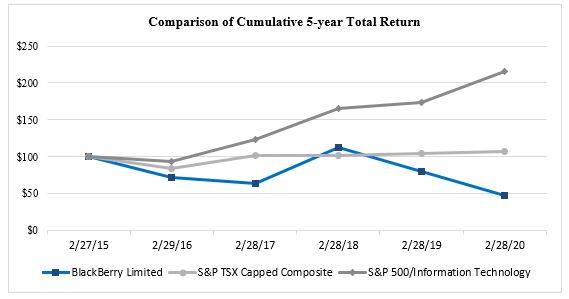
| Base Period | ||||||||||||||||||||||||||||||||||||||
| 2/27/2015 | 2/29/2016 | 2/28/2017 | 2/28/2018 | 2/28/2019 | 2/28/2020 | |||||||||||||||||||||||||||||||||
| BlackBerry Limited | $ | 100 | $ | 72.25 | $ | 64.38 | $ | 112.3 | $ | 80.48 | $ | 47.83 | ||||||||||||||||||||||||||
| S&P TSX Capped Composite | 100 | 84.42 | 101.08 | 101.37 | 105.02 | 106.75 | ||||||||||||||||||||||||||||||||
| S&P 500/Information Technology | 100 | 94.18 | 123.23 | 165.67 | 172.88 | 215.95 | ||||||||||||||||||||||||||||||||
This performance graph shall not be deemed “filed” for purposes of Section 18 of the Securities Exchange Act of 1934 (the “Exchange Act”) or otherwise subject to the liabilities of that section nor shall it be deemed incorporated by reference in any filing under the Securities Act of 1933 or the Exchange Act, regardless of any general incorporation language in such filing.
25
Ownership and Exchange Controls
There is currently no law, governmental decree or regulation in Canada that restricts the export or import of capital, or which would affect the remittance of dividends, interest or other payments by us to non-resident holders of the Company’s common shares, other than withholding tax requirements.
There is currently no limitation imposed by Canadian law or by the Company’s articles or by-laws on the right of non-residents to hold or vote the Company’s common shares, other than those imposed by the Investment Canada Act (Canada) and the Competition Act (Canada). These acts will generally not apply except where a control of an existing Canadian business or company, which has Canadian assets or revenue, or enterprise value (as applicable) over a certain threshold, is acquired and will not apply to trading generally of securities listed on a stock exchange.
Certain Canadian Federal Income Tax Considerations for U.S. Residents
The following is a summary of the principal Canadian federal income tax considerations generally applicable under the Income Tax Act (Canada) (together with the regulations thereto, the “Tax Act”) to a beneficial holder of the Company’s common shares who, for the purposes of the Tax Act and the Canada-United States Income Tax Convention (1980) (the “Treaty”), and at all relevant times, (i) is not and is not deemed to be a resident in Canada, (ii) is a resident of the United States for the purposes of the Treaty and is entitled to the full benefits thereunder, (iii) holds all common shares as capital property, (iv) deals at arm’s length with and is not affiliated with the Company, and (v) does not use or hold and is not deemed to use or hold the common shares in connection with a business carried on in Canada (each such holder, a “U.S. Resident Holder”). This summary is not generally applicable to a U.S. Resident Holder that is: (i) an insurer carrying on an insurance business in Canada and elsewhere, or (ii) an “authorized foreign bank,” each as defined in the Tax Act. Such U.S. Resident Holders should consult their own tax advisors.
Generally, a U.S. Resident Holder’s common shares will be considered to be capital property of a U.S. Resident Holder provided the U.S. Resident Holder does not hold such shares in the course of carrying on a business of trading or dealing in securities and has not acquired them in one or more transactions considered to be an adventure or concern in the nature of trade.
This summary is based upon the current provisions of the Tax Act, the current administrative policies and assessing practices of the Canada Revenue Agency published in writing prior to the date hereof, and the Treaty. This summary takes into account all specific proposals to amend the Tax Act publicly announced by or on behalf of the Minister of Finance (Canada) prior to the date hereof (the “Tax Proposals”), and assumes that all Tax Proposals will be enacted in the form proposed. However, no assurances can be given that the Tax Proposals will be enacted as proposed, or at all. This summary does not otherwise take into account or anticipate any changes in law or administrative policy or assessing practice whether by legislative, administrative or judicial action or decision, nor does it take into account tax legislation or considerations of any province, territory or foreign jurisdiction, which may differ from those discussed herein.
This summary is of a general nature only and is not intended to be, and should not be construed to be, legal, business or tax advice to any particular holder or prospective holder of the Company’s common shares, and no opinion or representation with respect to the tax consequences to any holder or prospective holder of the common shares is made. Accordingly, holders and prospective holders of the Company’s common shares should consult their own tax advisors with respect to the income tax consequences of purchasing, owning and disposing of the common shares in their particular circumstances.
Dividends
Dividends paid or credited, or deemed to be paid or credited, on the Company’s common shares to a U.S. Resident Holder will be subject to Canadian withholding tax at the rate of 25% of the gross amount of the dividends, subject to reduction under the provisions of the Treaty. Under the Treaty, the rate of Canadian withholding tax applicable to a U.S. Resident Holder that is the beneficial owner of dividends is generally reduced to 15% of the gross amount of the dividends, and, if such U.S. Resident Holder is a company that owns at least 10% of the Company’s voting shares at the time of the dividends, the rate of Canadian withholding tax is reduced to 5% of the gross amount of the dividends. U.S. Resident Holders who may be eligible for a reduced rate of withholding tax on dividends pursuant to the Treaty should consult with their own tax advisors with respect to taking all appropriate steps in this regard.
Disposition of Common Shares
A U.S. Resident Holder who disposes or is deemed to dispose of a common share will not be subject to tax under the Tax Act on any capital gain realized on such disposition, unless the common share constitutes “taxable Canadian property,” within the meaning of the Tax Act, of the U.S. Resident Holder at the time of the disposition and the U.S. Resident Holder is not entitled to relief under the Treaty.
Generally, a common share of a particular U.S. Resident Holder will not be “taxable Canadian property” of such U.S. Resident Holder at any time at which such common share is listed on a “designated stock exchange,” within the meaning of the Tax Act (which includes the TSX and NYSE) unless, at any particular time during the 60-month period that ends at that time, both of the
26
following conditions are met concurrently: (a) 25% or more of the issued shares of any class of the capital stock of the Company were owned by or belonged to one or any combination of (i) the U.S. Resident Holder, (ii) persons with whom the U.S. Resident Holder did not deal at arm’s length for purposes of the Tax Act, and (iii) partnerships in which the U.S. Resident Holder or a person described in (ii) holds a membership interest directly or indirectly through one or more partnerships; and (b) more than 50% of the fair market value of the common share was derived, directly or indirectly, from one or any combination of: (i) real or immovable property situated in Canada, (ii) “Canadian resource properties” (as defined in the Tax Act), (iii) “timber resource properties” (as defined in the Tax Act), and (iv) options in respect of, or interests in, or for civil law rights in, property described in any of (b)(i) to (iii), whether or not the property exists. A common share may also be deemed to be “taxable Canadian property” in certain circumstances as set out in the Tax Act. In the case of a U.S. Resident Holder to whom a common share of the Company represents “taxable Canadian property”, under the Treaty, such a U.S. Resident Holder will generally not be subject to tax under the Tax Act on a capital gain realized on the disposition of such share unless the value of such share is derived principally from real property situated in Canada (within the meaning of the Treaty).
In the event that a common share is “taxable Canadian property,” within the meaning of the Tax Act, to a U.S. Resident Holder at the time of disposition, such U.S. Resident Holder should consult its own tax advisor as to the Canadian federal income tax consequences of the disposition.
ITEM 6. SELECTED FINANCIAL DATA
The following table summarizes our selected consolidated financial data for the periods indicated. The selected consolidated financial data should be read in conjunction with our Consolidated Financial Statements and related notes and “Management's Discussion and Analysis of Financial Condition and Results of Operations” appearing elsewhere in this Annual Report on Form sheet data for each of the five fiscal years indicated below has been derived from our audited Consolidated Financial Statements.
| For the Years Ended | ||||||||||||||||||||||||||||||||
| (in millions, except per share data) | ||||||||||||||||||||||||||||||||
| February 29, 2020 | February 28, 2019 | February 28, 2018 | February 28, 2017 | February 29, 2016 | ||||||||||||||||||||||||||||
| Revenue | $ | 1,040 | $ | 904 | $ | 932 | $ | 1,309 | (4) | $ | 2,160 | |||||||||||||||||||||
| Gross margin | 763 | 698 | 670 | 617 | 941 | |||||||||||||||||||||||||||
| Net income (loss) | $ | (152) | (1) | $ | 93 | $ | 405 | (2) | $ | (1,206) | (3) | $ | (208) | |||||||||||||||||||
| Earnings (loss) per share | ||||||||||||||||||||||||||||||||
| Basic earnings (loss) per share | $ | (0.27) | $ | 0.17 | $ | 0.76 | $ | (2.30) | $ | (0.40) | ||||||||||||||||||||||
| Diluted earnings (loss) per share | $ | (0.32) | $ | 0.00 | $ | 0.74 | $ | (2.30) | $ | (0.86) | ||||||||||||||||||||||
______________________________
(1) Fiscal 2020 net loss reflects an increase in operating expense as a result of the Cylance acquisition in fiscal 2019.
(2) Fiscal 2018 net income includes arbitration awards and settlements, net of $685 million.
(3) Fiscal 2017 net loss includes impairment of goodwill and long-live assets of $57 million and $501 million, respectively.
(4) Fiscal 2017 revenue reflects the Company’s transition from a hardware company to a software and services company.
Balance Sheet Data
| As at | ||||||||||||||||||||||||||||||||
| (in millions) | ||||||||||||||||||||||||||||||||
| February 29, 2020 | February 28, 2019 | February 28, 2018 | February 28, 2017 | February 29, 2016 | ||||||||||||||||||||||||||||
| Cash, cash equivalents, and investments | $ | 990 | $ | 1,005 | (2) | $ | 2,353 | (3) | $ | 1,698 | $ | 2,624 | ||||||||||||||||||||
| Total assets | $ | 3,888 | $ | 3,968 | $ | 3,780 | $ | 3,296 | (4) | $ | 5,534 | |||||||||||||||||||||
| Total long-term liabilities | $ | 238 | (1) | $ | 822 | $ | 864 | $ | 618 | $ | 1,287 | (5) | ||||||||||||||||||||
______________________________
(1) Fiscal 2020 long-term liabilities reflects the impact of the debenture being a short-term liability.
(2) Fiscal 2019 cash, cash equivalent and investments reflects the acquisition of Cylance in the fourth quarter of fiscal 2019.
(3) Fiscal 2018 cash, cash equivalent and investments reflects the arbitration awards and settlements, net of $685 million
(4) Fiscal 2017 total assets reflects the impact of the goodwill and long-lived asset impairment.
(5) Fiscal 2017 long-term liabilities reflects the redemption of $1.25 billion of 6% convertible debenture and issuance of $605 million of 3.75% debentures.
27
ITEM 7. MANAGEMENT’S DISCUSSION AND ANALYSIS OF FINANCIAL CONDITION AND RESULTS OF OPERATIONS
The following Management’s Discussion and Analysis of Financial Condition and Results of Operations (“MD&A”) should be read together with the audited consolidated financial statements and the accompanying notes (the “Consolidated Financial Statements”) of BlackBerry Limited, for the fiscal year ended February 29, 2020. The Consolidated Financial Statements are presented in U.S. dollars and have been prepared in accordance with U.S. GAAP. All financial information in this MD&A is presented in U.S. dollars, unless otherwise indicated.
Readers should carefully review Part I, Item 1A “Risk Factors” and other documents filed from time to time with the Securities and Exchange Commission (“SEC”) and other securities regulators. A number of factors may materially affect our business, financial condition, operating results and prospects. These factors include but are not limited to those set forth in Part I, Item 1A “Risk Factors” and elsewhere in this Annual Report on Form 10-K. Any one of these factors, and other factors that we are unaware of, or currently deem immaterial, may cause our actual results to differ materially from recent results or from our anticipated future results. Please refer to our MD&A of our Annual Report on Form 40-F for Fiscal 2019 for a comparative discussion of our Fiscal 2019 financial results as compared to our Fiscal 2018. Additional information about the Company, which is included in the Company’s Annual Report on Form 10-K for the fiscal year ended February 29, 2020 (the “Annual Report”), can be found on SEDAR at www.sedar.com and on the SEC’s website at www.sec.gov.
Cautionary Note Regarding Forward-Looking Statements
This MD&A contains forward-looking statements within the meaning of certain securities laws, including under the U.S. Private Securities Litigation Reform Act of 1995 and applicable Canadian securities laws, including statements relating to:
•the Company’s plans, strategies and objectives, including its intentions to achieve long-term profitable revenue growth and increase and enhance its product and service offerings;
•the Company’s expectations with respect to its financial performance in fiscal 2021;
•the Company’s estimates of purchase obligations and other contractual commitments; and
•the Company’s expectations with respect to the sufficiency of its financial resources.
The words “expect”, “anticipate”, “estimate”, “may”, “will”, “should”, “could”, “intend”, “believe”, “target”, “plan” and similar expressions are intended to identify forward-looking statements in this MD&A, including in the sections entitled “Results of Operations - Fiscal year ended February 29, 2020 compared to fiscal year ended February 28, 2019 - Revenue - Revenue by Product and Service”, “Results of Operations - Three months ended February 29, 2020 compared to the three months ended February 28, 2019 - Net Income”, and “Financial Condition - Debenture Financing and Other Funding Sources ”. Forward-looking statements are based on estimates and assumptions made by the Company in light of its experience and its perception of historical trends, current conditions and expected future developments, as well as other factors that the Company believes are appropriate in the circumstances, including but not limited to, the Company’s expectations regarding its business, strategy, opportunities and prospects, the launch of new products and services, general economic conditions, competition, and the Company’s expectations regarding its financial performance. Many factors could cause the Company’s actual results, performance or achievements to differ materially from those expressed or implied by the forward-looking statements, including, without limitation, the risk factors discussed in Part I, Item 1A “Risk Factors” in the Annual Report on Form 10-K.
All of these factors should be considered carefully, and readers should not place undue reliance on the Company’s forward-looking statements. Any statements that are forward-looking statements are intended to enable the Company’s shareholders to view the anticipated performance and prospects of the Company from management’s perspective at the time such statements are made, and they are subject to the risks that are inherent in all forward-looking statements, as described above, as well as difficulties in forecasting the Company’s financial results and performance for future periods, particularly over longer periods, given changes in technology and the Company’s business strategy, evolving industry standards, intense competition and short product life cycles that characterize the industries in which the Company operates. See “Strategy” subsection in Part I, Item 1 “Business” of the Annual Report.
The Company has no intention and undertakes no obligation to update or revise any forward-looking statements, whether as a result of new information, future events or otherwise, except as required by applicable law.
Business Overview
The Company provides intelligent security software and services to enterprises and governments around the world. The Company secures more than 500 million endpoints, including 150 million cars. Based in Waterloo, Ontario, the Company leverages artificial intelligence and machine learning to deliver innovative solutions in the areas of cybersecurity, safety and data privacy solutions, and is a leader in the areas of endpoint security management, encryption, and embedded systems. The
28
Company’s common shares trade under the ticker symbol “BB” on the New York Stock Exchange and the Toronto Stock Exchange. The Company was incorporated under the Business Corporations Act (Ontario) (“OBCA”) on March 7, 1984.
The Company continued to execute on its strategy in fiscal 2020. The Company also announced the following achievements:
•Announced that the German Development Agency, Deutsche Gesellschaft für Internationale Zusammenarbeit (GIZ) GmbH, selected BlackBerry AtHoc as its emergency mass notification system;
•Launched enhancements and feature updates to SecuSUITE for Government and BlackBerry AtHoc that enable government agencies to securely communicate and safeguard sensitive data;
•Announced the appointment of Marjorie Dickman as the Company’s first Chief Government Affairs and Public Policy Officer;
•Announced product enhancements to CylancePROTECT and CylanceOPTICS;
•Launched the BlackBerry Spark platform with a new unified endpoint security (UES) layer which can work with BlackBerry UEM to deliver zero trust security;
•Released the 2020 Threat Report, which examines the latest adversarial techniques and tactics analyzed by BlackBerry Cylance threat researchers and provides guidance organizations can leverage to mitigate risk;
•Launched BlackBerry Digital Workplace, a robust workspace that provides secure online and offline access to corporate on-premise or cloud content including Microsoft Office 365 resources;
•Announced that the BlackBerry Radar solution integrates with Trimble’s TMW.Suite and TruckMate transportation management system solutions;
•Announced that BlackBerry Cylance integrates with SafeBreach to help organizations improve their overall security posture with continuous enterprise endpoint security validation;
•Entered into a collaboration with Ansys to support BlackBerry QNX’s industry-leading real-time operating system (“RTOS”) for connected and autonomous vehicles;
•Collaborated with Amazon Web Services, Inc. (AWS) to demonstrate a connected vehicle software platform for in-vehicle applications that combines the BlackBerry QNX RTOS with AWS’ IoT Services in the cloud and in the car;
•Announced that Damon Motorcycles’ CoPilot advanced warning system will be powered by BlackBerry QNX technology across its entire line-up of advanced electric motorcycles;
•Announced that Renovo and BlackBerry QNX will cooperate to jointly develop and market safety-critical data management solutions for use in the next generation of connected and autonomous vehicles;
•Entered into a partnership that will provide advanced digital infrastructure to students as part of the Government of Romania’s National Wireless Campus Project;
•Entered into an agreement with electric carmaker WM Motor to embed BlackBerry’s QNX Neutrino Realtime Operating System and other BlackBerry QNX software products within the company’s third-generation SUVs;
•Entered into a strategic collaboration to integrate the QNX Platform for Digital Cockpits in MARELLI Electronics China’s eCockpit and Digital Cluster solution;
•Announced the second cohort of companies for the Company’s joint accelerator program with L-SPARK to advance Canadian startups that are focused on connected vehicle technologies;
•Announced that its QNX Hypervisor 2.0 for Safety has been recognized as ISO 26262 ASIL D compliant by the independent auditors at TÜV Rheinland, making it the world’s first ASIL D safety-certified commercial hypervisor;
•Announced that Reece Group has deployed BlackBerry Cylance technology to protect thousands of endpoints across its retail stores and offices in Australia and the United States;
•Entered into an agreement with Canadian Pacific Railway to deploy BlackBerry Radar across 2,000 of its domestic intermodal chassis;
•Entered into an agreement for BlackBerry QNX technology to power Arrival’s Generation 2.0 autonomous-ready commercial electric vehicles;
•Announced an agreement with ETAS GmbH, a subsidiary of Bosch, to cooperate on the joint development and marketing of an automotive software platform based on the AUTOSAR Adaptive standard;
•Announced that Hyundai Autron selected BlackBerry QNX technology to power its next-generation advanced driver-assistance systems (ADAS) and autonomous driving software platform;
•Launched BlackBerry AtHoc & BlackBerry SecuSUITE solutions on AWS;
•Launched CylancePROTECT for mobile devices managed by BlackBerry UEM;
•Announced the promotion of John McClurg to the role of Chief Information Security Officer and Christopher Hummel to the role of Chief Information Officer;
•Announced the integration of CylancePROTECT and CylanceOPTICS with Chronicle’s Backstory security analytics platform;
•Launched BlackBerry Solutions on the Microsoft Azure Marketplace;
•Launched the BlackBerry Advanced Technology Development Labs to develop cutting-edge security innovations;
•Announced the transition of Steve Capelli to the role of Chief Revenue Officer and the promotion of Steve Rai to the role of Chief Financial Officer;
29
•Entered into an agreement with Matson Logistics to deploy the BlackBerry Radar-M solution across its entire fleet of domestic intermodal containers;
•Announced, along with DENSO Corporation, that the first integrated Human Machine Interface digital cockpit system with BlackBerry QNX technology has shipped in SUBARU vehicles;
•Launched the BlackBerry QNX Acoustics Management Platform 3.0, the latest version of its automotive acoustics software;
•Announced a deeper partnership with Jaguar Land Rover for the use of the Company’s AI and machine learning technologies, BlackBerry QNX software and BlackBerry Cybersecurity Consulting services in the development of the automaker’s next-generation vehicles;
•Appointed Lisa Disbrow to the Company’s Board of Directors (the “Board”) and to the audit and risk management committee of the Board;
•Named as a Leader in Gartner’s 2019 Magic Quadrant for Unified Endpoint Management Tools for the fourth consecutive year;
•Launched BlackBerry Intelligent Security, the first cloud-based solution that leverages the power of adaptive security, continuous authentication and artificial intelligence to enhance mobile endpoint security in zero trust environments;
•Entered into an agreement with SYNNEX Corporation to distribute the BlackBerry Enterprise Mobility Suite in the United States and accelerate partner recruitment for the BlackBerry Enterprise Partner Program;
•Introduced CylanceGUARD, a managed detection and response solution that leverages BlackBerry Cylance security experts and its industry-leading native AI platform to provide continuous threat hunting and monitoring;
•Entered into a collaborative supply agreement expanding the Company’s partnership with LG Electronics Inc. to accelerate the deployment of connected and autonomous vehicle technology for automotive OEMs and Tier 1 vendors;
•Announced that BlackBerry QNX Software is embedded in more than 150 million vehicles;
•Achieved Federal Risk and Authorization Management Program (“FedRAMP”) Ready status for the BlackBerry Government Mobility Suite, a cloud-based endpoint management solution developed specifically for U.S. government agencies;
•Announced support of Canada’s Digital Charter, aimed at protecting the privacy and data security of Canadians, and that the Company has been recognized by the Government of Canada as a benchmark for trusted technology;
•Announced that Forrester found that BlackBerry Cylance’s AI-driven endpoint security products delivered a 99 percent return on investment;
•Announced that BlackBerry Cylance has completed an Australian Information Security Registered Assessors Program (IRAP) assessment to obtain certification as a security solutions provider to Australian federal government agencies;
•With WITTENSTEIN high integrity systems, announced a new embedded software platform that enables the development of safety-certified and mission-critical applications on heterogenous system-on-chip processors;
•Launched BlackBerry Radar H2, a new intelligent, data-driven asset monitoring device that can help automate operations, improve utilization of trailers, containers, chassis and other remote assets, as well as ensure assets are safe and secure;
•Established BlackBerry Government Solutions, to accelerate the Company’s FedRAMP initiatives and deepen ties with U.S. federal agencies;
•BlackBerry Limited announced that the NATO Communications and Information (NCI) Agency has awarded a contract for BlackBerry’s SecuSUITE® for Government to encrypt the conversations of its technology and cyber leaders;
•Announced that Verizon added BlackBerry Cylance’s AI-driven antivirus security solutions to its Managed Security Services portfolio; and
•Introduced CylancePERSONA, the first proactive endpoint behavioral analytics solution.
30
Fiscal 2020 Summary Results of Operations
The following table sets forth certain consolidated statements of operations data, as well as certain consolidated balance sheet data, as at and for the fiscal years ended February 29, 2020, February 28, 2019, and February 28, 2018:
As at and for the Fiscal Years Ended (in millions, except for share and per share amounts) | |||||||||||||||||||||||||||||
| February 29, 2020 | February 28, 2019 | Change | February 28, 2018 | Change | |||||||||||||||||||||||||
| Revenue | $ | 1,040 | $ | 904 | $ | 136 | $ | 932 | $ | (28) | |||||||||||||||||||
| Gross margin | 763 | 698 | 65 | 670 | 28 | ||||||||||||||||||||||||
| Operating expenses | 912 | 638 | 274 | 387 | 251 | ||||||||||||||||||||||||
| Investment income (loss), net | 1 | 17 | (16) | 123 | (106) | ||||||||||||||||||||||||
| Income (loss) before income taxes | (148) | 77 | (225) | 406 | (329) | ||||||||||||||||||||||||
| Provision for (recovery of) income taxes | 4 | (16) | 20 | 1 | (17) | ||||||||||||||||||||||||
| Net income (loss) | $ | (152) | $ | 93 | $ | (245) | $ | 405 | $ | (312) | |||||||||||||||||||
| Earnings (loss) per share - reported | |||||||||||||||||||||||||||||
| Basic | $ | (0.27) | $ | 0.17 | $ | 0.76 | |||||||||||||||||||||||
| Diluted | $ | (0.32) | $ | 0.00 | $ | 0.74 | |||||||||||||||||||||||
| Weighted-average number of shares outstanding (000’s) | |||||||||||||||||||||||||||||
| Basic | 553,861 | 540,477 | 532,888 | ||||||||||||||||||||||||||
Diluted (1) | 614,361 | 616,467 | 545,886 | ||||||||||||||||||||||||||
| Total assets | $ | 3,888 | $ | 3,968 | $ | (80) | $ | 3,801 | $ | 167 | |||||||||||||||||||
| Total long-term financial liabilities | $ | — | $ | 665 | $ | (665) | $ | 782 | $ | (117) | |||||||||||||||||||
______________________________
(1)Diluted earnings (loss) per share on a U.S. GAAP basis for fiscal 2018 does not include the dilutive effect of the Debentures as to do so would be anti-dilutive. Diluted loss per share on a U.S. GAAP basis for fiscal 2020 does not include the dilutive effect of stock-based compensation as to do so would be anti-dilutive. See Note 9 to the Consolidated Financial Statements for the fiscal year ended February 29, 2020 for calculation of the diluted weighted average number of shares outstanding.
Financial Highlights
The Company had approximately $990 million in cash, cash equivalents and investments as of February 29, 2020.
In fiscal 2020, the Company recognized revenue of $1.04 billion and incurred a net loss of $152 million, or $0.27 basic loss per share on a U.S. GAAP basis. The Company incurred a diluted loss per share of $0.32 on a U.S. GAAP basis.
The Company recognized adjusted revenue of $1.10 billion and adjusted net income of $74 million, or adjusted earnings of $0.13 per share, on a non-GAAP basis in fiscal 2020. See “Non-GAAP Financial Measures” below.
Debentures Fair Value Adjustment
As previously disclosed, the Company elected the fair value option to account for the 3.75% unsecured convertible debentures (the “Debentures”); therefore, periodic revaluation has been and continues to be required under U.S. GAAP. The fair value adjustment does not impact the terms of the Debentures such as the face value, the redemption features or the conversion price.
In fiscal 2020, the fair value of the Debentures decreased by approximately $59 million. For the three months ended February 29, 2020, the Company recorded non-cash income relating to changes in fair value from instrument specific credit risk of $7 million in AOCI and a non-cash charge relating to changes in fair value from non-credit components of $5 million (pre-tax and after tax) (the “Q4 Fiscal 2020 Debentures Fair Value Adjustment”) in the Company’s consolidated statements of operations. In fiscal 2020, the Company recorded a non-cash charge relating to changes in fair value from instrument-specific credit risk of $7 million in AOCI and non-cash income relating to changes in fair value from non-credit components of $66 million (pre-tax and after tax) (the “Fiscal 2020 Debentures Fair Value Adjustment”) in the Company’s consolidated statements of operations.
31
Non-GAAP Financial Measures
The Consolidated Financial Statements have been prepared in accordance with U.S. GAAP, and information contained in this MD&A is presented on that basis. On March 31, 2020, the Company announced financial results for the three months and fiscal year ended February 29, 2020, which included certain non-GAAP financial measures, including adjusted revenue, adjusted gross margin (before taxes), adjusted gross margin percentage (before taxes), adjusted operating expense, adjusted operating income, adjusted EBITDA, adjusted operating income margin percentage, adjusted EBITDA margin percentage, adjusted net income (loss), adjusted income (loss) per share, adjusted research and development expense, adjusted selling, marketing and administrative expense, adjusted amortization expense and free cash flow.
In the Company’s internal reports, management evaluates the performance of the Company’s business on a non-GAAP basis by excluding the impact of the items below from the Company’s financial results. The Company believes that excluding the below items provides readers of the Company’s financial statements with a more consistent basis for comparison across accounting periods and is more useful in helping readers understand the Company’s operating results and underlying operational trends.
•Debenture fair value adjustment. The Company has elected to measure its outstanding Debenture at fair value in accordance with the fair value option under U.S. GAAP. Each period, the fair value of the Debentures is recalculated and resulting non-cash gains and losses from the change in fair value from non-credit components of the Debentures are recognized in income. The amount can vary each period depending on changes to the Company’s share price. This is not indicative of the Company’s core operating performance, and is not meaningful in comparison to the Company’s past operating performance.
•Restructuring charges. The Company believes that restructuring costs relating to employee termination benefits, facilities, and manufacturing network simplification efforts pursuant to the Resource Allocation Program (“RAP”) entered into in order to transition the Company from a legacy hardware manufacturer to a licensing driven software business do not reflect expected future operating expenses, are not indicative of the Company’s core operating performance, and are not meaningful in comparison to the Company’s past operating performance.
•Software deferred revenue acquired. The Company has acquired businesses whose net assets include deferred revenue. In accordance with U.S. GAAP reporting requirements, the Company recorded write-downs of deferred revenue under arrangements pre-dating each acquisition to fair value, which resulted in lower recognized revenue than the original transaction price until the related service obligations under such arrangements are fulfilled. Therefore, U.S. GAAP revenues after the acquisitions will not reflect the full amount of revenue that would have been reported if the acquired deferred revenue was not written down to fair value, prior to the renewal of these arrangements. The Company believes that reversing the acquisition-related deferred revenue write-downs (so that the full amount of revenue booked by the acquired businesses is included) provides a more appropriate representation of revenue in a given period and, therefore, provides readers of the Company’s financial statements with a more consistent basis for comparison across accounting periods. The Company also believes that the adjustment is more useful in helping readers to understand the Company’s operating results and underlying operational trends, especially in future periods when the contracts underlying the acquired deferred revenue are renewed at amounts more consistent with their transaction price. As the impacted contracts renew over time, the associated reversal of the acquisition write-downs will trend to zero.
•Software deferred commission expense acquired. The Company has acquired businesses whose net assets include deferred commissions. In accordance with U.S. GAAP reporting requirements, the Company recorded write-downs of deferred commissions under arrangements pre-dating each acquisition to fair value, which in most cases is nil. Therefore, U.S. GAAP commission expense after the acquisitions will not reflect commission expense that would have been reported if the acquired deferred commissions were not written down to fair value. The Company believes that reversing the acquisition-related deferred commission write-downs (so that the full amount of commission expense is included) provides a more appropriate representation of commission expense in a given period and, therefore, provides readers of the Company’s financial statements with a more consistent basis for comparison across accounting periods. The Company also believes that the adjustment is more useful in helping readers to understand the Company’s operating results and underlying operational trends, especially in future periods when the Company recognizes commissions on the renewals of the contracts underlying the acquired deferred commissions. As the impacted contracts renew over time, the associated reversal of the acquisition write-downs will trend to zero.
•Stock compensation expenses. Equity compensation is a non-cash expense and does not impact the ongoing operating decisions taken by the Company’s management.
•Amortization of acquired intangible assets. When the Company acquires intangible assets through business combinations, the assets are recorded as part of purchase accounting and contribute to revenue generation. Such acquired intangible assets depreciate over time and the related amortization will recur in future periods until the assets have been fully amortized. This is not indicative of the Company’s core operating performance, and is not meaningful in comparison to the Company’s past operating performance.
32
•Business acquisition and integration costs. The Company incurs costs associated with business acquisitions, including legal costs, audit and accounting fees, and other acquisition and integration expenses. These expenditures do not relate to the ongoing operation of the business and they tend to vary significantly based on the circumstances of each transaction. This is not indicative of the Company’s core operating performance, and is not meaningful in comparison to the Company’s past operating performance.
•Acquisition valuation allowance. The Company records an income tax valuation allowance associated with business acquisitions. This is not indicative of the Company’s core operating performance, and is not meaningful in comparison to the Company’s past operating performance.
•Arbitration awards and settlements, net. The Company believes that arbitration awards and settlements, net related to the Qualcomm Technologies, Inc., Nokia Corporation and Panasonic Corporation arbitration and settlements are unusual items related to legacy operations which are not reflective of the Company’s ongoing operating expense or core operating performance and are not meaningful in comparison to the Company’s past and future operating performance.
•Long-lived asset impairment charge. The Company believes that long-lived asset impairment charges do not reflect expected future operating expenses, are not indicative of the Company’s core operating performance, and are not meaningful in comparison to the Company’s past operating performance.
•Goodwill impairment charge. The Company believes that goodwill impairment charge does not reflect expected future operating expenses, is not indicative of the Company’s core operating performance as it is associated with a legacy line of business, and is not meaningful in comparison to the Company’s past operating performance.
On a U.S. GAAP basis, the impact of these items is reflected in the Company’s income statement. However, the Company believes that the provision of supplemental non-GAAP measures allow investors to evaluate the financial performance of the Company’s business using the same evaluation measures that management uses, and is therefore a useful indication of the Company’s performance or expected performance of future operations and facilitates period-to-period comparison of operating performance. As a result, the Company considers it appropriate and reasonable to provide, in addition to U.S. GAAP measures, supplementary non-GAAP financial measures that exclude certain items from the presentation of its financial results.
Reconciliation of non-GAAP based measures with most directly comparable GAAP based measures for the three months ended February 29, 2020, February 28, 2019 and February 28, 2018
Readers are cautioned that adjusted revenue, adjusted gross margin (before taxes), adjusted gross margin percentage (before taxes), adjusted operating expense, adjusted operating income, adjusted EBITDA, adjusted operating income margin percentage, adjusted EBITDA margin percentage, adjusted net income (loss), adjusted income (loss) per share, adjusted research and development expense, adjusted selling, marketing and administrative expense, adjusted amortization expense and free cash flow and similar measures do not have any standardized meaning prescribed by U.S. GAAP and are therefore unlikely to be comparable to similarly titled measures reported by other companies. These non-GAAP financial measures should be considered in the context of the U.S. GAAP results, which are described in this MD&A and presented in our Consolidated Financial Statements.
33
A reconciliation of the most directly comparable U.S. GAAP financial measures for the three months ended February 29, 2020, February 28, 2019 and February 28, 2018 to adjusted financial measures is reflected in the tables below:
| For the Three Months Ended (in millions) | February 29, 2020 | February 28, 2019 | February 28, 2018 | |||||||||||||||||
| Revenue | $ | 282 | $ | 255 | $ | 233 | ||||||||||||||
Software deferred revenue acquired (1) | 9 | 2 | 6 | |||||||||||||||||
| Adjusted revenue | $ | 291 | $ | 257 | $ | 239 | ||||||||||||||
| Gross margin (before taxes) | $ | 212 | $ | 206 | $ | 177 | ||||||||||||||
Software deferred revenue acquired (1) | 9 | 2 | 6 | |||||||||||||||||
| Restructuring charges | — | 1 | 3 | |||||||||||||||||
| Stock compensation expense | 2 | 1 | 1 | |||||||||||||||||
| Adjusted gross margin (before taxes) | $ | 223 | $ | 210 | $ | 187 | ||||||||||||||
| Gross margin % (before taxes) | 75.2 | % | 80.8 | % | 76.0 | % | ||||||||||||||
Software deferred revenue acquired (1) | 0.7 | % | 0.1 | % | 0.5 | % | ||||||||||||||
| Restructuring charges | — | % | 0.4 | % | 1.4 | % | ||||||||||||||
| Stock compensation expense | 0.7 | % | 0.4 | % | 0.3 | % | ||||||||||||||
| Adjusted gross margin % (before taxes) | 76.6 | % | 81.7 | % | 78.2 | % | ||||||||||||||
______________________________
(1) See Reconciliation of U.S. GAAP IoT and BlackBerry Cylance revenue to adjusted IoT and BlackBerry Cylance revenue
Reconciliation of operating expense for the three months ended February 29, 2020, November 30, 2019, February 28, 2019 and February 28, 2018 to adjusted operating expense is reflected in the tables below:
| For the Three Months Ended (in millions) | February 29, 2020 | November 30, 2019 | February 28, 2019 | February 28, 2018 | ||||||||||||||||||||||
| Operating expense | $ | 253 | $ | 227 | $ | 178 | $ | 194 | ||||||||||||||||||
| Restructuring charges | 1 | 4 | 2 | 23 | ||||||||||||||||||||||
| Stock compensation expense | 15 | 14 | 13 | 12 | ||||||||||||||||||||||
Debenture fair value adjustment (1) | 5 | (20) | (6) | (34) | ||||||||||||||||||||||
| Software deferred commission expense acquired | (3) | (4) | — | — | ||||||||||||||||||||||
| Acquired intangibles amortization | 35 | 35 | 18 | 22 | ||||||||||||||||||||||
| Business acquisition and integration costs | 1 | — | 8 | — | ||||||||||||||||||||||
| Goodwill impairment charge | 22 | — | — | — | ||||||||||||||||||||||
| LLA impairment charge | 5 | 3 | — | — | ||||||||||||||||||||||
| Arbitration awards and settlements, net | — | — | (9) | (1) | ||||||||||||||||||||||
| Adjusted operating expense | $ | 172 | $ | 195 | $ | 152 | $ | 172 | ||||||||||||||||||
______________________________
(1) See “Fiscal 2020 Summary Results of Operations - Financial Highlights - Debentures Fair Value Adjustment”
34
Reconciliation of GAAP net income (loss) and GAAP basic earnings per share for the three months ended February 29, 2020, February 28, 2019 and February 28, 2018 to adjusted net income and adjusted basic earnings per share is reflected in the tables below:
| For the Three Months Ended (in millions, except per share amounts) | February 29, 2020 | February 28, 2019 | February 28, 2018 | |||||||||||||||||||||||||||||||||||
| Basic earnings per share | Basic earnings per share | Basic earnings per share | ||||||||||||||||||||||||||||||||||||
| Net income (loss) | $ | (41) | $(0.07) | $ | 51 | $0.09 | $ | (10) | $(0.02) | |||||||||||||||||||||||||||||
| Software deferred revenue acquired | 9 | 2 | 6 | |||||||||||||||||||||||||||||||||||
| Restructuring charges | 1 | 3 | 26 | |||||||||||||||||||||||||||||||||||
| Stock compensation expense | 17 | 14 | 13 | |||||||||||||||||||||||||||||||||||
| Debenture fair value adjustment | 5 | (6) | (34) | |||||||||||||||||||||||||||||||||||
| Software deferred commission expense acquired | (3) | — | — | |||||||||||||||||||||||||||||||||||
| Acquired intangibles amortization | 35 | 18 | 22 | |||||||||||||||||||||||||||||||||||
| Business acquisition and integration costs | 1 | 8 | — | |||||||||||||||||||||||||||||||||||
| Goodwill impairment charge | 22 | — | — | |||||||||||||||||||||||||||||||||||
| LLA impairment charge | 5 | — | — | |||||||||||||||||||||||||||||||||||
| Arbitration awards and settlements, net | — | (9) | (1) | |||||||||||||||||||||||||||||||||||
| Acquisition valuation allowance | — | (21) | — | |||||||||||||||||||||||||||||||||||
| Adjusted net income | $ | 51 | $0.09 | $ | 60 | $0.11 | $ | 22 | $0.05 | |||||||||||||||||||||||||||||
Reconciliation of U.S GAAP IoT, BlackBerry Cylance and software and services revenue for the three months ended February 29, 2020, February 28, 2019 and February 28, 2018 to adjusted IoT, BlackBerry Cylance and software and services revenue is reflected in the tables below:
| For the Three Months Ended (in millions) | February 29, 2020 | February 28, 2019 | February 28, 2018 | |||||||||||||||||
| IoT Revenue | $ | 127 | $ | 144 | $ | 154 | ||||||||||||||
| Software deferred revenue acquired | — | 1 | 6 | |||||||||||||||||
| Adjusted IoT revenue | $ | 127 | $ | 145 | $ | 160 | ||||||||||||||
| BlackBerry Cylance Revenue | $ | 43 | $ | 3 | $ | — | ||||||||||||||
| Software deferred revenue acquired | 9 | 1 | — | |||||||||||||||||
| Adjusted BlackBerry Cylance Revenue | $ | 52 | $ | 4 | $ | — | ||||||||||||||
| Software and Services revenue | ||||||||||||||||||||
| Revenue | $ | 282 | $ | 255 | $ | 233 | ||||||||||||||
| Less: Other revenue | 4 | 9 | 21 | |||||||||||||||||
| Software and Services revenue | $ | 278 | $ | 246 | $ | 212 | ||||||||||||||
| Software deferred revenue acquired | 9 | 2 | 6 | |||||||||||||||||
| Adjusted Software and Services revenue | $ | 287 | $ | 248 | $ | 218 | ||||||||||||||
35
Reconciliation of U.S GAAP research and development, selling, marketing and administration, and amortization expense for the three months ended February 29, 2020, February 28, 2019 and February 28, 2018 to adjusted research and development, selling, marketing and administration, and amortization expense is reflected in the tables below:
| For the Three Months Ended (in millions) | February 29, 2020 | February 28, 2019 | February 28, 2018 | |||||||||||||||||
| Research and development | $ | 60 | $ | 52 | $ | 58 | ||||||||||||||
| Stock compensation expense | 3 | 3 | 3 | |||||||||||||||||
| Adjusted research and development | $ | 57 | $ | 49 | $ | 55 | ||||||||||||||
| Selling, marketing and administration | $ | 113 | $ | 110 | $ | 131 | ||||||||||||||
| Restructuring charges | 1 | 2 | 23 | |||||||||||||||||
| Software deferred commission expense acquired | (3) | — | — | |||||||||||||||||
| Stock compensation expense | 12 | 10 | 9 | |||||||||||||||||
| Business acquisition and integration costs | 1 | 8 | — | |||||||||||||||||
| Adjusted selling, marketing and administration | $ | 102 | $ | 90 | $ | 99 | ||||||||||||||
| Amortization | $ | 48 | $ | 31 | $ | 37 | ||||||||||||||
| Acquired intangibles amortization | 35 | 18 | 22 | |||||||||||||||||
| Adjusted amortization | $ | 13 | $ | 13 | $ | 15 | ||||||||||||||
36
Reconciliation of selected GAAP-based measures to non-GAAP based measures for the years ended February 29, 2020, February 28, 2019 and February 28, 2018
A reconciliation of the most directly comparable U.S. GAAP financial measures for the years ended February 29, 2020, February 28, 2019 and February 28, 2018 to adjusted financial measures is reflected in the tables below:
| For the Fiscal Years Ended (in millions) | February 29, 2020 | February 28, 2019 | February 28, 2018 | |||||||||||||||||
| Revenue | $ | 1,040 | $ | 904 | $ | 932 | ||||||||||||||
Software deferred revenue acquired (1) | 59 | 12 | 35 | |||||||||||||||||
| Adjusted revenue | $ | 1,099 | $ | 916 | $ | 967 | ||||||||||||||
| Gross margin (before taxes) | $ | 763 | $ | 698 | $ | 670 | ||||||||||||||
Software deferred revenue acquired (1) | 59 | 12 | 35 | |||||||||||||||||
| Restructuring charges | 5 | 2 | 11 | |||||||||||||||||
| Stock compensation expense | 5 | 4 | 4 | |||||||||||||||||
| Adjusted gross margin (before taxes) | $ | 832 | $ | 716 | $ | 720 | ||||||||||||||
| Gross margin % (before taxes) | 73.4 | % | 77.2 | % | 71.9 | % | ||||||||||||||
Software deferred revenue acquired (1) | 1.4 | % | 0.3 | % | 0.9 | % | ||||||||||||||
| Restructuring charges | 0.5 | % | 0.2 | % | 1.2 | % | ||||||||||||||
| Stock compensation expense | 0.4 | % | 0.5 | % | 0.5 | % | ||||||||||||||
| Adjusted gross margin % (before taxes) | 75.7 | % | 78.2 | % | 74.5 | % | ||||||||||||||
| Operating expense | $ | 912 | $ | 638 | $ | 387 | ||||||||||||||
| Restructuring charges | 5 | 9 | 67 | |||||||||||||||||
| Stock compensation expense | 58 | 64 | 45 | |||||||||||||||||
Debenture fair value adjustment (2) | (66) | (117) | 191 | |||||||||||||||||
| Software deferred commission expense acquired | (16) | — | — | |||||||||||||||||
| Acquired intangibles amortization | 141 | 82 | 95 | |||||||||||||||||
| Business acquisition and integration costs | 4 | 12 | 14 | |||||||||||||||||
| Goodwill impairment charge | 22 | — | — | |||||||||||||||||
| LLA impairment charge | 10 | — | 11 | |||||||||||||||||
| Arbitration awards and settlements, net | — | (9) | (683) | |||||||||||||||||
| Adjusted operating expense | $ | 754 | $ | 597 | $ | 647 | ||||||||||||||
______________________________
(1) See Reconciliation of U.S GAAP IoT and BlackBerry Cylance revenue to adjusted IoT and BlackBerry Cylance revenue
(2) See “Fiscal 2020 Summary Results of Operations - Financial Highlights - Debentures Fair Value Adjustment”
37
Reconciliation of GAAP net income (loss) and GAAP basic earnings per share for the years ended February 29, 2020, February 28, 2019 and February 28, 2018 to the adjusted net income and adjusted basic earnings per share is reflected in the tables below:
| For the Fiscal Years Ended (in millions, except per share amounts) | February 29, 2020 | February 28, 2019 | February 28, 2018 | |||||||||||||||||||||||||||||||||||
| Basic earnings per share | Basic earnings per share | Basic earnings per share | ||||||||||||||||||||||||||||||||||||
| Net income (loss) | $ | (152) | $ | (0.27) | $ | 93 | $ | 0.17 | $ | 405 | $ | 0.76 | ||||||||||||||||||||||||||
| Software deferred revenue acquired | 59 | 12 | 35 | |||||||||||||||||||||||||||||||||||
| Restructuring charges | 10 | 11 | 78 | |||||||||||||||||||||||||||||||||||
| Stock compensation expense | 63 | 68 | 49 | |||||||||||||||||||||||||||||||||||
| Debenture fair value adjustment | (66) | (117) | 191 | |||||||||||||||||||||||||||||||||||
| Software deferred commission expense acquired | (16) | — | — | |||||||||||||||||||||||||||||||||||
| Acquired intangibles amortization | 141 | 82 | 95 | |||||||||||||||||||||||||||||||||||
| Business acquisition and integration costs | 4 | 12 | 14 | |||||||||||||||||||||||||||||||||||
| Goodwill impairment charge | 22 | — | — | |||||||||||||||||||||||||||||||||||
| LLA impairment charge | 10 | — | 11 | |||||||||||||||||||||||||||||||||||
| Arbitration awards and settlements, net | — | (9) | (806) | |||||||||||||||||||||||||||||||||||
| Acquisition valuation allowance | (1) | (21) | — | |||||||||||||||||||||||||||||||||||
| Adjusted net income | $ | 74 | $0.13 | $ | 131 | $0.24 | $ | 72 | $0.14 | |||||||||||||||||||||||||||||
Reconciliation of U.S GAAP IoT, BlackBerry Cylance and software and services revenue for the years ended February 29, 2020, February 28, 2019 and February 28, 2018 to adjusted IoT, BlackBerry Cylance and software and services revenue is reflected in the tables below:
| For the Fiscal Years Ended (in millions) | February 29, 2020 | February 28, 2019 | February 28, 2018 | |||||||||||||||||
| IoT Revenue | $ | 540 | $ | 554 | $ | 551 | ||||||||||||||
| Software deferred revenue acquired | 2 | 11 | 35 | |||||||||||||||||
| Adjusted IoT revenue | $ | 542 | $ | 565 | $ | 586 | ||||||||||||||
| BlackBerry Cylance Revenue | $ | 151 | $ | 5 | $ | — | ||||||||||||||
| Software deferred revenue acquired | 57 | 1 | — | |||||||||||||||||
| Adjusted BlackBerry Cylance revenue | $ | 208 | $ | 6 | $ | — | ||||||||||||||
| Software and Services revenue | ||||||||||||||||||||
| Revenue | $ | 1,040 | $ | 904 | $ | 932 | ||||||||||||||
| Less: Other revenue | 21 | 59 | 185 | |||||||||||||||||
| Software and Services revenue | $ | 1,019 | $ | 845 | $ | 747 | ||||||||||||||
| Software deferred revenue acquired | 59 | 12 | 35 | |||||||||||||||||
| Adjusted software and services revenue | $ | 1,078 | $ | 857 | $ | 782 | ||||||||||||||
Reconciliation of U.S GAAP research and development, selling, marketing and administration, and amortization expense for the years ended February 29, 2020, February 28, 2019 and February 28, 2018 to adjusted research and development, selling, marketing and administration, and amortization expense is reflected in the tables below:
38
| For the Fiscal Years Ended (in millions) | February 29, 2020 | February 28, 2019 | February 28, 2018 | |||||||||||||||||
| Research and development | $ | 259 | $ | 219 | $ | 239 | ||||||||||||||
| Restructuring charges | — | 2 | 5 | |||||||||||||||||
| Stock compensation expense | 13 | 12 | 12 | |||||||||||||||||
| Adjusted research and development | $ | 246 | $ | 205 | $ | 222 | ||||||||||||||
| Selling, marketing and administration | $ | 493 | $ | 409 | $ | 476 | ||||||||||||||
| Restructuring charges | 5 | 7 | 62 | |||||||||||||||||
| Software deferred commission expense acquired | (16) | — | — | |||||||||||||||||
| Stock compensation expense | 45 | 52 | 33 | |||||||||||||||||
| Business acquisition and integration costs | 4 | 12 | 14 | |||||||||||||||||
| Adjusted selling, marketing and administration | $ | 455 | $ | 338 | $ | 367 | ||||||||||||||
| Amortization | $ | 194 | $ | 136 | $ | 153 | ||||||||||||||
| Acquired intangibles amortization | 141 | 82 | 95 | |||||||||||||||||
| Adjusted amortization | $ | 53 | $ | 54 | $ | 58 | ||||||||||||||
Adjusted operating income, adjusted EBITDA, adjusted operating income margin percentage and adjusted EBITDA margin percentage for the three months ended February 29, 2020, February 28, 2019 and February 28, 2018 are reflected in the table below. These are non-GAAP financial measures that do not have any standardized meaning as prescribed by U.S. GAAP and are therefore unlikely to be comparable to similar measures presented by other companies.
| For the Three Months Ended (in millions) | February 29, 2020 | February 28, 2019 | February 28, 2018 | |||||||||||||||||
| Operating income (loss) | $ | (41) | $ | 28 | $ | (17) | ||||||||||||||
| Non-GAAP adjustments to operating income (loss) | ||||||||||||||||||||
| Software deferred revenue acquired | 9 | 2 | 6 | |||||||||||||||||
| Restructuring charges | 1 | 3 | 26 | |||||||||||||||||
| Stock compensation expense | 17 | 14 | 13 | |||||||||||||||||
| Debenture fair value adjustment | 5 | (6) | (34) | |||||||||||||||||
| Software deferred commission expense acquired | (3) | — | — | |||||||||||||||||
| Acquired intangibles amortization | 35 | 18 | 22 | |||||||||||||||||
| Business acquisition and integration costs | 1 | 8 | — | |||||||||||||||||
| Goodwill impairment charge | 22 | — | — | |||||||||||||||||
| LLA impairment charge | 5 | — | — | |||||||||||||||||
| Arbitration awards and settlements, net | — | (9) | — | |||||||||||||||||
| Total non-GAAP adjustments to operating loss | 92 | 30 | 33 | |||||||||||||||||
| Adjusted operating income | 51 | 58 | 16 | |||||||||||||||||
| Amortization | 52 | 33 | 39 | |||||||||||||||||
| Acquired intangibles amortization | (35) | (18) | (22) | |||||||||||||||||
| Adjusted EBITDA | $ | 68 | $ | 73 | $ | 33 | ||||||||||||||
| Adjusted revenue (per above) | $ | 291 | $ | 257 | $ | 239 | ||||||||||||||
Adjusted operating income margin % (1) | 18 | % | 23 | % | 7 | % | ||||||||||||||
Adjusted EBITDA margin % (2) | 23 | % | 28 | % | 14 | % | ||||||||||||||
______________________________
(1) Adjusted operating income margin % is calculated by dividing adjusted operating income by adjusted revenue
(2) Adjusted EBITDA margin % is calculated by dividing adjusted EBITDA by adjusted revenue
39
Adjusted operating income, adjusted EBITDA, adjusted operating income margin percentage and adjusted EBITDA margin percentage for the fiscal years ended February 29, 2020, February 28, 2019 and February 28, 2018 are reflected in the table below.
| For the Fiscal Years Ended (in millions) | February 29, 2020 | February 28, 2019 | February 28, 2018 | |||||||||||||||||
| Operating income (loss) | $ | (149) | $ | 60 | $ | 283 | ||||||||||||||
| Non-GAAP adjustments to operating income (loss) | ||||||||||||||||||||
| Software deferred revenue acquired | 59 | 12 | 35 | |||||||||||||||||
| Restructuring charges | 10 | 11 | 78 | |||||||||||||||||
| Stock compensation expense | 63 | 68 | 49 | |||||||||||||||||
| Debenture fair value adjustment | (66) | (117) | 191 | |||||||||||||||||
| Software deferred commission expense acquired | (16) | — | — | |||||||||||||||||
| Acquired intangibles amortization | 141 | 82 | 95 | |||||||||||||||||
| Business acquisition and integration costs | 4 | 12 | 14 | |||||||||||||||||
| Goodwill impairment charge | 22 | — | — | |||||||||||||||||
| LLA impairment charge | 10 | — | 11 | |||||||||||||||||
| Arbitration awards and settlements, net | — | (9) | (683) | |||||||||||||||||
| Total non-GAAP adjustments to operating income | 227 | 59 | (210) | |||||||||||||||||
| Adjusted operating income | 78 | 119 | 73 | |||||||||||||||||
| Amortization | 212 | 149 | 177 | |||||||||||||||||
| Acquired intangibles amortization | (141) | (82) | (95) | |||||||||||||||||
| Adjusted EBITDA | $ | 149 | $ | 186 | $ | 155 | ||||||||||||||
| Adjusted revenue (per above) | $ | 1,099 | $ | 916 | $ | 967 | ||||||||||||||
Adjusted operating income margin % (1) | 7 | % | 13 | % | 8 | % | ||||||||||||||
Adjusted EBITDA margin % (2) | 14 | % | 20 | % | 16 | % | ||||||||||||||
______________________________
(1) Adjusted operating income margin % is calculated by dividing adjusted operating income by adjusted revenue
(2) Adjusted EBITDA margin % is calculated by dividing adjusted EBITDA by adjusted revenue
Key Metrics
The Company regularly monitors a number of financial and operating metrics, including the following key metrics, in order to measure the Company’s current performance and estimate future performance. Readers are cautioned that recurring revenue percentage, annual recurring revenue (“ARR”), dollar-based net retention rate (“DBNRR”) and free cash flow do not have any standardized meaning prescribed by U.S. GAAP and are therefore unlikely to be comparable to similarly titled measures reported by other companies.
Billings
The Company defines billings as amounts invoiced less credits issued, with the exception of BlackBerry Cylance for which billings are defined as revenue recognized plus the change in deferred revenue from the beginning to the end of the period. The Company considers billings to be a useful metric because billings drive deferred revenue, which is an important indicator of the health and visibility of the business, and represents a significant percentage of future revenue.
The Company previously stated that it expected double-digit percentage billings growth in fiscal 2020. The Company’s billings grew by a double-digit percentage in fiscal 2020.
Enterprise achieved sequential billings growth in the high teen percentage in the fourth quarter of fiscal 2020, which quarter also marked the highest level of Enterprise billings in fiscal 2020.
BlackBerry Cylance billings also increased sequentially in the fourth quarter of fiscal 2020.
40
Recurring Revenue Percentage
The Company defines recurring revenue percentage as subscription, license and support revenue (which includes revenue relating to support for perpetual licenses), less IP licensing and professional services, for the period divided by total software and services revenue for the period. The Company uses recurring revenue percentage to provide visibility into the revenue expected to be recognized in the current and future periods.
The Company previously stated that it expected approximately 90% of total adjusted software and services revenue, excluding IP licensing and professional services, to be recurring in fiscal 2020. Total adjusted software and services revenue, excluding IP licensing and professional services, was greater than 90% recurring in the fourth quarter of fiscal 2020. Total software and services includes IoT, BlackBerry Cylance and Licensing.
Annual Recurring Revenue
The Company defines ARR as the annualized value of all active subscription contracts as of the end of the reporting period. The Company uses ARR as an indicator of business momentum for the BlackBerry Cylance product line.
BlackBerry Cylance ARR was approximately $167 million in the fourth quarter of fiscal 2020, an increase of approximately $14 million, or 9%, compared to approximately $153 million in the fourth quarter of fiscal 2019.
Dollar-Based Net Retention Rate
The Company defines DBNRR as the percentage of total annual contract value (“ACV”) from its subscription customer base at the end of a trailing 12-month period over the ACV of the same tranche of customers at the beginning of that 12-month period. The Company uses DBNRR to evaluate the long-term value of BlackBerry Cylance’s customer relationships, measuring the ability of the business to retain and expand recurring revenue from its existing customer base.
BlackBerry Cylance DBNRR was greater than 90% in the fourth quarter of fiscal 2020 and greater than 100% in the fourth quarter of fiscal 2019.
Free Cash Flow
Free cash flow is a measure of liquidity calculated as net operating cash flow minus capital expenditures. Free cash flow does not have any standardized meaning as prescribed by U.S. GAAP and therefore may not be comparable to similar measures presented by other companies. The Company uses free cash flow when assessing its sources of liquidity, capital resources, and quality of earnings. Free cash flow is helpful in understanding the Company’s capital requirements and provides an additional means to reflect the cash flow trends in the Company’s business. For the three months ended February 29, 2020, the Company’s net cash flow from operating activities was $35 million and capital expenditures were $3 million, resulting in the Company reporting free cash flow of $32 million which includes $4 million in restructuring payments associated with facilities.
For the fiscal year ended February 29, 2020, the Company’s net cash provided by operating activities was $26 million and capital expenditures were $12 million, resulting in the Company reporting free cash flow of $14 million which includes $17 million relating to acquisition and integration expenses, restructuring costs and legal proceeding.
41
Results of Operations - Fiscal year ended February 29, 2020 compared to fiscal year ended February 28, 2019
Revenue
Revenue by Product and Service
Comparative breakdowns of revenue by product and service on a U.S. GAAP basis are set forth below.
For the Fiscal Years Ended (in millions) | |||||||||||||||||||||||||||||
| February 29, 2020 | February 28, 2019 | Change | February 28, 2018 | Change | |||||||||||||||||||||||||
| Revenue by Product and Service | |||||||||||||||||||||||||||||
| IoT | $ | 540 | $ | 554 | $ | (14) | $ | 551 | $ | 3 | |||||||||||||||||||
| BlackBerry Cylance | 151 | 5 | 146 | — | 5 | ||||||||||||||||||||||||
| Licensing | 328 | 286 | 42 | 196 | 90 | ||||||||||||||||||||||||
| Other | 21 | 59 | (38) | 185 | (126) | ||||||||||||||||||||||||
| $ | 1,040 | $ | 904 | $ | 136 | $ | 932 | $ | (28) | ||||||||||||||||||||
| % Revenue by Product and Service | |||||||||||||||||||||||||||||
| IoT | 51.9 | % | 61.3 | % | 59.1 | % | |||||||||||||||||||||||
| BlackBerry Cylance | 14.5 | % | 0.6 | % | — | % | |||||||||||||||||||||||
| Licensing | 31.5 | % | 31.6 | % | 21.0 | % | |||||||||||||||||||||||
| Other | 2.1 | % | 6.5 | % | 19.9 | % | |||||||||||||||||||||||
| 100.0 | % | 100.0 | % | 100.0 | % | ||||||||||||||||||||||||
IoT
IoT revenue was $540 million, or 51.9% of revenue in fiscal 2020, a decrease of $14 million compared to $554 million, or 61.3% of revenue in fiscal 2019. The decrease in IoT revenue of $14 million was primarily due to a decrease of $28 million from a lower number of Enterprise software licenses sold due to the reorganization of the Enterprise sales force in fiscal 2020 and a decrease of $13 million from lower BlackBerry QNX royalty volumes, partially offset by an increase of $19 million due to conversions of certain existing BlackBerry QNX royalty-bearing licenses to fixed pricing from volume-based pricing, resulting in recognition of the fixed price in the current period rather than as units are shipped (net of recurring royalties that would have been recognized without conversion) and an increase of $6 million related to BlackBerry QNX development seat revenues.
Adjusted IoT revenue was $542 million in fiscal 2020 compared to $565 million in fiscal 2019, representing a decrease of $23 million. The $23 million decrease in IoT revenue was primarily attributable to the same reasons described above on a U.S. GAAP basis and due to a decrease of $9 million in the non-GAAP adjustment of deferred software revenue acquired to $2 million in fiscal 2020 from $11 million in fiscal 2019.
The Company previously stated it expected BTS revenue growth of mid to high teen percentage in fiscal 2020 compared to 2019. BTS revenue grew by 5.9%, which was lower than expected due to the negative impacts of a slowdown in the automotive market and the COVID-19 pandemic. BTS revenue includes revenue from BlackBerry QNX, BlackBerry Certicom, BlackBerry Radar, Paratek and BlackBerry Jarvis.
The Company previously stated it expected Enterprise adjusted revenue growth of less than 12% in fiscal 2020. The Company also previously stated that it expected modest sequential growth in Enterprise adjusted revenue for the remainder of fiscal 2020. Enterprise adjusted revenue declined by 9.8% in fiscal 2020 and Enterprise adjusted revenue declined in the fourth quarter of fiscal 2020 versus the third quarter of fiscal 2020 due to reorganizations of the Enterprise sales force during fiscal 2020, which caused delays in developing and closing Enterprise sales transactions, and due to competitive upgrades to the Company’s Enterprise product features and suites not being introduced until late in the fiscal year.
In the second quarter of fiscal 2019, the Company previously stated that it expected to generate $100 million in cumulative revenue from its BlackBerry Radar asset tracking solution over the next three years. The Company no longer expects to generate this revenue within this time frame.
In fiscal 2021, the Company expects BlackBerry QNX revenue to be negatively impacted by a slowdown in automotive market related to the COVID-19 pandemic, the impact of which could be partially offset by increased customer demand for the Company’s endpoint security and productivity solutions that support business continuity and remote working environments, including the BlackBerry Spark platform, SecuSUITE and BlackBerry AtHoc.
42
BlackBerry Cylance
BlackBerry Cylance revenue was $151 million, or 14.5% of revenue in fiscal 2020, an increase of $146 million compared to $5 million, or 0.6% of revenue in fiscal 2019. The increase in BlackBerry Cylance revenue of $146 million was due to the acquisition of Cylance late in the fourth quarter of fiscal 2019; revenue reported in the prior year period related to BlackBerry Cybersecurity Services and seven days of BlackBerry Cylance revenue following its acquisition on February 21, 2019.
Adjusted BlackBerry Cylance revenue increased by $202 million to $208 million in fiscal 2020, compared to $6 million in fiscal 2019. The increase was primarily due to the same reason described above on a U.S. GAAP basis and due to an increase of $56 million in the non-GAAP adjustment of deferred software revenue acquired to $57 million in fiscal 2020 from $1 million in fiscal 2019.
Cylance recorded U.S. GAAP revenue of $175 million for the year ended February 28, 2019. After including BlackBerry Cybersecurity Services revenue, BlackBerry Cylance revenue was $178 million for the year ended February 28, 2019. Adjusted BlackBerry Cylance revenue was $208 million for the year ended February 29, 2020, representing an increase of $30 million, or 16.9% over the prior year period.
The Company previously stated that it expected adjusted BlackBerry Cylance revenue growth excluding BlackBerry Cybersecurity Services to be approximately 20% in fiscal 2020 on a base of $170 million. Adjusted BlackBerry Cylance revenue growth was 20.5% in fiscal 2020.
The Company previously stated that it expected the profitability of BlackBerry Cylance to improve through fiscal 2020. BlackBerry Cylance profitability at the end of fiscal 2020 was greater than at the end of fiscal 2019.
Licensing
Licensing revenue was $328 million, or 31.5% of revenue in fiscal 2020, an increase of $42 million compared to $286 million, or 31.6% of revenue in fiscal 2019. The increase in Licensing revenue of $42 million was primarily due to a $126 million increase in direct licensing arrangements consisting of patent licensing transactions and the BBM Consumer licensing arrangement and $4 million related to the sale of IP, partially offset by a $78 million decrease in revenue from the Company’s patent licensing agreement with Teletry and the impact of $11 million received from an IP settlement in fiscal 2019 which did not recur in fiscal 2020. The revenue recognized for the BBM Consumer licensing arrangement was due to the shut down of the BBM Consumer service by the licensee, as a result of which all of the Company’s performance obligations were completed and an assessment of the amount of revenue for which significant reversal was not probable was performed.
The Company previously stated that it expected IP revenue to grow in fiscal 2020 over the prior fiscal year. Licensing revenue grew in fiscal 2020.
The Company previously stated that it expected Licensing revenue in the second half of fiscal 2020 to be higher than in the first half of fiscal 2020. Licensing revenue in the second half of fiscal 2020 was higher than the first half of fiscal 2020.
The Company expects Licensing revenue of approximately $250 million in fiscal 2021.
Other
Other revenue was $21 million, or 2.1% of revenue in fiscal 2020 compared to $59 million, or 6.5% of revenue in fiscal 2019, representing a decrease of $38 million. The decrease in Other revenue of $38 million was primarily attributable to a decrease in SAF revenue and revenue from the legacy handheld business. The decrease in SAF revenue is primarily attributable to a lower number of BlackBerry 7 users and lower revenue from those users compared to fiscal 2019. The decrease in revenue from the legacy handheld business is primarily attributable to the release of previously accrued amounts in fiscal 2019 when the Company determined it had no further performance obligations, which did not recur in fiscal 2020.
The Company previously stated that it expected SAF revenue of between $10 million and $20 million in fiscal 2020. SAF revenue was approximately $21 million in fiscal 2020.
Adjusted Total Revenue and Software and Services
The Company previously stated that it expected adjusted total Company revenue growth of between 23% and 25% over the prior fiscal year. Adjusted total Company revenue growth was 20.0% in fiscal 2020, lower than expectations due to the reasons described above in IoT.
The Company previously stated that it expected total adjusted software and services revenue growth, excluding the revenue growth of BlackBerry Cylance, over the prior fiscal year. Total adjusted software and services revenue excluding BlackBerry Cylance grew by 2.2% in fiscal 2020.
43
U.S. GAAP Revenue by Geography
Comparative breakdowns of the geographic regions on a U.S. GAAP basis are set forth in the following table:
For the Fiscal Years Ended (in millions) | |||||||||||||||||||||||||||||
| February 29, 2020 | February 28, 2019 | Change | February 28, 2018 | Change | |||||||||||||||||||||||||
| Revenue by Geography | |||||||||||||||||||||||||||||
| North America | $ | 743 | $ | 599 | $ | 144 | $ | 540 | $ | 59 | |||||||||||||||||||
| Europe, Middle East and Africa | 221 | 222 | (1) | 278 | (56) | ||||||||||||||||||||||||
| Other | 76 | 83 | (7) | 114 | (31) | ||||||||||||||||||||||||
| $ | 1,040 | $ | 904 | $ | 136 | $ | 932 | $ | (28) | ||||||||||||||||||||
| % Revenue by Geography | |||||||||||||||||||||||||||||
| North America | 71.4 | % | 66.2 | % | 58.0 | % | |||||||||||||||||||||||
| Europe, Middle East and Africa | 21.3 | % | 24.6 | % | 29.8 | % | |||||||||||||||||||||||
| Latin America | 7.3 | % | 9.2 | % | 12.2 | % | |||||||||||||||||||||||
| 100.0 | % | 100.0 | % | 100.0 | % | ||||||||||||||||||||||||
North America Revenue
Revenue in North America was $743 million, or 71.4% of revenue, in fiscal 2020, reflecting an increase of $144 million compared to $599 million, or 66.2% of revenue in fiscal 2019. The increase in North American revenue is primarily due to increases of $121 million in BlackBerry Cylance and $47 million in Licensing revenue, partially offset by decreases of $13 million in Other revenue and $12 million in IoT revenue, due to the reasons discussed above in “Revenue by Product and Service”.
Europe, Middle East and Africa Revenue
Revenue in Europe, Middle East and Africa was $221 million, or 21.3% of revenue, in fiscal 2020, reflecting a decrease of $1 million compared to $222 million, or 24.6% of revenue, in fiscal 2019. The decrease in revenue is primarily due to decrease of $18 million in Other revenue, partially offset by an increase of $17 million in BlackBerry Cylance revenue, due to the reasons discussed above in “Revenue by Product and Service”.
Other Regions Revenue
Revenue in other regions was $76 million, or 7.3% of revenue, in fiscal 2020, reflecting a decrease of $7 million compared to $83 million, or 9.2% of revenue, in fiscal 2019. The decrease in revenue is primarily due to decreases in Other, Licensing and IoT revenue, partially offset by an increase in BlackBerry Cylance revenue. The decrease of $8 million in Other revenue and $4 million in IoT revenue are primarily due to the reasons discussed above in “Revenue by Product and Service”. The decrease in Licensing revenue is primarily due to a decrease of $5 million in revenue from mobility licensing arrangements. The increase in BlackBerry Cylance revenue of $10 million was primarily due to the reasons discussed above in “Revenue by Product and Service”.
Gross Margin
Consolidated Gross Margin
Consolidated gross margin increased by $65 million to approximately $763 million in fiscal 2020 from $698 million in fiscal 2019. The increase was primarily due to an increase in gross margin associated with BlackBerry Cylance and Licensing, partially offset by a decrease in gross margin associated with Other and IoT revenue due to the reasons discussed above in “Revenue by Product and Service”.
The increase in gross margin associated with BlackBerry Cylance and Licensing is primarily due to the reasons discussed above in “Revenue by Product and Service”. The decrease in gross margin associated with Other revenue is primarily due to the decline in SAF revenue discussed above in “Revenue by Product and Service”, as cost of goods sold associated with SAF were consistent in fiscal 2020 and fiscal 2019 due to certain fixed costs associated with SAF infrastructure. The decrease in gross margin associated with IoT revenue is primarily due to the decline in Enterprise revenue discussed above in “Revenue by Product and Service.
44
Consolidated Gross Margin Percentage
Consolidated gross margin percentage decreased by 3.8%, to approximately 73.4% of consolidated revenue in fiscal 2020 from 77.2% of consolidated revenue in fiscal 2019. The decrease was primarily due to a lower gross margin percentage associated with BlackBerry Cylance, which has a higher proportion of revenue related to professional services and due to a lower gross margin percentage in IoT revenue due to the decline in Enterprise revenue discussed above in “Revenue by Product and Service.
The Company previously stated that it expected adjusted gross margin to be between 74% and 75% for fiscal 2020. Adjusted gross margin was 75.7% for fiscal 2020.
Operating Expenses
The table below presents a comparison of research and development, selling, marketing and administration, and amortization expense for fiscal 2020 compared to fiscal 2019 and fiscal 2019 compared to fiscal 2018.
For the Fiscal Years Ended (in millions) | |||||||||||||||||||||||||||||
| February 29, 2020 | February 28, 2019 | Change | February 28, 2018 | Change | |||||||||||||||||||||||||
| Revenue | $ | 1,040 | $ | 904 | $ | 136 | $ | 932 | $ | (28) | |||||||||||||||||||
| Operating expenses | |||||||||||||||||||||||||||||
| Research and development | 259 | 219 | $ | 40 | 239 | $ | (20) | ||||||||||||||||||||||
| Selling, marketing and administration | 493 | 409 | 84 | 476 | (67) | ||||||||||||||||||||||||
| Amortization | 194 | 136 | 58 | 153 | (17) | ||||||||||||||||||||||||
| Impairment of goodwill | 22 | — | 22 | — | — | ||||||||||||||||||||||||
| Impairment of long-lived assets | 10 | — | 10 | 11 | (11) | ||||||||||||||||||||||||
| Debentures fair value adjustment | (66) | (117) | 51 | 191 | (308) | ||||||||||||||||||||||||
| Arbitration awards and settlements, net | — | (9) | 9 | (683) | 674 | ||||||||||||||||||||||||
| Total | $ | 912 | $ | 638 | $ | 274 | $ | 387 | $ | 251 | |||||||||||||||||||
| Operating Expense as % of Revenue | |||||||||||||||||||||||||||||
| Research and development | 24.9 | % | 24.2 | % | 25.6 | % | |||||||||||||||||||||||
| Selling, marketing and administration | 47.4 | % | 45.2 | % | 51.1 | % | |||||||||||||||||||||||
| Amortization | 18.7 | % | 15.0 | % | 16.4 | % | |||||||||||||||||||||||
| Impairment of goodwill | 2.1 | % | — | % | — | % | |||||||||||||||||||||||
| Impairment of long-lived assets | 1.0 | % | — | % | 1.2 | % | |||||||||||||||||||||||
| Debentures fair value adjustment | (6.3) | % | (12.9) | % | 20.5 | % | |||||||||||||||||||||||
| Arbitration awards and settlements, net | — | % | (1.0) | % | (73.3) | % | |||||||||||||||||||||||
| Total | 87.7 | % | 70.5 | % | 41.5 | % | |||||||||||||||||||||||
See “Non-GAAP Financial Measures” for a reconciliation of selected GAAP-based measures to adjusted measures for the years ended February 29, 2020, February 28, 2019 and February 28, 2018.
U.S. GAAP Operating Expenses
Operating expenses increased by $274 million, or 42.9%, to $912 million, or 87.7% of revenue in fiscal 2020, compared to $638 million, or 70.5% of revenue, in fiscal 2019. The increase was attributable to an increase in salaries and benefits expense of $82 million and an increase in amortization expense of $58 million primarily due to the acquisition of Cylance in the fourth quarter of fiscal 2019, the difference between the Fiscal 2020 Debentures Fair Value Adjustment and Fiscal 2019 Debentures Fair Value Adjustment of $51 million, an increase of $22 million in goodwill impairment, costs associated with direct IP licensing arrangements of $18 million, an increase in marketing and advertising costs of $17 million, and long-lived asset impairment of $10 million, partially offset by $10 million in expenses reimbursed by the Ministry of Innovation, Science and Economic Development Canada through its Strategic Innovation Fund program’s investment in BlackBerry QNX (the “SIF Claims”) and a decrease of $8 million in Cylance acquisition costs from fiscal 2019 which did not recur.
45
Adjusted Operating Expenses
Adjusted operating expenses increased by $157 million, or 26.3%, to $754 million in the fiscal 2020, compared to $597 million in fiscal 2019. The increase was primarily attributable to an increase in salaries and benefits expense of $83 million, an increase of $22 million in sales incentive plan costs and a $17 million increase in marketing and advertising cost primarily due to the acquisition of Cylance in the fourth quarter of fiscal 2019, partially offset by $10 million from the SIF Claims.
Research and Development Expenses
Research and development expenses consist primarily of salaries and benefits for technical personnel, new product development costs, travel, office and building costs, infrastructure costs and other employee costs.
Research and development expenses increased by $40 million, or 18.3%, to $259 million, or 24.9% of revenue, in fiscal 2020, compared to $219 million, or 24.2% of revenue, in fiscal 2019. The increase was primarily attributable to an increase in salaries and benefits expense of $37 million, an increase of $6 million in professional service costs, and a $4 million increase in infrastructure cost primarily due to the acquisition of Cylance in the fourth quarter of fiscal 2019, partially offset by $10 million from the SIF Claims.
Adjusted research and development expenses increased by $41 million, or 20.0% to $246 million in fiscal 2020 compared to $205 million in fiscal 2019. The increase was primarily due to the same reasons described above on a U.S. GAAP basis.
Selling, Marketing and Administration Expenses
Selling, marketing and administration expenses consist primarily of marketing, advertising and promotion, salaries and benefits, external advisory fees, information technology costs, office and related staffing infrastructure costs and travel expenses.
Selling, marketing and administration expenses increased by $84 million, or 20.5%, to $493 million, or 47.4% of revenue, in fiscal 2020 compared to $409 million in fiscal 2019, or 45.2% of revenue. The increase was primarily attributable to an increase in salaries and benefits expense of $44 million and an increase of $7 million in sales incentive plan costs primarily due to the acquisition of Cylance in the fourth quarter of fiscal 2019, costs associated with a direct IP licensing arrangement of $18 million, and a marketing and advertising cost increase of $17 million, partially offset by a decrease in stock compensation expense of $9 million and a decrease in professional services of $8 million in Cylance acquisition costs from fiscal 2019 which did not recur.
Adjusted selling, marketing and administration expenses increased by $117 million, or 34.6%, to $455 million in fiscal 2020 compared to $338 million in fiscal 2019. The increase was primarily attributable to an increase in salaries and benefits expense of $46 million, an increase of $22 million in sales incentive plan costs, a marketing and advertising cost increase of $17 million, and an increase in infrastructure cost of $8 million primarily due to the acquisition of Cylance in the fourth quarter of fiscal 2019 and an increase of $8 million in legal costs, partially offset by a decrease in accounting expense of $2 million.
Amortization Expense
The table below presents a comparison of amortization expense relating to property, plant and equipment and intangible assets recorded as amortization or cost of sales for fiscal 2020 compared to fiscal 2019 and fiscal 2019 compared to fiscal 2018. Intangible assets are comprised of patents, licenses and acquired technology.
For the Fiscal Years Ended (in millions) | |||||||||||||||||||||||||||||
| Included in Operating Expense | |||||||||||||||||||||||||||||
| February 29, 2020 | February 28, 2019 | Change | February 28, 2018 | Change | |||||||||||||||||||||||||
| Property, plant and equipment | $ | 18 | $ | 14 | $ | 4 | $ | 18 | $ | (4) | |||||||||||||||||||
| Intangible assets | 176 | 122 | 54 | 135 | (13) | ||||||||||||||||||||||||
| Total | $ | 194 | $ | 136 | $ | 58 | $ | 153 | $ | (17) | |||||||||||||||||||
| Included in Cost of Sales | |||||||||||||||||||||||||||||
| February 29, 2020 | February 28, 2019 | Change | February 28, 2018 | Change | |||||||||||||||||||||||||
| Property, plant and equipment | $ | 6 | $ | 6 | $ | — | $ | 18 | $ | (12) | |||||||||||||||||||
| Intangible assets | 12 | 7 | 5 | 6 | 1 | ||||||||||||||||||||||||
| Total | $ | 18 | $ | 13 | $ | 5 | $ | 24 | $ | (11) | |||||||||||||||||||
46
Amortization included in Operating Expense
Amortization expense relating to certain property, plant and equipment and intangible assets increased by $58 million to $194 million for fiscal 2020, compared to $136 million for fiscal 2019. The increase in amortization expense primarily reflects the amortization of assets acquired in the Cylance acquisition.
Adjusted amortization expense decreased by $1 million.
Amortization included in Cost of Sales
Amortization expense relating to certain property, plant and equipment and intangible assets employed in the Company’s service operations increased by $5 million to $18 million for fiscal 2020, compared to $13 million for fiscal 2019. This increase primarily reflects the full depreciation of certain assets, partially offset by a portion of the amortization of patents being classified as cost of goods sold due to the Company’s intellectual property licensing arrangements.
Investment Income, Net
Investment income, net, which includes the interest expense from the Debentures, decreased by $16 million to income of $1 million in fiscal 2020, from income of $17 million in fiscal 2019. The decreased investment income was due to lower cash and investment balances in fiscal 2020 versus fiscal 2019 as a result of the use of cash to fund the Cylance acquisition.
Income Taxes
For fiscal 2020, the Company’s net effective income tax expense rate was approximately 3%, compared to a net effective income tax recovery of approximately 21% for the prior fiscal year. The Company’s net effective income tax rate reflects the fact that the Company has a significant valuation allowance against its deferred tax assets, and in particular, the change in fair value of the Debentures, amongst other items, was offset by a corresponding adjustment of the valuation allowance. The Company’s net effective income tax rate also reflects the geographic mix of earnings in jurisdictions with different income tax rates.
The Company’s adjusted net effective income tax expense rate was approximately 6%, compared to approximately 4% for the same period in the prior fiscal year. The increase is due to current year taxable items that could not be offset with carried forward tax attributes such as tax losses.
Net Income
The Company’s net loss for fiscal 2020 was $152 million, reflecting a decrease in net income of $245 million compared to net income of $93 million in fiscal 2019, primarily due to an increase in operating expenses, as described above in “Operating Expenses”, and a decrease in gross margin percentage, as described above in “Consolidated Gross Margin Percentage”, partially offset by an increase in revenue as described above in “Revenue by Product and Service”.
Adjusted net income for fiscal 2020 was $74 million compared to $131 million in fiscal 2019, reflecting a decrease in adjusted net income of $57 million, primarily due to an increase in operating expenditures and a decrease in the gross margin percentage, partially offset by an increase in revenue.
Basic loss per share on a U.S. GAAP basis was $0.27 and diluted loss per share on a U.S. GAAP basis was $0.32 in fiscal 2020, a decrease in earnings per share of $0.44 and $0.32, respectively, compared to basic earnings per share on a U.S. GAAP basis of $0.17 and diluted earnings per share on a U.S. GAAP basis of $0.00 in fiscal 2019.
The weighted average number of shares outstanding was 554 million and 614 million for basic and diluted loss per share, respectively, for the fiscal year ended February 29, 2020. The weighted average number of shares outstanding was 540 million and 616 million for basic and diluted earnings per share, respectively, for the fiscal year ended February 28, 2019.
The Company previously stated its expectations of achieving adjusted earnings per share of approximately $0.08 for fiscal 2020. Adjusted earnings per share were $0.13 in fiscal 2020 primarily due to better than expected Licensing revenue in the fourth quarter and continued demonstration of cost discipline.
Common Shares Outstanding
On March 26, 2020, there were 554 million voting common shares, options to purchase 6 million voting common shares, 24 million restricted share units and 1 million deferred share units outstanding. In addition, 60.5 million common shares are issuable upon conversion in full of the Debentures.
The Company has not paid any cash dividends during the last three fiscal years.
47
Results of Operations - Three months ended February 29, 2020 compared to the three months ended February 28, 2019
The following section sets forth certain unaudited consolidated statements of operations data, which is expressed in millions of dollars, except for share and per share amounts and as a percentage of revenue, for the three months ended February 29, 2020, February 28, 2019 and February 28, 2019:
For the Three Months Ended (in millions, except for share and per share amounts) | |||||||||||||||||||||||||||||
| February 29, 2020 | February 28, 2019 | Change | February 28, 2018 | Change | |||||||||||||||||||||||||
| Revenue | $ | 282 | $ | 255 | $ | 27 | $ | 233 | $ | 22 | |||||||||||||||||||
| Gross margin | 212 | 206 | 6 | 177 | 29 | ||||||||||||||||||||||||
| Operating expenses | 253 | 178 | 75 | 194 | (16) | ||||||||||||||||||||||||
| Investment income, net | (1) | 4 | (5) | 3 | 1 | ||||||||||||||||||||||||
| Income (loss) before income taxes | (42) | 32 | (74) | (14) | 46 | ||||||||||||||||||||||||
| Recovery of income taxes | (1) | (19) | 18 | (4) | (15) | ||||||||||||||||||||||||
| Net income (loss) | $ | (41) | $ | 51 | $ | (92) | $ | (10) | $ | 61 | |||||||||||||||||||
| Earnings (loss) per share - reported | |||||||||||||||||||||||||||||
| Basic | $ | (0.07) | $ | 0.09 | $ | (0.16) | $ | (0.02) | $ | 0.11 | |||||||||||||||||||
Diluted (1) | $ | (0.07) | $ | 0.08 | $ | (0.15) | $ | (0.06) | $ | 0.14 | |||||||||||||||||||
| Weighted-average number of shares outstanding (000’s) | |||||||||||||||||||||||||||||
| Basic | 556,668 | 547,272 | 536,594 | ||||||||||||||||||||||||||
Diluted (1) | 556,668 | 615,593 | 597,094 | ||||||||||||||||||||||||||
______________________________
(1)Diluted loss per share on a U.S. GAAP basis in the fourth quarter of 2020 does not include the dilutive effect of the Debentures as to do so would be anti-dilutive. Diluted loss per share on a U.S. GAAP basis for fiscal 2020 and fiscal 2018 do not include the dilutive effect of stock-based compensation as to do so would be anti-dilutive.
Revenue
Revenue by Product and Service
Comparative breakdowns of revenue by product and service on a U.S. GAAP basis are set forth below.
For the Three Months Ended (in millions) | |||||||||||||||||||||||||||||
| February 29, 2020 | February 28, 2019 | Change | February 28, 2018 | Change | |||||||||||||||||||||||||
| Revenue by Product and Service | |||||||||||||||||||||||||||||
| IoT | $ | 127 | $ | 144 | $ | (17) | $ | 154 | $ | (10) | |||||||||||||||||||
| BlackBerry Cylance | 43 | 3 | 40 | — | 3 | ||||||||||||||||||||||||
| Licensing | 108 | 99 | 9 | 58 | 41 | ||||||||||||||||||||||||
| Other | 4 | 9 | (5) | 21 | (12) | ||||||||||||||||||||||||
| $ | 282 | $ | 255 | $ | 27 | $ | 233 | $ | 22 | ||||||||||||||||||||
| % Revenue by Product and Service | |||||||||||||||||||||||||||||
| IoT | 45.0 | % | 56.5 | % | 66.1 | % | |||||||||||||||||||||||
| BlackBerry Cylance | 15.2 | % | 1.2 | % | — | % | |||||||||||||||||||||||
| Licensing | 38.3 | % | 38.8 | % | 24.9 | % | |||||||||||||||||||||||
| Other | 1.5 | % | 3.5 | % | 9.0 | % | |||||||||||||||||||||||
| 100.0 | % | 100.0 | % | 100.0 | % | ||||||||||||||||||||||||
48
IoT
IoT revenue was $127 million, or 45.0% of revenue, in the fourth quarter of fiscal 2020, a decrease of $17 million compared to $144 million, or 56.5% of revenue, in the fourth quarter of fiscal 2019. The decrease in IoT revenue of $17 million was primarily due to a decrease of $13 million due to a lower number of Enterprise software licenses sold and a decrease of $7 million in recurring royalties in BlackBerry QNX due to the conversion in prior periods of certain existing royalty-bearing licenses to fixed pricing from volume-based pricing, resulting in recognition of the fixed price in prior periods, partially offset by an increase of $3 million in tablet sales in Secusmart.
Adjusted IoT revenue was $127 million in the fourth quarter of fiscal 2020, a decrease of $18 million compared to $145 million in the fourth quarter of fiscal 2019. Adjusted IoT revenue decreased due to the reasons described above on a U.S. GAAP basis and due to a decrease of $1 million in the non-GAAP adjustment of deferred software revenue acquired to nil in the fourth quarter of fiscal 2020 from $1 million in the fourth quarter of fiscal 2019.
The Company believes that BlackBerry QNX revenue was negatively impacted by a slowdown in automotive market related to the COVID-19 pandemic in the fourth quarter of fiscal 2020.
BlackBerry Cylance
BlackBerry Cylance revenue was $43 million, or 15.2% of revenue, in the fourth quarter of fiscal 2020, an increase of $40 million compared to $3 million, or 1.2% of revenue, in the fourth quarter of fiscal 2019. The increase in BlackBerry Cylance revenue of $40 million was due to the acquisition of Cylance late in the fourth quarter of fiscal 2019; revenue reported in the prior year period related to BlackBerry Cybersecurity Services which has been reclassified as a component of BlackBerry Cylance revenue, and seven days of BlackBerry Cylance revenue.
Adjusted BlackBerry Cylance revenue was $52 million in the fourth quarter of fiscal 2020, an increase of $48 million compared to $4 million in the fourth quarter of fiscal 2019. The increase in adjusted BlackBerry Cylance revenue of $48 million was due to the same reason described above on a U.S. GAAP basis and due to an increase of $8 million in the non-GAAP adjustment of deferred software revenue acquired to $9 million in the fourth quarter of fiscal 2020 from $1 million in the fourth quarter of fiscal 2019; revenue reported in the prior year period related to BlackBerry Cybersecurity Services and seven days of BlackBerry Cylance revenue.
Cylance recorded U.S. GAAP revenue of $49 million for the three months ended February 28, 2019. After including BlackBerry Cybersecurity Services revenue, Cylance revenue was $50 million for the three months ended February 28, 2019. Adjusted BlackBerry Cylance revenue was $52 million for the three months ended February 29, 2020, representing an increase of $2 million, or 3.9% over the prior year period.
Licensing
Licensing revenue was $108 million, or 38.3% of revenue, in the fourth quarter of fiscal 2020, an increase of $9 million compared to $99 million, or 38.8% of revenue, in the fourth quarter of fiscal 2019. The increase in Licensing revenue of $9 million was primarily due to an increase of $75 million in direct licensing arrangements consisting of the BBM Consumer licensing arrangement and patent licensing transactions and $4 million related to the sale of IP, partially offset by a $67 million decrease in revenue from the Company’s patent licensing agreement with Teletry. The revenue recognized for the BBM Consumer licensing arrangement was due to the shut down of the BBM Consumer service by the licensee, as a result of which all of the Company’s performance obligations were completed and an assessment of the amount of revenue for which significant reversal was not probable was performed.
Other
Other revenue includes revenue from SAF and the Company’s legacy handheld devices business. Other revenue was $4 million related to SAF, or 1.5% of revenue, in the fourth quarter of fiscal 2020, compared to $9 million, or 3.5% of revenue, in the fourth quarter of fiscal 2019, representing a decrease of $5 million. The decrease in Other revenue of $5 million was attributable to a decrease in SAF revenue. The decrease in SAF revenue, which is generated from users of BlackBerry 7 and prior BlackBerry operating systems is primarily attributable to a lower number of BlackBerry 7 users and lower revenue from those users compared to the fourth quarter of fiscal 2019.
Adjusted Revenue - Fourth Quarter vs. First Quarter
The Company previously stated that it expected adjusted revenue to be lower in the first quarter of fiscal 2020 than in the fourth quarter of fiscal 2020. Adjusted revenue was lower in the first quarter of fiscal 2020 compared to the fourth quarter of fiscal 2020.
49
U.S. GAAP Revenue by Geography
Comparative breakdowns of the geographic regions are set forth in the following table:
For the Three Months Ended (in millions) | |||||||||||||||||||||||||||||
| February 29, 2020 | February 28, 2019 | Change | February 28, 2018 | Change | |||||||||||||||||||||||||
| Revenue by Geography | |||||||||||||||||||||||||||||
| North America | $ | 213 | $ | 176 | $ | 37 | $ | 147 | $ | 29 | |||||||||||||||||||
| Europe, Middle East and Africa | 53 | 61 | (8) | 63 | (2) | ||||||||||||||||||||||||
| Other regions | 16 | 18 | (2) | 23 | (5) | ||||||||||||||||||||||||
| $ | 282 | $ | 255 | $ | 27 | $ | 233 | $ | 22 | ||||||||||||||||||||
| % Revenue by Geography | |||||||||||||||||||||||||||||
| North America | 75.5 | % | 69.0 | % | 63.1 | % | |||||||||||||||||||||||
| Europe, Middle East and Africa | 18.8 | % | 23.9 | % | 27.0 | % | |||||||||||||||||||||||
| Other regions | 5.7 | % | 7.1 | % | 9.9 | % | |||||||||||||||||||||||
| 100.0 | % | 100.0 | % | 100.0 | % | ||||||||||||||||||||||||
North America Revenue
Revenue in North America was $213 million, or 75.5% of revenue, in the fourth quarter of fiscal 2020, reflecting an increase of $37 million compared to $176 million, or 69.0% of revenue, in the fourth quarter of fiscal 2019. Revenue in North America increased compared to the fourth quarter of fiscal 2019 primary due to a $35 million increase in BlackBerry Cylance and $12 million increase in Licensing revenue due to the reasons discussed above in “Revenue by Product and Service”, partially offset by a decrease in IoT revenue due to a $8 million decrease in Enterprise software licenses sold.
Europe, Middle East and Africa Revenue
Revenue in Europe, Middle East and Africa was $53 million or 18.8% of revenue in the fourth quarter of fiscal 2020, reflecting a decrease of $8 million compared to $61 million or 23.9% of revenue in the fourth quarter of fiscal 2019. The decrease in revenue is primarily due to a decrease of $8 million in IoT revenue and a decrease of $3 million in Other revenue due to the reasons discussed above in “Revenue by Product and Service”, partially offset by an increase of $4 million in BlackBerry Cylance revenue for the reasons discussed above in “Revenue by Product and Service”.
Other Regions Revenue
Revenue in other regions was $16 million or 5.7% of revenue in the fourth quarter of fiscal 2020, reflecting a decrease of $2 million compared to $18 million or 7.1% of revenue in the fourth quarter of fiscal 2019. The decrease in revenue is primarily due to a decrease in Licensing revenue due to a $2 million decrease in revenue from mobility licensing arrangements and a $1 million decrease in Other revenue due to the reasons discussed above in “Revenue by Product and Service”, partially offset by an increase of $2 million in BlackBerry Cylance revenue due to the reasons discussed above in “Revenue by Product and Service”.
Gross Margin
Consolidated Gross Margin
Consolidated gross margin increased by $6 million to approximately $212 million in the fourth quarter of fiscal 2020 from $206 million in the fourth quarter of fiscal 2019. The increase was primarily due to increases in gross margin in BlackBerry Cylance and Licensing, partially offset by a decrease in gross margin associated with IoT and Other.
The increase in gross margin associated with BlackBerry Cylance and Licensing is primarily due to the increase in revenue discussed above in “Revenue by Product and Service”. The decrease in gross margin associated with IoT is primarily due to the reasons discussed above in “Revenue by Product and Service”. The decrease in gross margin associated with Other is due to the decline in SAF revenue discussed above in “Revenue by Product and Service”, as the cost of goods sold associated with SAF was consistent in the fourth quarter of fiscal 2020 and the fourth quarter of fiscal 2019 due to certain fixed costs associated with SAF infrastructure.
Consolidated Gross Percentage
Consolidated gross margin percentage decreased by 5.6%, to approximately 75.2% of consolidated revenue in the fourth quarter of fiscal 2020 from 80.8% of consolidated revenue in the fourth quarter of fiscal 2019. The decrease was primarily due to lower
50
gross margin percentage associated with BlackBerry Cylance, which has a higher proportion of revenue related to professional services and due to a lower gross margin percentage in IoT revenue due to the decline in Enterprise revenue discussed above in “Revenue by Product and Service”.
Operating Expenses
The table below presents a comparison of research and development, selling, marketing and administration, and amortization expenses for the quarter ended February 29, 2020, compared to the quarter ended November 30, 2019 and the quarter ended February 28, 2019. The Company believes it is also meaningful to provide a sequential comparison between the fourth quarter of fiscal 2020 and the third quarter of fiscal 2020.
For the Three Months Ended (in millions) | |||||||||||||||||||||||
| February 29, 2020 | November 30, 2019 | February 28, 2019 | February 28, 2018 | ||||||||||||||||||||
| Revenue | $ | 282 | $ | 267 | $ | 255 | $ | 233 | |||||||||||||||
| Operating expenses | |||||||||||||||||||||||
| Research and development | 60 | 66 | 52 | 58 | |||||||||||||||||||
| Selling, marketing and administration | 113 | 129 | 110 | 131 | |||||||||||||||||||
| Amortization | 48 | 49 | 31 | 37 | |||||||||||||||||||
| Impairment of long-lived assets | 5 | 3 | — | — | |||||||||||||||||||
| Impairment of goodwill | 22 | — | — | — | |||||||||||||||||||
| Loss on sale, disposal and abandonment of long-lived assets | — | — | — | 2 | |||||||||||||||||||
| Debentures fair value adjustment | 5 | (20) | (6) | (34) | |||||||||||||||||||
| Arbitration awards and settlements, net | — | — | (9) | — | |||||||||||||||||||
| Total | $ | 253 | $ | 227 | $ | 178 | $ | 194 | |||||||||||||||
| Operating Expense as % of Revenue | |||||||||||||||||||||||
| Research and development | 21.3 | % | 24.7 | % | 20.4 | % | 24.9 | % | |||||||||||||||
| Selling, marketing and administration | 40.1 | % | 48.3 | % | 43.1 | % | 56.2 | % | |||||||||||||||
| Amortization | 17.0 | % | 18.4 | % | 12.2 | % | 15.9 | % | |||||||||||||||
| Impairment of long-lived assets | 1.8 | % | 1.1 | % | — | % | — | % | |||||||||||||||
| Impairment of goodwill | 7.8 | % | — | % | — | % | — | % | |||||||||||||||
| Loss on sale, disposal and abandonment of long-lived assets | — | % | — | % | — | % | 0.9 | % | |||||||||||||||
| Debentures fair value adjustment | 1.8 | % | (7.5) | % | (2.4) | % | (14.6) | % | |||||||||||||||
| Arbitration awards and settlements, net | — | % | — | % | (3.5) | % | — | % | |||||||||||||||
| Total | 89.7 | % | 85.0 | % | 69.8 | % | 83.3 | % | |||||||||||||||
See “Non-GAAP Financial Measures” for a reconciliation of selected GAAP-based measures to adjusted measures for the three months ended February 29, 2020, November 30, 2019, February 28, 2019 and February 28, 2018.
U.S. GAAP Operating Expenses
Operating expenses increased by $26 million, or 11.5%, to $253 million, or 89.7%% of revenue, in the fourth quarter of fiscal 2020, compared to $227 million, or 85.0% of revenue, in the third quarter of fiscal 2020. The increase was primarily attributable to the difference between the Q4 Fiscal 2020 Debentures Fair Value Adjustment and Q3 Fiscal 2020 Debentures Fair Value Adjustment of $25 million and an increase of $22 million resulting from goodwill impairment, offset by a decrease in variable incentive plan costs of $8 million.
Operating expenses increased by $75 million, or 42.1%, to $253 million, or 89.7%% of revenue, in the fourth quarter of fiscal 2020, compared to $178 million, or 69.8% of revenue, in the fourth quarter of fiscal 2019. The increase was primarily attributable to the goodwill impairment of $22 million, an increase of $18 million in salaries and benefits expenses primarily due to the acquisition of Cylance in the fourth quarter of fiscal 2019, an increase of $11 million in the difference between the Q4 Fiscal 2020 Debentures Fair Value Adjustment and Q4 Fiscal 2019 Debentures Fair Value Adjustment and a decrease in arbitration awards and settlements, net of $9 million in fiscal 2019, partially offset by a decrease of $8 million in Cylance acquisition costs from the fourth quarter of fiscal 2019 which did not recur.
51
Adjusted Operating Expenses
Adjusted operating expenses decreased by $23 million, or 11.8%, to $172 million in the fourth quarter of fiscal 2020 compared to $195 million in the third quarter of fiscal 2020. The decrease was primarily attributable to a decrease of $8 million in variable incentive plan cost, a decrease of $4 million in bad debt expenses, a decrease of $3 million in marketing and advertising expense, and a $3 million decrease in infrastructure cost, partially offset by an increase of $2 million in sales incentive plan costs.
Adjusted operating expenses increased by $20 million, or 13.2%, to $172 million in the fourth quarter of fiscal 2020, compared to $152 million in the fourth quarter of fiscal 2019. The increase was primarily attributable to the increase of $18 million in salaries and benefits expense and an increase in sales incentive plan cost of $7 million primarily due to the acquisition of Cylance in the fourth quarter of fiscal 2019 and an increase of $3 million in legal cost, partially offset by decreases of $4 million in bad debt expense and $3 million in variable incentive plan costs.
Research and Development Expense
Research and development expenses consist primarily of salaries and benefits costs for technical personnel, new product development costs, travel expenses, office and building costs, infrastructure costs and other employee costs.
Research and development expenses increased by $8 million, or 15.4%, to $60 million in the fourth quarter of fiscal 2020 compared to $52 million in the fourth quarter of fiscal 2019. The increase was primarily attributable to the increase of $8 million in salaries and benefits expense primarily due to the acquisition of Cylance in the fourth quarter of fiscal 2019.
Adjusted research and development expenses increased by $8 million, or 16.3%, to $57 million in the fourth quarter of fiscal 2020 compared to $49 million in the fourth quarter of fiscal 2019. This increase was primarily attributable to an increase of $8 million in salaries and benefits costs.
Selling, Marketing and Administration Expenses
Selling, marketing and administration expenses consist primarily of marketing, advertising and promotion, salaries and benefits, external advisory fees, information technology costs, office and related staffing infrastructure costs and travel expenses.
Selling, marketing and administration expenses increased by $3 million, or 2.7%, to $113 million in the fourth quarter of fiscal 2020 compared to $110 million in the fourth quarter of fiscal 2019. This increase is primarily attributable to an increase of $10 million in salaries and benefits expense and an increase of $3 million in marketing and advertising expense, partially offset by a decrease of $8 million in Cylance acquisition costs from the fourth quarter of fiscal 2019 which did not recur and a decrease of $5 million in variable incentive plan expense.
Adjusted selling, marketing and administration expenses increased by $12 million, or 13.3%, to $102 million in the fourth quarter of fiscal 2020 compared to $90 million in the fourth quarter of fiscal 2019. This increase was primarily attributable to an increase of $10 million in salaries and benefits expense and a $7 million increase in sales incentive plan costs primarily due to the acquisition of Cylance in the fourth quarter of fiscal 2019, partially offset by a decrease in variable incentive plan expense of $4 million.
52
Amortization Expense
The table below presents a comparison of amortization expense relating to property, plant and equipment and intangible assets recorded as amortization or cost of sales for the quarter ended February 29, 2020 compared to the quarter ended February 28, 2019 and for the quarter ended February 28, 2019 compared to the quarter ended February 28, 2018. Intangible assets are comprised of patents, licenses and acquired technology.
For the Three Months Ended (in millions) | |||||||||||||||||||||||||||||
| Included in Operating Expense | |||||||||||||||||||||||||||||
| February 29, 2020 | February 28, 2019 | Change | February 28, 2018 | Change | |||||||||||||||||||||||||
| Property, plant and equipment | $ | 4 | $ | 4 | $ | — | $ | 5 | $ | (1) | |||||||||||||||||||
| Intangible assets | 44 | 27 | 17 | 32 | (5) | ||||||||||||||||||||||||
| Total | $ | 48 | $ | 31 | $ | 17 | $ | 37 | $ | (6) | |||||||||||||||||||
| Included in Cost of Sales | |||||||||||||||||||||||||||||
| February 29, 2020 | February 28, 2019 | Change | February 28, 2018 | Change | |||||||||||||||||||||||||
| Property, plant and equipment | $ | 2 | $ | 1 | $ | 1 | $ | 2 | $ | (1) | |||||||||||||||||||
| Intangible assets | 2 | 1 | 1 | — | 1 | ||||||||||||||||||||||||
| Total | $ | 4 | $ | 2 | $ | 2 | $ | 2 | $ | — | |||||||||||||||||||
Amortization included in Operating Expense
Amortization expense relating to certain property, plant and equipment and certain intangible assets increased by $17 million to $48 million for the fourth quarter of fiscal 2020 compared to $31 million for the fourth quarter of fiscal 2019. The increase in amortization expense reflects the intangible assets acquired as part of the Cylance acquisition in the fourth quarter of fiscal 2019.
Adjusted amortization in the fourth quarter of fiscal 2020 was consistent with the fourth quarter of fiscal 2019.
Amortization included in Cost of Sales
Amortization expense relating to certain property, plant and equipment and certain intangible assets employed in the Company’s service operations were $4 million in the fourth quarter of fiscal 2019 compared to $2 million for the fourth quarter of fiscal 2019. The increase is due to a higher portion of the amortization of patents being classified as cost of goods sold due to the Company’s IP licensing arrangements.
Investment Income, Net
Investment income, net, which includes the interest expense from the Debentures, decreased by $5 million to a loss of $1 million in the fourth quarter of fiscal 2020, compared to income of $4 million in the fourth quarter of fiscal 2019. The decrease in investment income was due to lower cash and investment balances in fiscal 2020 versus fiscal 2019 as a result of the use of cash to fund the Cylance acquisition.
Income Taxes
For the fourth quarter of fiscal 2020, the Company’s net effective income tax recovery rate was approximately 2%, compared to an effective income tax recovery rate of approximately 59% for the same period in the prior fiscal year. The Company’s net effective income tax rate reflects the fact that the Company has a significant valuation allowance against its deferred tax assets, and in particular, the change in fair value of the Debentures, amongst other items, was offset by a corresponding adjustment of the valuation allowance. The Company’s net effective income tax rate also reflects the geographic mix of earnings in jurisdictions with different income tax rates.
The Company’s adjusted net effective income tax recovery rate was approximately 2%, compared to a net effective income tax recovery rate of approximately 3% for the same period in the prior fiscal year. The increase is due to current year taxable items that could not be offset with carried forward tax attributes such as tax losses.
Net Income (Loss)
The Company’s net loss for the fourth quarter of fiscal 2020 was $41 million, or $0.07 basic loss per share and $0.07 diluted loss per share on a U.S. GAAP basis, reflecting a decrease in net income of $92 million compared to a net income of $51 million, or $0.09 basic earnings per share and $0.08 diluted earnings per share, in the fourth quarter of fiscal 2019. The decrease in net income of $92 million was primarily due to an increase in operating expenses, as described above in “Operating
53
Expenses”, and a decrease in gross margin percentage, as described above in “Consolidated Gross Margin Percentage”, partially offset by an increase in revenue as described above in “Revenue by Product and Service”.
Adjusted net income was $51 million in the fourth quarter of fiscal 2020 compared to $60 million in the fourth quarter of fiscal 2019, reflecting a decrease in adjusted net income of $9 million primarily due to an increase in operating expenses as described above in “Operating Expenses” and a decrease in gross margin percentage, as described above in “Consolidated Gross Margin Percentage”, partially offset by an increase in revenue as described above in “Revenue by Product and Service”.
The Company previously stated that it expected adjusted earnings to be lower in the first quarter of fiscal 2020 than in the fourth quarter of fiscal 2020. Adjusted earnings was lower in the first quarter of fiscal 2020 compared to the fourth quarter of fiscal 2020.
The Company expects its financial performance in the first quarter of fiscal 2021 to be below that of the fourth quarter of fiscal 2020 due to the COVID-19 pandemic. The COVID-19 pandemic may also negatively impact the Company’s financial performance in the second quarter of fiscal 2021. The Company expects its financial performance in the second half of fiscal 2021 to be stronger than its financial performance in the first half of the fiscal year.
The weighted average number of shares outstanding was 557 million common shares for basic and diluted loss per share for the fourth quarter of fiscal 2020. The weighted average number of shares outstanding was 547 million common shares for basic earnings per share and 616 million common shares for diluted earnings per share for the fourth quarter of fiscal 2019.
54
Selected Quarterly Financial Data
The following table sets forth the Company’s unaudited quarterly consolidated results of operations data for each of the eight most recent quarters, including the quarter ended February 29, 2020. The information in the table below has been derived from the Company’s unaudited interim consolidated financial statements that, in management’s opinion, have been prepared on a basis consistent with the audited consolidated financial statements of the Company and include all adjustments necessary for a fair presentation of information when read in conjunction with the audited consolidated financial statements of the Company. The Company’s quarterly operating results have varied substantially in the past and may vary substantially in the future. Accordingly, the information below is not necessarily indicative of results for any future quarter.
| (in millions, except per share data) | |||||||||||||||||||||||||||||||||||||||||||||||
| Fiscal Year 2020 | Fiscal Year 2019 | ||||||||||||||||||||||||||||||||||||||||||||||
| Fourth Quarter | Third Quarter | Second Quarter | First Quarter | Fourth Quarter | Third Quarter | Second Quarter | First Quarter | ||||||||||||||||||||||||||||||||||||||||
| Revenue | $ | 282 | $ | 267 | $ | 244 | $ | 247 | $ | 255 | $ | 226 | $ | 210 | $ | 213 | |||||||||||||||||||||||||||||||
| Gross margin | 212 | 198 | 176 | 177 | 206 | 170 | 161 | 161 | |||||||||||||||||||||||||||||||||||||||
| Operating expenses | 253 | 227 | 219 | 213 | 178 | 112 | 122 | 226 | |||||||||||||||||||||||||||||||||||||||
| Income (loss) before income taxes | (42) | (30) | (43) | (33) | 32 | 60 | 44 | (59) | |||||||||||||||||||||||||||||||||||||||
| Provision for (recovery of) income taxes | (1) | 2 | 1 | 2 | (19) | 1 | 1 | 1 | |||||||||||||||||||||||||||||||||||||||
| Net income (loss) | $ | (41) | $ | (32) | $ | (44) | $ | (35) | $ | 51 | $ | 59 | $ | 43 | $ | (60) | |||||||||||||||||||||||||||||||
| Earnings (loss) per share | |||||||||||||||||||||||||||||||||||||||||||||||
| Basic earnings (loss) per share | $ | (0.07) | $ | (0.06) | $ | (0.08) | $ | (0.06) | $ | 0.09 | $ | 0.11 | $ | 0.08 | $ | (0.11) | |||||||||||||||||||||||||||||||
| Diluted earnings (loss) per share | $ | (0.07) | $ | (0.07) | $ | (0.10) | $ | (0.09) | $ | 0.08 | $ | (0.01) | $ | (0.04) | $ | (0.11) | |||||||||||||||||||||||||||||||
| Research and development | $ | 60 | $ | 66 | $ | 62 | $ | 71 | $ | 52 | $ | 55 | $ | 51 | $ | 61 | |||||||||||||||||||||||||||||||
| Selling, marketing and administration | 113 | 129 | 130 | 121 | 110 | 93 | 106 | 100 | |||||||||||||||||||||||||||||||||||||||
| Amortization | 48 | 49 | 48 | 49 | 31 | 33 | 35 | 37 | |||||||||||||||||||||||||||||||||||||||
| Impairment of long-lived assets | 5 | 3 | 2 | — | — | — | — | — | |||||||||||||||||||||||||||||||||||||||
| Impairment of goodwill | 22 | — | — | — | — | — | — | — | |||||||||||||||||||||||||||||||||||||||
| Debentures fair value adjustment | 5 | (20) | (23) | (28) | (6) | (69) | (70) | 28 | |||||||||||||||||||||||||||||||||||||||
| Arbitration awards and settlements, net | — | — | — | — | (9) | — | — | — | |||||||||||||||||||||||||||||||||||||||
| Operating expenses | $ | 253 | $ | 227 | $ | 219 | $ | 213 | $ | 178 | $ | 112 | $ | 122 | $ | 226 | |||||||||||||||||||||||||||||||
Financial Condition
Liquidity and Capital Resources
Cash, cash equivalents, and investments decreased by $15 million to $990 million as at February 29, 2020 from $1.01 billion as at February 28, 2019, primarily as a result of changes in working capital. The majority of the Company’s cash, cash equivalents, and investments are denominated in U.S. dollars as at February 29, 2020.
55
A comparative summary of cash, cash equivalents, and investments is set out below:
As at (in millions) | |||||||||||||||||||||||||||||
| February 29, 2020 | February 28, 2019 | Change | February 28, 2018 | Change | |||||||||||||||||||||||||
| Cash and cash equivalents | $ | 377 | $ | 548 | $ | (171) | $ | 816 | $ | (268) | |||||||||||||||||||
| Restricted cash | 49 | 34 | 15 | 39 | (5) | ||||||||||||||||||||||||
| Short-term investments | 532 | 368 | 164 | 1,443 | (1,075) | ||||||||||||||||||||||||
| Long-term investments | 32 | 55 | (23) | 55 | — | ||||||||||||||||||||||||
| Cash, cash equivalents, and investments | $ | 990 | $ | 1,005 | $ | (15) | $ | 2,353 | $ | (1,348) | |||||||||||||||||||
The table below summarizes the current assets, current liabilities, and working capital of the Company:
As at (in millions) | |||||||||||||||||||||||||||||
| February 29, 2020 | February 28, 2019 | Change | February 28, 2018 | Change | |||||||||||||||||||||||||
| Current assets | $ | 1,196 | $ | 1,233 | $ | (37) | $ | 2,566 | $ | (1,333) | |||||||||||||||||||
| Current liabilities | 1,121 | 510 | 611 | 432 | 78 | ||||||||||||||||||||||||
| Working capital | $ | 75 | $ | 723 | $ | (648) | $ | 2,134 | $ | (1,411) | |||||||||||||||||||
Current Assets
The decrease in current assets of $37 million at the end of fiscal 2020 from the end of fiscal 2019 was primarily due to a decrease in cash and cash equivalents of $171 million, accounts receivable, net of $18 million, other receivables of $5 million, other current assets of $4 million, and income taxes receivable of $3 million partially offset by increases in short term investments of $164 million.
At February 29, 2020, accounts receivable was $215 million, a decrease of $18 million from February 28, 2019. The decrease reflects a decrease in days sales outstanding to 70 days at the end of the fourth quarter of fiscal 2020 from 82 days at the end of the fourth quarter of fiscal 2019, partially offset by higher revenue recognized over the three months ended February 29, 2020.
At February 29, 2020, other receivables decreased by $5 million to $14 million compared to $19 million as at February 28, 2019. The decrease was primarily due to a decrease of $3 million in GST and VAT receivable.
At February 29, 2020, other current assets was $52 million, a decrease of $4 million from February 28, 2019. The decrease is primarily due to a decrease in prepaid rent of $4 million, partially offset by an increase in prepaid maintenance of $2 million.
At February 29, 2020, income taxes receivable was $6 million, a decrease of $3 million from February 28, 2019. The decrease was primarily due to tax refund received in fiscal 2020.
Current Liabilities
The increase in current liabilities of $611 million at the end of fiscal 2020 from the end of fiscal 2019 was primarily due to the Debentures balance of $606 million moving from long-term to current liabilities as they mature on November 13, 2020, an increase in deferred revenue of $11 million and an increase in accrued liabilities of $10 million, partially offset by a decrease in accounts payable of $17 million.
Deferred revenue, current was $264 million, which reflects an increase of $11 million compared to February 28, 2019 that was attributable to a $25 million increase in deferred revenue related to BlackBerry Cylance and $10 million related to Licensing, partially offset by a $27 million decrease in deferred revenue, current related to IoT.
As at February 29, 2020, accounts payable were $31 million, reflecting a decrease of $17 million from February 28, 2019, which was primarily attributable to payments of accounts payable.
Accrued liabilities were $202 million, reflecting an increase of $10 million compared to February 28, 2019, which was primarily attributable to a $31 million increase related to the current portion of operating lease liabilities from the adoption of ASC 842, partially offset by a $12 million decrease in vendor liabilities and a $4 million lower variable incentive plan accrual compared to fiscal 2019.
56
Cash flows for the fiscal year ended February 29, 2020 compared to the fiscal year ended February 28, 2019 were as follows:
For the Fiscal Years Ended (in millions) | |||||||||||||||||||||||||||||
| February 29, 2020 | February 28, 2019 | Change | February 28, 2018 | Change | |||||||||||||||||||||||||
| Net cash flows provided by (used in): | |||||||||||||||||||||||||||||
| Operating activities | $ | 26 | $ | 100 | $ | (74) | $ | 704 | $ | (604) | |||||||||||||||||||
| Investing activities | (188) | (375) | 187 | (630) | 255 | ||||||||||||||||||||||||
| Financing activities | 7 | 5 | 2 | (10) | 15 | ||||||||||||||||||||||||
| Effect of foreign exchange gain (loss) on cash and cash equivalents | (1) | (3) | 2 | 6 | (9) | ||||||||||||||||||||||||
| Net increase (decrease) in cash and cash equivalents | $ | (156) | $ | (273) | $ | 117 | $ | 70 | $ | (343) | |||||||||||||||||||
Operating Activities
The decrease in net cash flows provided by operating activities of $74 million primarily reflects the net changes in working capital and lower net income after adjustments for non-cash items.
Investing Activities
During the fiscal year ended February 29, 2020, cash flows used in investing activities were $188 million and included cash used in transactions involving the acquisitions of short-term and long-term investments, net of the proceeds on sale or maturity in the amount of $145 million, intangible asset additions of $32 million, and acquisitions of property, plant and equipment of $12 million, partially offset by proceeds received from the decrease in consideration paid for the Cylance acquisition following finalizing the accounting for the acquisition. During fiscal 2019, cash flows used in investing activities were $375 million and included cash flows used in the Cylance acquisition of $1.40 billion, intangible asset additions of $32 million, and acquisitions of property, plant and equipment of $17 million, partially offset by proceeds on sales of short-term and long-term investments, net of the proceeds used in the acquisition of short-term and long-term investments of $1.08 billion and proceeds on the sale of property, plant and equipment of $1 million.
Financing Activities
The increase in cash flows provided by financing activities was $2 million for fiscal 2020 due to an increase in common shares issued, partially offset by cash used for the finance lease liability.
Aggregate Contractual Obligations
The following table sets out aggregate information about the Company’s contractual obligations and the periods in which payments are due as at February 29, 2020:
| (in millions) | |||||||||||||||||||||||||||||
| Total | Less than One Year | One to Three Years | Four to Five Years | Greater than Five Years | |||||||||||||||||||||||||
| Operating lease obligations | $ | 167 | $ | 37 | $ | 62 | $ | 40 | $ | 28 | |||||||||||||||||||
| Purchase obligations and commitments | 225 | 132 | 62 | 31 | — | ||||||||||||||||||||||||
| Debt interest and principal payments | 621 | 621 | — | — | — | ||||||||||||||||||||||||
| Total | $ | 1,013 | $ | 790 | $ | 124 | $ | 71 | $ | 28 | |||||||||||||||||||
Purchase obligations and commitments amounted to approximately $1,013 million as at February 29, 2020, including future principal and interest payments of $621 million on the Debentures and operating lease obligations of $167 million. The remaining balance consists of purchase orders for goods and services utilized in the operations of the Company. Total aggregate contractual obligations as at February 29, 2020 decreased by approximately $18 million as compared to the February 28, 2019 balance of approximately $1,031 million, which was attributable to a decrease in operating lease obligations and interest payments on the Debentures.
57
Debenture Financing and Other Funding Sources
See Note 7 to the Consolidated Financial Statements for a description of the Debentures.
The Company has $42 million in collateralized outstanding letters of credit in support of certain leasing arrangements entered into in the ordinary course of business. See Note 3 to the Consolidated Financial Statements for further information concerning the Company’s restricted cash.
Cash, cash equivalents, and investments were approximately $990 million as at February 29, 2020. The Company’s management remains focused on maintaining appropriate cash balances, efficiently managing working capital balances and managing the liquidity needs of the business. Based on its current financial projections, the Company believes its financial resources, together with expected future operating cash generating and operating expense reduction activities and access to other potential financing arrangements, should be sufficient to meet funding requirements for current financial commitments and future operating expenditures not yet committed, and should provide the necessary financial capacity for the foreseeable future.
The Company does not have any off-balance sheet arrangements as defined in Item 303(a)(4)(ii) of Regulation S-K under the Exchange Act, or under applicable Canadian securities laws.
Accounting Policies and Critical Accounting Estimates
Accounting Policies
See Note 1 to the Consolidated Financial Statements for a description of the Company’s significant accounting policies.
Critical Accounting Estimates
The preparation of the consolidated financial statements requires management to make estimates and assumptions with respect to the reported amounts of assets, liabilities, revenue and expenses and the disclosure of contingent assets and liabilities. Significant areas requiring the use of management estimates relate to revenue-related estimates including variable consideration, standalone selling price (“SSP”), estimated customer life, if control of the license has transferred, value of non-cash consideration, right of return and customer incentive commitments, fair value of reporting units in relation to potential goodwill impairment, fair value of the Debentures, fair value of long-lived assets in relation to potential impairment, useful lives of property, plant and equipment and intangible assets, fair values of assets acquired and liabilities assumed in business combinations, provision for income taxes, realization of deferred income tax assets and the related components of the valuation allowance, allowance for doubtful accounts, incremental borrowing rate in determining the present value of lease liabilities and the determination of reserves for various litigation claims. Actual results could differ from these estimates, which were based upon circumstances that existed as of the date of the consolidated financial statements, February 29, 2020. Subsequent to this date, there have been significant changes to the global economic situation and to public securities markets as a consequence of the COVID-19 pandemic. It is reasonably possible that this could cause changes to estimates as a result of the financial circumstances of the markets in which the Company operates, the price of the Company’s publicly traded equity in comparison to the Company’s carrying value, and the health of the global economy. Such changes to estimates could potentially result in impacts that would be material to the consolidated financial statements, particularly with respect to the fair value of the Company’s reporting units in relation to potential goodwill impairment and the fair value of long-lived assets in relation to potential impairment.
The Company’s critical accounting estimates have been reviewed and discussed with the Company’s Audit & Risk Management Committee and are set out below. Except as noted, there have not been any changes to the Company’s critical accounting estimates during the past three fiscal years.
Valuation of Long-Lived Assets
The LLA impairment test prescribed by U.S. GAAP requires the Company to identify its asset groups and test impairment of each asset group separately. To conduct the LLA impairment test, the asset group is tested for recoverability using undiscounted cash flows over the remaining useful life of the primary asset. If forecasted net cash flows are less than the carrying amount of the asset group, an impairment charge is measured by comparing the fair value of the asset group to its carrying value. Determining the Company’s asset groups and related primary assets requires significant judgment by management. Different judgments could yield different results.
The Company’s determination of its asset groups, its primary asset and its remaining useful life, and estimated cash flows are significant factors in assessing the recoverability of the Company’s assets for the purposes of LLA impairment testing. The Company’s share price can be affected by, among other things, changes in industry or market conditions, including the effect of competition, changes in the Company’s results of operations, changes in the Company’s forecasts or market expectations relating to future results, and the Company’s strategic initiatives and the market’s assessment of any such factors. See Part 1, Item 1A “Risk Factors - The market price of the Company’s common shares is volatile”. The current macroeconomic
58
environment and competitive dynamics continue to be challenging to the Company’s business and the Company cannot be certain of the duration of these conditions and their potential impact on the Company’s future financial results and cash flows. A decline in the Company’s performance, the Company’s market capitalization and future changes to the Company’s assumptions and estimates used in the LLA impairment test, particularly the expected future cash flows, remaining useful life of the primary asset and terminal value of the asset group, may result in further impairment charges in future periods of some or all of the assets on the Company’s balance sheet. Although it does not affect the Company’s cash flow, an impairment charge to earnings has the effect of decreasing the Company’s earnings or increasing the Company’s losses, as the case may be. The Company’s share price could also be adversely affected by the Company’s recorded LLA impairment charges.
The Company used various valuation techniques to determine the fair values of its assets to measure and allocate impairment. Techniques related to capital equipment and intangible assets included the direct capitalization method, market comparable transactions, the replacement cost method, discounted cash flow analysis, as well as the relief from royalty and excess earnings valuation methods. Determining valuations using these valuation techniques requires significant judgment and assumptions by management. Different judgments could yield different results.
Valuation of Goodwill Reporting Units
Goodwill represents the excess of the acquisition price in a business combination over the fair value of identifiable net assets acquired. Goodwill is allocated at the date of the business combination. Goodwill is not amortized but is tested for impairment annually on December 31 or more frequently if events or changes in circumstances indicate the asset may be impaired. These events and circumstances may include a significant change in legal factors or in the business climate, a significant decline in the Company’s share price, an adverse action or assessment by a regulator, unanticipated competition, a loss of key personnel, significant disposal activity and the testing of recoverability for a significant asset group.
The Company’s annual impairment test was carried out in two steps. In the first step, the carrying amount of the reporting unit, including goodwill, was compared with its fair value. The estimated fair value was determined utilizing multiple approaches based on the nature of the reporting units being valued. In its analysis, the Company utilized multiple valuation techniques, including the income approach, discounted future cash flows, the market-based approach, and the asset value approach. The analysis requires significant judgment, including estimation of future cash flows, which is dependent on internal forecasts, estimation of the long-term rate of revenue growth for our reporting units, estimation of the useful life over which cash flows will occur, terminal growth rate, profitability measures, and determination of the discount rates for the reporting units. The carrying amount of the Company’s assets was assigned to reporting units using reasonable methodologies based on the asset type. When the carrying amount of a reporting unit exceeds its fair value, goodwill of the reporting unit is considered to be impaired and the second step is necessary. Different judgments could yield different results. In fiscal 2020, the Company disaggregated one reporting unit and goodwill was assigned to the disaggregated reporting units based upon the relative fair value allocation approach.
The completion of step one of the goodwill impairment test provided indications of impairment in certain reporting units, necessitating step two.
In the second step, the implied fair value of the reporting unit’s goodwill is compared with its carrying amount to measure the amount of the impairment loss, if any. The second step involves significant judgment in the selection of assumptions necessary to arrive at an implied fair value of goodwill. Different judgments could yield different results.
Valuation Allowance Against Deferred Tax Assets
The Company regularly assesses the need for a valuation allowance against its deferred tax assets. A valuation allowance is required for deferred tax assets if it is more likely than not that all or some portion of the asset will not be realized. All available evidence, both positive and negative, that may affect the realization of deferred tax assets must be identified and considered in determining the appropriate amount of the valuation allowance. Additionally, for interim periods, the estimated annual effective tax rate should include the valuation allowance for current year changes in temporary differences and losses or income arising during the year. For interim periods, the Company needs to consider the valuation allowance that it expects to recognize at the end of the fiscal year as part of the estimated annual effective tax rate. During interim quarters, the Company uses estimates including pre-tax results and ending position of temporary differences as at the end of the fiscal year to estimate the valuation allowance that it expects to recognize at the end of the fiscal year. This accounting treatment has no effect on the Company’s actual ability to utilize deferred tax assets to reduce future cash tax payments. Different judgments could yield different results. See “Results of Operations - Fiscal year ended February 29, 2020 compared to fiscal year ended February 28, 2019 - Income Taxes” and “Results of Operations - Three months ended February 29, 2020 compared to three months ended February 28, 2019 - Income Taxes”.
59
Revenue Recognition
The Company’s contracts with customers often include promises to transfer multiple products and services to a customer. Determining whether products and services are considered distinct performance obligations that should be accounted for separately versus together may require significant judgment.
Variable consideration is included in the transaction price if, in the Company’s judgment, it is probable that a significant future reversal of cumulative revenue recognized under the contract will not occur. Any estimates, including any constraints on variable consideration, are evaluated at each reporting period. Judgment is required to determine the fair value of non-cash consideration at contract inception. The Company uses an independent third-party valuator for the fair value of non-cash consideration.
Judgment is required to determine the SSP for each distinct performance obligation. The Company’s products and services often have observable SSP when the Company sells a promised product or service separately to similar customers. A contractually stated price or list price for a good or service may be the SSP of that good or service. However, in instances where SSP is not directly observable, the Company determines the SSP by maximizing observable inputs and using an adjusted market assessment approach using information that may include market conditions and other observable inputs from the Company’s pricing team, including historical SSP.
Judgment is required to determine in certain agreements if the Company is the principal or agent in the arrangement. The Company considers factors such as, but not limited to, which party can direct the usage of the product or service, which party obtains substantially all the remaining benefits and which party has the ability to establish the selling price.
Significant judgment is required to determine the estimated customer life used in perpetual license contracts that require access to the Company’s proprietary secure network infrastructure to function. The Company uses historical experience regarding the length of the technology upgrade cycle and the expected life of the product to draw this conclusion.
Adoption of Accounting Policies
ASC 842, Leases
In February 2016, the Financial Accounting Standards Board (“FASB”) issued ASC 842 on leases. The standard requires companies to include lease obligations in their balance sheets, including a dual approach for lessee accounting under which a lessee would account for leases as finance leases or operating leases. Both finance leases and operating leases result in the lessee recognizing a right-of-use (“ROU”) asset and a corresponding lease liability. The operating lease ROU asset also includes any lease payments made and excludes lease incentives and initial direct costs incurred on transition. For finance leases, the lessee will recognize interest expense and amortization of the ROU asset, and for operating leases, the lessee will recognize a straight-line total lease expense.
The guidance is effective for interim and annual periods beginning after December 15, 2018. The Company adopted this guidance in the first quarter of fiscal 2020 using the modified retrospective method for all leases that existed at or commence after the date of initial application. As a result of the adoption of the new standard on leases, the Company recognized ROU assets of approximately $161 million, lease liabilities of approximately $175 million and a cumulative adjustment to increase the deficit of approximately $14 million in the consolidated balance sheet as at March 1, 2019. Future lease costs included in the RAP of approximately $14 million, which were accrued for prior to adoption of ASC 842, and were previously included in accrued liabilities and other long-term liabilities, are now presented in accrued liabilities and operating lease liabilities in the consolidated balance sheet as at March 1, 2019. As a result, total operating lease liabilities were $189 million in the consolidated balance sheet as at March 1, 2019.
60
ASU 2017-12, Hedge Accounting
In August 2017, the FASB issued ASU 2017-12. This guidance expands the range of strategies that qualify for hedge accounting, changes how certain hedging relationships are presented in the financial statements, and simplifies the application of hedge accounting in certain situations. The guidance is effective for interim and annual periods beginning after December 15, 2018. The Company adopted this guidance in the first quarter of fiscal 2020 and it did not have a material impact to the consolidated financial results.
Recently Issued Accounting Pronouncements
In June 2016, the FASB issued guidance related to the measurement of credit losses on financial instruments, ASU 2016-13. This guidance replaces the incurred loss impairment methodology in current U.S. GAAP with a methodology that reflects expected credit losses, requires consideration of a broader range of reasonable and supportable information to inform credit loss estimates, and requires entities to estimate an expected lifetime credit loss on its financial assets. The guidance is effective for interim and annual periods beginning after December 15, 2019. The Company will adopt this guidance in the first quarter of fiscal 2021 and does not expect the adoption to have a material impact on its results of operations, financial position and disclosures.
ITEM 7A. QUANTITATIVE AND QUALITATIVE DISCLOSURES ABOUT MARKET RISK
The Company is engaged in operating and financing activities that generate risk in three primary areas:
Foreign Exchange
The Company is exposed to foreign exchange risk as a result of transactions in currencies other than its functional currency, the U.S. dollar. The majority of the Company’s revenue in fiscal 2020 was transacted in U.S. dollars. Portions of the revenue were denominated in Canadian dollars, euros and British pounds. Expenses, consisting mainly of salaries and certain other operating costs, were incurred primarily in Canadian dollars, but were also incurred in U.S. dollars, euros and British pounds. At February 29, 2020, approximately 12% of cash and cash equivalents, 17% of accounts receivables and 17% of accounts payable were denominated in foreign currencies (February 28, 2019 – 9%, 29% and 4%, respectively). These foreign currencies primarily include the Canadian dollar, euro and British pound. As part of its risk management strategy, the Company maintains net monetary asset and/or liability balances in foreign currencies and engages in foreign currency hedging activities using derivative financial instruments, including currency forward contracts and currency options. The Company does not use derivative instruments for speculative purposes. If overall foreign currency exchanges rates to the U.S. dollar uniformly weakened or strengthened by 10% related to the Company’s net monetary asset or liability balances in foreign currencies at February 29, 2020 (after hedging activities), the impact to the Company would be immaterial.
The Company regularly reviews its currency forward and option positions, both on a stand-alone basis and in conjunction with its underlying foreign currency exposures. Given the effective horizons of the Company’s risk management activities and the anticipatory nature of the exposures, there can be no assurance these positions will offset more than a portion of the financial impact resulting from movements in currency exchange rates. Further, the recognition of the gains and losses related to these instruments may not coincide with the timing of gains and losses related to the underlying economic exposures and, therefore, may adversely affect the Company’s financial condition and operating results.
Interest Rate
Cash and cash equivalents and investments are invested in certain instruments of varying maturities. Consequently, the Company is exposed to interest rate risk as a result of holding investments of varying maturities. The fair value of investments, as well as the investment income derived from the investment portfolio, will fluctuate with changes in prevailing interest rates. The Company has also issued the Debentures with a fixed 3.75% interest rate. The fair value of the Debentures will fluctuate with changes in prevailing interest rates. Consequently, the Company is exposed to interest rate risk as a result of the Debentures. The Company does not currently utilize interest rate derivative instruments to hedge its investment portfolio or changes in the market value of the Debentures.
Credit and Customer Concentration
The Company, in the normal course of business, monitors the financial condition of its customers and reviews the credit history of each new customer. The Company establishes an allowance for doubtful accounts (“AFDA”) that corresponds to the specific credit risk of its customers, historical trends and economic circumstances. The AFDA as at February 29, 2020 was $9 million (February 28, 2019 - $25 million). There were two customers that comprised more than 10% of accounts receivable as at February 29, 2020 (February 28, 2019 - one customer that comprised more than 10%). During fiscal 2020, the percentage of the Company’s receivable balance that was past due decreased by 7.4% compared to the fourth quarter of fiscal 2019. Although the Company actively monitors and attempts to collect on its receivables as they become due, the risk of further delays or challenges in obtaining timely payments from its carrier and distributor partners of receivables exists. The occurrence of such delays or challenges in obtaining timely payments could negatively impact the Company’s liquidity and financial condition.
61
There was one customer that comprised more than 10% of the Company’s revenue in fiscal 2020 (fiscal 2019 - one customer; fiscal 2018 - no customer).
Market values are determined for each individual security in the investment portfolio. The Company assesses declines in the value of individual investments for impairment to determine whether the decline is other-than-temporary. The Company makes this assessment by considering available evidence including changes in general market conditions, specific industry and individual company data, the length of time and the extent to which the fair value has been less than cost, the financial condition, the near-term prospects of the individual investment and the Company’s ability and intent to hold the debt securities to maturity. During fiscal 2020, the Company recorded $3 million in impairment charges related to a private equity investment without readily determinable fair value (fiscal 2019 and fiscal 2018 - nil).
See Note 14 to the Consolidated Financial Statements for additional information regarding the Company’s credit risk as it pertains to its foreign exchange derivative counterparties.
62
ITEM 8. FINANCIAL STATEMENTS AND SUPPLEMENTARY DATA
| INDEX TO CONSOLIDATED FINANCIAL STATEMENTS | |||||||||||
| Page No. | |||||||||||
| Report of Independent Registered Public Accounting Firm | |||||||||||
| Consolidated Balance Sheets | |||||||||||
| For the Years Ended February 29, 2020 and February 28, 2019 | |||||||||||
| Consolidated Statements of Shareholders Equity | |||||||||||
| For the Years Ended February 29, 2020, February 28, 2019 and February 28, 2018 | |||||||||||
| Consolidated Statements of Operations | |||||||||||
| For the Years Ended February 29, 2020, February 28, 2019 and February 28, 2018 | |||||||||||
| Consolidated Statements of Comprehensive Loss | |||||||||||
| For the Years Ended February 29, 2020, February 28, 2019 and February 28, 2018 | |||||||||||
| Consolidated Statements of Cash Flows | |||||||||||
| For the Years Ended February 29, 2020, February 28, 2019 and February 28, 2018 | |||||||||||
| Notes to the Consolidated Financial Statements | |||||||||||
63
REPORT OF INDEPENDENT REGISTERED PUBLIC ACCOUNTING FIRM
To the Shareholders and Board of Directors of BlackBerry Limited
Opinion on the Consolidated Financial Statements
We have audited the accompanying consolidated balance sheets of BlackBerry Limited (the Company) as of February 29, 2020 and February 28, 2019, the related consolidated statements of operations, comprehensive income (loss), shareholders’ equity and cash flows for each of the three years in the period ended February 29, 2020, and the related notes (collectively referred to as the consolidated financial statements). In our opinion, the consolidated financial statements present fairly, in all material respects, the financial position of the Company at February 29, 2020 and February 28, 2019, and the results of its operations and its cash flows for each of the three years in the period ended February 29, 2020, in conformity with United States generally accepted accounting principles.
We also have audited, in accordance with the standards of the Public Company Accounting Oversight Board (United States) (PCAOB), the Company’s internal control over financial reporting as of February 29, 2020, based on criteria established in Internal Control – Integrated Framework issued by the Committee of Sponsoring Organizations of the Treadway Commission (2013 framework) (COSO) and our report dated April 6, 2020 expressed an unqualified opinion thereon.
Adoption of ASC 842
As discussed in Note 2 to the consolidated financial statements, the Company changed its method of accounting for leases as of March 1, 2019 due to the adoption of ASC 842, Leases.
Basis for Opinion
These consolidated financial statements are the responsibility of the Company's management. Our responsibility is to express an opinion on the Company’s consolidated financial statements based on our audits. We are a public accounting firm registered with the PCAOB and are required to be independent with respect to the Company in accordance with the U.S. federal securities laws and the applicable rules and regulations of the Securities and Exchange Commission and the PCAOB.
We conducted our audits in accordance with the standards of the PCAOB. Those standards require that we plan and perform the audit to obtain reasonable assurance about whether the consolidated financial statements are free of material misstatement, whether due to error or fraud. Our audits included performing procedures to assess the risks of material misstatement of the consolidated financial statements, whether due to error or fraud, and performing procedures that respond to those risks. Such procedures included examining, on a test basis, evidence regarding the amounts and disclosures in the consolidated financial statements. Our audits also included evaluating the accounting principles used and significant estimates made by management, as well as evaluating the overall presentation of the consolidated financial statements. We believe that our audits provide a reasonable basis for our opinion.
Critical Audit Matters
The critical audit matters communicated below are matters arising from the current period audit of the financial statements that were communicated or required to be communicated to the Audit & Risk Management Committee and that: (1) relate to accounts or disclosures that are material to the financial statements and (2) involved especially challenging, subjective or complex judgments. The communication of the critical audit matters does not alter in any way our opinion on the consolidated financial statements, taken as a whole, and we are not, by communicating the critical audit matters below, providing a separate opinion on the critical audit matters or on the accounts or disclosures to which they relate.
64
Goodwill Impairment | |||||
| Description of the Matter | As described in Note 1 of the consolidated financial statements, a goodwill impairment test is required at least annually at the reporting unit level. The estimation of the fair value of the reporting units is contingent on future cash flows and market expectations and there is a risk that, if these cash flows and market outcomes do not meet the Company’s expectations, the goodwill might be impaired. The fair value of the reporting units was determined using multiple approaches including discounted future cash flows analysis and a market-based approach We identified the valuation of goodwill for certain reporting units as a critical audit matter because auditing the impairment analysis was complex due to the significant estimation uncertainty and judgment applied by management in determining their fair value. The significant estimation uncertainty was primarily due to the sensitivity of the underlying key assumptions to the future cash flows and the significant effect that changes in these assumptions would have on the fair value of these reporting units. Furthermore, for certain reporting units, there is limited information on which to base those assumptions given the emerging nature of both the business model and industry. The significant assumptions used to estimate the fair value of these reporting units included discount rates and certain forward-looking assumptions (e.g., revenue growth rates, terminal growth rates, and profitability metrics) that could be affected by future economic and market conditions. | ||||
| How We Addressed the Matter in Our Audit | We obtained an understanding, evaluated the design and tested the operating effectiveness of the Company’s controls relating to the determination of the fair value of the reporting units, including controls over management’s review of the significant assumptions described above. To test the fair value of the reporting units, we involved our valuation specialists to review the valuation methodology used by management and to assist in our evaluation of the discount rate used in the fair value estimate. We also performed audit procedures that included, among others, testing the significant assumptions discussed above and the underlying data used by the Company in its analysis. We compared the significant assumptions used by management to available industry and historical trends and evaluated whether changes to the significant assumptions would impact the impairment conclusion. In addition, we tested management’s reconciliation of the fair value of the reporting units to the market capitalization of the Company and reviewed the related disclosure in the consolidated financial statements. | ||||
| Revenue Recognition – Licensing Revenues | |||||
| Description of the Matter | As described in Note 1 of the consolidated financial statements, Licensing revenues relate primarily to Intellectual Property (“IP”) licensing. Revenue recognition on IP licensing arrangements is assessed on a case-by-case basis taking into consideration the relevant contractual terms in each agreement. Revenue related to IP licensing agreements for the fiscal year ended February 29, 2020 is included within Licensing as set out in note 13 of the consolidated financial statements. We identified revenue related to IP licensing agreements as a critical audit matter because of the multiple areas of complexity, including identifying the customer, assessing performance obligations, assessing any constraints on variable consideration and determining if control of the license has transferred. Auditing the revenue recognition was complex due to the significant judgment applied by management in assessing the agreements against the provisions of ASC 606, Revenue from Contracts with Customers, in relation to the specific judgmental areas listed above. The application of these judgments can materially impact the amount and timing of revenue recognition. | ||||
| How We Addressed the Matter in Our Audit | We obtained an understanding, evaluated the design and tested the operating effectiveness of the Company’s controls relating to the accounting for IP licensing arrangements, including those controls related to management’s review of the accounting analyses for the significant judgmental areas described above. To test the revenue recognition of the Company’s IP licensing arrangements, we obtained and analyzed management’s accounting analyses by reference to the relevant accounting literature. We assessed the appropriateness of the accounting treatments by discussing with management to understand the facts and substance of the arrangements and inspecting the written agreements. In addition, we also reviewed the related financial statement disclosure. | ||||
65
We have served as the Company’s auditor since 1997.
/s/ Ernst & Young LLP
Chartered Professional Accountants
Licensed Public Accountants
Waterloo, Canada
April 06, 2020
66
BlackBerry Limited
Incorporated under the Laws of Ontario
(United States dollars, in millions)
Consolidated Balance Sheets
| As at | |||||||||||
| February 29, 2020 | February 28, 2019 | ||||||||||
| Assets | |||||||||||
| Current | |||||||||||
| Cash and cash equivalents (note 3) | $ | $ | |||||||||
| Short-term investments (note 3) | |||||||||||
| Accounts receivable, net (note 4) | |||||||||||
| Other receivables | |||||||||||
| Income taxes receivable | |||||||||||
| Other current assets (note 4) | |||||||||||
| Restricted cash and cash equivalents (note 3) | |||||||||||
| Long-term investments (note 3) | |||||||||||
| Other long-term assets (note 4) | |||||||||||
| Deferred income tax assets (note 6) | |||||||||||
| Operating lease right-of-use assets, net (note 12) | |||||||||||
| Property, plant and equipment, net (note 4) | |||||||||||
| Goodwill (note 4) | |||||||||||
| Intangible assets, net (note 4) | |||||||||||
| $ | $ | ||||||||||
| Liabilities | |||||||||||
| Current | |||||||||||
| Accounts payable | $ | $ | |||||||||
| Accrued liabilities (note 4) | |||||||||||
| Income taxes payable (note 6) | |||||||||||
| Debentures (note 7) | |||||||||||
| Deferred revenue, current (note 13) | |||||||||||
| Deferred revenue, non-current (note 13) | |||||||||||
| Operating lease liabilities (note 12) | |||||||||||
| Other long-term liabilities (note 4) | |||||||||||
| Long-term debentures (note 7) | |||||||||||
| Deferred income tax liabilities (note 6) | |||||||||||
| Commitments and contingencies (note 11) | |||||||||||
| Shareholders’ equity | |||||||||||
| Capital stock and additional paid-in capital | |||||||||||
| Preferred shares: authorized unlimited number of non-voting, cumulative, redeemable and retractable | |||||||||||
| Common shares: authorized unlimited number of non-voting, redeemable, retractable Class A common shares and unlimited number of voting common shares | |||||||||||
| Issued - 554,199,016 voting common shares (February 28, 2019 - 547,357,972) | |||||||||||
| Deficit | ( | ( | |||||||||
| Accumulated other comprehensive loss (note 10) | ( | ( | |||||||||
| $ | $ | ||||||||||
See notes to consolidated financial statements.
On behalf of the Board:
| John S. Chen | Barbara Stymiest | ||||
| Director | Director | ||||
67
BlackBerry Limited
(United States dollars, in millions)
Consolidated Statements of Shareholders’ Equity
| Capital Stock and Additional Paid-in Capital | Deficit | Accumulated Other Comprehensive Loss | Total | ||||||||||||||||||||
| Balance as at February 28, 2017 | $ | $ | ( | $ | ( | $ | |||||||||||||||||
| Net income | — | — | |||||||||||||||||||||
| Other comprehensive income | — | — | |||||||||||||||||||||
| Cumulative impact of adoption of ASU 2016-16 | — | ( | — | ( | |||||||||||||||||||
| Stock-based compensation (note 8) | — | — | |||||||||||||||||||||
| Share repurchase (note 8) | ( | ( | — | ( | |||||||||||||||||||
| Shares issued: | |||||||||||||||||||||||
| Exercise of stock options (note 8) | — | — | |||||||||||||||||||||
| Employee share purchase plan (note 8) | — | — | |||||||||||||||||||||
| Balance as at February 28, 2018 | ( | ( | |||||||||||||||||||||
| Net income | — | — | |||||||||||||||||||||
| Other comprehensive loss | — | — | ( | ( | |||||||||||||||||||
| Cumulative impact of adoption of ASU 606 | — | ( | — | ( | |||||||||||||||||||
| Cumulative impact of adoption of ASU 2016-01 | — | ( | — | ||||||||||||||||||||
| Stock-based compensation (note 8) | — | — | |||||||||||||||||||||
| Value of pre-combination service related to Replacement Awards included in purchase consideration (note 8) | — | — | |||||||||||||||||||||
| Shares issued: | |||||||||||||||||||||||
| Exercise of stock options (note 8) | — | — | |||||||||||||||||||||
| Exchange shares related to Cylance acquisition (note 5) | — | — | |||||||||||||||||||||
| Employee share purchase plan (note 8) | — | — | |||||||||||||||||||||
| Balance as at February 28, 2019 | ( | ( | |||||||||||||||||||||
| Net loss | — | ( | — | ( | |||||||||||||||||||
| Other comprehensive loss | — | — | ( | ( | |||||||||||||||||||
| Cumulative impact of adoption of ASC 842 | ( | ( | |||||||||||||||||||||
| Stock-based compensation (note 8) | — | — | |||||||||||||||||||||
| Shares issued: | |||||||||||||||||||||||
| Exercise of stock options (note 8) | — | — | |||||||||||||||||||||
| Employee share purchase plan (note 8) | — | — | |||||||||||||||||||||
| Balance as at February 29, 2020 | $ | $ | ( | $ | ( | $ | |||||||||||||||||
See notes to consolidated financial statements.
68
BlackBerry Limited
(United States dollars, in millions, except per share data)
Consolidated Statements of Operations
| For the Years Ended | |||||||||||||||||
| February 29, 2020 | February 28, 2019 | February 28, 2018 | |||||||||||||||
| Revenue (note 13) | $ | $ | $ | ||||||||||||||
| Cost of sales | |||||||||||||||||
| Gross margin | |||||||||||||||||
| Operating expenses | |||||||||||||||||
| Research and development | |||||||||||||||||
| Selling, marketing and administration | |||||||||||||||||
| Amortization | |||||||||||||||||
| Impairment of goodwill (note 4) | |||||||||||||||||
| Impairment of long-lived assets (note 4) | |||||||||||||||||
| Debentures fair value adjustment (note 7) | ( | ( | |||||||||||||||
| Arbitration awards and settlements, net (note 11) | ( | ( | |||||||||||||||
| Operating income (loss) | ( | ||||||||||||||||
| Investment income, net | |||||||||||||||||
| Income (loss) before income taxes | ( | ||||||||||||||||
| Provision for (recovery of) income taxes (note 6) | ( | ||||||||||||||||
| Net income (loss) | $ | ( | $ | $ | |||||||||||||
| Earnings (loss) per share (note 9) | |||||||||||||||||
| Basic | $ | ( | $ | $ | |||||||||||||
| Diluted | $ | ( | $ | $ | |||||||||||||
See notes to consolidated financial statements.
69
BlackBerry Limited
(United States dollars, in millions)
Consolidated Statements of Comprehensive Income (Loss)
| For the Years Ended | |||||||||||||||||
| February 29, 2020 | February 28, 2019 | February 28, 2018 | |||||||||||||||
| Net income (loss) | $ | ( | $ | $ | |||||||||||||
| Other comprehensive income (loss) | |||||||||||||||||
| Net change in unrealized gains (losses) on available-for-sale investments | ( | ( | |||||||||||||||
| Net changes in fair value and amounts reclassified to net income (loss) from derivatives designated as cash flow hedges during the year | ( | ( | |||||||||||||||
| Foreign currency translation adjustment | ( | ( | |||||||||||||||
| Actuarial losses associated with other post-employment benefit obligations | ( | ||||||||||||||||
| Loss from change in fair value from instrument-specific credit risk on the Debentures (note 7) | ( | ||||||||||||||||
| Other comprehensive income (loss) | ( | ( | |||||||||||||||
| Comprehensive income (loss) | $ | ( | $ | $ | |||||||||||||
See notes to consolidated financial statements.
70
BlackBerry Limited
(United States dollars, in millions)
Consolidated Statements of Cash Flows
| For the Years Ended | |||||||||||||||||
| February 29, 2020 | February 28, 2019 | February 28, 2018 | |||||||||||||||
| Cash flows from operating activities | |||||||||||||||||
| Net income (loss) | $ | ( | $ | $ | |||||||||||||
| Adjustments to reconcile net income (loss) to net cash provided by operating activities: | |||||||||||||||||
| Amortization | |||||||||||||||||
| Deferred income taxes | ( | ( | |||||||||||||||
| Stock-based compensation | |||||||||||||||||
| Impairment of goodwill | |||||||||||||||||
| Impairment of long-lived assets | |||||||||||||||||
| Non-cash consideration received from contracts with customers | ( | ( | |||||||||||||||
| Debentures fair value adjustment (note 7) | ( | ( | |||||||||||||||
| Other long-term assets | ( | ( | |||||||||||||||
| Other long-term liabilities | ( | ||||||||||||||||
| Operating leases | ( | ||||||||||||||||
| Other | |||||||||||||||||
| Net changes in working capital items | |||||||||||||||||
| Accounts receivable, net | ( | ||||||||||||||||
| Other receivables | ( | ||||||||||||||||
| Income taxes receivable | |||||||||||||||||
| Other assets | ( | ||||||||||||||||
| Accounts payable | ( | ( | ( | ||||||||||||||
| Accrued liabilities | ( | ( | ( | ||||||||||||||
| Income taxes payable | ( | ||||||||||||||||
| Deferred revenue | ( | ( | ( | ||||||||||||||
| Net cash provided by operating activities | |||||||||||||||||
| Cash flows from investing activities | |||||||||||||||||
| Acquisition of long-term investments | ( | ( | ( | ||||||||||||||
| Proceeds on sale or maturity of long-term investments | |||||||||||||||||
| Acquisition of property, plant and equipment | ( | ( | ( | ||||||||||||||
| Proceeds on sale of property, plant and equipment | |||||||||||||||||
| Acquisition of intangible assets | ( | ( | ( | ||||||||||||||
| Business acquisitions, net of cash acquired | ( | ||||||||||||||||
| Acquisition of short-term investments | ( | ( | ( | ||||||||||||||
| Proceeds on sale or maturity of short-term investments | |||||||||||||||||
| Net cash used in investing activities | ( | ( | ( | ||||||||||||||
| Cash flows from financing activities | |||||||||||||||||
| Issuance of common shares | |||||||||||||||||
| Common shares repurchased | ( | ||||||||||||||||
| Payment of finance lease liability | ( | ||||||||||||||||
| Net cash provided by (used in) financing activities | ( | ||||||||||||||||
| Effect of foreign exchange gain (loss) on cash, cash equivalents, restricted cash, and restricted cash equivalents | ( | ( | |||||||||||||||
| Net increase (decrease) in cash, cash equivalents, restricted cash, and restricted cash equivalents during the year | ( | ( | |||||||||||||||
| Cash, cash equivalents, restricted cash, and restricted cash equivalents, beginning of year | |||||||||||||||||
| Cash, cash equivalents, restricted cash, and restricted cash equivalents, end of year | $ | $ | $ | ||||||||||||||
See notes to consolidated financial statements.
71
BlackBerry Limited
Notes to the Consolidated Financial Statements
In millions of United States dollars, except share and per share data, and except as otherwise indicated
1. BLACKBERRY LIMITED AND SUMMARY OF SIGNIFICANT ACCOUNTING POLICIES AND CRITICAL ACCOUNTING ESTIMATES
BlackBerry Limited (the “Company”) provides intelligent security software and services to enterprises and governments around the world. The Company secures more than 500 million endpoints, including 150 million cars. Based in Waterloo, Ontario, the Company leverages artificial intelligence and machine learning to deliver innovative solutions in the areas of cybersecurity, safety and data privacy solutions, and is a leader in the areas of endpoint security management, encryption, and embedded systems. The Company’s common shares trade under the ticker symbol “BB” on the New York Stock Exchange and the Toronto Stock Exchange.
Basis of Presentation and Preparation
The consolidated financial statements include the accounts of all subsidiaries of the Company with intercompany transactions and balances eliminated on consolidation. All of the Company’s subsidiaries are wholly owned. These consolidated financial statements have been prepared by management in accordance with United States generally accepted accounting principles (“U.S. GAAP”) on a basis consistent for all periods presented, except as described in Note 2.
Certain of the comparative figures have been reclassified to conform to the current year’s presentation.
The Company operates as a single reportable segment. For additional information concerning the Company’s segment reporting, see Note 13.
Correction of Previously Issued Financial Statements
Accounts receivable, contract assets and contract liabilities associated with certain contracts with customers accounted for under Accounting Standard Codification 606 (“ASC 606”)
During fiscal 2020, the Company corrected an error associated with the presentation of accounts receivable and associated deferred revenues for certain contracts with customers on the comparative February 28, 2019 consolidated balance sheet. This correction had no impact to the deficit or the consolidated statement of operations for any period and impacts only the consolidated balance sheet as at February 28, 2019.
Under ASC 606, a receivable is recorded when it is unconditional; that is, the only thing required for its collection is the passage of time. If a receivable is not unconditional, the amount is treated as a contract asset and netted against any contract liabilities, such as deferred revenue, associated with the same contract. Most of the Company’s contracts for its IoT software and services contain customer termination provisions, but do not have refund rights for the unused portion of any contract.
As, contractually, all amounts are owed to the Company regardless of the customer’s actions, the Company has determined that the associated accounts receivable are unconditional, should not have been treated as contract assets and would therefore not be netted against the associated deferred revenue.
The Company continues to net receivables that are not unconditional against the associated deferred revenue, such as pre-billed professional services or contracts with customers that have refund provisions.
As a result of the correction, the balances in the Company’s consolidated balance sheet as at February 28, 2019 have been reclassified in the consolidated balance sheet as at February 29, 2020 as follows:
| As at February 28, 2019 (as previously disclosed) | Correction | As at February 28, 2019 (corrected) | |||||||||||||||
| Assets | |||||||||||||||||
| Accounts receivable, net | $ | $ | $ | ||||||||||||||
| Liabilities | |||||||||||||||||
| Deferred revenue, current | $ | $ | $ | ||||||||||||||
72
BlackBerry Limited
Notes to the Consolidated Financial Statements
In millions of United States dollars, except share and per share data, and except as otherwise indicated
Accounting Policies and Critical Accounting Estimates
Use of estimates
The preparation of the consolidated financial statements requires management to make estimates and assumptions with respect to the reported amounts of assets, liabilities, revenue and expenses and the disclosure of contingent assets and liabilities. Significant areas requiring the use of management estimates relate to revenue-related estimates including variable consideration, standalone selling price (“SSP”), estimated customer life, if control of the license has transferred, value of non-cash consideration, right of return and customer incentive commitments, fair value of reporting units in relation to potential goodwill impairment, fair value of the Debentures, fair value of long-lived assets in relation to potential impairment, useful lives of property, plant and equipment and intangible assets, fair values of assets acquired and liabilities assumed in business combinations, provision for income taxes, realization of deferred income tax assets and the related components of the valuation allowance, allowance for doubtful accounts, incremental borrowing rate in determining the present value of lease liabilities and the determination of reserves for various litigation claims. Actual results could differ from these estimates, which were based upon circumstances that existed as of the date of the consolidated financial statements, February 29, 2020. Subsequent to this date, there have been significant changes to the global economic situation and to public securities markets as a consequence of the COVID-19 pandemic. It is reasonably possible that this could cause changes to estimates as a result of the financial circumstances of the markets in which the Company operates, the price of the Company’s publicly traded equity in comparison to the Company’s carrying value, and the health of the global economy. Such changes to estimates could potentially result in impacts that would be material to the consolidated financial statements, particularly with respect to the fair value of the Company’s reporting units in relation to potential goodwill impairment and the fair value of long-lived assets in relation to potential impairment.
The significant accounting policies used in these U.S. GAAP consolidated financial statements are as follows:
Foreign currency translation
The U.S. dollar is the functional and reporting currency of the Company and substantially all of the Company’s subsidiaries.
Foreign currency denominated assets and liabilities of the Company and its U.S. dollar functional currency subsidiaries are translated into U.S. dollars. Accordingly, monetary assets and liabilities are translated using the exchange rates in effect as at the consolidated balance sheet dates, and revenue and expenses are translated at the rates of exchange prevailing when the transactions occurred. Remeasurement adjustments are included in income. Non-monetary assets and liabilities are translated at historical exchange rates.
Foreign currency denominated assets and liabilities of the Company’s non-U.S. dollar functional currency subsidiaries are translated into U.S. dollars at the exchange rates in effect as at the consolidated balance sheet dates. Revenue and expenses are translated using daily exchange rates. Exchange gains or losses arising from translation of foreign currency denominated assets and liabilities are included as a currency translation adjustment within accumulated other comprehensive income (loss) (“AOCI”).
Cash and cash equivalents
Cash and cash equivalents consist of balances with banks and liquid investments with maturities of three months or less at the date of acquisition.
Accounts receivable, net
The accounts receivable balance reflects invoiced and accrued revenue and is presented net of an allowance for doubtful accounts. The allowance for doubtful accounts reflects estimates of probable losses in the accounts receivable balance. The Company expects the majority of its accounts receivable balances to continue to come from large customers as it sells the majority of its software products and services through resellers and network carriers rather than directly.
73
BlackBerry Limited
Notes to the Consolidated Financial Statements
In millions of United States dollars, except share and per share data, and except as otherwise indicated
Investments
The Company’s cash equivalents and investments, other than publicly issued equity securities and private equity investments without readily determinable fair value, consist of money market and other debt securities, which are classified as available-for-sale for accounting purposes and are carried at fair value. Unrealized gains and losses, net of related income taxes, are recorded in AOCI until such investments mature or are sold. The Company uses the specific identification method of determining the cost basis in computing realized gains or losses on available-for-sale investments, which are recorded in investment income. In the event of a decline in value that is other-than-temporary, the investment is written down to fair value with a charge to income. The Company does not exercise significant influence with respect to any of these investments. Publicly issued equity securities are recorded at fair value and revalued at each reporting period with changes in fair value recorded through investment income. The Company elects to record private equity investments without readily determinable fair value at cost minus impairment, and adjusted for any changes resulting from observable price changes in orderly transactions for identical or similar investments of the same issuer. The Company reassesses each reporting period that its private equity investments without readily determinable fair value continue to qualify for this treatment.
Investments with maturities at the time of purchase of months or less are classified as cash equivalents. Investments with maturities of year or less (but which are not cash equivalents), public equity investments and any investments that the Company intends to hold for less than one year are classified as short-term investments. Investments with maturities in excess of year or investments that the Company does not intend to sell are classified as long-term investments.
The Company assesses individual investments that are in an unrealized loss position to determine whether the unrealized loss is other-than-temporary. The Company makes this assessment by considering available evidence, including changes in general market conditions, specific industry and individual company data, the length of time and the extent to which the fair value has been less than cost, the financial condition, the near-term prospects of the individual investment and the Company’s intent and ability to hold the investment. In the event that a decline in the fair value of an investment occurs and that decline in value is considered to be other-than-temporary, an impairment charge is recorded in investment income equal to the difference between the cost basis and the fair value of the individual investment as at the consolidated balance sheet date of the reporting period for which the assessment was made. The fair value of the investment then becomes the new cost basis of the investment.
If a debt security’s market value is below its amortized cost and either the Company intends to sell the security or it is more likely than not that the Company will be required to sell the security before its anticipated recovery, the Company records an other-than-temporary impairment charge to investment income for the entire amount of the impairment. For other-than-temporary impairments on debt securities that the Company does not intend to sell and it is not more likely than not that the entity will be required to sell the security before its anticipated recovery, the Company would separate the other-than-temporary impairment into the amount representing the credit loss and the amount related to all other factors. The Company would record the other-than-temporary impairment related to the credit loss as a charge to investment income, and the remaining other-than-temporary impairment would be recorded as a component of AOCI.
Derivative financial instruments
On March 1, 2019, the Company adopted Accounting Standards Update (“ASU”) 2017-12 related to accounting for hedging activities. The Company uses derivative financial instruments, including forward contracts and options, to hedge certain foreign currency exposures. The Company does not use derivative financial instruments for speculative purposes.
The Company records all derivative instruments at fair value on the consolidated balance sheets. The fair value of these instruments is calculated based on notional and exercise values, transaction rates, market quoted currency spot rates, forward points, volatilities and interest rate yield curves. The accounting for changes in the fair value of a derivative depends on the intended use of the derivative instrument and the resulting designation.
For derivative instruments designated as cash flow hedges, the effective portion of the derivative’s gain or loss is initially reported as a component of AOCI, net of tax, and subsequently reclassified into income in the same period or periods in which the hedged item affects income. The ineffective portion of the derivative’s gain or loss is recognized in current income. In order for the Company to receive hedge accounting treatment, the cash flow hedge must be highly effective in offsetting changes in the fair value of the hedged item and the relationship between the hedging instrument and the associated hedged item must be formally documented at the inception of the hedge relationship. Hedge effectiveness is formally assessed, both at hedge inception and on an ongoing basis, to determine whether the derivatives used in hedging
74
BlackBerry Limited
Notes to the Consolidated Financial Statements
In millions of United States dollars, except share and per share data, and except as otherwise indicated
transactions are highly effective in offsetting changes in the value of the hedged items and whether they are expected to continue to be highly effective in future periods.
The Company formally documents relationships between hedging instruments and associated hedged items. This documentation includes: identification of the specific foreign currency asset, liability or forecasted transaction being hedged; the nature of the risk being hedged; the hedge objective; and the method of assessing hedge effectiveness. If an anticipated transaction is deemed no longer likely to occur, the corresponding derivative instrument is de-designated as a hedge and any associated unrealized gains and losses in AOCI are recognized in income at that time. Any future changes in the fair value of the instrument are recognized in current income.
For any derivative instruments that do not meet the requirements for hedge accounting, or for any derivative instruments for which hedge accounting is not elected, the changes in fair value of the instruments are recognized in income in the current period and will generally offset the changes in the U.S. dollar value of the associated asset, liability or forecasted transaction.
Property, plant and equipment, net
Property, plant and equipment are stated at cost, less accumulated amortization. Amortization is provided using the following rates and methods:
| Buildings, leasehold improvements and other | Straight-line over terms between 5 and 40 years | |||||||
| BlackBerry operations and other information technology | Straight-line over terms between 3 and 5 years | |||||||
| Manufacturing, repair and research and development equipment | Straight-line over terms between 1 and 5 years | |||||||
| Furniture and fixtures | Declining balance at 20% per annum | |||||||
Goodwill
Goodwill represents the excess of the acquisition price in a business combination over the fair value of identifiable net assets acquired. Goodwill is allocated at the date of the business combination. Goodwill is not amortized but is tested for impairment annually on December 31 or more frequently if events or changes in circumstances indicate the asset may be impaired. These events and circumstances may include a significant change in legal factors or in the business climate, a significant decline in the Company’s share price, an adverse action or assessment by a regulator, unanticipated competition, a loss of key personnel, significant disposal activity and the testing of recoverability for a significant asset group.
The Company’s annual impairment test was carried out in two steps. In the first step, the carrying amount of the reporting unit, including goodwill, was compared with its fair value. The estimated fair value was determined utilizing multiple approaches based on the nature of the reporting units being valued. In its analysis, the Company utilized multiple valuation techniques, including the income approach, discounted future cash flows, the market-based approach, and the asset value approach. The analysis requires significant judgment, including estimation of future cash flows, which is dependent on internal forecasts, estimation of the long-term rate of revenue growth for our reporting units, estimation of the useful life over which cash flows will occur, terminal growth rate, profitability measures, and determination of the discount rates for the reporting units. The carrying amount of the Company’s assets was assigned to reporting units using reasonable methodologies based on the asset type. When the carrying amount of a reporting unit exceeds its fair value, goodwill of the reporting unit is considered to be impaired and the second step is necessary. Different judgments could yield different results. In fiscal 2020, the Company disaggregated one reporting unit and goodwill was assigned to the disaggregated reporting units based upon the relative fair value allocation approach.
The completion of step one of the goodwill impairment test provided indications of impairment in certain reporting units, necessitating step two.
In the second step, the implied fair value of the reporting unit’s goodwill is compared with its carrying amount to measure the amount of the impairment loss, if any. The second step involves significant judgment in the selection of assumptions necessary to arrive at an implied fair value of goodwill. Different judgments could yield different results.
Using the impaired reporting units’ fair value determined in step one as the acquisition prices in hypothetical acquisitions of the reporting units, the implied fair values of goodwill were calculated as the residual amount of the acquisition price after allocations made to the fair values of net assets, including working capital, property, plant and equipment and both recognized and unrecognized intangible assets.
75
BlackBerry Limited
Notes to the Consolidated Financial Statements
In millions of United States dollars, except share and per share data, and except as otherwise indicated
Intangible assets
Intangible assets with definite lives are stated at cost, less accumulated amortization. Amortization is provided on a straight-line basis over the following terms:
| Acquired technology | Between 3 and 10 years | |||||||
| Intellectual property | Between 1 and 17 years | |||||||
| Other acquired intangibles | Between 2 and 10 years | |||||||
Impairment of long-lived assets
The Company reviews long-lived assets (“LLA”) such as property, plant and equipment and intangible assets with finite useful lives for impairment whenever events or changes in circumstances indicate that the carrying amount of the asset or asset group may not be recoverable. These events and circumstances may include significant decreases in the market price of an asset or asset group, significant changes in the extent or manner in which an asset or asset group is being used by the Company or in its physical condition, a significant change in legal factors or in the business climate, a history or forecast of future operating or cash flow losses, significant disposal activity, a significant decline in the Company’s share price, a significant decline in revenue or adverse changes in the economic environment.
The LLA impairment test requires the Company to identify its asset groups and test impairment of each asset group separately. Determining the Company’s asset groups and related primary assets requires significant judgment by management. Different judgments could yield different results. The Company’s determination of its asset groups, its primary asset and its remaining useful life, and estimated cash flows are significant factors in assessing the recoverability of the Company’s assets for the purposes of LLA impairment testing. The Company’s share price can be affected by, among other things, changes in industry or market conditions, including the effect of competition, changes in the Company’s results of operations, changes in the Company’s forecasts or market expectations relating to future results, and the Company’s strategic initiatives and the market’s assessment of any such factors.
When indicators of impairment exist, LLA impairment is tested using a two-step process. The Company performs a cash flow recoverability test as the first step, which involves comparing the asset group’s estimated undiscounted future cash flows to the carrying amount of its net assets. If the net cash flows of the asset group exceed the carrying amount of its net assets, LLA are not considered to be impaired. If the carrying amount exceeds the net cash flows, there is an indication of potential impairment and the second step of the LLA impairment test is performed to measure the impairment amount. The second step involves determining the fair value of the asset group. Fair values are determined using valuation techniques that are in accordance with U.S. GAAP, including the market approach, income approach and cost approach. If the carrying amount of the asset group’s net assets exceeds the fair value of the Company, then the excess represents the maximum amount of potential impairment that will be allocated to the asset group, with the limitation that the carrying value of each separable asset cannot be reduced to a value lower than its individual fair value. The total impairment amount allocated is recognized as a non-cash impairment loss.
Business acquisitions
The Company accounts for its acquisitions using the acquisition method whereby identifiable assets acquired and liabilities assumed are measured at their fair values as of the date of acquisition. The excess of the acquisition price over such fair value, if any, is recorded as goodwill, which is not expected to be deductible for tax purposes. The Company includes the operating results of each acquired business in the consolidated financial statements from the date of acquisition.
76
BlackBerry Limited
Notes to the Consolidated Financial Statements
In millions of United States dollars, except share and per share data, and except as otherwise indicated
Convertible debentures
The Company elected to measure its outstanding convertible debentures (collectively, the “Debentures” as defined in Note 7) at fair value in accordance with the fair value option. Each period, the fair value of the Debentures is recalculated and resulting gains and losses from the change in fair value of the Debentures associated with non-credit components are recognized in income, while the change in fair value associated with credit components is recognized in AOCI. The fair value of the Debentures has been determined using the significant inputs of principal value, interest rate spreads and curves, embedded call option prices, observable trades of the Debentures, the market price and volatility of the Company’s listed common shares and the Company’s implicit credit spread.
Leases
On March 1, 2019, the Company adopted the new standard on leases, Accounting Standards Codification 842 (“ASC 842”). Operating lease right-of-use (“ROU”) assets and operating lease liabilities are recognized based on the present value of the future minimum lease payments over the lease term at the commencement date. As most of the Company’s leases do not provide an implicit discount rate, the Company primarily uses its incremental borrowing rate, based on the information available at the commencement date of the lease, in determining the present value of future payments. The Company’s incremental borrowing rate requires significant judgment and is determined based on the rate of interest that the Company would have to pay to borrow an amount equal to the lease payments on a collateralized basis over a similar term in a similar economic environment. The operating lease ROU asset includes any lease payments made, lease incentives and initial direct costs incurred. The lease terms include options to extend or terminate the lease when it is reasonably certain that the Company will exercise that option. Lease expense for minimum lease payments is recognized on a straight-line basis over the lease term. In some cases, the Company has index-based variable lease payments for which an estimated rate is applied to the initial lease payment to determine future lease payment amounts.
The Company has building, car and data center lease agreements with lease and non-lease components that are accounted for separately. For lease terms of 12 months or less on commencement date, the Company does not apply the ASC 842 recognition requirements and recognizes the lease payments as lease cost on a straight-line basis over the lease term.
Prior to the adoption of ASC 842, the Company classified leases as either capital or operating leases. Capital leases were capitalized on the consolidated balance sheet and reported on the consolidated statement of operations. Operating leases were considered off-balance sheet transactions and expensed as incurred.
Revenue recognition
On March 1, 2018, the Company adopted ASC 606 and all related amendments using the modified retrospective method. The Company recognizes revenue, when control of the promised products or services are transferred to customers, in an amount that reflects the consideration that the Company expects to receive in exchange for those products and services. Revenue is recognized through the application of the following steps: (i) identification of the contract, or contracts, with a customer; (ii) identification of the performance obligations in the contract; (iii) determination of the transaction price; (iv) allocation of the transaction price to the performance obligations in the contract; and (v) recognition of revenue when (or as) the Company satisfies a performance obligation.
A contract exists with a customer when both parties have approved the contract, commitments to performance and rights of each party (including payment terms) are identified, the contract has commercial substance and collection of substantially all consideration is probable for goods and services that are transferred.
Performance obligations promised in a contract are identified based on the goods and services that will be transferred to the customer that are both capable of being distinct, whereby the customer can benefit from the good or service either on its own or together with other available resources, and are distinct in the context of the contract, whereby the transfer of the good or service is separately identifiable from other promises in the contract. If these criteria are not met, the promised goods and services are accounted for as a combined performance obligation.
77
BlackBerry Limited
Notes to the Consolidated Financial Statements
In millions of United States dollars, except share and per share data, and except as otherwise indicated
The transaction price is determined based on the consideration the Company expects to be entitled to in exchange for transferring promised goods and services to the customer, excluding amounts collected on behalf of third parties such as sales taxes. Determining the transaction price requires significant judgment. To the extent the transaction price includes variable consideration, the Company estimates the amount of variable consideration that should be included in the transaction price utilizing either the expected value method or the most likely amount method depending on the nature of the variable consideration. Non-cash consideration received is measured at fair value at contract inception. The estimated fair value is determined utilizing multiple valuation techniques, including the discounted future cash flows and the market-based approach.
Contracts that contain multiple performance obligations require an allocation of the transaction price to each performance obligation based on a relative SSP. The Company’s method for allocation of consideration to be received and its method of estimation of SSP are described below under “Significant judgments”.
For each of the Company’s major categories of revenue, the following paragraphs describe the applicable specific revenue recognition policy, and when the Company satisfies its performance obligations.
Nature of products and services
Internet of Things
IoT includes revenue from the Company’s suite of security software products and services designed to secure endpoint communications for the IoT, including BlackBerry Unified Endpoint Manager (“UEM”) and BlackBerry Dynamics, among other products and applications, as well as revenue from the sale of the Company’s AtHoc Alert secure networked crisis communications solution, its SecuSUITE secure voice and text solution, and the technologies offered by BlackBerry QNX.
The Company generates software license revenue from both term subscription and perpetual license contracts, both of which are commonly bundled with support, maintenance and professional services.
If the licensed software in a contract requires access to the Company’s proprietary secure network infrastructure in order to function, revenue from term subscription contracts is recognized over time, ratably over the term, and revenue from perpetual license contracts is recognized over time, ratably over the expected customer life, which in most cases the Company has estimated to be years. If access to the Company’s proprietary network infrastructure is not required for the software to function, revenue associated with both term subscription and perpetual licenses contracts is recognized at a point in time upon delivery of the software. Generally, most of the Company’s enterprise software products sold require access to the Company’s proprietary secure network infrastructure in order to function, and therefore the associated revenue is recognized over time, ratably over either the subscription term or expected customer life as described above.
BlackBerry QNX software license revenue from both term subscription and perpetual contracts is recognized at a point in time when the software is made available to the customer for use, as the software has standalone functionality and the license is distinct in the context of the contract. The licenses for certain software embedded into hardware such as automotive infotainment systems and advanced driver-assistance systems are sold as a sales-based royalty where intellectual property is the predominant item to which the royalty relates, and are recognized based on actual volumes and underlying sales by the customer of the hardware with the embedded software except in cases where the customer makes a non-refundable prepayment related to its future royalties, in which case consideration is fixed and recognized immediately.
Revenue from technical support is recognized over the support period. Revenue from professional services is recognized as the customer simultaneously receives and consumes the benefits provided by the Company’s performance as the services are provided. This can be on a proportional performance basis, or over the term of the contract. Revenue from software maintenance services is recognized over the length of the maintenance period, with an average term of year.
BlackBerry Cylance
BlackBerry Cylance includes revenue from the Company’s artificial intelligence and machine learning-based platform consisting of CylancePROTECT, CylanceOPTICS, CylanceGUARD professional services and other cybersecurity applications. The Company generates software license revenue from term subscription products, which includes technical support, and any updates and upgrades. Professional services are provided through hourly rate and fixed fee arrangements.
78
BlackBerry Limited
Notes to the Consolidated Financial Statements
In millions of United States dollars, except share and per share data, and except as otherwise indicated
The Company recognizes the license revenue over the term of the contract beginning on the commencement date of each contract, the date that services are made available to customers. The Company’s software license and updates, to the extent made available, are not distinct in the context of the contract as they are critical to the ongoing usability of the solution and so fulfill a single promise to the customer in the contract. The typical subscription term is to years. The technical support is recognized over the support period, which will normally be the same term as the software license.
Revenue for hourly rate professional services arrangements is recognized as services are performed and revenue for fixed fee professional services is recognized on a proportional performance basis as the services are performed. This also now includes BlackBerry cybersecurity services, which was previously included within IoT; it has been reclassified into BlackBerry Cylance for the years ended February 28, 2019 and February 28, 2018 in order to conform to the current year presentation.
Licensing
Licensing includes revenue from the Company’s intellectual property licensing arrangements, BBM Consumer licensing arrangement, settlement awards and mobility licensing software arrangements, which include revenue from licensed hardware sales.
The Company’s outbound patent licensing agreements provide for license fees that may be a single upfront payment or multiple payments representing all or a majority of the licensing revenue that will be payable to the Company. These agreements may be perpetual or term in nature and grant (i) a limited non-exclusive, non-transferable license to certain of the Company’s patents, (ii) a covenant not to enforce patent rights against the licensee, and (iii) the release of the licensee from certain claims.
The Company examines intellectual property agreements on a case-by-case basis to determine whether the intellectual property has standalone functionality and whether the Company is the principal or agent in the transaction. Revenue from patent licensing agreements is often recognized for the transaction price either when the license has been transferred to the customer or based upon subsequent sales by the customer in the case of sales-based royalty licenses where the license of intellectual property is the predominant item to which the royalty relates. The transaction price may include non-monetary consideration in the form of patents transferred to the Company, which is recorded at fair value as determined by a combination of market and income-based valuation approaches.
As part of the Company’s business strategy and operations is to monetize its IP, the Company recognizes revenue related to consideration that may result from a negotiated agreement with a licensee that utilized the Company’s IP prior to signing a patent license agreement with the Company or from the resolution of a disagreement or arbitration with a licensee over the specific terms of an existing license agreement. The Company may also recognize revenue related to consideration for past patent royalties in connection with the settlement of patent litigation where there was no prior patent license agreement.
The Company’s BBM Consumer licensing arrangement is a multi-year agreement where the license was not previously separately identifiable from the requirement to maintain interoperability between the licensed BBM Consumer product and the BBM Enterprise product sold by the Company. During fiscal 2020, the licensed BBM Consumer product was shut down by the licensee, removing any requirement for the Company to maintain interoperability and thus all performance obligations were completed. As a result, the Company estimated the amount for which it is probable that a significant reversal in the amount of cumulative revenue recognized will not occur and recognized that amount as revenue during fiscal 2020.
In fiscal 2017 and fiscal 2018, the Company entered into multiple multi-year license agreements under which the Company licensed its security software and services suite and, in many cases, related brand assets to third parties who design, manufacture, sell and provide customer support for BlackBerry-branded and white-label handsets. Mobility license revenue for licensees whose sales exceed contractual sales minimums is recognized when licensed products are sold as reported by the Company’s licensees. For licensees whose sales do not exceed contractual sales minimums, revenue is recognized over time, ratably over the license term based on contractual minimum amounts due to the promise to provide engineering services to the licensees.
Other
Other includes revenue associated with the Company’s legacy service access fees (“SAF”) business, relating to subscribers utilizing the Company’s legacy BlackBerry 7 and prior operating systems, as well as revenue relating to unspecified future software upgrade rights for devices previously sold by the Company and legacy handheld revenue associated with the release of previously accrued amounts when the Company determines it has no further performance
79
BlackBerry Limited
Notes to the Consolidated Financial Statements
In millions of United States dollars, except share and per share data, and except as otherwise indicated
obligations. SAF revenue is recognized over time as the monthly service is provided. In instances where the Company invoices the SAF customer prior to performing the service, the pre-billing is recorded as deferred revenue.
See Note 13 for further information, including revenue by major product and service types.
Significant judgments in revenue recognition
The Company’s contracts with customers often include promises to transfer multiple products and services to a customer. Determining whether products and services are considered distinct performance obligations that should be accounted for separately versus together may require significant judgment.
Variable consideration is included in the transaction price if, in the Company’s judgment, it is probable that a significant future reversal of cumulative revenue recognized under the contract will not occur. Any estimates, including any constraints on variable consideration, are evaluated at each reporting period. Judgment is required to determine the fair value of non-cash consideration at contract inception. The Company uses an independent third-party valuator for the fair value of non-cash consideration.
Judgment is required to determine the SSP for each distinct performance obligation. The Company’s products and services often have observable SSP when the Company sells a promised product or service separately to similar customers. A contractually stated price or list price for a good or service may be the SSP of that good or service. However, in instances where SSP is not directly observable, the Company determines the SSP by maximizing observable inputs and using an adjusted market assessment approach using information that may include market conditions and other observable inputs from the Company’s pricing team, including historical SSP.
Judgment is required to determine in certain agreements if the Company is the principal or agent in the arrangement. The Company considers factors such as, but not limited to, which party can direct the usage of the product or service, which party obtains substantially all the remaining benefits and which party has the ability to establish the selling price.
Significant judgment is required to determine the estimated customer life used in perpetual license contracts that require access to the Company’s proprietary secure network infrastructure to function. The Company uses historical experience regarding the length of the technology upgrade cycle and the expected life of the product to draw this conclusion.
Revenue contract balances
Timing of revenue recognition may differ from the timing of invoicing to customers. Contract assets are generated when contractual billing schedules differ from revenue recognition timing. An unbilled receivable is recorded in instances when revenue is recognized prior to invoicing, and amounts collected in advance of services being provided are recorded as deferred revenue.
Certain sales commissions are considered incremental and recoverable costs of obtaining a contract with a customer. The Company’s capitalized commissions are recorded as other current assets and other long-term assets and are recognized immediately or amortized proportionally, based on the satisfaction of the related performance obligations, and are included in selling, marketing and administration expenses. See Note 13 for further information on the Company’s contract balances.
Payment terms and conditions vary by contract type although standard billing terms are that payment is due upon receipt of invoice, payable within 30 to 60 days. In instances where the timing of revenue recognition differs from the timing of invoicing, the Company has determined that contracts generally do not include a significant financing component if the period between when the payment is received and when the Company transfers the promised goods or services to the customer will be one year or less.
Income taxes
The Company uses the liability method of income tax allocation to account for income taxes. Deferred income tax assets and liabilities are recognized based upon temporary differences between the financial reporting and income tax bases of assets and liabilities and measured using enacted income tax rates and tax laws that will be in effect when the differences are expected to reverse. The Company records a valuation allowance to reduce deferred income tax assets to the amount that is more likely than not to be realized. The Company considers both positive evidence and negative evidence, to determine whether, based upon the weight of that evidence, a valuation allowance is required. Judgment is required in considering the relative impact of negative and positive evidence.
Significant judgment is also required in evaluating the Company’s uncertain income tax positions and provisions for income taxes. Liabilities for uncertain income tax positions are recognized based on a two-step approach. The first step is
80
BlackBerry Limited
Notes to the Consolidated Financial Statements
In millions of United States dollars, except share and per share data, and except as otherwise indicated
Research and development
Research costs are expensed as incurred. Development costs for licensed software to be sold, leased or otherwise marketed are subject to capitalization beginning when a product’s technological feasibility has been established and ending when a product is available for general release to customers. The Company’s products are generally released soon after technological feasibility has been established and therefore costs incurred subsequent to achievement of technological feasibility are not significant and have been expensed as incurred. The Company does not currently have any capitalized research and development costs other than those identified through business combinations as in-process research and development included within intangible assets, net, which were recorded at their fair values and began amortizing when the related technology became available for general release to customers.
Comprehensive income (loss)
Comprehensive income (loss) is defined as the change in net assets of a business enterprise during a period from transactions and other events and circumstances from non-owner sources and includes all changes in equity during a period, except those resulting from investments by owners and distributions to owners. The Company’s reportable items of comprehensive income (loss) are the cumulative translation adjustment resulting from non-U.S. dollar functional currency subsidiaries as described under the foreign currency translation policy above, cash flow hedges as described above in derivative financial instruments, changes in the fair value of available-for-sale investments as described in Note 3, changes in fair value from instrument-specific credit risk on Debentures as described in Notes 7 and 10, and actuarial gains or losses associated with certain other post-employment benefit obligations. Realized gains or losses on available-for-sale investments are reclassified into investment income using the specific identification basis.
Earnings (loss) per share
Earnings (loss) per share is calculated based on the weighted average number of common shares outstanding during the fiscal year. The treasury stock method is used for the calculation of the dilutive effect of stock options. The if-converted method is used for the calculation of the dilutive effect of the Debentures.
Stock-based compensation plans
The Company has stock-based compensation plans. Awards granted under the plans are detailed in Note 8(b).
The Equity Incentive Plan (the “Equity Plan”) was adopted during fiscal 2014. The Equity Plan provides for grants of incentive stock options and restricted share units (“RSUs”) to officers and employees of the Company or its subsidiaries. RSUs may be either time-based (“TBRSUs”) or time- and performance-based (“PBRSUs”). The number of common shares authorized for awards under the Equity Plan is 33,875,000 common shares. Any shares that are subject to options granted under the Equity Plan are counted against this limit as 0.625 shares for every one option granted, any shares that are subject to TBRSUs granted under the Equity Plan are counted against this limit as one share for every TBRSU, and any shares that are subject to PBRSUs granted under the Equity Plan are counted against this limit at the maximum performance attainment (which is generally 1.5 shares for every PBRSU). Awards previously granted under the Equity Plan that expire or are forfeited, or settled in cash, are added to the shares available under the Equity Plan. Options forfeited will be counted as 0.625 shares to the shares available under the Equity Plan. Shares issued as awards other than options that expire or are forfeited (i.e, RSUs), settled in cash or sold to cover withholding tax requirements are counted as one share added to the shares available under the Equity Plan. There are approximately 4 million shares in the equity pool available for future grants under the Equity Plan as at February 29, 2020.
In connection with the Cylance (as defined in Note 5) acquisition, the Company adopted the BlackBerry-Cylance Stock Plan (the “Cylance Stock Plan”). The Cylance Stock Plan provides for the grant of Replacement Awards (as defined in Note 8(b)) in connection with unvested Cylance employee equity awards. The number of common shares authorized for
81
BlackBerry Limited
Notes to the Consolidated Financial Statements
In millions of United States dollars, except share and per share data, and except as otherwise indicated
awards under the Cylance Stock Plan is 9,144,176 common shares, which is equal to the amount of Replacement Awards granted. As at February 28, 2019, there were no shares remaining in the Cylance Stock Plan for future grants. In addition, no shares may be reissued under the Cylance Stock Plan in respect of shares that expire, are forfeited, or are settled in cash.
The Company measures stock-based compensation expense for options at the grant date based on the award’s fair value as calculated by the Black-Scholes-Merton (“BSM”) option pricing model for stock options, and the expense is recognized ratably over the vesting period. Options granted under the Equity Plan generally vest over a -year period with 25 % vesting on the first anniversary date, and the remainder vesting in equal monthly installments. The BSM model requires various judgmental assumptions including volatility and expected option life. In addition, judgment is also applied in estimating the number of stock-based awards that are expected to be forfeited, and if actual results differ significantly from these estimates, stock-based compensation expense and the Company’s results of operations would be impacted.
Any consideration paid by employees on exercise of stock options, plus any recorded stock-based compensation within additional paid-in capital related to that stock option, is credited to capital stock.
RSUs are redeemed for common shares issued by the Company or the cash equivalent on the vesting dates established by the Board or the Compensation, Nomination and Governance Committee of the Board. The RSUs granted under the Equity Plan generally vest over a -year period, either in equal annual installments or on the third anniversary date. For PBRSUs, the Company estimates its achievement against the performance goals, which are based on the Company’s business plan approved by the Board. The estimated achievement is updated for the Company’s outlook for the fiscal year as at the end of each fiscal quarter. Compensation cost will only be recognized to the extent that performance goals are achieved. The Company classifies RSUs as equity instruments as the Company has the ability and intent to settle the awards in common shares. The compensation expense for standard RSUs is calculated based on the fair value of each RSU as determined by the closing value of the Company’s common shares on the business day of the grant date. The Company recognizes compensation expense over the vesting period of the RSU.
The Company expects to settle RSUs, upon vesting, through the issuance of new common shares from treasury.
The Company has a Deferred Share Unit Plan (the “DSU Plan”), originally approved by the Board on December 20, 2007, under which each independent director is credited with Deferred Share Units (“DSUs”) in satisfaction of all or a portion of the cash fees otherwise payable to them for serving as a director of the Company. Each independent director’s annual retainer will be entirely satisfied in the form of DSUs. Within a specified period after a director ceases to be a member of the Board, DSUs will be redeemed for cash with the redemption value of each DSU equal to the weighted average trading price of the Company’s shares over the trading days preceding the redemption date. Alternatively, the Company may elect to redeem DSUs by way of shares purchased on the open market or issued by the Company.
2. ADOPTION OF ACCOUNTING POLICIES
Accounting Standards Adopted During Fiscal 2020
ASC 842, Leases
In February 2016, the Financial Accounting Standards Board (“FASB”) issued ASC 842 on leases. The standard requires companies to include lease obligations in their balance sheets, including a dual approach for lessee accounting under which a lessee would account for leases as finance leases or operating leases. Both finance leases and operating leases result in the lessee recognizing a ROU asset and a corresponding lease liability. The operating lease ROU asset also includes any lease payments made and excludes lease incentives and initial direct costs incurred on transition. For finance leases, the lessee will recognize interest expense and amortization of the ROU asset, and for operating leases, the lessee will recognize a straight-line total lease expense. The short-term lease exemption allows the Company to not apply the recognition requirements to lease terms of 12 months or less on the commencement date. The Company elected the package of practical expedients where lease classification, embedded leases, and initial direct costs are not reassessed upon adoption of ASC 842.
The guidance is effective for interim and annual periods beginning after December 15, 2018. The Company adopted this guidance in the first quarter of fiscal 2020 using the modified retrospective method for all leases that existed at or commence after the date of initial application. As a result of the adoption of the new standard on leases, the Company recognized ROU assets of approximately $161 million, lease liabilities of approximately $175 million, and a cumulative adjustment to increase the deficit of approximately $14 million in the consolidated balance sheet as at March 1, 2019.
82
BlackBerry Limited
Notes to the Consolidated Financial Statements
In millions of United States dollars, except share and per share data, and except as otherwise indicated
Future lease costs included in the Resource Allocation Program (“RAP”) of approximately $14 million, which were accrued for prior to adoption of ASC 842, and were previously included in accrued liabilities and other long-term liabilities, are now presented in accrued liabilities and operating lease liabilities in the consolidated balance sheet as at March 1, 2019. As a result, total operating lease liabilities were $189 million in the consolidated balance sheet as at March 1, 2019.
ASU 2017-12, Hedge Accounting
In August 2017, the FASB issued ASU 2017-12. This guidance expands the range of strategies that qualify for hedge accounting, changes how certain hedging relationships are presented in the financial statements and simplifies the application of hedge accounting in certain situations. The guidance is effective for interim and annual periods beginning after December 15, 2018. The Company adopted this guidance in the first quarter of fiscal 2020 and it did not have a material impact to the consolidated financial results.
Issued Accounting Pronouncements
In June 2016, the FASB issued guidance related to the measurement of credit losses on financial instruments, ASU 2016-13. This guidance replaces the incurred loss impairment methodology in current U.S. GAAP with a methodology that reflects expected credit losses, requires consideration of a broader range of reasonable and supportable information to inform credit loss estimates, and requires entities to estimate an expected lifetime credit loss on its financial assets. The guidance is effective for interim and annual periods beginning after December 15, 2019. The Company will adopt this guidance in the first quarter of fiscal 2021 and does not expect the adoption to have a material impact on its results of operations, financial position and disclosures.
3. FAIR VALUE MEASUREMENTS, CASH, CASH EQUIVALENTS AND INVESTMENTS
Fair Value
The Company defines fair value as the price that would be received to sell an asset or paid to transfer a liability in an orderly transaction between market participants at the measurement date. When determining the fair value measurements for assets and liabilities required to be recorded at fair value, the Company considers the principal or most advantageous market in which it would transact and considers assumptions that market participants would use in pricing the asset or liability, such as inherent risk, non-performance risk and credit risk. The Company applies the following fair value hierarchy, which prioritizes the inputs used in the valuation methodologies in measuring fair value into three levels:
•Level 1 - Unadjusted quoted prices at the measurement date for identical assets or liabilities in active markets.
•Level 2 - Observable inputs other than quoted prices included in Level 1, such as quoted prices for similar assets and liabilities in active markets; quoted prices for identical or similar assets and liabilities in markets that are not active; or other inputs that are observable or can be corroborated by observable market data.
•Level 3 - Significant unobservable inputs that are supported by little or no market activity.
The fair value hierarchy also requires the Company to maximize the use of observable inputs and minimize the use of unobservable inputs when measuring fair value.
Recurring Fair Value Measurements
The Company’s cash and cash equivalents, accounts receivable, other receivables, accounts payable and accrued liabilities are measured at an amount that approximates their fair values (Level 2 measurement) due to their short maturities.
In determining the fair value of investments held (other than those classified as Level 3), the Company primarily relies on an independent third-party valuator for the fair valuation of securities. The Company also reviews the inputs used in the valuation process and assesses the pricing of the securities for reasonableness after conducting its own internal collection of quoted prices from brokers. Fair values for all investment categories provided by the independent third-party valuator that are in excess of 0.5 % from the fair values determined by the Company are communicated to the independent third-party valuator for consideration of reasonableness. The independent third-party valuator considers the information provided by the Company before determining whether a change in their original pricing is warranted.
The Company’s investments (other than those classified as Level 3) largely consist of securities issued by major corporate and banking organizations, the provincial and federal governments of Canada, international government banking organizations and the United States Department of the Treasury and are all investment grade. The Company also holds a
83
BlackBerry Limited
Notes to the Consolidated Financial Statements
In millions of United States dollars, except share and per share data, and except as otherwise indicated
limited amount of equity securities following the initial public offering by the issuer of a previous private equity investment.
The following table summarizes the changes in fair value of the Company’s Level 3 assets for the years ended February 29, 2020 and February 28, 2019:
| Level 3 | |||||
| Balance at February 28, 2018 | $ | ||||
| Principal repayments | ( | ||||
| Balance at February 28, 2019 | |||||
| Principal repayments | ( | ||||
| Balance at February 29, 2020 | $ | ||||
The Company recognizes transfers in and out of levels within the fair value hierarchy at the end of the reporting period in which the actual event or change in circumstance occurred. There were no significant transfers in or out of Level 3 assets during the years ended February 29, 2020 or February 28, 2019.
The Company’s Level 3 assets previously consisted of auction rate securities. The Company realized $3 million in gains on auction rate securities. The Company no longer has Level 3 assets as of February 29, 2020.
Cash, Cash Equivalents and Investments
The components of cash, cash equivalents and investments by fair value level as at February 29, 2020 were as follows:
| Cost Basis | Unrealized Gains | Unrealized Losses | Other-than- temporary Impairment | Fair Value | Cash and Cash Equivalents | Short-term Investments | Long-term Investments | Restricted Cash | |||||||||||||||||||||||||||||||||||||||||||||
| Bank balances | $ | $ | $ | $ | $ | $ | $ | $ | $ | ||||||||||||||||||||||||||||||||||||||||||||
| Other investments | |||||||||||||||||||||||||||||||||||||||||||||||||||||
| Level 1: | |||||||||||||||||||||||||||||||||||||||||||||||||||||
| Equity securities | ( | ||||||||||||||||||||||||||||||||||||||||||||||||||||
| Level 2: | |||||||||||||||||||||||||||||||||||||||||||||||||||||
| Term deposits, certificates of deposits, and GICs | |||||||||||||||||||||||||||||||||||||||||||||||||||||
| Bankers’ acceptances/bearer deposit notes | |||||||||||||||||||||||||||||||||||||||||||||||||||||
| Commercial paper | |||||||||||||||||||||||||||||||||||||||||||||||||||||
| Non-U.S. promissory notes | |||||||||||||||||||||||||||||||||||||||||||||||||||||
| Non-U.S. government sponsored enterprise notes | |||||||||||||||||||||||||||||||||||||||||||||||||||||
| Non-U.S. treasury bills/notes | |||||||||||||||||||||||||||||||||||||||||||||||||||||
| U.S. treasury bills/notes | |||||||||||||||||||||||||||||||||||||||||||||||||||||
| $ | $ | $ | ( | $ | $ | $ | $ | $ | $ | ||||||||||||||||||||||||||||||||||||||||||||
84
BlackBerry Limited
Notes to the Consolidated Financial Statements
In millions of United States dollars, except share and per share data, and except as otherwise indicated
The components of cash, cash equivalents and investments by fair value level as at February 28, 2019 were as follows:
| Cost Basis | Unrealized Gains | Unrealized Losses | Other-than- temporary Impairment | Fair Value | Cash and Cash Equivalents | Short-term Investments | Long-term Investments | Restricted Cash and Cash Equivalents | |||||||||||||||||||||||||||||||||||||||||||||
| Bank balances | $ | $ | $ | $ | $ | $ | $ | $ | $ | ||||||||||||||||||||||||||||||||||||||||||||
| Other investments | |||||||||||||||||||||||||||||||||||||||||||||||||||||
| Level 1: | |||||||||||||||||||||||||||||||||||||||||||||||||||||
| Equity securities | ( | ||||||||||||||||||||||||||||||||||||||||||||||||||||
| Level 2: | |||||||||||||||||||||||||||||||||||||||||||||||||||||
| Term deposits, certificates of deposits, and GICs | |||||||||||||||||||||||||||||||||||||||||||||||||||||
| Bankers’ acceptances | |||||||||||||||||||||||||||||||||||||||||||||||||||||
| Commercial paper | |||||||||||||||||||||||||||||||||||||||||||||||||||||
| Non-U.S. promissory notes | |||||||||||||||||||||||||||||||||||||||||||||||||||||
| Non-U.S. government sponsored enterprise notes | |||||||||||||||||||||||||||||||||||||||||||||||||||||
| Non-U.S. treasury bills/notes | |||||||||||||||||||||||||||||||||||||||||||||||||||||
| U.S. treasury bills/notes | |||||||||||||||||||||||||||||||||||||||||||||||||||||
| Level 3: | |||||||||||||||||||||||||||||||||||||||||||||||||||||
| Auction rate securities | ( | ||||||||||||||||||||||||||||||||||||||||||||||||||||
| $ | $ | $ | ( | $ | ( | $ | $ | $ | $ | $ | |||||||||||||||||||||||||||||||||||||||||||
As at February 29, 2020, the Company had private equity investments without readily determinable fair value of $32 million (February 28, 2019 - $36 million).
During the year ended February 29, 2020, there was a $3 million impairment recognized relating to a certain private equity investment without readily determinable fair value (February 28, 2019 and February 28, 2018 - nil ).
There were no realized gains or losses on available-for-sale securities for the year ended February 29, 2020 (realized losses of nil and $1 million for the years ended February 28, 2019 and February 28, 2018, respectively).
The Company has restricted cash and cash equivalents, consisting of cash and securities pledged as collateral to major banking partners in support of the Company’s requirements for letters of credit. These letters of credit support certain leasing arrangements entered into in the ordinary course of business and also support patent litigation in certain jurisdictions. The letters of credit are for terms ranging from month to years. The Company is legally restricted from accessing these funds during the term of the leases for which the letters of credit have been issued; however, the Company can continue to invest the funds and receive investment income thereon.
85
BlackBerry Limited
Notes to the Consolidated Financial Statements
In millions of United States dollars, except share and per share data, and except as otherwise indicated
The following table provides a reconciliation of cash, cash equivalents, restricted cash, and restricted cash equivalents as at February 29, 2020, February 28, 2019 and February 28, 2018 from the consolidated balance sheets to the consolidated statements of cash flows:
| As at | |||||||||||||||||
| February 29, 2020 | February 28, 2019 | February 28, 2018 | |||||||||||||||
| Cash and cash equivalents | $ | $ | $ | ||||||||||||||
| Restricted cash and cash equivalents | |||||||||||||||||
Total cash, cash equivalents, restricted cash, and restricted cash equivalents presented in the consolidated statements of cash flows | $ | $ | $ | ||||||||||||||
The contractual maturities of available-for-sale investments as at February 29, 2020 and February 28, 2019 were as follows:
| As at | |||||||||||||||||||||||
| February 29, 2020 | February 28, 2019 | ||||||||||||||||||||||
| Cost Basis | Fair Value | Cost Basis (1) | Fair Value | ||||||||||||||||||||
| Due in one year or less | $ | $ | $ | $ | |||||||||||||||||||
| Due after five years | |||||||||||||||||||||||
| No fixed maturity | |||||||||||||||||||||||
| $ | $ | $ | $ | ||||||||||||||||||||
______________________________
(1) Cost basis includes other-than-temporary impairment.
4. CONSOLIDATED BALANCE SHEET DETAILS
Accounts Receivable, Net
The allowance for doubtful accounts as at February 29, 2020 was $9 million (February 28, 2019 - $25 million).
There were two customers that comprised more than 10% of accounts receivable as at February 29, 2020 (February 28, 2019 - one customer comprised more than 10%).
Other Current Assets
As at February 29, 2020, other current assets include items such as the current portion of deferred commissions and prepaid expenses, among other items, none of which were greater than 5 % of the current assets balance in all years presented.
86
BlackBerry Limited
Notes to the Consolidated Financial Statements
In millions of United States dollars, except share and per share data, and except as otherwise indicated
Property, Plant and Equipment, Net
Property, plant and equipment comprised the following:
| As at | |||||||||||
| February 29, 2020 | February 28, 2019 | ||||||||||
| Cost | |||||||||||
| Buildings, leasehold improvements and other | $ | $ | |||||||||
| BlackBerry operations and other information technology | |||||||||||
| Manufacturing, repair and research and development equipment | |||||||||||
| Furniture and fixtures | |||||||||||
| Accumulated amortization | |||||||||||
| Net book value | $ | $ | |||||||||
For the year ended February 29, 2020, amortization expense related to property, plant and equipment amounted to $24 million (February 28, 2019 - $20 million; February 28, 2018 - $36 million).
Intangible Assets, Net
Intangible assets comprised the following:
| As at February 29, 2020 | |||||||||||||||||
| Cost | Accumulated Amortization | Net Book Value | |||||||||||||||
| Acquired technology | $ | $ | $ | ||||||||||||||
| Intellectual property | |||||||||||||||||
| Other acquired intangibles | |||||||||||||||||
| $ | $ | $ | |||||||||||||||
| As at February 28, 2019 | |||||||||||||||||
| Cost | Accumulated Amortization | Net Book Value | |||||||||||||||
| Acquired technology | $ | $ | $ | ||||||||||||||
| Intellectual property | |||||||||||||||||
| Other acquired intangibles | |||||||||||||||||
| $ | $ | $ | |||||||||||||||
For the year ended February 29, 2020, amortization expense related to intangible assets amounted to $188 million (February 28, 2019 - $129 million; February 28, 2018 - $141 million).
Total additions to intangible assets in fiscal 2020 amounted to $32 million (fiscal 2019 - $725 million which included $646 million in connection with the Cylance acquisition). During fiscal 2020, the additions to intangible assets primarily consisted of patents received as non-cash consideration in a contract with a customer and payments for intellectual property relating to patent registration, licenses and maintenance fees.
Based on the carrying value of the identified intangible assets as at February 29, 2020, and assuming no subsequent impairment of the underlying assets, the annual amortization expense for each of the succeeding years is expected to be as follows: fiscal 2021 - $167 million; fiscal 2022 - $144 million; fiscal 2023 - $115 million; fiscal 2024 - $106 million; and fiscal 2025 - $100 million.
87
BlackBerry Limited
Notes to the Consolidated Financial Statements
In millions of United States dollars, except share and per share data, and except as otherwise indicated
The weighted average remaining useful lives of the intangible assets are as follows:
| As at | |||||||||||
| February 29, 2020 | February 28, 2019 | ||||||||||
| Acquired technology | |||||||||||
| Intellectual property | |||||||||||
| Other acquired intangibles | |||||||||||
Impairment of LLA
During the year ended February 29, 2020, the Company recorded a non-cash, pre-tax and after-tax impairment charge of$10 million consisting of $8 million related to operating lease ROU assets for certain facilities (see Note 12) and $2 million related to property, plant and equipment associated with those facilities. There were no LLA impairment charges taken in fiscal 2019.
During fiscal 2018, the Company recorded an LLA impairment charge of $11 million, which was applicable to certain prepaid royalty arrangements associated with the Company’s sale of handheld devices.
Goodwill
Changes to the carrying amount of goodwill during the fiscal years ended February 29, 2020, February 28, 2019 and February 28, 2018 were as follows:
| Carrying Amount | |||||
| Carrying amount as at February 28, 2017 | $ | ||||
| Effect of foreign exchange on non-U.S. dollar denominated goodwill | |||||
| Carrying amount as at February 28, 2018 | |||||
| Effect of foreign exchange on non-U.S. dollar denominated goodwill | ( | ||||
| Goodwill acquired through business combination completed during the year | |||||
| Carrying amount as at February 28, 2019 | |||||
| Measurement period adjustment (see Note 5) | ( | ||||
| Goodwill impairment charge | ( | ||||
| Effect of foreign exchange on non-U.S. dollar denominated goodwill | ( | ||||
| Carrying amount as at February 29, 2020 | $ | ||||
Based on the results of step two of the goodwill impairment test in fiscal 2020 discussed in Note 1, it was concluded that the carrying value of goodwill was impaired. Consequently, the Company recorded a goodwill impairment charge of $22 million in the fourth quarter of fiscal 2020, relating to its BBM Consumer reporting unit.
Other Long-term Assets
As at February 29, 2020, other long-term assets include long-term portion of deferred commission and long-term receivables, among other items, none of which were greater than 5 % of total assets in any of the periods presented.
Accrued Liabilities
Accrued liabilities comprised the following:
| As at | |||||||||||
| February 29, 2020 | February 28, 2019 | ||||||||||
| Variable incentive accrual | $ | $ | |||||||||
| Operating lease liabilities, current (note 12) | |||||||||||
| Other | |||||||||||
| $ | |||||||||||
88
BlackBerry Limited
Notes to the Consolidated Financial Statements
In millions of United States dollars, except share and per share data, and except as otherwise indicated
Other accrued liabilities include accrued vendor liabilities, accrued carrier liabilities and payroll withholding taxes, among other items, none of which were greater than 5 % of the current liabilities balance.
Other Long-term Liabilities
Other long-term liabilities consist of the long-term portion of finance lease liabilities and non-lease components of RAP liabilities. It previously included the present value of the long-term portion of accrued future lease payments associated with RAP, which are presented in operating lease liabilities as of the adoption of ASC 842. See Note 1.
5. BUSINESS ACQUISITIONS
There were no business acquisitions during fiscal 2020.
On February 21, 2019, the Company acquired all of the issued and outstanding shares of Cylance Inc. (“Cylance”), an artificial intelligence and cybersecurity leader, for approximately $1.4 billion in cash and common shares, plus the assumption of unvested employee incentive awards. The acquisition of Cylance is a strategic addition to the Company’s end-to-end secure communications portfolio. The accounting for the acquisition of Cylance was completed in the second quarter of fiscal 2020, as the calculation of working capital of Cylance was finalized.
The following table summarizes the fair value allocations of the acquisition price of the assets acquired and liabilities assumed during fiscal 2019:
| Preliminary Balance February 28, 2019 | Measurement Period Adjustment | Balance as at August 31, 2019 | ||||||||||||||||||
| Non-cash assets acquired | ||||||||||||||||||||
| Current assets | $ | $ | ( | $ | ||||||||||||||||
| Property, plant and equipment and other long-term assets | — | |||||||||||||||||||
| Intangible assets | ||||||||||||||||||||
| Acquired technology | — | |||||||||||||||||||
| In-process research and development | — | |||||||||||||||||||
| Customer relationships | — | |||||||||||||||||||
| Trade name | — | |||||||||||||||||||
Goodwill (1) | ( | |||||||||||||||||||
| ( | ||||||||||||||||||||
| Liabilities assumed | ||||||||||||||||||||
| Current liabilities | ||||||||||||||||||||
| Debt | ||||||||||||||||||||
Deferred revenue (2) | ( | |||||||||||||||||||
| Deferred tax liability | ||||||||||||||||||||
| Other long-term liabilities | ( | |||||||||||||||||||
| ( | ||||||||||||||||||||
| Net non-cash assets acquired | ( | |||||||||||||||||||
| Cash acquired | — | |||||||||||||||||||
| Restricted cash acquired | — | |||||||||||||||||||
| Net assets acquired | ( | |||||||||||||||||||
Settlement of acquired debt (3) | — | |||||||||||||||||||
| $ | $ | ( | $ | |||||||||||||||||
| Consideration | ||||||||||||||||||||
| Cash consideration | $ | $ | ( | $ | ||||||||||||||||
Replacement Awards issued (4) | — | |||||||||||||||||||
Exchange shares (5) | — | |||||||||||||||||||
| Total consideration | $ | $ | ( | $ | ||||||||||||||||
_____________________________
89
BlackBerry Limited
Notes to the Consolidated Financial Statements
In millions of United States dollars, except share and per share data, and except as otherwise indicated
(1)Goodwill represents the excess of the acquisition price over the fair value of net assets acquired, which is not expected to be deductible for tax purposes when goodwill results from share purchases.
(2)The fair value of deferred revenue represents the costs to service the assumed obligations, plus a normal profit margin as required under purchase accounting.
(3)$125 million in cash was paid to existing debt holders to settle Cylance debt outstanding at acquisition.
(4)Fair value of 8,320,130 options and 824,046 RSUs (“Replacement Awards”) issued in connection with unvested Cylance employee equity awards, related to pre-combination service and considered purchase consideration. See Note 8(b) for details on the Replacement Awards.
(5)In lieu of cash, a proportion of consideration owed to certain Cylance shareholders will be paid in BlackBerry shares issued from treasury in equal instalments on the first three anniversary dates of the acquisition. There are no service or other requirements associated with the issuance of these shares.
The weighted average amortization periods of the acquired technology, in-process research and development, customer relationships and trade name related to the business acquisitions completed during the year ended February 28, 2019 were approximately 8 years, 9 years, 9 years and 7 years, respectively.
The Company incurred $12 million in acquisition-related costs included in selling, general and administration expenses for the fiscal year ended February 28, 2019.
The Company recorded a measurement period recovery of $2 million in selling, general and administration expenses during the fiscal year ended February 29, 2020, as the amount would have been recognized in the prior fiscal year, if the adjustment to the provisional amounts had been recognized as of the acquisition date.
The amounts of revenue and loss before income taxes of the acquisition above included in the consolidated statement of operations for the year ended February 28, 2019 are as follows:
| Revenue | Loss before income taxes | ||||||||||
| Actuals from acquisition date to February 28, 2019 | $ | $ | ( | ||||||||
Supplemental Pro Forma Combined Financial Statements
The following pro forma combined results for the year ended February 28, 2019 reflect the consolidated statement of operations of the Company as if the acquisition of Cylance had occurred at the beginning of fiscal 2019. These results combine the historical results of Cylance’s consolidated statement of operations and are not necessarily indicative of the consolidated results of operations of the combined business had the acquisition actually occurred at the beginning of fiscal 2019 or of the results of future operations of the combined business.
The supplemental pro forma information, as if the acquisition had occurred on March 1, 2018, is as follows:
| For the Year Ended | ||||||||
| February 28, 2019 | ||||||||
| (unaudited) | ||||||||
| Revenue | $ | |||||||
Net loss (1) | ( | |||||||
______________________________
(1) Includes measurement period adjustments identified during the fiscal year ended February 29, 2020 of $2 million to reflect if the adjustment to the provisional amounts had been recognized as of the acquisition date.
90
BlackBerry Limited
Notes to the Consolidated Financial Statements
In millions of United States dollars, except share and per share data, and except as otherwise indicated
6. INCOME TAXES
The difference between the amount of the provision for (recovery of) income taxes and the amount computed by multiplying income (loss) before income taxes by the statutory Canadian tax rate is reconciled as follows:
| For the Years Ended | |||||||||||||||||
| February 29, 2020 | February 28, 2019 | February 28, 2018 | |||||||||||||||
| Statutory Canadian tax rate | % | % | % | ||||||||||||||
| Expected provision for (recovery of) income taxes | $ | ( | $ | $ | |||||||||||||
| Differences in income taxes resulting from: | |||||||||||||||||
| Valuation allowance | ( | ( | |||||||||||||||
| Investment tax credits | ( | ( | ( | ||||||||||||||
| Change in unrecognized income tax benefits | ( | ||||||||||||||||
| Foreign tax rate differences | ( | ( | |||||||||||||||
| Effect of adjustments to deferred tax amounts for enacted changes resulting from U.S. tax reform | |||||||||||||||||
| Non-deductible permanent differences | |||||||||||||||||
| Goodwill impairment | |||||||||||||||||
| Other differences | ( | ||||||||||||||||
| Withholding tax on unremitted earnings | ( | ||||||||||||||||
| $ | $ | ( | $ | ||||||||||||||
| For the Years Ended | |||||||||||||||||
| February 29, 2020 | February 28, 2019 | February 28, 2018 | |||||||||||||||
| Income (loss) before income taxes: | |||||||||||||||||
| Canadian | $ | $ | $ | ||||||||||||||
| Foreign | ( | ( | |||||||||||||||
| $ | ( | $ | $ | ||||||||||||||
The provision for (recovery of) income taxes consists of the following:
| For the Years Ended | |||||||||||||||||
| February 29, 2020 | February 28, 2019 | February 28, 2018 | |||||||||||||||
| Current | |||||||||||||||||
| Canadian | $ | $ | $ | ||||||||||||||
| Foreign | |||||||||||||||||
| Deferred | |||||||||||||||||
| Canadian | |||||||||||||||||
| Foreign | ( | ( | ( | ||||||||||||||
| $ | $ | ( | $ | ||||||||||||||
91
BlackBerry Limited
Notes to the Consolidated Financial Statements
In millions of United States dollars, except share and per share data, and except as otherwise indicated
Deferred income tax assets and liabilities consist of the following temporary differences:
| As at | |||||||||||
| February 29, 2020 | February 28, 2019 | ||||||||||
| Assets | |||||||||||
| Property, plant, equipment and intangibles assets | $ | $ | |||||||||
| Non-deductible reserves | |||||||||||
| Minimum taxes | |||||||||||
| Convertible Debentures (see Note 7) | |||||||||||
| Research and development | |||||||||||
| Tax loss carryforwards | |||||||||||
| Other | |||||||||||
| Deferred income tax assets | |||||||||||
| Valuation allowance | |||||||||||
| Deferred income tax assets net of valuation allowance | |||||||||||
| Liabilities | |||||||||||
| Property, plant, equipment and intangibles assets | ( | ( | |||||||||
| Deferred income tax liabilities | ( | ( | |||||||||
| Net deferred income tax asset (liability) | $ | $ | |||||||||
| Deferred income tax asset | $ | $ | |||||||||
| Deferred income tax liability | ( | ||||||||||
| $ | $ | ||||||||||
The Company regularly assesses the need for a valuation allowance against its deferred tax assets. In making that assessment, the Company considers both positive and negative evidence related to the likelihood of realization of the deferred tax assets to determine, based on the weight of available evidence, whether it is more likely than not that some or all of the deferred tax assets will be realized.
In evaluating the need for a valuation allowance, the Company noted that there had been three years of cumulative losses including fiscal 2020. In fiscal 2020, the Company saw an increase in the deferred tax valuation allowance of $41 million (February 28, 2019 - decrease of $55 million). As a result, the deferred tax valuation allowance had an ending balance of $1,223 million (February 28, 2019 - $1,192 million). This accounting treatment has no effect on the Company’s ability to utilize deferred tax assets to reduce future cash tax payments. The Company will continue to assess the likelihood that the deferred tax assets will be realizable at each reporting period and the valuation allowance will be adjusted accordingly.
The Company’s total unrecognized income tax benefits as at February 29, 2020 and February 28, 2019 were $72 million and $84 million, respectively. A reconciliation of the beginning and ending amount of unrecognized income tax benefits that, if recognized, would affect the Company’s effective income tax rate is as follows:
| For the Years Ended | |||||||||||||||||
| February 29, 2020 | February 28, 2019 | February 28, 2018 | |||||||||||||||
| Unrecognized income tax benefits, opening balance | $ | $ | $ | ||||||||||||||
| Increase for income tax positions of prior years | |||||||||||||||||
| Increase for income tax positions of current year | |||||||||||||||||
| Settlement of tax positions | ( | ( | |||||||||||||||
| Unrecognized income tax benefits, ending balance | $ | $ | $ | ||||||||||||||
As at February 29, 2020, $59 million of the unrecognized tax benefits have been netted against deferred income taxes and $13 million has been recorded within income taxes payable on the Company’s consolidated balance sheets.
92
BlackBerry Limited
Notes to the Consolidated Financial Statements
In millions of United States dollars, except share and per share data, and except as otherwise indicated
A summary of open tax years by major jurisdiction is presented below:
| Jurisdiction | |||||
Canada (1) | Fiscal 2011 - 2020 | ||||
United States (2) | Fiscal 2017 - 2020 | ||||
| United Kingdom | Fiscal 2019 - 2020 | ||||
______________________________
(1) Includes federal as well as provincial jurisdictions, as applicable.
(2) Pertains to federal tax years. Certain state jurisdictions remain open from fiscal 2015 through fiscal 2020.
The Company is subject to ongoing examination by tax authorities in the jurisdictions in which it operates. The Company regularly assesses the status of these examinations and the potential for adverse outcomes to determine the adequacy of the provision for income taxes, as well as the provisions for indirect and other taxes and related penalties and interest. The Company believes it is reasonably possible that approximately $34 million of its gross unrecognized income tax benefits will be realized in the next twelve months. While the final resolution of these audits is uncertain, the Company believes the ultimate resolution of these audits will not have a material adverse effect on its consolidated financial position, liquidity or results of operations.
The Company recognizes interest and penalties related to unrecognized income tax benefits as interest expense that is netted and reported within investment income, net. The amount of interest accrued as at February 29, 2020 was approximately $4 million (February 28, 2019 - approximately $5 million). The amount of penalties accrued as at February 29, 2020 was nil (February 28, 2019 - $2 million).
As at February 29, 2020, the Company has the following net operating loss carryforwards and tax credits, which are scheduled to expire in the following years:
| Year of Expiry | Net Operating Losses | Capital Losses | Research and Development Tax Credits (1) | Minimum Taxes | ||||||||||||||||||||||
| 2029 | $ | $ | $ | $ | ||||||||||||||||||||||
| 2030 | ||||||||||||||||||||||||||
| 2031 | ||||||||||||||||||||||||||
| 2032 | ||||||||||||||||||||||||||
| 2033 | ||||||||||||||||||||||||||
| 2034 | ||||||||||||||||||||||||||
| 2035 | ||||||||||||||||||||||||||
| 2036 | ||||||||||||||||||||||||||
| 2037 | ||||||||||||||||||||||||||
| 2038 | ||||||||||||||||||||||||||
| 2039 | ||||||||||||||||||||||||||
| 2040 | ||||||||||||||||||||||||||
| Indefinite | ||||||||||||||||||||||||||
| $ | $ | $ | $ | |||||||||||||||||||||||
______________________________
(1) Includes federal, provincial and state balances.
7. DEBENTURES
On September 7, 2016, Fairfax Financial Holdings Limited (“Fairfax”) and other institutional investors invested in the Company through a private placement of new debentures in an aggregate amount of $605 million (the “Debentures”).
Interest on the Debentures is payable quarterly in arrears at a rate of 3.75 % per annum. The Debentures mature on November 13, 2020 , and each $1,000 of Debentures is convertible at any time into 100 common shares of the Company, for a total of 60.5 million common shares at a price of $10.00 per share for all Debentures, subject to adjustments. Covenants associated with the Debentures include limitations on the Company’s total indebtedness.
93
BlackBerry Limited
Notes to the Consolidated Financial Statements
In millions of United States dollars, except share and per share data, and except as otherwise indicated
Under specified events of default, the outstanding principal and any accrued interest on the Debentures become immediately due and payable upon request of holders holding not less than 25 % of the principal amount of the Debentures then outstanding. During an event of default, the interest rate rises to 7.75 % per annum.
The Debentures are subject to a change of control provision whereby the Company would be required to make an offer to repurchase the Debentures at 115 % of par value if a person or group (not affiliated with Fairfax) acquires 35 % of the Company’s outstanding common shares, acquires all or substantially all of its assets, or if the Company merges with another entity and the Company’s existing shareholders hold less than 50 % of the common shares of the surviving entity.
The following table summarizes the changes in fair value of the Debentures for the fiscal year ended February 29, 2020, February 28, 2019 and February 28, 2018:
| As at | ||||||||
| February 29, 2020 | ||||||||
| Balance as at February 28, 2017 | $ | |||||||
| Change in fair value of the Debentures | ||||||||
| Balance as at February 28, 2018 | ||||||||
| Change in fair value of the Debentures | ( | |||||||
| Balance as at February 28, 2019 | ||||||||
| Change in fair value of the Debentures | ( | |||||||
| Balance as at February 29, 2020 | $ | |||||||
The difference between the fair value of the Debentures and the unpaid principal balance of $605 million is $1 million. The fair value of the Debentures is measured using Level 2 fair value inputs.
The following table shows the impact of the change in fair value of the Debentures for the fiscal years ended February 29, 2020, February 28, 2019 and February 28, 2018:
| For the Years Ended | ||||||||||||||||||||
| February 29, 2020 | February 28, 2019 | February 28, 2018 | ||||||||||||||||||
Income (charge) associated with the change in fair value from non-credit components recorded in the consolidated statements of operations (1) | $ | $ | $ | ( | ||||||||||||||||
Charges associated with the change in fair value from instrument-specific credit components recorded in AOCI (1) | ( | |||||||||||||||||||
Total decrease (increase) in the fair value of the Debentures (1) | $ | $ | $ | ( | ||||||||||||||||
______________________________
(1)During the year ended February 28, 2018 and prior to the adoption of ASU 2016-01 on March 1, 2018, the changes in fair value from both instrument-specific credit components and non-credit components of the Debentures were recorded in the consolidated statement of operations for the fiscal year ended February 28, 2018.
The Company recorded interest expense related to the Debentures of $23 million, which has been included in investment income, net on the Company’s consolidated statements of operations in fiscal 2020 (fiscal 2019 - $24 million; fiscal 2018 - $23 million). The Company is required to make quarterly interest-only payments of approximately $6 million in the first and second quarter of fiscal 2021 and approximately $5 million in the third quarter of fiscal 2021 when the Debentures mature.
94
BlackBerry Limited
Notes to the Consolidated Financial Statements
In millions of United States dollars, except share and per share data, and except as otherwise indicated
8. CAPITAL STOCK
(a)Capital Stock
The Company is authorized to issue an unlimited number of voting common shares, an unlimited number of non-voting, redeemable, retractable Class A common shares and an unlimited number of non-voting, cumulative, redeemable, retractable preferred shares. As at February 29, 2020 and February 28, 2019, there were no Class A common shares or preferred shares outstanding.
The following details the changes in issued and outstanding common shares for the years ended February 29, 2020, February 28, 2019 and February 28, 2018:
| Capital Stock and Additional Paid-in Capital | |||||||||||
| Stock Outstanding (000s) | Amount | ||||||||||
| Common shares outstanding as at February 28, 2017 | $ | ||||||||||
| Exercise of stock options | |||||||||||
| Common shares issued for restricted share unit settlements | — | ||||||||||
| Stock-based compensation | — | ||||||||||
| Share repurchase | ( | ( | |||||||||
| Common shares issued for employee share purchase plan | |||||||||||
| Common shares outstanding as at February 28, 2018 | |||||||||||
| Exercise of stock options | |||||||||||
| Common shares issued for restricted share unit settlements | — | ||||||||||
| Stock-based compensation | — | ||||||||||
| Exchange shares issued from Cylance acquisition (see note 5) | |||||||||||
| Value of pre-combination service related to Replacement Awards included in purchase consideration | — | ||||||||||
| Common shares issued for employee share purchase plan | |||||||||||
| Common shares outstanding as at February 28, 2019 | |||||||||||
| Exercise of stock options | |||||||||||
| Common shares issued for restricted share unit settlements | — | ||||||||||
| Stock-based compensation | — | ||||||||||
| Common shares issued related to exchanges shares (see note 5) | — | ||||||||||
| Common shares issued for employee share purchase plan | |||||||||||
| Common shares outstanding as at February 29, 2020 | $ | ||||||||||
The Company had 554 million voting common shares outstanding, 6 million options to purchase voting common shares, 24 million RSUs and 1 million DSUs outstanding as at March 26, 2020. In addition, 60.5 million common shares are issuable upon conversion in full of the Debentures as described in Note 7.
On June 23, 2017, the Company announced that it received acceptance from the Toronto Stock Exchange with respect to a normal course issuer bid to purchase for cancellation up to 31 million common shares of the Company, or approximately 6.4 % of the outstanding public float as at May 31, 2017. During fiscal 2018, the Company repurchased approximately 2 million common shares at a cost of approximately $18 million. The Company recorded a reduction of approximately $9 million to capital stock and the amount paid in excess of the per share paid-in capital of the common shares of approximately $9 million was charged to deficit. All common shares repurchased by the Company pursuant to the normal course issuer bid have been canceled. The common share repurchase program expired on June 26, 2018. During fiscal 2019 and fiscal 2020, the Company did not repurchase any common shares.
95
BlackBerry Limited
Notes to the Consolidated Financial Statements
In millions of United States dollars, except share and per share data, and except as otherwise indicated
(b)Stock-based Compensation
Replacement awards
In connection with the Cylance acquisition in fiscal 2019, the Company granted 8,320,130 options and 824,046 RSUs (“Replacement Awards”) to replace unvested Cylance employee stock options and unvested restricted share units, all of which were canceled upon the closing of the transaction. The Company was obligated to replace the unvested Cylance employee equity awards under the merger agreement governing the acquisition.
In accordance with ASC Topic 805, Business Combinations, as the Company was obligated to conduct the replacement, these awards are considered to be replacement awards. Exchanges of share options or other share-based payment awards in conjunction with a business combination are modifications of share-based payment awards in accordance with ASC Topic 718, Compensation - Stock Compensation (“ASC 718”). As a result, a portion of the fair-value-based measure of the Replacement Awards is included in measuring the consideration transferred in the Cylance business combination. To determine the portion of the Replacement Awards that is consideration transferred, the Company measured the value of both the Replacement Awards granted by the Company and the historical Cylance awards as of February 21, 2019 in accordance with ASC 718. The portion of the fair-value-based measure of the Replacement Awards that was part of the consideration transferred equaled the portion of the replaced Cylance award that was attributable to pre-combination service. The Company attributed a portion of the Replacement Awards to post-combination service as these awards require post-combination service. The fair value of the rollover consideration was estimated to be $39 million, net of forfeitures, of which $21 million was attributable to pre-acquisition services. The remaining fair value of $18 million is recorded as stock-based compensation over the remaining vesting period subsequent to the acquisition date. As of February 29, 2020, the remaining amount of unrecognized expense for the replacement awards totaled $6 million (February 28, 2019 - $18 million).
Stock options
The Company recorded a charge to income and a credit to paid-in capital of approximately $5 million in fiscal 2020 (fiscal 2019 - $1 million; fiscal 2018 - $1 million) in relation to stock option-based compensation expense.
Stock options previously granted under the Equity Plan generally vest over a period of three years, and are generally exercisable over a period of five years from the grant date. Replacement stock options granted under the Cylance Stock Plan generally vest between three months and four years and are generally exercisable over a period of five to ten years. The Company issues new shares to satisfy stock option exercises.
A summary of option activity for fiscal 2020 is shown below:
| Options Outstanding | |||||||||||||||||||||||
| Number (000’s) | Weighted Average Exercise Price | Average Remaining Contractual Life in Years | Aggregate Intrinsic Value (millions) | ||||||||||||||||||||
| Balance as at February 28, 2019 | |||||||||||||||||||||||
| Granted during the year | |||||||||||||||||||||||
| Exercised during the year | ( | ||||||||||||||||||||||
| Forfeited/canceled/expired during the year | ( | ||||||||||||||||||||||
| Balance as at February 29, 2020 | $ | $ | |||||||||||||||||||||
| Vested and expected to vest as at February 29, 2020 | $ | $ | |||||||||||||||||||||
| Exercisable as at February 29, 2020 | $ | $ | |||||||||||||||||||||
The aggregate intrinsic value in the table above represents the total pre-tax intrinsic value that would have been received by the option holders if all in-the-money options had been exercised on February 29, 2020. The intrinsic value of stock options exercised during fiscal 2020, calculated using the average market price during the year, was approximately $4.30 per share (February 28, 2019 - $2.55 ; February 28, 2018 - $2.89 ).
96
BlackBerry Limited
Notes to the Consolidated Financial Statements
In millions of United States dollars, except share and per share data, and except as otherwise indicated
A summary of unvested stock options since February 28, 2019 is shown below:
| Options Outstanding | |||||||||||
| Number (000’s) | Weighted Average Grant Date Fair Value | ||||||||||
| Balance as at February 28, 2019 | $ | ||||||||||
| Vested during the year | ( | ||||||||||
| Forfeited during the year | ( | ||||||||||
| Balance as at February 29, 2020 | $ | ||||||||||
As at February 29, 2020, there was $4 million of unrecognized stock-based compensation expense related to unvested stock options that will be expensed over the vesting period, which, on a weighted average basis, results in a period of approximately 1.56 years. The total fair value of stock options vested during the year ended February 29, 2020 amounted to $25 million (February 28, 2019 - $1 million; February 28, 2018 - $1 million).
Cash received from the stock options exercised for the year ended February 29, 2020 amounted to $3 million (February 28, 2019 - $1 million; February 28, 2018 - $4 million). There were no tax deficiencies incurred by the Company related to stock options exercised as at February 29, 2020 (February 28, 2019 - tax deficiency of nil ; February 28, 2018 - tax deficiency of nil ).
During the year ended February 29, 2020, there were no stock options granted (February 28, 2019 - 8,320,130 ; February 28, 2018 - nil ). The weighted average fair value of these grants was calculated using the BSM option pricing model with the following assumptions:
| February 29, 2020 | February 28, 2019 | February 28, 2018 | |||||||||||||||
| Weighted average grant date fair value of stock options granted during the period | $ | — | $3.97 to $7.48 | $ | — | ||||||||||||
| Assumptions: | |||||||||||||||||
| Risk-free interest rates | — | % | 2.50% to 2.56% | — | % | ||||||||||||
| Expected life in years | 0 | 3.91 to 6.16 | — | % | |||||||||||||
| Expected dividend yield | — | % | — | % | — | % | |||||||||||
| Volatility | — | % | 37% to 40% | — | % | ||||||||||||
The Company has no current expectation of paying cash dividends on its common shares. The risk-free interest rates utilized during the life of the stock options are based on a U.S. Treasury security for an equivalent period. The Company estimates the volatility of its common shares at the date of grant based on a combination of the implied volatility of publicly traded options on its common shares and historical volatility, as the Company believes that this is a reasonable indicator of expected volatility going forward. The expected life of stock options granted under the Equity Plan is based on historical exercise patterns, which the Company believes are representative of future exercise patterns. The expected life of stock options granted under the Cylance Stock Plan is based on the simplified method, as the terms and conditions are different than those previously granted under the Equity Plan.
Restricted share units
The Company recorded compensation expense with respect to RSUs of approximately $57 million in the year ended February 29, 2020 (February 28, 2019 - $66 million; February 28, 2018 - $48 million).
97
BlackBerry Limited
Notes to the Consolidated Financial Statements
In millions of United States dollars, except share and per share data, and except as otherwise indicated
A summary of RSU activity during fiscal 2020 is shown below:
| RSUs Outstanding | |||||||||||||||||||||||
| Number (000’s) | Weighted Average Grant Date Fair Value | Average Remaining Contractual Life in Years | Aggregate Intrinsic Value (millions) | ||||||||||||||||||||
| Balance as at February 28, 2019 | |||||||||||||||||||||||
| Granted during the year | |||||||||||||||||||||||
| Vested during the year | ( | ||||||||||||||||||||||
| Forfeited/cancelled during the year | ( | ||||||||||||||||||||||
| Balance as at February 29, 2020 | $ | $ | |||||||||||||||||||||
| Expected to vest February 29, 2020 | $ | $ | |||||||||||||||||||||
The aggregate intrinsic value in the table above represents the total pre-tax intrinsic value (the aggregate closing share price of the Company’s common shares on February 29, 2020 that would have been received by RSU holders if all RSUs had been vested on February 29, 2020).
Tax deficiencies incurred by the Company related to the RSUs vested were nil for the year ended February 29, 2020 (February 28, 2019 - tax deficiency of nil ; February 28, 2018 - tax deficiency of nil ).
As at February 29, 2020, there was $104 million of unrecognized compensation expense related to RSUs that will be expensed over the vesting period, which, on a weighted average basis, results in a period of approximately 1.84 years.
During the year ended February 29, 2020, there were 16,902,445 RSUs granted, of which 4,182,189 were inducement awards in connection with the Cylance acquisition (February 28, 2019 - 14,245,412 , of which 824,046 RSUs were Replacement Awards in connection with the Cylance acquisition, all of which will be settled upon vesting by the issuance of new common shares).
During the year ended February 29, 2020, the weighted average fair value for RSUs granted was $7.19 (February 28, 2019 - $9.45 ; February 28, 2018 - $10.84 ). During the year ended February 29, 2020, the fair value of RSUs that vested was $33 million (February 28, 2019 - $73 million; February 28, 2018 - $54 million).
Inducement awards
In the first quarter of fiscal 2020, the Board approved an agreement to grant performance-based equity awards (“Inducement Awards”) to the co-founders of Cylance covering up to 4,182,189 common shares. Up to 25 %, 35 % and 40 % of the Inducement Awards may be earned at the end of the Company’s 2020, 2021 and 2022 fiscal years, respectively, if certain performance conditions are met, and any earned amounts will vest at the end of fiscal 2022. The Company also notes that 75 % of the awards eligible to vest in a given year are based on achievement of a billings goal and 25 % are based on achievement of a contribution margin goal. In the third quarter of fiscal 2020, 3,122,140 common shares subject to Inducement Awards were forfeited due to the departure of one of the co-founders of Cylance. As at February 29, 2020, there were 1,060,049 common shares subject to Inducement Awards outstanding. The Company recorded compensation expense with respect to the Inducement Awards of approximately $3 million for the year ended February 29, 2020.
2019 Executive Chair Incentive Grant
In the first quarter of fiscal 2019, the Board approved an agreement to grant a time-based equity award, a long-term market performance-based equity award and a contingent cash award (together, the “2019 Executive Chair Grant”) to the Company’s Executive Chair and CEO as an incentive to remain as Executive Chair until November 3, 2023 . The expense associated with the time-based equity award and market performance-based equity award is included in the compensation expense noted above. The equity and liability components of the agreement are summarized below:
Time-based equity award
The time-based equity award consists of 5 million time-based RSUs that will vest annually in five equal tranches beginning on November 3, 2019 .
Market performance-based equity award
The market performance-based equity award consists of five tranches, each of 1 million market-condition RSUs that will become earned and vested in increments of 1 million RSUs when the 10 -day average closing price of the Company’s
98
BlackBerry Limited
Notes to the Consolidated Financial Statements
In millions of United States dollars, except share and per share data, and except as otherwise indicated
common shares on the New York Stock Exchange reaches $16 , $17 , $18 , $19 and $20 , respectively. The grant date fair value and the derived service period for each of the market condition equity awards were determined through the use of a Monte Carlo simulation model utilizing Level 2 inputs. Should the target price of an award be reached prior to the derived service date, the remaining unrecognized compensation cost for the award will be accelerated and recorded at that time. Any market-condition RSUs that have not been earned before November 3, 2023 will terminate on such date.
Contingent cash award
The contingent cash award consists of a cash amount of $90 million that becomes payable should the 10 -day average closing price of the Company’s common shares on the New York Stock Exchange reach $30 . As the award is triggered by the Company’s share price, it is considered stock-based compensation and accounted for as a share-based liability award, the fair value of which is determined at each reporting period end utilizing an option pricing model using Level 2 inputs and the associated compensation expense for the reporting period recorded. If unearned, the contingent cash award will terminate on November 3, 2023 . See also the discussion under “Other contingencies” in Note 11. The Company recorded compensation expense with respect to the contingent cash award of approximately $1 million for the year ended February 29, 2020 (February 28, 2019 - $1 million). The liability recorded in respect to the award was $1 million as at February 29, 2020 and is included within accrued liabilities (February 28, 2019 - $1 million).
Deferred share units
The Company issued 270,164 DSUs in the year ended February 29, 2020. There were 1.1 million DSUs outstanding as at February 29, 2020 (February 28, 2019 - 0.8 million). The Company had a liability of $6 million in relation to the DSU Plan as at February 29, 2020 (February 28, 2019 - $7 million) included in accrued liabilities.
99
BlackBerry Limited
Notes to the Consolidated Financial Statements
In millions of United States dollars, except share and per share data, and except as otherwise indicated
9. EARNINGS (LOSS) PER SHARE
The following table sets forth the computation of basic and diluted earnings (loss) per share:
| For the Years Ended | |||||||||||||||||
| February 29, 2020 | February 28, 2019 | February 28, 2018 | |||||||||||||||
| Net income (loss) for basic and diluted earnings (loss) per share available to common shareholders | $ | ( | $ | $ | |||||||||||||
Less: Debentures fair value adjustment (1) (2) | ( | ( | |||||||||||||||
Add: interest expense on Debentures (1) (2) | |||||||||||||||||
| Net income (loss) for diluted earnings (loss) per share available to common shareholders | $ | ( | $ | $ | |||||||||||||
Weighted average number of shares outstanding (000’s) - basic (3) | |||||||||||||||||
| Effect of dilutive securities (000’s) | |||||||||||||||||
Stock-based compensation (4) (5) | |||||||||||||||||
Conversion of Debentures (1) (2) | |||||||||||||||||
Exchange shares from Cylance acquisition (6) | |||||||||||||||||
| Weighted average number of shares and assumed conversions (000’s) diluted | |||||||||||||||||
Earnings (loss) per share - reported | |||||||||||||||||
Basic | $ | ( | $ | $ | |||||||||||||
Diluted | $ | ( | $ | $ | |||||||||||||
______________________________
(1) The Company has not presented the dilutive effect of the Debentures using the if-converted method in the calculation of diluted earnings (loss) per share for the year ended February 28, 2018, as to do so would be antidilutive. See Note 7 for details on the Debentures.
(2) The Company has presented the dilutive effect of the Debentures using the if-converted method, assuming conversion at the beginning of the fiscal year for the years ended February 29, 2020 and February 28, 2019. Accordingly, to calculate diluted earnings (loss) per share, the Company adjusted net income (loss) by eliminating the fair value adjustment made to the Debentures and interest expense incurred on the Debentures in the years ended February 29, 2020 and February 28, 2019, and added the number of shares that would have been issued upon conversion to the diluted weighted average number of shares outstanding. See Note 7 for details on the Debentures.
(3) Includes approximately 2,802,067 common shares remaining to be issued in equal installments on the next two anniversary dates of the Cylance acquisition, in consideration for the acquisition in the year ended February 28, 2019. There are no service or other requirements associated with the issuance of these shares.
(4) The Company has not presented the dilutive effect of in-the-money options and RSUs that will be settled upon vesting by the issuance of new common shares in the calculation of diluted earnings (loss) per share for the year ended February 29, 2020, as to do so would be antidilutive.
(5) The Company has presented the dilutive effect of in-the-money options and RSUs that will be settled upon vesting by the issuance of new common shares in the calculation of diluted earnings (loss) per share for the years ended February 28, 2019 and February 28, 2018. As at February 28, 2019, there were 8,985,836 options and 9,300,191 RSUs outstanding that were in-the-money and may have a dilutive effect on earnings (loss) per share in future periods (February 28, 2018 - 790,918 options and 14,068,069 RSUs).
(6) The Company has presented the dilutive effect of the exchange shares in connection with the Cylance acquisition completed on February 21, 2019 in the calculation of diluted earnings (loss) per share for the year ended February 28, 2019. The remaining exchange shares are included in the calculation of weighted average number of shares outstanding for the year ended February 29, 2020 as noted in footnote 3 above.
BlackBerry Limited
Notes to the Consolidated Financial Statements
In millions of United States dollars, except share and per share data, and except as otherwise indicated
10. ACCUMULATED OTHER COMPREHENSIVE LOSS
The components of accumulated other comprehensive loss are as follows:
| As at | |||||||||||||||||
| February 29, 2020 | February 28, 2019 | February 28, 2018 | |||||||||||||||
| Accumulated net unrealized gains (losses) on available-for-sale debt securities | $ | $ | $ | ( | |||||||||||||
| Accumulated net unrealized losses on derivative instruments designated as cash flow hedges, net of tax | ( | — | ( | ||||||||||||||
| Foreign currency cumulative translation adjustment | ( | ( | ( | ||||||||||||||
| Change in fair value from instruments-specific credit risk on Debentures | ( | ( | |||||||||||||||
| Actuarial losses associated with other post-employment benefit obligations | ( | ( | ( | ||||||||||||||
| Accumulated other comprehensive loss | $ | ( | $ | ( | $ | ( | |||||||||||
As a result of the adoption of ASU 2016-01 in fiscal 2019, the Company reclassified $8 million in unrecognized losses on equity securities that had previously been recorded to other comprehensive income (loss), through a cumulative addition to deficit in the consolidated balance sheet as of March 1, 2018. The Company recognized approximately $14 million on the change in fair value from instrument-specific credit risk that had previously been recorded to deficit through a cumulative increase to accumulated other comprehensive loss in the consolidated balance sheet as of March 1, 2018.
11. COMMITMENTS AND CONTINGENCIES
(a)Letters of Credit
The Company has $42 million in collateralized outstanding letters of credit in support of certain leasing arrangements entered into in the ordinary course of business and in support of patent litigation in certain jurisdictions as of February 29, 2020. See the discussion of restricted cash in Note 3.
(b) Contingencies
Litigation
The Company is involved in litigation in the normal course of its business, both as a defendant and as a plaintiff. The Company is subject to a variety of claims (including claims related to patent infringement, purported class actions and other claims in the normal course of business) and may be subject to additional claims either directly or through indemnities against claims that it provides to certain of its partners and customers. In particular, the industry in which the Company competes has many participants that own, or claim to own, intellectual property, including participants that have been issued patents and may have filed patent applications or may obtain additional patents and proprietary rights for technologies similar to those used by the Company in its products. The Company has received, and may receive in the future, assertions and claims from third parties that the Company’s products infringe on their patents or other intellectual property rights. Litigation has been, and will likely continue to be, necessary to determine the scope, enforceability and validity of third-party proprietary rights or to establish the Company’s proprietary rights. Regardless of whether claims against the Company have merit, those claims could be time-consuming to evaluate and defend, result in costly litigation, divert management’s attention and resources, subject the Company to significant liabilities and could have the other effects that are described in greater detail under Part I, Item 1A “Risk Factors” for the fiscal year ended February 29, 2020, which is included in the Company’s Annual Report on Form 10-K, including the risk factors entitled “Litigation against the Company may result in adverse outcomes” and “The Company could be found to have infringed on the intellectual property rights of others”.
Management reviews all of the relevant facts for each claim and applies judgment in evaluating the likelihood and, if applicable, the amount of any potential loss. Where a potential loss is considered probable and the amount is reasonably estimable, provisions for loss are made based on management’s assessment of the likely outcome. Where a range of loss can be reasonably estimated with no best estimate in the range, the Company records the minimum amount in the range.
101
BlackBerry Limited
Notes to the Consolidated Financial Statements
In millions of United States dollars, except share and per share data, and except as otherwise indicated
The Company does not provide for claims for which the outcome is not determinable or claims for which the amount of the loss cannot be reasonably estimated. Any settlements or awards under such claims are provided for when reasonably determinable.
As of February 29, 2020, there are no material claims outstanding for which the Company has assessed the potential loss as both probable to result and reasonably estimable; therefore, no accrual has been made. Further, there are claims outstanding for which the Company has assessed the potential loss as reasonably probable to result; however, an estimate of the amount of loss cannot reasonably be made. There are many reasons that the Company cannot make these assessments, including, among others, one or more of the following: the early stages of a proceeding does not require the claimant to specifically identify the patent claims that have allegedly been infringed or the products that are alleged to infringe; damages sought are unspecified, unsupportable, unexplained or uncertain; discovery has not been started or is incomplete; the facts that are in dispute are highly complex (e.g., once a patent is identified, the analysis of the patent and a comparison to the activities of the Company is a labour-intensive and highly technical process); the difficulty of assessing novel claims; the parties have not engaged in any meaningful settlement discussions; the possibility that other parties may share in any ultimate liability; and the often slow pace of litigation.
Though they do not meet the test for accrual described above, the Company has included the following summaries of certain of its legal proceedings that it believes may be of interest to its investors.
Between October and December 2013, several purported class action lawsuits and one individual lawsuit were filed against the Company and certain of its former officers in various jurisdictions in the U.S. and Canada alleging that the Company and certain of its officers made materially false and misleading statements regarding the Company’s financial condition and business prospects and that certain of the Company’s financial statements contain material misstatements. The individual lawsuit was voluntarily dismissed.
On March 14, 2014, the four putative U.S. class actions were consolidated in the U.S. District Court for the Southern District of New York, and on May 27, 2014, a consolidated amended class action complaint was filed. On March 13, 2015, the Court issued an order granting the Company’s motion to dismiss. The Court denied the plaintiffs’ motion for reconsideration and for leave to file an amended complaint on November 13, 2015. On August 24, 2016, the U.S. Court of Appeals for the Second Circuit affirmed the District Court order dismissing the complaint, but vacated the order denying leave to amend and remanded to the District Court for further proceedings in connection with the plaintiffs’ request for leave to amend. The Court granted the plaintiffs’ motion for leave to amend on September 13, 2017. On September 29, 2017, the plaintiffs filed a second consolidated amended class action complaint (the “Second Amended Complaint”), which added the Company’s former Chief Legal Officer as a defendant. The Court denied the motion to dismiss the Second Amended Complaint on March 19, 2018. During the first quarter of fiscal 2019, the U.S. class actions lawsuit proceeded to discovery. Fact discovery was completed on January 31, 2020, and expert discovery is scheduled to be completed on June 29, 2020. On August 2, 2019, the Magistrate Judge issued a Report and Recommendation that the Court grant the defendants’ motion for judgment on the pleadings dismissing the claims of additional plaintiffs Cho and Ulug. On September 24, 2019, the District Court Judge accepted the Magistrate Judge’s recommendation and dismissed the claims of Cho and Ulug against all defendants. On October 17, 2019, Cho and Ulug filed a Notice of Appeal. All other proceedings, including plaintiffs’ pending motion for class certification but excluding fact and expert discovery, are currently suspended pending the decision of the Second Circuit Court of Appeals in Arkansas Teachers Retirement System et al. v. Goldman Sachs Group, Inc., et al., which involves an issue relevant to the motion for class certification.
On July 23, 2014, the plaintiffs in the putative Ontario class action filed a motion for certification and leave to pursue statutory misrepresentation claims. On November 16, 2015, the Ontario Superior Court of Justice issued an order granting the plaintiffs’ motion for leave to file a statutory claim for misrepresentation. On December 2, 2015, the Company filed a notice of motion seeking leave to appeal this ruling. On January 22, 2016, the Court postponed the hearing on the plaintiffs’ certification motion to an undetermined date after asking the Company to file a motion to dismiss the claims of the U.S. plaintiffs for forum non conveniens. Before that motion was heard, the parties agreed to limit the class to purchasers who reside in Canada or purchased on the Toronto Stock Exchange. On November 15, 2018, the Court denied the Company’s motion for leave to appeal the order granting the plaintiffs leave to file a statutory claim for misrepresentation. On February 5, 2019, the Court entered an order certifying a class comprised persons (a) who purchased BlackBerry common shares between March 28, 2013, and September 20, 2013, and still held at least some of those shares as of September 20, 2013, and (b) who acquired those shares on a Canadian stock exchange or acquired those shares on any other stock exchange and were a resident of Canada when the shares were acquired. Notice of class certification was published on March 6, 2019. The Company filed its Statement of Defence on April 1, 2019, and discovery is proceeding.
102
BlackBerry Limited
Notes to the Consolidated Financial Statements
In millions of United States dollars, except share and per share data, and except as otherwise indicated
On February 15, 2017, a putative employment class action was filed against the Company in the Ontario Superior Court of Justice. The Statement of Claim alleges that actions the Company took when certain of its employees decided to accept offers of employment from Ford Motor Company of Canada amounted to a wrongful termination of the employees’ employment with the Company. The claim seeks (i) an unspecified quantum of statutory, contractual, or common law termination entitlements; (ii) punitive or breach of duty of good faith damages of CAD$20,000,000, or such other amount as the Court finds appropriate, (iii) pre- and post- judgment interest, (iv) attorneys’ fees and costs, and (v) such other relief as the Court deems just. The Court granted the plaintiffs’ motion to certify the class action on May 27, 2019. The Company commenced a motion for leave to appeal the certification order on June 11, 2019. The Court denied the motion for leave to appeal on September 17, 2019.
On February 4, 2019, a putative employment class action and California Private Attorney General Act claim was filed against the Company in the San Joaquin County Superior Court alleging the Company (i) failed to provide itemized wage statements in violation of California Labor Code Section 226(a); and (ii) failed to pay all wages due at termination in violation of California Labor Code Section 201. The complaint seeks statutory penalties, injunctive relief, interest, costs, and attorneys’ fees. The Company filed its answer denying the allegations in the complaint on March 18, 2019, and discovery is proceeding. On August 22, 2019, the Company filed a Motion for Summary Adjudication of the named plaintiff’s wage statement claims. The Court took the motion under submission following oral argument on November 13, 2019, and the motion remains pending. The Court denied the motion on January 21, 2020. The parties have reached a tentative settlement and will provide notice of the settlement to the class after the Court enters its order preliminarily approving the settlement.
Other contingencies
In the first quarter of fiscal 2019, the Board approved the 2019 Executive Chair Grant. As part of the agreement, the Company’s Executive Chair and CEO is entitled to receive a contingent performance-based cash award in the amount of $90 million that will become earned and payable should the 10-day average closing price of the Company’s common shares on the New York Stock Exchange reach $30 before November 3, 2023 . As the award is triggered by the Company’s share price, it is considered stock-based compensation and accounted for as a share-based liability award. As at February 29, 2020, the liability recorded in association with this award is approximately $1 million.
During the year ended February 29, 2020, the Company received $10 million in funds from claims filed with the Ministry of Innovation, Science and Economic Development Canada relating to its Strategic Innovation Fund program’s investment in BlackBerry QNX. A portion of this amount may be repayable in the future under certain circumstances if certain terms and conditions are not met by the Company, which is not probable at this time.
(c) Arbitration awards and settlements, net
Panasonic settlement agreement
In fiscal 2019, the Company and Panasonic Corporation entered into a settlement agreement whereby the Company received approximately $12 million in connection with previously purchased components utilized by the legacy handheld devices business. This amount, net of legal costs of approximately $3 million, was recorded within arbitration awards and settlements, net on the consolidated statements of operations in the fourth quarter of fiscal 2019.
Qualcomm arbitration award
On April 20, 2016, the Company and Qualcomm Incorporated (“Qualcomm”) entered into an agreement to arbitrate a dispute regarding whether Qualcomm’s agreement to cap certain royalties applied to payments made by the Company under a license between the parties. Following a joint stipulation by the parties, the arbitration panel issued a final award on May 26, 2017 providing for the payment by Qualcomm to the Company of a total amount of $940 million including interest and attorneys’ fees, which was net of $22 million in certain royalties owed by the Company to Qualcomm for calendar 2016 and the first quarter of calendar 2017 previously recorded within accrued liabilities on the consolidated balance sheets.
Approximately $815 million of the arbitration award represents the return of royalty overpayments. The Company also recorded on the consolidated statements of operations recoveries of legal expenses of approximately $8 million included in selling, marketing and administration, and $139 million of interest income within investment income, net, for a total gain associated with the award of $962 million.
103
BlackBerry Limited
Notes to the Consolidated Financial Statements
In millions of United States dollars, except share and per share data, and except as otherwise indicated
Nokia arbitration decision
On April 28, 2016, Nokia Corporation (“Nokia”) filed a Request for Arbitration with the International Chamber of Commerce International Court of Arbitration. The dispute related to whether certain payments due under a patent agreement between the parties were in fact owed under the terms of the agreement. The arbitration panel issued a decision, finding in favour of Nokia. In the third quarter of fiscal 2018, the Company recorded $148 million in charges associated with the arbitration, consisting of $132 million within arbitration awards and settlements, net and $16 million in interest expense within investment income, net on the consolidated statements of operations.
(d) Concentrations in Certain Areas of the Company’s Business
The Company attempts to ensure that most components essential to the Company’s business are generally available from
multiple sources; however, certain components are currently obtained from limited sources within a competitive market,
which subjects the Company to supply, availability and pricing risks. The Company has also entered into various agreements for the supply of components, and the manufacturing of its products; however, there can be no guarantee that the Company will be able to extend or renew these agreements on similar terms, or at all. Therefore, the Company remains subject to risks of supply shortages.
(e) Indemnifications
The Company enters into certain agreements that contain indemnification provisions under which the Company could be subject to costs and damages, including in the event of an infringement claim against the Company or an indemnified third party. Such intellectual property infringement indemnification clauses are generally not subject to any dollar limits and remain in effect for the term of the Company’s agreements. To date, the Company has not encountered material costs as a result of such indemnifications.
The Company has entered into indemnification agreements with its current and former directors and executive officers. Under these agreements, the Company agreed, subject to applicable law, to indemnify its current and former directors and executive officers against all costs, charges and expenses reasonably incurred by such individuals in respect of any civil, criminal or administrative action that could arise by reason of their status as directors or officers. The Company maintains liability insurance coverage for the benefit of the Company, and its current and former directors and executive officers. The Company has not encountered material costs as a result of such indemnifications in fiscal 2020. See the Company’s Management Information Circular for its 2019 annual meeting of shareholders for additional information regarding the Company’s indemnification agreements with its current and former directors and executive officers.
12. LEASES
The Company has operating and finance leases primarily for corporate offices, research and development facilities, data centers and certain equipment. The Company’s leases have remaining lease terms of between one year and eight years , some of which may include options to extend the lease for up to 10 years, and some of which may include options to terminate the lease within one month .
The components of lease expense were as follows:
| For the Year Ended | ||||||||
| February 29, 2020 | ||||||||
| Operating lease cost, included in selling, marketing and administration | $ | |||||||
| Finance lease cost | ||||||||
| Amortization of ROU assets, included in amortization | $ | |||||||
| Interest on lease liabilities, included in investment income, net | ||||||||
| Total finance lease cost | $ | |||||||
104
BlackBerry Limited
Notes to the Consolidated Financial Statements
In millions of United States dollars, except share and per share data, and except as otherwise indicated
| For the Year Ended | ||||||||
| February 29, 2020 | ||||||||
| Cash paid for amounts included in the measurement of lease liabilities: | ||||||||
| Cash used in operating activities related to operating lease payments | $ | |||||||
| Cash used in financing activities related to finance lease payments | ||||||||
During the year ended February 29, 2020, the Company entered into $1 million in lease obligations and recognized a corresponding ROU asset of $1 million. During the year ended February 29, 2020, the Company incurred losses of $8 million on LLA impairment of ROU assets (cost of $18 million, accumulated amortization of $10 million, and a net book value of approximately $8 million). The Company also had sublease income of $2 million and incurred $2 million in short-term lease costs during the year ended February 29, 2020.
Supplemental consolidated balance sheet information related to leases was as follows:
| As at | ||||||||||||||
| February 29, 2020 | March 1, 2019 (adoption) | |||||||||||||
| Operating leases | ||||||||||||||
| Operating lease assets | ||||||||||||||
| Operating lease ROU assets | $ | $ | ||||||||||||
| Operating lease liabilities | ||||||||||||||
| Accrued liabilities | $ | $ | ||||||||||||
| Operating lease liabilities | ||||||||||||||
| Total operating lease liabilities | $ | $ | ||||||||||||
| Finance leases | ||||||||||||||
| Finance lease assets | ||||||||||||||
| Property, plant and equipment | $ | $ | ||||||||||||
| Accumulated amortization | ( | ( | ||||||||||||
| Total finance lease assets | $ | $ | ||||||||||||
| Finance lease liabilities | ||||||||||||||
| Accrued liabilities | $ | $ | ||||||||||||
| Other long-term liabilities | ||||||||||||||
| Total finance lease liabilities | $ | $ | ||||||||||||
| As at | ||||||||
| February 29, 2020 | ||||||||
| Weighted average remaining lease term | ||||||||
| Operating leases | ||||||||
| Finance leases | ||||||||
| Weighted average discount rate | ||||||||
| Operating lease | % | |||||||
| Finance leases | % | |||||||
105
BlackBerry Limited
Notes to the Consolidated Financial Statements
In millions of United States dollars, except share and per share data, and except as otherwise indicated
Maturities of undiscounted lease liabilities were as follows:
| As at | ||||||||||||||
| February 29, 2020 | ||||||||||||||
| Operating Leases | Finance Leases | |||||||||||||
| Fiscal year 2021 | $ | $ | ||||||||||||
| Fiscal year 2022 | ||||||||||||||
| Fiscal year 2023 | ||||||||||||||
| Fiscal year 2024 | ||||||||||||||
| Fiscal year 2025 | ||||||||||||||
| Thereafter | ||||||||||||||
| Total future minimum lease payments | ||||||||||||||
| Less: | ||||||||||||||
| Imputed interest | ( | |||||||||||||
| Total | $ | $ | ||||||||||||
Supplemental Information for Comparative Periods
As of February 28, 2019, prior to the adoption of ASC 842, future minimum annual lease payments related to operating leases were as follows:
| 2020 | $ | ||||
| 2021 | |||||
| 2022 | |||||
| 2023 | |||||
| 2024 | |||||
| Thereafter | |||||
| $ | |||||
For the year ended February 28, 2019, the Company incurred rental expense of $31 million (February 28, 2018 - $32 million).
13. REVENUE AND SEGMENT DISCLOSURES
Revenue
The Company disaggregates revenue from contracts with customers based on geographical regions, timing of revenue recognition, and the major product and service types as described in Note 1.
106
BlackBerry Limited
Notes to the Consolidated Financial Statements
In millions of United States dollars, except share and per share data, and except as otherwise indicated
The Company’s revenue, classified by major geographic region in which the Company’s customers are located, was as follows:
| For the Years Ended | |||||||||||||||||||||||||||||||||||
February 29, 2020 (1) | February 28, 2019 (1) | February 28, 2018 (2) | |||||||||||||||||||||||||||||||||
North America (3) | % | % | % | ||||||||||||||||||||||||||||||||
| Europe, Middle East and Africa | % | % | % | ||||||||||||||||||||||||||||||||
| Other regions | % | % | % | ||||||||||||||||||||||||||||||||
| Total | $ | % | $ | % | $ | % | |||||||||||||||||||||||||||||
______________________________
(1) As reported under ASC 606.
(2) Comparative information has not been restated and continues to be reported under the accounting standards in effect for the year ended February 28, 2018.
(3) North America includes all revenue from the Company’s intellectual property arrangements, due to the global applicability of the patent portfolio and licensing arrangements thereof.
Total revenue, classified by product and service type (see Note 1), was as follows:
| For the Years Ended | |||||||||||||||||
February 29, 2020 (1) | February 28, 2019 (1) | February 28, 2018 (2) | |||||||||||||||
| IoT | $ | $ | $ | ||||||||||||||
| BlackBerry Cylance | |||||||||||||||||
| Licensing | |||||||||||||||||
| Other | |||||||||||||||||
| Total | $ | $ | $ | ||||||||||||||
______________________________
(1) As reported under ASC 606.
(2) Comparative information has not been restated and continues to be reported under the accounting standards in effect for the year ended February 28, 2018.
Revenue, classified by timing of recognition, was as follows:
| For the Year Ended | |||||||||||
| February 29, 2020 | February 28, 2019 | ||||||||||
| Products and services transferred over time | $ | $ | |||||||||
| Products and services transferred at a point in time | |||||||||||
| Total | $ | $ | |||||||||
107
BlackBerry Limited
Notes to the Consolidated Financial Statements
In millions of United States dollars, except share and per share data, and except as otherwise indicated
Revenue contract balances
The following table sets forth the activity in the Company’s revenue contract balances for the fiscal year ended February 29, 2020:
| Accounts Receivable | Deferred Revenue | Deferred Commissions | |||||||||||||||
| Opening balance as at February 28, 2019, as corrected | $ | $ | $ | ||||||||||||||
| Increases due to invoicing of new or existing contracts, associated contract acquisition costs, or other | |||||||||||||||||
| Decrease due to payment, fulfillment of performance obligations, or other | ( | ( | ( | ||||||||||||||
| Increase (decrease), net | ( | ||||||||||||||||
| Closing balance as at February 29, 2020 | $ | $ | $ | ||||||||||||||
Transaction price allocated to the remaining performance obligations
The table below discloses the aggregate amount of the transaction price allocated to performance obligations that are unsatisfied or partially unsatisfied as at February 29, 2020 and the time frame in which the Company expects to recognize this revenue. The disclosure includes estimates of variable consideration, except when the variable consideration is a sales-based or usage-based royalty promised in exchange for a license of intellectual property.
| As at February 29, 2020 | |||||||||||||||||||||||
| Less than 12 Months | 12 to 24 Months | Thereafter | Total | ||||||||||||||||||||
| Remaining performance obligations | $ | $ | $ | $ | |||||||||||||||||||
Revenue recognized for performance obligations satisfied in prior periods
For the fiscal year ended February 29, 2020, $1 million in revenue was recognized relating to performance obligations satisfied in a prior period (fiscal year ended February 28, 2019 - $11 million, in revenue recognized relating to the legacy handheld devices business).
Segment Disclosures
The Company reports segment information based on the “management” approach. The management approach designates the internal reporting used by the Chief Operating Decision Maker (“CODM”) for making decisions and assessing performance as a source of the Company’s reportable operating segments. The CODM, who is the Executive Chair and CEO, reviews financial information, makes decisions and assesses the performance of the Company as a single operating segment.
Property, plant and equipment, intangible assets, operating lease ROU assets and goodwill, classified by geographic segments in which the Company’s assets are located, were as follows:
| As at | |||||||||||||||||||||||
| February 29, 2020 | February 28, 2019 | ||||||||||||||||||||||
| Property, Plant and Equipment, Intangible Assets, Operating Lease ROU Assets and Goodwill | Total Assets | Property, Plant and Equipment, Intangible Assets and Goodwill | Total Assets | ||||||||||||||||||||
| Canada | $ | $ | $ | $ | |||||||||||||||||||
| United States | |||||||||||||||||||||||
| Other | |||||||||||||||||||||||
| $ | $ | $ | $ | ||||||||||||||||||||
108
BlackBerry Limited
Notes to the Consolidated Financial Statements
In millions of United States dollars, except share and per share data, and except as otherwise indicated
Information About Major Customers
There was one customer that comprised 13 % of the Company’s revenue in fiscal 2020 (fiscal 2019 - one customer that comprised more than 10 %; fiscal 2018 - no customers that comprised more than 10%).
14. CASH FLOW AND ADDITIONAL INFORMATION
(a) Certain consolidated statements of cash flow information related to interest and income taxes paid is summarized as follows:
| For the Years Ended | |||||||||||||||||
| February 29, 2020 | February 28, 2019 | February 28, 2018 | |||||||||||||||
| Interest paid during the year | $ | $ | $ | ||||||||||||||
| Income taxes paid during the year | |||||||||||||||||
| Income tax refunds received during the year | |||||||||||||||||
(b) Additional Information
Advertising expense, which includes media, agency and promotional expenses totaling $39 million (February 28, 2019 - $22 million; February 28, 2018 - $23 million) is included in selling, marketing and administration expenses for the fiscal year ended February 29, 2020.
Selling, marketing and administration expenses for the fiscal year ended February 29, 2020 included nil with respect to foreign exchange gain or losses, net of foreign exchange hedging (February 28, 2019 - gain of $2 million; February 28, 2018 - losses of nil ).
Foreign exchange
The Company is exposed to foreign exchange risk as a result of transactions in currencies other than its functional currency, the U.S. dollar. The majority of the Company’s revenue in fiscal 2020 was transacted in U.S. dollars. Portions of the revenue were denominated in Canadian dollars, euros and British pounds. Other expenses, consisting mainly of salaries and certain other operating costs, were incurred primarily in Canadian dollars, but were also incurred in U.S. dollars, euros and British pounds. At February 29, 2020, approximately 12 % of cash and cash equivalents, 17 % of accounts receivable and 17 % of accounts payable were denominated in foreign currencies (February 28, 2019 – 9 %, 29 % and 4 %, respectively). These foreign currencies primarily include the Canadian dollar, euro and British pound. As part of its risk management strategy, the Company maintains net monetary asset and/or liability balances in foreign currencies and engages in foreign currency hedging activities using derivative financial instruments, including currency forward contracts and currency options. The Company does not use derivative instruments for speculative purposes.
Interest rate risk
Cash and cash equivalents and investments are invested in certain instruments of varying maturities. Consequently, the Company is exposed to interest rate risk as a result of holding investments of varying maturities. The fair value of investments, as well as the investment income derived from the investment portfolio, will fluctuate with changes in prevailing interest rates. The Company has also issued the Debentures as described in Note 7 with a fixed 3.75 % interest rate. The fair value of the Debentures will fluctuate with changes in prevailing interest rates. Consequently, the Company is exposed to interest rate risk as a result of the Debentures. The Company does not currently utilize interest rate derivative instruments to hedge its investment portfolio.
Credit risk
The Company is exposed to market and credit risk on its investment portfolio. The Company reduces this risk by investing in liquid, investment-grade securities and by limiting exposure to any one entity or group of related entities. As at February 29, 2020, no single issuer represented more than 8 % of the total cash, cash equivalents and investments (February 28, 2019 - no single issuer represented more than 16 % of the total cash, cash equivalents and investments), representing cash balances at one of the Company’s banking counterparties.
The Company maintains Credit Support Annexes (“CSAs”) with several of its counterparties. These CSAs require the outstanding net position of all contracts be made whole by the paying or receiving of collateral to or from the
109
BlackBerry Limited
Notes to the Consolidated Financial Statements
In millions of United States dollars, except share and per share data, and except as otherwise indicated
counterparties on a daily basis, subject to exposure and transfer thresholds. As at February 29, 2020, the Company had $1 million in collateral posted with counterparties (February 28, 2019 - nil collateral posted or held).
Liquidity risk
110
ITEM 9. CHANGES IN AND DISAGREEMENTS WITH ACCOUNTANTS ON ACCOUNTING AND FINANCIAL DISCLOSURE.
None
ITEM 9A. CONTROLS AND PROCEDURES.
As of February 29, 2020, the Company carried out an evaluation, under the supervision and with the participation of the Company’s management, including the Company’s Chief Executive Officer and its Chief Financial Officer, of the effectiveness of the design and operation of the Company’s disclosure controls and procedures, as defined in Rules 13a-15(e) and 15d-15(e) under the U.S. Exchange Act. Based on that evaluation, the Chief Executive Officer and the Chief Financial Officer have concluded that, as of such date, the Company’s disclosure controls and procedures were effective to give reasonable assurance that the information required to be disclosed by the Company in reports that it files or submits under the U.S. Exchange Act is (i) recorded, processed, summarized and reported, within the time periods specified in the SEC’s rules and forms, and (ii) accumulated and communicated to management, including its principal executive and principal financial officers, or persons performing similar functions, as appropriate to allow timely decisions regarding required disclosure.
Management’s Report on Internal Control Over Financial Reporting
Management of the Company is responsible for establishing and maintaining adequate internal control over financial reporting. Internal control over financial reporting is defined in Rule 13a-15(f) and 15d-15(f) under the U.S. Exchange Act as a process designed by, or under the supervision of, the Company’s principal executive and principal financial officers and effected by the Board, management and other personnel to provide reasonable assurance regarding the reliability of financial reporting and the preparation of financial statements for external purposes in accordance with U.S. GAAP and includes those policies and procedures that:
•pertain to the maintenance of records that in reasonable detail accurately and fairly reflect the transactions and dispositions of the assets of the Company;
•provide reasonable assurance that transactions are recorded as necessary to permit preparation of financial statements in accordance with U.S. GAAP, and that receipts and expenditures of the Company are being made only in accordance with authorizations of management and directors of the Company; and
•provide reasonable assurance regarding the prevention or timely detection of unauthorized acquisitions, use or dispositions of the Company’s assets that could have a material effect on the Company’s financial statements.
Because of its inherent limitations, internal control over financial reporting may not prevent or detect misstatements. Projections of any evaluation of effectiveness to future periods are subject to the risks that controls may become inadequate because of changes in conditions, or that the degree of compliance with the policies or procedures may deteriorate.
Management assessed the effectiveness of the Company’s internal control over financial reporting as of February 29, 2020. In making this assessment, management used the criteria set forth by the Committee of Sponsoring Organizations of the Treadway Commission (COSO) in its Internal Control-Integrated Framework (2013). Based on this assessment, management believes that, as of February 29, 2020, the Company’s internal control over financial reporting was effective.
The Company’s independent auditors have issued an audit report on the Company’s internal control over financial reporting. This report is included with the Consolidated Financial Statements.
Changes in Internal Control Over Financial Reporting
During the three months ended February 29, 2020, no changes were made to the Company’s internal control over financial reporting that have materially affected, or are reasonably likely to materially affect, the Company’s internal control over financial reporting.
111
REPORT OF INDEPENDENT REGISTERED PUBLIC ACCOUNTING FIRM
To the Shareholders and Board of Directors of BlackBerry Limited
Opinion on Internal Control over Financial Reporting
We have audited BlackBerry Limited’s internal control over financial reporting as of February 29, 2020, based on criteria established in Internal Control—Integrated Framework issued by the Committee of Sponsoring Organizations of the Treadway Commission (2013 framework) (the COSO criteria). In our opinion, BlackBerry Limited (the Company) maintained, in all material respects, effective internal control over financial reporting as of February 29, 2020, based on the COSO criteria.
We also have audited, in accordance with the standards of the Public Company Accounting Oversight Board (United States) (PCAOB), the consolidated balance sheets as of February 29, 2020 and February 28, 2019, the related consolidated statements of operations, comprehensive income (loss), shareholders’ equity and cash flows for each of the three years in the period ended February 29, 2020, and the related notes, and our report dated April 6, 2020 expressed an unqualified opinion thereon.
Basis for Opinion
The Company’s management is responsible for maintaining effective internal control over financial reporting and for its assessment of the effectiveness of internal control over financial reporting included in the accompanying Management’s Report on Internal Control over Financial Reporting. Our responsibility is to express an opinion on the Company’s internal control over financial reporting based on our audit. We are a public accounting firm registered with the PCAOB and are required to be independent with respect to the Company in accordance with the U.S. federal securities laws and the applicable rules and regulations of the Securities and Exchange Commission and the PCAOB.
We conducted our audit in accordance with the standards of the PCAOB. Those standards require that we plan and perform the audit to obtain reasonable assurance about whether effective internal control over financial reporting was maintained in all material respects.
Our audit included obtaining an understanding of internal control over financial reporting, assessing the risk that a material weakness exists, testing and evaluating the design and operating effectiveness of internal control based on the assessed risk, and performing such other procedures as we considered necessary in the circumstances. We believe that our audit provides a reasonable basis for our opinion.
Definition and Limitations of Internal Control Over Financial Reporting
A company’s internal control over financial reporting is a process designed to provide reasonable assurance regarding the reliability of financial reporting and the preparation of financial statements for external purposes in accordance with United States generally accepted accounting principles. A company’s internal control over financial reporting includes those policies and procedures that (1) pertain to the maintenance of records that, in reasonable detail, accurately and fairly reflect the transactions and dispositions of the assets of the company; (2) provide reasonable assurance that transactions are recorded as necessary to permit preparation of financial statements in accordance with United States generally accepted accounting principles, and that receipts and expenditures of the company are being made only in accordance with authorizations of management and directors of the company; and (3) provide reasonable assurance regarding prevention or timely detection of unauthorized acquisition, use, or disposition of the company’s assets that could have a material effect on the financial statements.
Because of its inherent limitations, internal control over financial reporting may not prevent or detect misstatements. Also, projections of any evaluation of effectiveness to future periods are subject to the risk that controls may become inadequate because of changes in conditions, or that the degree of compliance with the policies or procedures may deteriorate.
/s/ Ernst & Young LLP
Chartered Professional Accountants
Licensed Public Accountants
Waterloo, Canada
April 6, 2020
112
PART III
ITEM 10. DIRECTORS, EXECUTIVE OFFICERS AND CORPORATE GOVERNANCE
A list of our executive officers appears in Part I, Item 1 to this Annual Report on Form 10-K.
The information required by this item will be included in our 2020 Proxy Statement, which will be filed with the SEC within 120 days after the end of our fiscal year ended February 29, 2020, and is incorporated herein by reference.
Audit and Risk Management Committee
The Audit and Risk Management Committee’s purpose is to provide assistance to the Board in fulfilling its legal and fiduciary obligations with respect to matters involving the accounting, auditing, financial reporting, internal control, and legal compliance and risk management functions of the Company and its subsidiaries. It is the objective of the Audit and Risk Management Committee to maintain free and open means of communications among the Board, the independent auditors and the financial and senior management of the Company. The full text of the Audit and Risk Management Committee’s Charter can be viewed on the Company’s website at https://www.blackberry.com/ca/en/company/investors/corporate-governance-global.
Applicable securities laws require that, subject to certain exceptions, all members of the Audit and Risk Management Committee be “independent” under Sections 1.4 and 1.5 of National Instrument 52-110 of the Canadian Securities Administrators - Audit Committees and the rules and regulations of the NYSE, and “financially literate”, meaning that the committee member has the ability to read and understand a set of financial statements that present a breadth and level of complexity of accounting issues that are generally comparable to those issues reasonably expected to be raised by the Company’s financial statements. Ms. Stymiest (Chair), Dr. Smaldone Alsup and Mr. Wouters are the members of the Audit and Risk Management Committee, and each is an independent director of the Company and financially literate, based on his or her education and experience as described below. The Audit and Risk Management Committee has also developed, in conjunction with the Company’s Chief Financial Officer and other accounting personnel and representatives of the Company’s external auditors, an orientation and continuing education program that will provide the new members of the Audit and Risk Management Committee with additional information and understanding about the accounting and financial presentation issues underlying the Company’s financial statements.
The members of the Audit and Risk Management Committee bring significant skill and experience to their responsibilities including professional experience in accounting, business, management and governance, and finance. The specific education and experience of each member that is relevant to the performance of his or her responsibilities as such member of the Audit and Risk Management Committee are set out below:
Barbara Stymiest, FCPA, FCA (Chair) – Ms. Stymiest has an HBA from the Richard Ivey School of Business, University of Western Ontario and an FCA from the Chartered Professional Accountants of Ontario. From 2004 to 2011, Ms. Stymiest held various senior management positions in the Royal Bank of Canada and served as a member of the Group Executive responsible for the overall strategic direction of the Company. Prior to this, Ms. Stymiest held positions as Chief Executive Officer at TMX Group Inc., Executive Vice-President & CFO at BMO Capital Markets and Partner of Ernst & Young LLP. Ms. Stymiest is currently a Director of George Weston Limited, Sun Life Financial Inc., University Health Network and the Canadian Institute for Advanced Research.
Lisa Disbrow – Ms. Disbrow has a BA from the University of Virginia and an MA from The George Washington University. She was the Senate-confirmed Under Secretary of the United States Air Force from January 2015 to June 2017 and served as Acting Secretary of the U.S. Air Force from January 2017 to May 2017. Ms. Disbrow was commissioned into the U.S. Air Force in 1985 and served on active duty until 1992, working primarily in intelligence and operational planning. After Operation Desert Storm, she transitioned to the Air Force Reserve. Over the course of her federal civilian career, she held key positions on the National Security Council staff, on the Joint Staff and at the National Reconnaissance Office. Ms. Disbrow is a Director of Mercury Systems, Inc. and Perspecta Inc.
Dr. Laurie Smaldone Alsup – Dr. Smaldone Alsup has an MD from Yale University, where she completed her residency in Internal Medicine and fellowship in Medical Oncology. She is Chief Scientific Officer and Chief Medical Officer of NDA Group AB (which merged in 2016 with PharmApprove, where Dr. Smaldone Alsup was President and Chief Scientific Officer), a leading drug development consulting company. She previously served in clinical and regulatory roles of increasing responsibility and scope while at Bristol Myers Squibb, including Senior Vice President of Global Regulatory Science, where she also developed and led Business Risk Management for the company. In addition, she served as CEO of Phytomedics, an early stage biopharmaceutical company focused on arthritis and inflammation. Dr. Smaldone Alsup has extensive risk management and executive leadership experience.
The Hon. Wayne Wouters – Mr. Wouters has a BComm (Honours) from the University of Saskatchewan and an MA in economics from Queen’s University. From 2009 to 2014, Mr. Wouters was the Clerk of the Privy Council of Canada and held the roles of Deputy Minister to the Prime Minister, Secretary to the Cabinet and Head of the Public Service. Prior to his tenure
113
as Clerk, Mr. Wouters was Secretary of the Treasury Board of Canada and served in deputy ministerial and other senior positions in the Canadian public service. He is currently Strategic and Policy Advisor to McCarthy Tétrault LLP and a director of Champion Iron Limited and Dexterra, and serves as a member of the Board of Trustees of United Way Worldwide. In 2017, he was invested into the Order of Canada as a member. Mr. Wouters has extensive experience with economic policy and international trade matters, which included oversight of multi-billion dollar budgets on behalf of the Government of Canada.
The Board has also determined that each of Ms. Stymiest and Ms. Disbrow is an audit committee financial expert within the meaning of General Instruction B(8)(a) of Form 10-K under the U.S. Securities Exchange Act of 1934, as amended. The SEC has indicated that the designation of a person as an audit committee financial expert does not make such person an “expert” for any purpose, impose any duties, obligations or liability on such person that are greater than those imposed on members of the Audit Committee and the Board who do not carry this designation or affect the duties, obligations or liability of any other member of the audit committee or the Board.
Enterprise Risk Management
The Company recognizes that risks are associated with delivering on its strategy and achieving its corporate objectives. Managing these risks is an essential part of the Company’s business and the Company aims to promote a culture of risk management and compliance at all levels in the organization. The Company has defined and implemented an approach to manage its exposure to risk, consisting of: (i) a risk management framework to regularly identify, assess, treat, monitor and report on current and potential risks, and (ii) a governance structure that clearly defines the responsibilities of the Board, the senior leadership team, employees and other stakeholders to support the risk management framework. This approach to enterprise risk management is integral to the Company’s business activities and is designed to:
•promote effective corporate governance and decision-making by enabling the consistent identification and evaluation of risk on a consolidated basis;
•ensure that risks are managed proactively and appropriately in the context of the Company’s strategy and objectives;
•support the development of internal controls;
•facilitate the reliability and transparency of financial and operational reporting;
•assist in compliance with laws, regulations, policies, and contracts; and
•reduce harm to financial performance and safeguard the Company’s assets.
Risk Management Framework Policy and Risk Appetite
The Company’s risk management framework policy defines responsibilities for the identification, assessment, management and reporting of risks, and sets out expectations for ownership, resource assignment and compliance. The scope of the framework embraces internal functions as well as those activities for which the Company engages support from third parties.
To support the risk management framework and risk oversight activities, the Company maintains a risk appetite statement that defines, by category of risk, the Company’s tolerance for risk-taking having regard to potential rewards and overall business strategies and objectives. The Company’s four risk categories are: (i) strategy and innovation, (ii) operations, (iii) legal, compliance and reputation, and (iv) financial management and reporting. The Company’s risk profile is regularly assessed against the risk appetite statement, which is reviewed and updated as the Company’s business strategy and operating environment evolve.
Risk Governance and Oversight
The Company utilizes a “three lines of defense” governance structure to define how the responsibility for risk management activities is assigned:
•The first line of defense for managing risks resides with the management of each business unit. Risk exposures are identified and mitigated at a granular level through various ongoing management activities including business planning, operations management, reporting, and process improvement projects.
•Oversight of business unit management is provided by the second line of defense, the Security Risk and Compliance Committee (“SRCC”), which meets at least quarterly and is supported by various compliance, security and control functions. The SRCC is composed of manager representatives from each major business group and provides strategic direction by defining key policies, identifying emerging risk trends, and sponsoring training.
•The internal audit function comprises the third line of defense, providing independent assurance of the effectiveness of the Company’s risk management activities and internal controls related to (i) financial reporting and integrity and (ii) other areas of risk as assigned by the Audit and Risk Management Committee from time to time, including
114
cybersecurity risk. The internal audit function may also review the governance structures and mandates of the first two lines of defense.
Additional governance and oversight is provided by the risk management and compliance council (“RMCC”), a council of internal senior leaders which oversee the risk management activities undertaken by business group management and the SRCC. The RMCC meets at least quarterly with the Chief Risk Officer serving as the Chair. The RMCC reviews the Company’s risk profile, risk criteria and limits, and monitors remediation activities to address gaps. The RMCC also approves the risk appetite statement and promotes a culture of risk management and compliance across the Company.
The Chief Risk Officer provides regular reporting to the Board and the Audit and Risk Management Committee on the Company’s risk profile and the activities overseen by the RMCC. The Board is ultimately responsible for overseeing the Company’s risk identification, assessment, management, monitoring and reporting activities. The Audit and Risk Management Committee assists the Board with the oversight of enterprise risk management at the Company, including risk assessment, risk compliance, the internal audit function and the controls, processes and policies used to manage the Company’s risk. The Compensation, Nomination and Governance Committee of the Board also assists the Board with the oversight of risk management and controls with respect to the Company’s compensation policies and practices, including the administration of the Company’s equity-based compensation plans.
Since June 2015, the Chief Information Officer has provided regular updates to the Board on the advancing maturity of the Company’s cybersecurity program, including reports on threat monitoring, penetration testing, vulnerability remediation, encryption efforts and compliance activities. The updates also include reports on the Company’s third-party cybersecurity accreditations and certifications, including the Company’s progress toward achieving SOC 2 certification, and on the advancement of the Company’s security posture as scored using the U.S. National Institute of Standards and Technology (NIST) Cyber Security Framework. The Company is executing on a multi-year cybersecurity resiliency improvement plan to improve processes, technology and governance to mitigate threats, and in fiscal 2020 completed an internal audit to assess the completeness and operating effectiveness of cybersecurity controls.
The Company also includes risks related to climate change and other environmental, social and governance (“ESG”) considerations as part of its enterprise risk management process.
Ethical Business Conduct and Code of Business Standards and Principles
The Company maintains and follows a written code of business standards and principles (the “Code”) that applies to, and is acknowledged annually by, all of the directors, officers and employees of the Company. The Code is a statement of principles designed to promote a culture of integrity and to help ensure that the Company operates its business in an ethical and legally-compliant manner. The Code incorporates by reference a number of policies and guidelines, including the Company’s Prevention of Improper Payments Policy and Insider Trading Policy, that provide guidance to employees concerning business choices, decisions and behaviours. The Code expressly provides that acknowledgment of the Code is a condition of employment, as is completion of all assigned training related to the Code and related policies and guidelines.
The Board, through the Audit and Risk Management Committee, receives reports on compliance with the Code, including regarding the Company’s annual program to have employees acknowledge that they have read, understand and will comply with the Code. The Company maintains a whistleblower program and makes whistleblower reporting available to employees and external parties via a web and telephone hotline-based system supplied and operated by a third party that specializes in such reporting systems. The system allows individuals to make whistleblower reports, including anonymously, to the Company or directly to the Chair of the Audit and Risk Management Committee via the BlackBerry EthicsLink system and enables the Company or the Chair of the Audit and Risk Management Committee, as appropriate, to follow up directly with the reporter while maintaining his or her anonymity. Employees have been advised of the whistleblower program as part of the Company’s annual Code acknowledgement program. Management reports on the status of whistleblower reports to the Audit and Risk Management Committee at its quarterly meetings. The Company has not filed any material change report since the beginning of Fiscal 2020 that pertains to any conduct of a director or executive officer that constitutes a departure from the Code.
In addition, the Board is responsible for overseeing, directly and through its committees, an appropriate compliance program for the Company. The Company’s Risk Management and Compliance Council (the “RMCC”), a council of internal senior leaders which supports the Company’s enterprise risk management activities, and the Company’s Security Risk and Compliance Committee oversee and assist management in maintaining the Company’s compliance program and policies. The RMCC reports to the Chief Executive Officer and meets at least quarterly with the Chief Risk Officer serving as the Chair. The Chair of the RMCC also makes a report to the Audit and Risk Management Committee, at least quarterly, on its activities. Randall Cook, the Company’s Chief Legal Officer and Corporate Secretary, serves as the Chief Compliance Officer and Chief Risk Officer of the Company.
The Code is available on the Company’s website at us.blackberry.com/company/investors/corporate-governance.html, or upon request to the Corporate Secretary of the Company at its executive office, 2200 University Avenue East, Waterloo, Ontario,
115
N2K 0A7. If we make any substantive amendments to the finance code of ethics or grant any waiver, including any implicit waiver, from a provision of the code to our Chief Executive Officer or Chief Financial Officer, we will disclose the nature of the amendment or waiver on that website or in a report on Form 8-K.
ITEM 11. EXECUTIVE COMPENSATION
The information required by this item will be included in our 2020 Proxy Statement, which will be filed with the SEC within 120 days after the end of our fiscal year ended February 29, 2020, and is incorporated herein by reference to our 2020 Proxy Statement.
ITEM 12. SECURITY OWNERSHIP OF CERTAIN BENEFICIAL OWNERS AND MANAGEMENT AND RELATED STOCKHOLDER MATTERS
The information required by this item will be included in our 2020 Proxy Statement, which will be filed with the SEC within 120 days after the end of our fiscal year ended February 29, 2020, and is incorporated herein by reference to our 2020 Proxy Statement.
ITEM 13. CERTAIN RELATIONSHIPS AND RELATED TRANSACTIONS, AND DIRECTOR INDEPENDENCE
The information required by this item will be included in our 2020 Proxy Statement, which will be filed with the SEC within 120 days after the end of our fiscal year ended February 29, 2020, and is incorporated herein by reference to our 2020 Proxy Statement.
ITEM 14. PRINCIPAL ACCOUNTING FEES AND SERVICES
The information required by this item will be included in our 2020 Proxy Statement, which will be filed with the SEC within 120 days after the end of our fiscal year ended February 29, 2020, and is incorporated herein by reference to our 2020 Proxy Statement.
116
PART IV
ITEM 15. EXHIBITS AND FINANCIAL STATEMENT SCHEDULES
Financial Statements and Schedules
The financial statements filed as part of this filing are listed on the Index to Consolidated Financial Statements in Item 8.
Exhibits
| Exhibit Number | Description of Exhibit | |||||||
| 3.1 | ||||||||
| 3.2 | ||||||||
| 3.3 | ||||||||
| 4.1 | ||||||||
| 4.2 | Trust Indenture, dated September 7, 2016, by and among BlackBerry Limited, as the issuer, the guarantors named therein, and BNY Trust Company of Canada, as trustee, providing for the issue of 3.75% Convertible Unsecured Debentures due November 13, 2020 (including form of Debenture) (incorporated by reference to Registrant’s Report on Form 6-K, furnished to the SEC on September 8, 2016) | |||||||
| 4.3* | ||||||||
| 10.1*† | ||||||||
| 10.2*† | ||||||||
| 10.3*† | ||||||||
| 10.4*† | ||||||||
| 10.5*† | ||||||||
| 10.6*† | ||||||||
| 10.7*† | ||||||||
| 21* | ||||||||
| 23* | ||||||||
| 31.1* | ||||||||
| 31.2* | ||||||||
| 32.1†† | ||||||||
| 32.2†† | ||||||||
| 99.1 | ||||||||
| 99.2 | ||||||||
| 99.3 | ||||||||
| 101* | XBRL Instance Document – the document does not appear in the interactive data file because its XBRL tags are embedded within the inline XBRL document | |||||||
| 101* | Inline XBRL Taxonomy Extension Schema Document | |||||||
| 101* | Inline XBRL Taxonomy Extension Calculation Linkbase Document | |||||||
| 101* | Inline XBRL Taxonomy Extension Definition Linkbase Document | |||||||
| 101* | Inline XBRL Taxonomy Extension Label Linkbase Document | |||||||
| 101* | Inline XBRL Taxonomy Extension Presentation Linkbase Document | |||||||
117
| 104 | Cover Page Interactive Data File – formatted as Inline XBRL and contained in Exhibit 101 | |||||||
______________________________
* Filed herewith
† Management contract or compensatory plan or arrangement
†† Furnished (and not filed) herewith pursuant to Item 601(b)(32)(ii) of the SEC’s Regulation S-K
ITEM 16. FORM 10-K SUMMARY
None.
118
SIGNATURES
Pursuant to the requirements of Section 13 or 15(d) the Securities Exchange Act of 1934, the registrant has duly caused this report to be signed on its behalf by the undersigned, thereto duly authorized.
| BLACKBERRY LIMITED | |||||||||||
| Date: April 6, 2020 | By: | /s/ John Chen | |||||||||
| Name: | John Chen | ||||||||||
| Title: | Chief Executive Officer | ||||||||||
| By: | /s/ Steve Rai | ||||||||||
| Name: | Steve Rai | ||||||||||
| Title: | Chief Financial Officer (Principal Financial and Accounting Officer) | ||||||||||
119
Pursuant to the requirements of the Securities Exchange Act of 1934, this report has been signed below by the following persons on behalf of the Registrant and in the capacities and on the dates indicated.
DIRECTORS
| SIGNATURE | CAPACITY | DATE | ||||||||||||
/s/ JOHN CHEN | Executive Chairman and Chief Executive Officer (Principal Executive Officer) | April 6, 2020 | ||||||||||||
| John Chen | ||||||||||||||
/s/ V. PREM WATSA | Lead Director | April 6, 2020 | ||||||||||||
| Prem Watsa | ||||||||||||||
/s/ MICHAEL DANIELS | Director | April 6, 2020 | ||||||||||||
| Michael Daniels | ||||||||||||||
/s/ TIMOTHY DATTELS | Director | April 6, 2020 | ||||||||||||
| Timothy Dattels | ||||||||||||||
/s/ LISA DISBROW | Director | April 6, 2020 | ||||||||||||
| Lisa Disbrow | ||||||||||||||
/s/ RICHARD LYNCH | Director | April 6, 2020 | ||||||||||||
| Richard Lynch | ||||||||||||||
/s/ LISA SMALDONE ALSUP | Director | April 6, 2020 | ||||||||||||
| Laurie Smaldone Alsup | ||||||||||||||
/s/ BARBARA STYMIEST | Director | April 6, 2020 | ||||||||||||
| Barbara Stymiest | ||||||||||||||
/s/ WAYNE WOUTERS | Director | April 6, 2020 | ||||||||||||
| Wayne Wouters | ||||||||||||||
120

